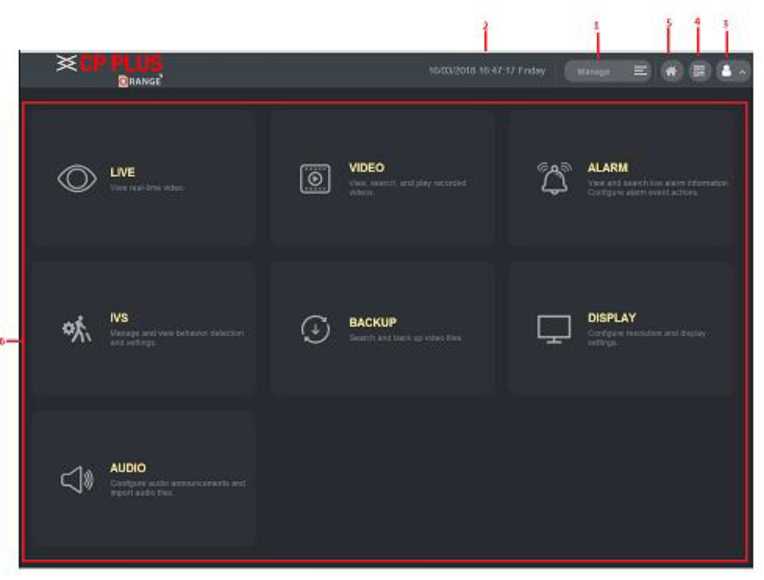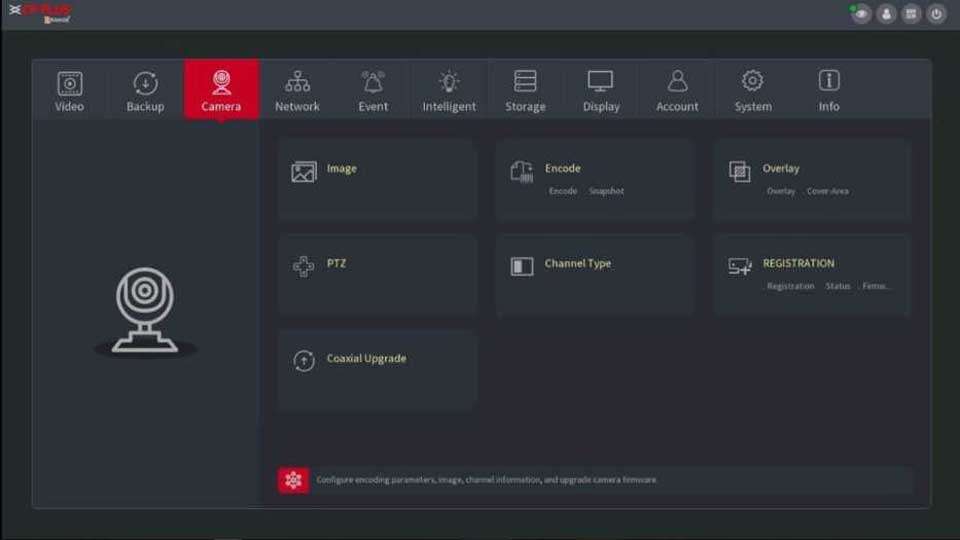CP PLUS XVR complete setup guide, CP Plus has introduced the new and impactful range of DVRs under the Lite Series which has been integrated with the 4K and H.265 encoding technology that provides you with an outstanding at a reasonably pocket-friendly price.
The 4K resolution processors present in this product help in bringing out every little detail in the image.
Along with that, this DVR uses the intuitive shortcut operation menu which lets you control and manage the system remotely as well and can work as edge storage, central storage, backup storage .
CP PLUS XVR complete setup guide
Read Next :
The Device is an excellent digital monitor product for security industry. The embedded LINUX OS assures the stable operation. The H.264 and G.711 technologies assure the high-quality image and low bit stream. The frame-by-frame play function displays more details for analysis, and provides the functions such as record, playback, and monitor and assures the synchronization for audio and video. The Device also adopts the advanced control technology and great network data transmission capability.
The Device adopts embedded design to achieve high security and reliability. It can work in the local end and, with strong networking capability it can get connected to the professional surveillance software (Smart PSS) to form a security network to show its powerful remote monitoring function.
The Device is applicable to the areas such as bank, telecom, electricity, traffic, intelligent residential district, factory, warehouse, resources, and water conservancy facilities.
NOTE
The functions might be different depending on the software and hardware version of the model you purchased.
Real-time Surveillance
- Support VGA port and HDMI port to realize the surveillance through monitors.
- Support HDMI, VGA, and TV output at the same time.
IoT Management
Provide specific management module for IoT features including humidity and temperature data reports and alarms linkage.
Sensor Integration
Integrate coaxial cameras with diverse array of sensors such as temperature, humidity and wireless alarm devices.
Storage Management
- Special data format to guarantee data security and avoid the risk of modifying data viciously.
- Support digital watermark.
Compression Format
Support multiple-channel audio and video signal. An independent hardware decodes the audio and video signal from each channel to maintain video and audio synchronization.
Backup Function
- Support backup operation through USB port (such as USB storage disk, portable HDD, and burner).
- Client-end user can download the file from local HDD through network to backup.
Record & Playback
- Support each channel real-time record independently, and simultaneously support the functions such as search, backward play, network monitor, record search, and download.
- Support various playback modes: slow play, fast play, backward play and frame by frame play.
- Support time title overlay so that you can view event accurate occurred time.
- Support zooming in the selected area in the live view.
Network Operation
Support network remote real-time monitor, remote record search and remote PTZ control.
Alarm Activation
- Several relay alarm outputs to realize alarm activation and on-site light control.
- The alarm input port and output port have the protection circuit to guarantee the Device safety.
Communication Port
- RS485 port can realize alarm input and PTZ control.
- RS232 port can connect to keyboard, COM port of PC or the matrix control.
- Standard Ethernet port can realize network remote access function.
- The dual-network port has the multiple-address, fault tolerance, load balance setup mode.
PTZ Control
Support PTZ decoder through RS485 port.
Intelligent Operation
- Support mouse operation function.
- Support “copy and paste” function for the same settings.
UPnP (Universal Plug and Play)
Establish mapping connection between LAN and WAN through UPnP protocol.
Camera Self-adaptive
Auto-recognize and work with the PAL or NTSC camera and HD camera.
When you receive the Device, please check against the following checking list. If any of the items are missing or damaged, contact the local retailer or after-sales engineer immediately.
| Sequence | Checking items | Requirement | |
| 1 | Package | Appearance | No obvious damage. |
| Packing materials | No broken or distorted positions that could be caused by hit. | ||
| Not torn up. EQ NOTE | |||
| Do not tear up or throw away the | |||
| 2 | Labels | Labels on the device | labels; otherwise the warranty |
| services are not ensured. You need | |||
| to provide the serial number of the | |||
| product when you call the after-sales service. | |||
| 3 | Device | Appearance | No obvious damage. |
| Data cables, power cables, fan cables, mainboard | No connection loose. | ||
Please check if the HDD is already installed in the Device when you first time using the Device.
It is suggested to use the HDD recommended officially. Do not use the PC HDD.

CAUTION
Shut down the device and then unplug the power cable before you open the case to replace the HDD.
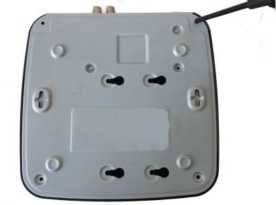
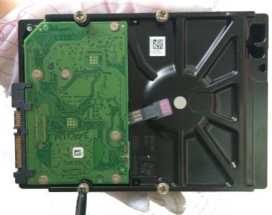
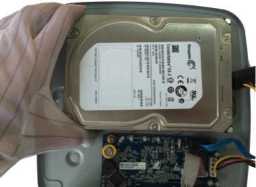
1. Remove the screws to
take off the cover.
2.
Fix the screws on the HDD but do not fasten them.
- Match the screws with the holes on the DVR (WITHOUT HDD) (WITHOUT HDD) to place the HDD.
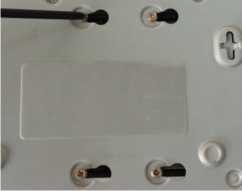
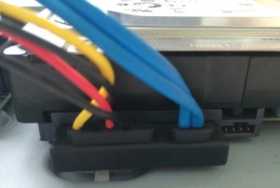
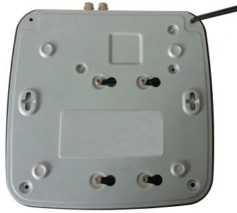
- Turn the DVR (WITHOUT HDD) upside down to see the screws and then
- Use the HDD cable and power cable to connect HDD and mainboard.
- Put back the cover and
fasten the screws.
fasten them.
CD NOTE
The battery is only provided with some models.
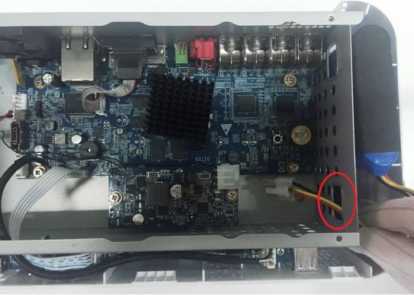
1. Put the battery cable through the hole.
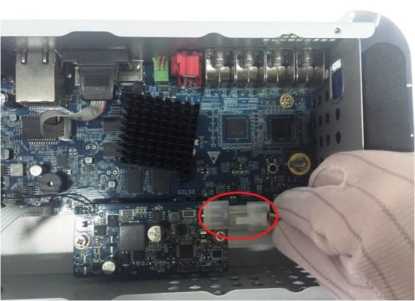
2. Connect to the cable into the port.
CQ NOTE
Skip step 6 if the battery is not equipped with the model you purchased.
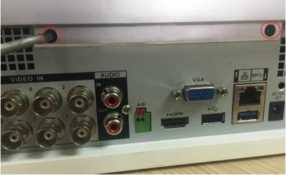
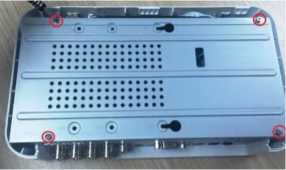

1. Remove the screws to 2.
take off the cover.
Remove the screws to 3.
Put the HDD onto the bracket.
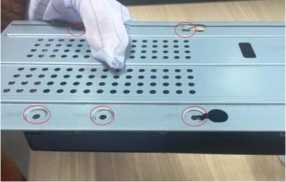
take off the bracket.
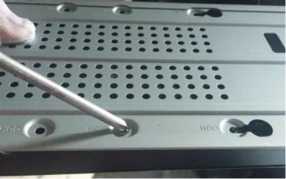
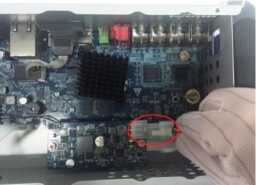
4. Match the holes on the
5. Use screws to fix the
6.
bracket with the screw
HDD onto the bracket.
holes on HDD.
(Optional) Put the battery cable through the hole to connect into the cable port.
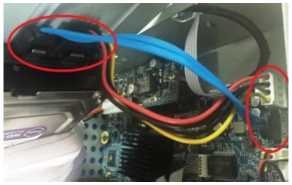
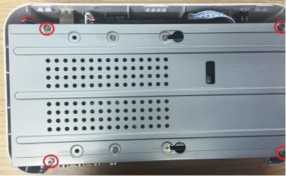
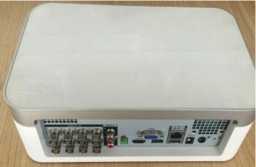
- Use the HDD cable and power cable to connect HDD and mainboard.
- Install the bracket back and then fasten the screws.
- Put back the cover and fasten the screws.
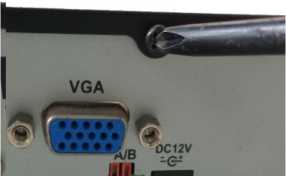
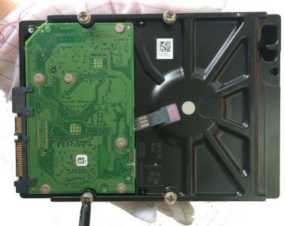
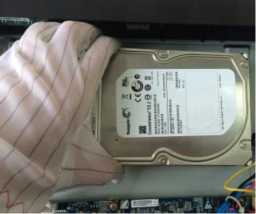
- Remove the screws on the rear panel.
- Fix the screws on the
- Place the HDD onto
HDD but do not be
the Device.
fastened.

- Turn the device to see the back side of it. Aim the screws of the HDD at the holes on the back of the device and fix the screws.
- Use the HDD cable and power cable to connect HDD and mainboard.
- Put back the cover and fix the screws.
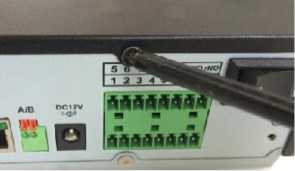
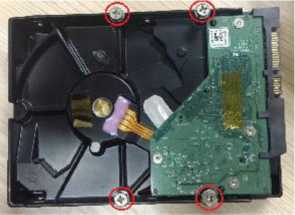
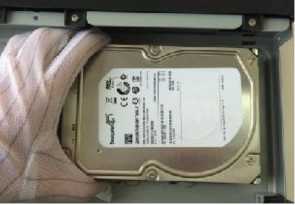
- Remove the screws on
- Fix the screws onto the
- Put the HDD into the
the cover.
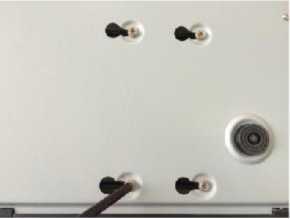
4. Turn the device to see the back side of it. Aim the screws of the HDD at the
HDD, but do not be Device.
fastened.
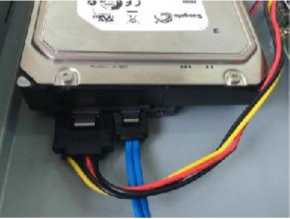
5. Use the HDD cable and power cable to connect HDD and mainboard.
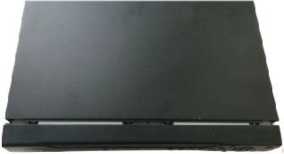
6. Put back the cover and fix the screws.
holes on the back of the
device, and then fix the
screws.
CD NOTE
Only 1.5U and 2U Devices support this installation.
To install the DVR (WITHOUT HDD) into Rack, do the following:
Step 1 Check if the in-house temperature is lower than 35°C(95T) and make sure the 15cm (6in.) spacing around the Device for ventilation.
Step 1 Use six screws to fix the DVR (WITHOUT HDD) on each side.
Step 2 Install from the bottom up.
CAUTION
If you want to install more accessories to the rack, take preventive measures to avoid power socket overload.
Step 3 Install more accessories to the rack if needed.
This chapter introduces various components of the Device, remote control and mouse operations, and typical connection.
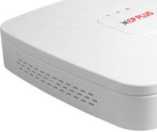
Figure 3-1
| Icon | Name | Function |
| 0 | HDD status indicator |
malfunction. |
| © | Power status indicator |
abnormally.
normally. |
| Network status indicator |
correct.
is abnormal. |
Table 3-1
| 1 I | 2 | 3 | 1 | 5 | 5 7 | ||
| □ □ □ e | A | □ □ | 1 □ 1 | 1 □ 1 | 1 □ 1 | i □ n n d □ □□□ □□□ □□□□□ □□□□□ □□□□□! □□□□□ | |
| □ □ □
□ □ □ |
© | 3 » | !» | ■I | □ n n □ □□□□□ ei □□□ ei □□□ □ □□ r ^1LJLJA’ i □ ei □ □
• □□ □□□□□ □ □□□□□ □□□□□ □□□□□ □ □□□ |
||
□ □ □ E □ D □ □ □ □ E □ DDE □ □ □ □ □ □ E |
□ □ □ □ □ □ □ □ □ □
□ □ □ □ □ □ □ □ □ □ O El □ □ □ □ □ □ □ □ □ □ □ □ |
□ □
□ □ □ □ □ □ |
□ □ □ □ □ □ □
□ □ □ nr □ □ □ □ c □ □ □ [ □ □ □ □ □ □ □ □ □ □ nr
□ □ □ □ |
inn □ nun onn □□□ □ onn n □□□ □ nnn n uu
□ □ODD □□□□□□□ □ □ □ □ □ □□□□□ □ □ □ D El □ □ El El □ □ □ □ n □ □ □ □ □ □ □ ei □ □ □□□□□ □□□□□ ei □ ei □ □ nnn □ □□□ □ □ □ □□ El □ □ □ □ □□□ El HDD □ □ El EI □ □ □ □ □□□□□ □ □ □ C □ □ □□□□□ □ □ □ □ □ □ □ □ □ □ □□□
inn o □□□ □□□ □□□ □ □□□ □ nnn □ non □ □□ □ □ □ n □ □ □ □ □ □ □ ei □ □ □ □ n □ □ □□□□□ ei □ □ □ □ □□□ □ nnn □ □ ei □ □ □ ei □□□ □ □□□ □ □ □ ei □ □□□ □ □ □ □ nun ei □ □ □ □ □ □ □ □ □ □ nnn e □□□ □ uu
|
|||
Figure 3-2
| No. | Button/Icon | Function |
| 1 | POWER | Turns on/off the DVR (WITHOUT HDD). The indicator glows blue when the DVR (WITHOUT HDD) is turned on. |
| 2 | HDD status indicator | The indicator glows blue when the HDD is in malfunction. |
| 3 | Network status indicator | The indicator glows blue when the network connection is abnormal. |
| 4,5,6 | Battery status indicator |
the No.4 indicator is on, and the No.5 and No.6 are out.
percent, the No.5 indicator is on and the others are out.
percent, the No.6 indicator is on and the others are out.
turned off, or there is no battery attached to the DVR (WITHOUT HDD), all the three indicators are out. |
| 7 | USB port | Connects to external devices such as USB storage device, keyboard and mouse. |
Table 3-2

Figure 3-3
| No. | Port Name | Function |
| 1 | HDD | Glows blue when HDD status is abnormal. |
| 2 | NET | Glows blue when network status is abnormal. |
| 3 | POWER | Glows blue when the power is connected properly. |
| No. | Port Name | Function |
| 4 | USB port | Connects to peripheral devices such as USB storage device, keyboard and mouse. |
Table 3-3

![]()
| Name | Icon | Function |
| Power button | 0 | Power button, press this button for three seconds to boot up or shut down DVR (WITHOUT HDD). |
| Up Down | A, ▼ | Activate current control, modify setup, and then move up and down. |
| Increase/decrease numeral. | ||
| Assistant function such as PTZ menu. | ||
| Left
Right |
◄ ► | Shift current activated control, |
| When playback, click these buttons to control playback bar.. | ||
| ESC | ESC | Go to previous menu, or cancel current operation. |
| When playback, click it to restore real-time monitor mode. | ||
| Enter | ENTER | Confirm current operation |
| Go to default button | ||
| Go to menu | ||
| Assistant | Fn | One-window monitor mode, click this button to display assistant |
| Backspace function: in numeral control or text control, press it for 1.5seconds to delete the previous character before the | ||
| In motion detection setup, working with Fn and direction keys to realize setup. | ||
| In text mode, click it to switch between numeral, English character(small/capitalized) and etc. | ||
| Realize other special functions. |
| USB port | To connect USB storage device, USB mouse. | |
| Network abnormal indication light | Net | Network error occurs or there is no network connection, the light becomes red to alert you. |
| HDD abnormal
indication light |
HDD | HDD error occurs or HDD capacity is below specified threshold value, the light becomes red to alert you. |
| IR Receiver | IR | It is to receive the signal from the remote control. |

Figure 3-5
| Name | Icon | Function |
| Power button | o | Power button, press this button for three seconds to boot up or shut down DVR (WITHOUT HDD). |
| Up Down | A, ▼ | Activate current control, modify setup, and then move up and down. |
| Increase/decrease numeral. | ||
| Assistant function such as PTZ menu. | ||
| Left
Right |
◄ ► | Shift current activated control, |
| When playback, click these buttons to control playback bar.. | ||
| ESC | ESC | Go to previous menu, or cancel current operation. |
| When playback, click it to restore real-time monitor mode. | ||
| Enter | ENTER | Confirm current operation |
| Go to default button | ||
| Go to menu | ||
| Slow play | h | Multiple slow play speeds or normal playback. |
| Assistant | Fn | One-window monitor mode, click this button to display |
| Backspace function: in numeral control or text control, press it for 1.5seconds to delete the previous character before the |
| In motion detection setup, working with Fn and direction keys to realize setup. | ||
| In text mode, click it to switch between numeral, English character(small/capitalized) and etc. | ||
| Realize other special functions. | ||
| USB port | To connect USB storage device, USB mouse. | |
| Network abnormal indication | Net | Network error occurs or there is no network connection, the light becomes red to alert you. |
| HDD abnormal indication l^ht | HDD | HDD error occurs or HDD capacity is below specified threshold value, the light becomes red to alert you. |
| IR Receiver | IR | It is to receive the signal from the remote control. |
Table 3-4

Figure 3-6
| No. | Port Name | Function |
| 1 | Video input port | Connects to analog camera to input video signal. |
| 2 | USB port | Connects to external devices such as USB storage device, keyboard and mouse. |
| 3 | VGA port | Outputs analog video data to the connected display with VGA port. |
| 4 | HDMI port | High definition audio and video signal output port.
The port outputs the uncompressed high definition video and multi-channel audio data to the connected display with HDMI port. |
| 5 | Network port | Connects to Ethernet port. |
| No. | Port Name | Function |
| 6 | Power input port | Inputs DC 12V power. |
| 7 | © | Ground terminal. |
Table 3-5
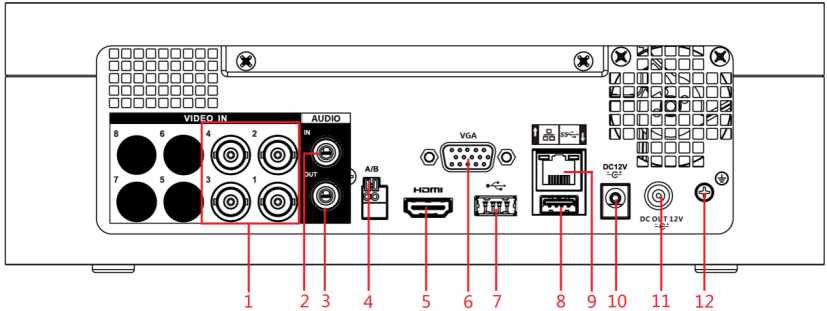
Figure 3-7
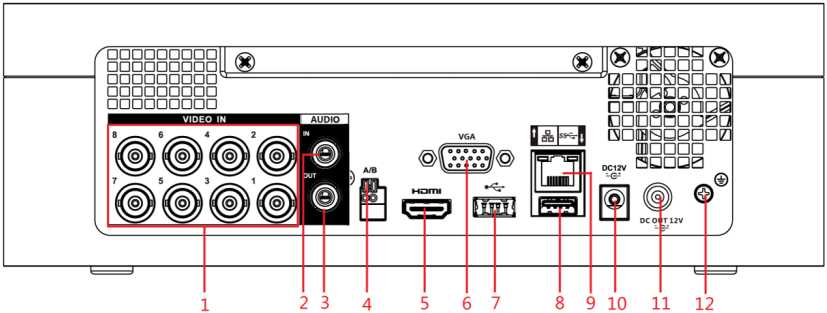
Figure 3-8
| No. | Port Name | Function |
| 1 | Video input port | Connects to analog camera to input video signal. |
| 2 | Audio input port | Receives audio signal output from the devices such as microphone. |
| 3 | Audio output port | Outputs audio signal to the devices such as the sound box. |
| 4 | RS485 communication port | Connects to the control devices such as speed dome PTZ. RS485_A port is connected by the cable A and RS485_B is connected to the cable B. |
| 5 | HDMI port | High definition audio and video signal output port.
The port outputs the uncompressed high definition video and multi-channel audio data to the connected display with HDMI port. |
| 6 | VGA port | Outputs analog video data to the connected display with VGA port. |
| No. | Port Name | Function |
| 7, 8 | USB port | Connects to external devices such as USB storage device, keyboard and mouse. |
| 9 | Network port | Connects to Ethernet port. |
| 10 | Power input port | Inputs DC 12V power. |
| 11 | Power output port | Outputs DC 12V power. |
| 12 | Ground | Ground terminal. |
Table 3-6

Figure 3-9
| No. | Port Name | Function |
| 1 | Video input port | Connects to analog camera to input video signal. |
| 2 | Audio input port | Receives audio signal output from the devices such as microphone. |
| 3 | Audio output port | Outputs audio signal to the devices such as the sound box. |
| 4 | HDMI port | High definition audio and video signal output port.
The port outputs the uncompressed high definition video and multi-channel audio data to the connected display with HDMI port. |
| 5 | Network port | Connects to Ethernet port. |
| 6 | RS485 communication port | Connects to the control devices such as speed dome PTZ. RS485_A port is connected by the cable A and RS485_B is connected to the cable B. |
| 7 | USB port | Connects to external devices such as USB storage device, keyboard and mouse. |
| 8 | VGA port | Outputs analog video data to the connected display with VGA port. |
| 9 | Power input port | Inputs DC 12V power. |
| 10 | Power button | Turns on/off the DVR (WITHOUT HDD). |
| 11 | © | Ground terminal. |
| 12 | Power cable fastener | Use clamp to secure the power cable on the DVR (WITHOUT HDD) in case there is any loss. |
Table 3-7

Figure 3-10
| No. | Port Name | Function |
| 1 | Alarm input port 1-16 | 4 groups of alarm input ports (Group 1: port 1 to port 4; Group 2: port 5 to port 8; Group 3: port 9 to port 12; Group 4: port 13 to port 16). These ports receive the signal from the external alarm source. There are two types: NO (normal open) and NC (normal close).
EQ NOTE When your alarm input device is using external power, please make sure the alarm input device and the Device have the same ground. |
| Alarm output port 1-3 (NO1-NO3;
C1-C3) |
Group 2: port NO2-C2, Group 3: port NO3-C3). These ports output alarm signal to the alarm device. Please make sure power supply to the external alarm device.
|
|
| J_ | Ground. | |
| 2 | Video input port | Connects to analog camera to input video signal. |
| 3 | Audio input port | Receives audio signal output from the devices such as microphone. It corresponds to video input port 1. |
| 4 | DB25 port | Connects to the audio splitter taken from the package to convert to audio input port which receives the audio signal from devices such as microphone. It corresponds to video input ports 2-16. |
| 5 | Audio output port | Outputs audio signal to the devices such as the sound box. |
| 6 | HDMI port | High definition audio and video signal output port.
The port outputs the uncompressed high definition video and multi-channel audio data to the connected display with HDMI port. |
| 7 | USB port | Connects to external devices such as USB storage device, keyboard and mouse. |
| 8 | Network port | Connects to Ethernet port. |
| No. | Port Name | Function |
| 9 | RS485 communication port | Connects to the control devices such as speed dome PTZ. RS485_A port is connected by the cable A and RS485_B is connected to the cable B. |
| 10 | Power input port | Inputs DC 12V power. |
| 11 | VGA port | Outputs analog video data to the connected display with VGA port. |
| 12 | Power button | Turns on/off the DVR (WITHOUT HDD). |
| 13 | Power cable fastener | Use a cable tie to secure the power cable on the DVR (WITHOUT HDD) to prevent loss. |
| 14 | © | Ground terminal. |
Table 3-8

Figure 3-11
| No. | Port Name | Function |
| 1 | © | Ground terminal. |
| 2 | Alarm input port 1-16 | 4 groups of alarm input ports (Group 1: port 1 to port 4; Group 2: port 5 to port 8; Group 3: port 9 to port 12; Group 4: port 13 to port 16). These ports receive the signal from the external alarm source. There are two types: NO (normal open) and NC (normal close).
Cfl NOTE When your alarm input device is using external power, please make sure the alarm input device and the DVR (WITHOUT HDD) connect to the same ground. |
| Alarm output port 1-3 (NO1-NO3;
C1-C3) |
C1,Group 2:port NO2-C2,Group 3:port NO3-C3) ). These ports output alarm signal to the alarm device. Please make sure power supply to the external alarm device.
|
|
| Ground. | ||
| 3 | Video input port | Connects to analog camera to input video signal. |
| No. | Port Name | Function |
| 4 | Audio input port | Receives audio signal output from the devices such as microphone. |
| 5 | Audio output port | Outputs audio signal to the devices such as the sound box. |
| 6 | HDMI port | High definition audio and video signal output port.
The port outputs the uncompressed high definition video and multi-channel audio data to the connected display with HDMI port. |
| 7 | USB port | Connects to the external devices such as keyboard, mouse, and USB storage device. |
| 8 | Network port | Connects to Ethernet port. |
| 9 | RS485 communication port | Connects to the control devices such as speed dome PTZ. RS485_A port is connected by the cable A and RS485_B is connected to the cable B. |
| 10 | Power input port | Inputs DC 12V power. |
| 11 | VGA port | Outputs analog video data to the connected display with VGA port. |
| 12 | Power button | Turns on/off the DVR (WITHOUT HDD). |
| 13 | Power cable fastener | Use clamp to secure the power cable on the DVR (WITHOUT HDD) in case there is any loss. |
Table 3-9
CQ NOTE
Please note the remote control is not our standard accessory and might not be included in the
accessary bag. It is supplied dependent on the model you purchased.
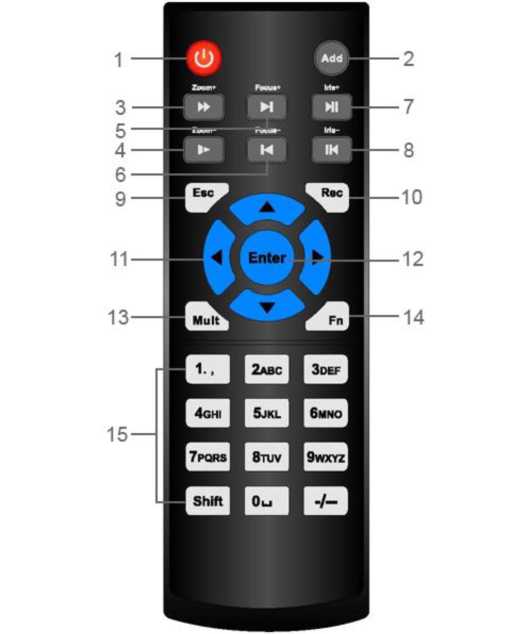
Figure 3-12
| No. | Name | Function |
| 1 | Power button | Press this button to boot up or shut down the device. |
| 2 | Address | Press this button to input device serial number, so that you can control the Device. |
| 3 | Forward | Multi-step forward speed and normal speed playback. |
| 4 | Slow motion | Multi-step slow motion speed or normal playback. |
| 5 | Next record | In playback state, press this button to play back the next video. |
| 6 | Previous record | In playback state, press this button to play back the previous video. |
| 7 | Play/Pause |
playback.
playback.
search menu. |
| 8 | Reverse/pause | In the reverse playback state, press this button to pause reverse playback. |
| In the reverse playback pause state, press this button to resume to playback reversing state. | ||
| 9 | Esc. | Go back to previous menu or cancel current operation (close front interface or control). |
| No. | Name | Function |
| 10 | Record |
channel that you want to record.
record interface will be displayed. |
| 11 | Direction keys | Switch between current activated controls by going left or right. In playback state, the keys control the playback progress bar. Aux function (such as operating the PTZ menu). |
| 12 | Enter/menu key |
|
| 13 | Multiple-window switch | Switch between multiple-window and one-window. |
| 14 | Fn |
display the PTZ control and color setting functions.
keys to complete setup.
character. To use the clearing function: Long press this button for 1.5 seconds.
information (as indicated in the pop-up message. |
| 15 | Alphanumeric keys |
|
Table 3-10
Q3 NOTE
The operations are based on the considerations for right-handed users.
| Operation | Function |
| Click left mouse button | Password input dialogue box pops up if you have not logged in yet. In live view window interface, you can go to the main menu. |
| When you have selected one menu item, click it to view menu content. | |
| Implement the control operation. | |
| Modify checkbox or motion detection status. | |
| Click combo box to pop up drop-down list. | |
| In text box, click the corresponding button on the panel to enter a numeral or English character (small/capitalized). |
In English input mode: Click =1 to enter a backspace and click a
Operation
Function
to delete the previous character.

In numeral input mode: Click =1 to clear and click a to delete
the previous character.
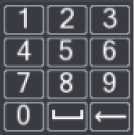
Double-click left
mouse button
Right-click
Implement special control operations such as double-click one item in the file list to play back the video.
In multiple-window mode, double-click one channel to view in full-window. Double-click current video again to go back to previous multiple-window mode.
Right-click in live view window interface, the shortcut menu is displayed. For different series product, the shortcut menu may vary.
Exit current menu without saving the modification.
In numeral input box: Increase or decrease numeral value.
Click scroll wheel button
Switch the items in the check box.
Page up or page down.
Point to select and move
Select current control and move it.
Dragging selection with left button
a box
mouse
Select motion detection zone.
Select privacy mask zone.
Table 3-11

This chapter introduces various components of the Device, remote control and mouse operations, and typical connection.
Typical Connection Diagram
CD NOTE
The following figure is for reference only. The actual product shall govern.
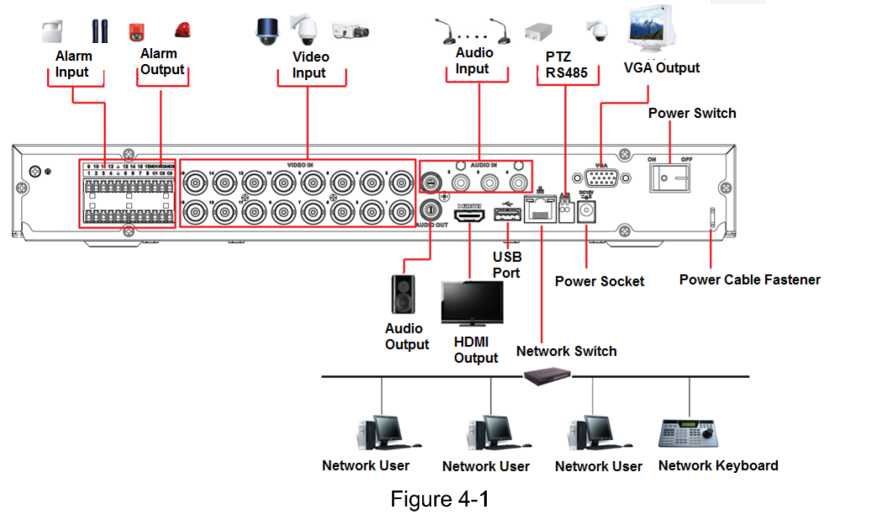
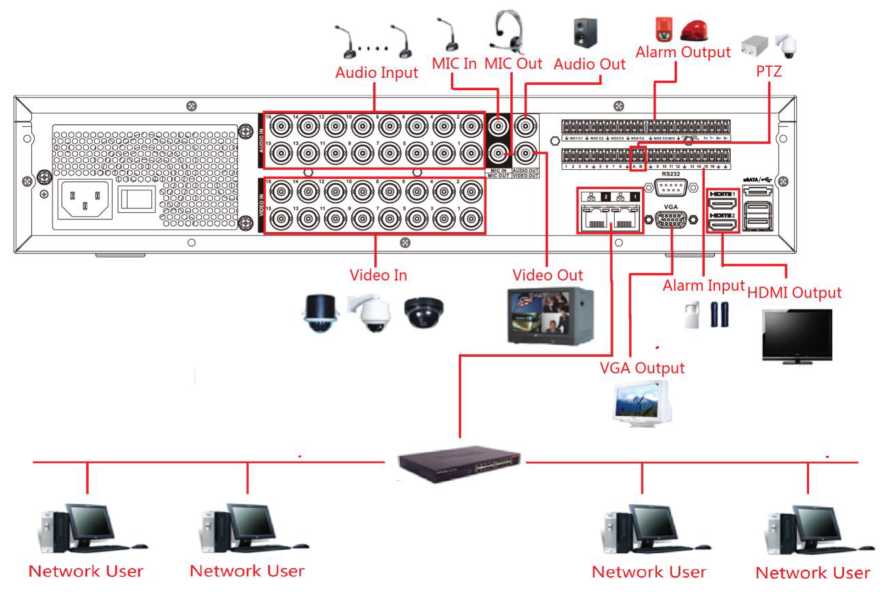
Figure 4-2
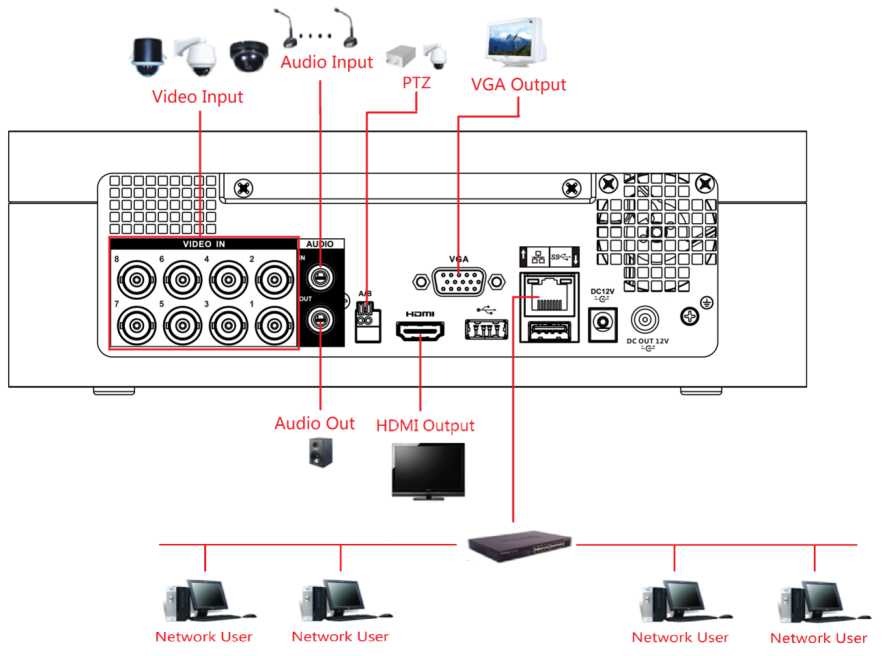
Figure 4-3
The video input interface is BNC. The input video format includes: PAL/NTSC BNC (1.0VP-P, 75Q.).
The video signal should comply with your national standards.
The input video signal shall have high SNR, low distortion; low interference, natural color and suitable lightness.
Guarantee the stability and reliability of the camera signal
The camera shall be installed in a cool, dry place away from direct sunlight, inflammable, explosive substances and etc.
The camera and the DVR (WITHOUT HDD) should have the same grounding to ensure the normal operation of the camera.
Guarantee stability and reliability of the transmission line
Please use high quality, sound shielded BNC. Please select suitable BNC model according to the transmission distance.
If the distance is too long, you should use twisted pair cable, and you can add video compensation devices or use optical fiber to ensure video quality.
You should keep the video signal away from the strong electromagnetic interference, especially the high-tension current.
Keep connection lugs in well contact
The signal line and shielded wire should be fixed firmly and in well connection. Avoid dry joint, lap welding and oxidation.
Video output includes a BNC (PAL/NTSC1.0Vp-p, 75Q) output, a VGA output and HDMI output. System supports BNC, VGA and HDMI output at the same time.
When you are using pc-type monitor to replace the monitor, please pay attention to the following points:
- To defer aging, do not allow the pc monitor to run for a long time.
- Regular demagnetization will keep device maintain proper status.
- Keep it away from strong electromagnetic interference devices.
Using TV as video output device is not a reliable substitution method. You also need to reduce the working hour and control the interference from power supply and other devices. The low- quality TV may result in device damage.
These series Product audio input port adopt BNC port.
Due to high impedance of audio input, please use active sound pick-up.
Audio transmission is like video transmission. Try to avoid interference, dry joint, loose contact and it shall be away from high tension current.
The audio output signal parameter is usually over 200mv 1KQ (BNC or RCA). It can directly connect to low impedance earphone, active sound box or amplifier-drive audio output device. If the sound box and the pick-up cannot be separated spatially, it is easy to arouse squeaking. In this case you can adopt the following measures:
- Use better sound pick-up with better directing property.
- Reduce the volume of the sound box.
- Using more sound-absorbing materials in decoration can reduce voice echo and improve acoustics environment.
- Adjust the layout to reduce happening of the squeaking.
Please read the followings before connecting.
Alarm input
- Please make sure alarm input mode is grounding alarm input.
- Grounding signal is needed for alarm input.
- Alarm input needs the low-level voltage signal.
- Alarm input mode can be either NC (normal Open) or NO (Normal Close)
- When you are connecting two DVR (WITHOUT HDD)s or you are connecting one DVR
(WITHOUT HDD) and one other device, please use a relay to separate them.
Alarm output
The alarm output port should not be connected to high power load directly (It shall be less than 1A) to avoid high current which may result in relay damage. Please use the contactor to realize the connection between the alarm output port and the load.
How to connect PTZ decoder
- Ensure the decoder has the same grounding with DVR (WITHOUT HDD), otherwise you may not control the PTZ. Shielded twisted wire is recommended and the shielded layer is used to connect to the grounding.
- Avoid high voltage. Ensure proper wiring and some thunder protection measures.
- For too long signal wires, 120Q should be parallel connected between A, B lines on the far end to reduce reflection and guarantee the signal quality.
- “485 A, B” of DVR (WITHOUT HDD) cannot parallel connect with “485 port” of another
device.
- The voltage between of A, B lines of the decoder should be less than 5V.
Please make sure the front-end device has soundly earthed
Improper grounding may result in chip damage.
CD NOTE
The alarm input ports are dependent on the model you purchased.
I 4 NOT C1 4 NO2 C2 4 NO3 C3 4 NO4 C4 4- NO5 C5 NC5 4- C<2V~ T* T- R+ R- |
[BBHMBBBBBBiaiilIRffBBBBBïHïBBRI I 1 2 3 445 6 7 8 4 A B 4 9 10 11 12 4 13 14 15 16 4 4 |
Figure 4-4
Icon Description
| 1, 2, 3, 4, 5, 6,
7, 8, 9, 10, 11, 12, 13, 14, 15, 16 |
ALARM 1 to ALARM 16. The alarm becomes active in low voltage. |
| NO1 C1, NO2 C2, NO3 C3, NO4 C4 | There are four groups of normal open activation output (on/off button). |
| NO5 C5 NC5, | There is one group of normal open activation output (on/off button). |
| CTRL 12V | Control power output of the 6th alarm output channel. Voltage current: 500mA.
|
| +12V | Rated current.
Voltage current: 500mA. |
| Ground cable. | |
| 485 A/B | 485 communication port. They are used to control devices such as decoder. 1200 should be parallel connected between A, B lines if there are too many PTZ decoders. |
| T+,T-,R+,R- | Four-wire full-duplex RS485 port.
T+ T-: output wire. R+ R-: input wire. |
Table 4-1
Please refer to the following figure for more information.
- Grounding alarm inputs which includes Normal open and Normal close type.
- Please parallel connect COM end and GND end of the alarm detector (Provide external power to the alarm detector).
- Please parallel connect the Ground of the DVR (WITHOUT HDD) and the ground of the alarm detector.
- Please connect the NC port of the alarm sensor to the DVR (WITHOUT HDD) alarm input(ALARM)
- Use the same ground with that of DVR (WITHOUT HDD) if you use external power to the alarm device.
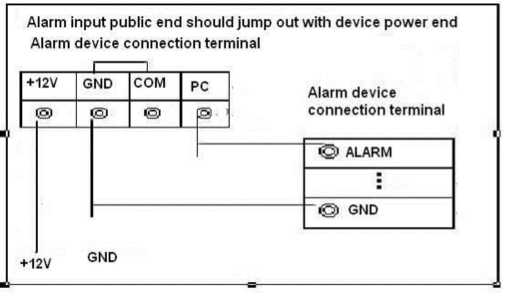
Figure 4-5
- .3.3 Alarm Output
- Provide external power to external alarm device.
- To avoid overloading, please read the following relay parameters table carefully.
- RS485 A/B cable is for the A/B cable of the PTZ decoder.
- .3.4 Alarm Output Relay Parameters
CD NOTE
Refer to the actual product for relay model information.
| Model | HFD23/005-1ZS | HRB1-S-DC5V | |
| Material of the touch | AgNi+ gold-plating | AuAg10/AgNi10/CuNi30 | |
| Rating (Resistance Load) | Rated switch capacity | 30V DC 1A/125V AC 0.5A | 24V DC 1A/125V AC 2A |
| Maximum switch power | 62.5VA/30W | 250VA/48W | |
| Maximum switch voltage | 125V AC/60V DC | 125V AC/60V DC | |
| Maximum switch currency | 2A | 2A | |
| Insulation | Between touches | 400VAC 1 minute | 500VAC 1 minute |
| Between touch and winding | 1000VAC 1 minute | 1000VAC 1 minute | |
| Turn-on Time | 5 ms max | 5ms max | |
| Turn-off Time | 5 ms max | 5ms max | |
| Longevity | Mechanical | 1x107times | 5×106 times |
| Model | HFD23/005-1ZS | HRB1-S-DC5V | |
| (300 times/MIN) | (300 times/MIN) | ||
| Electrical | 1*105 times (30 times/MIN) | 2.5*104 times (30 times/MIN) | |
| Working Temperature | -30C-+70C | -40C-+70C | |
Step 1 Connect the RS485 cable of the PTZ camera to the RS485 port on the Device. Ensure the match of A and B interfaces.
Step 2 Connect the video out cable of the PTZ camera to the video input port on the Device.
Step 3 Turn on the PTZ camera.
Please make sure to use the same battery model if possible.
We recommend replace battery regularly (such as one-year) to guarantee system time
accuracy.

CAUTION
Before replacement, please save the system setup, otherwise, you may lose the data completely!
Please read the following notes prior to using your Device.
CD NOTE
- The interfaces in the Manual are used for introducing the operations and only for reference. The actual interface might be different dependent on the model you purchased. If there is inconsistency between the Manual and the actual product, the actual product shall govern.
- The Manual is a general document for introducing the product, so there might be some functions described for the Device in the Manual not apply to the model you purchased.
- Conventions for mouse operations on a menu.
O Click: On the menu, left-click the mouse once on an option to enter the option setting.
O Right-click: On any interface, right-click the mouse once to return to the previous level. For details about mouse operations, see “3.4 Mouse Operations.”
CAUTION
- Ensure the input voltage corresponds to the power requirement of the Device. Power on the Device after the power cable is properly connected.
- To protect the Device, please connect the Device with the power cable first, and then connect to the power source.
- To ensure the stable work of the Device and the external devices connected to the Device and to prolong the batter life, it is recommended to refer to the national related standard to use the power source that provides stable voltage with less interference from ripples. USP power source is recommended.
Step 1 Connect the Device to the monitor.
Step 2 Plug in the power cable to the Device.
Step 3 Press the power button to turn on the Device. The power indicator light is on.
On the connected monitor, the live view screen is displayed by default. If you turn on the Device during the time period that is configured for recording, the system starts recording after it is turned on, and you will see the icon indicating recording status is working in the specific channels.
When booting up for the first time, you need to configure the password information for admin (by default).
ED NOTE
To secure the Device, it is strongly recommended for you to properly keep the password for admin and modify it regularly.
Step 1 Turn on the Device.
The Device Initialization interface is displayed. See Figure 5-1.
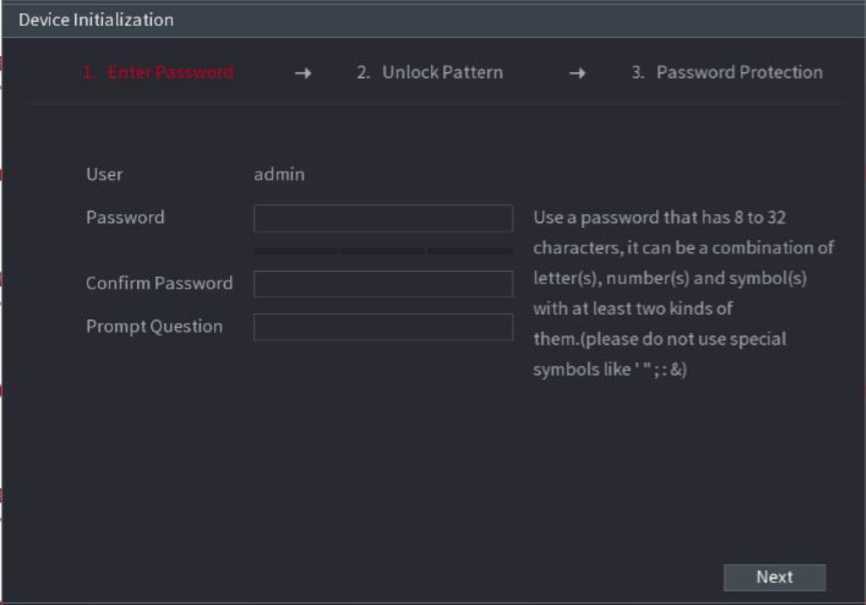
Figure 5-1
Step 2 Configure the password information for admin. For details, see Table 5-1.
| Parameter | Description | |||
| User | By default, the user is admin. | |||
| Password | In the Password box, enter the password for admin.
The new password can be set from 8 characters through 32 characters and contain at least two types from number, letter and special characters (excluding , , “;”,”:” and “&”). |
|||
| Confirm Password | ||||
| Prompt Question | In the Prompt Question box, enter the information that can remind you of the password.
ED NOTE |
|||
| On the login interface, click | Efi | , the prompt will display to help you | ||
| — | ||||
| find back the password. | ||||
Table 5-1
The unlock pattern setting interface is displayed. See Figure 5-2.
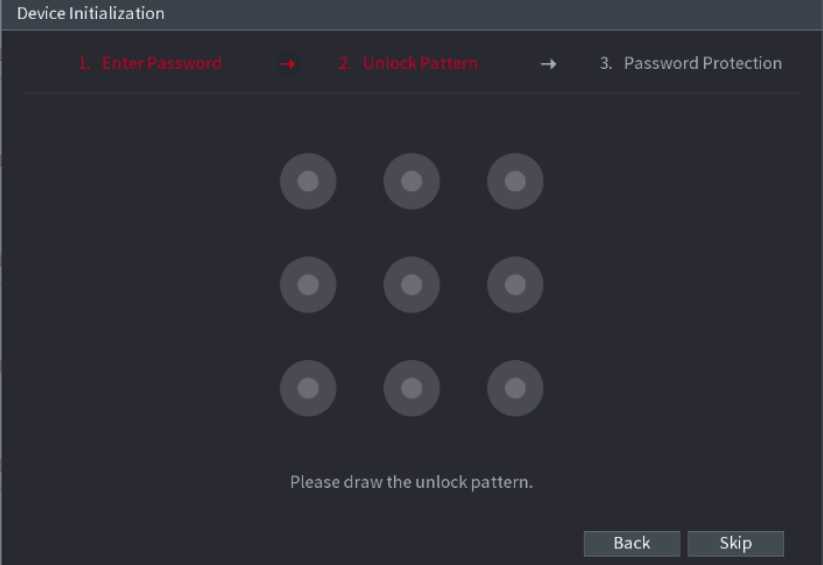
Figure 5-2
After the setting is completed, the password protection settings interface is displayed.
See Figure 5-3.
EQ NOTE
- The pattern that you want to set must cross at least four points.
- If you do not want to configure the unlock pattern, click Skip.
- Once you have configured the unlock pattern, the system will require the unlock
pattern as the default login method. If you skip this setting, enter the password for login.
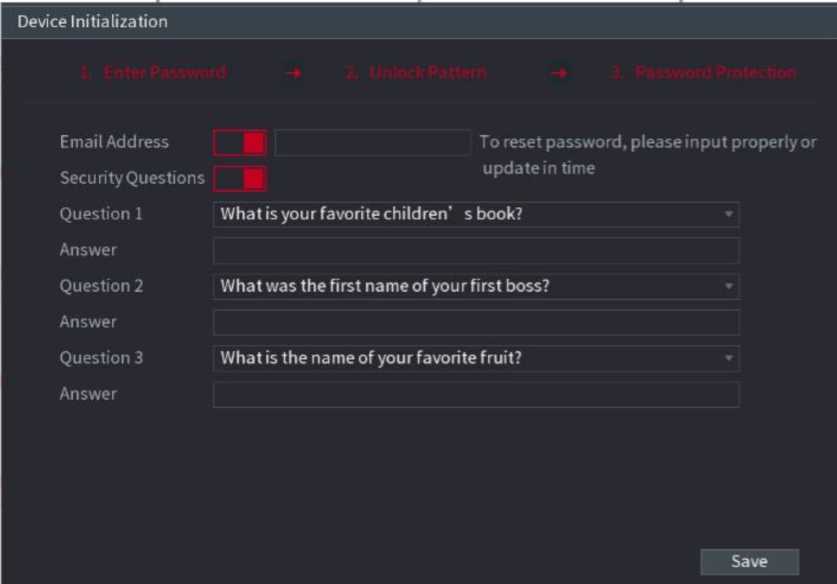
Step 5 Configure the protection parameters for password. For details, see Table 5-2.
After configuration, if you forgot the password for admin user, you can reset the password through the reserved email address or security questions. For details about resetting the password, see “5.1.3 Resetting Password.”
If you do not want to configure the settings, disable the email address and security questions functions on the interface.
Table 5-2
Step 6 Click Save to complete the settings.
The End-User License Agreement interface is displayed.
Step S Select the I have read and agree to all terms check box.
Step 8 Click Next.
The Startup Wizard interface is displayed. For details about quick settings during startup, see “5.1.4 Setting Up with the Startup Wizard.”
You can reset the password through the QR code or the security questions.
- To reset through the QR code, make sure the Enable check box is selected in Main Menu ^ System ^ SECURITY > Password Reset.
- To reset through the security questions, make sure the security quesitons is configured. Step 1 Enter the login interface.
- If you have configured unlock pattern, the unlock pattern login interface is displayed. See Figure 5-4. Click Forgot Pattern, the password login interface is displayed. See Figure 5-5.
- If you did not configure unlock pattern, the password login interface is displayed. See Figure 5-5.
CQ NOTE
On the unlock pattern login interface, click Switch User to login; or on the password login interface, in the User Name list, select other users to login.
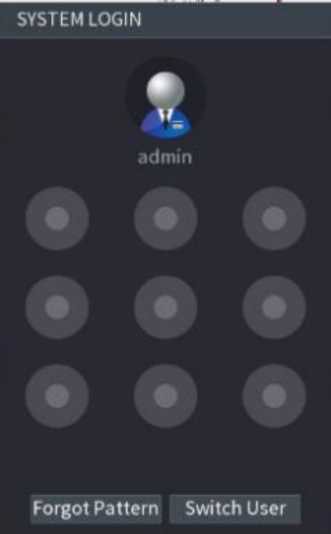
Figure 5-4
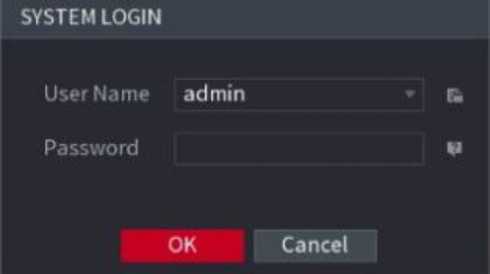
Figure 5-5
- If you did not set the reserved email address, the email entering interface is displayed. See Figure 5-6. Enter the email address, and then click Next, the Reset the password interface is displayed. See Figure 5-7.
- If you have set the reserved email address, the Reset the password interface is displayed. See Figure 5-7.
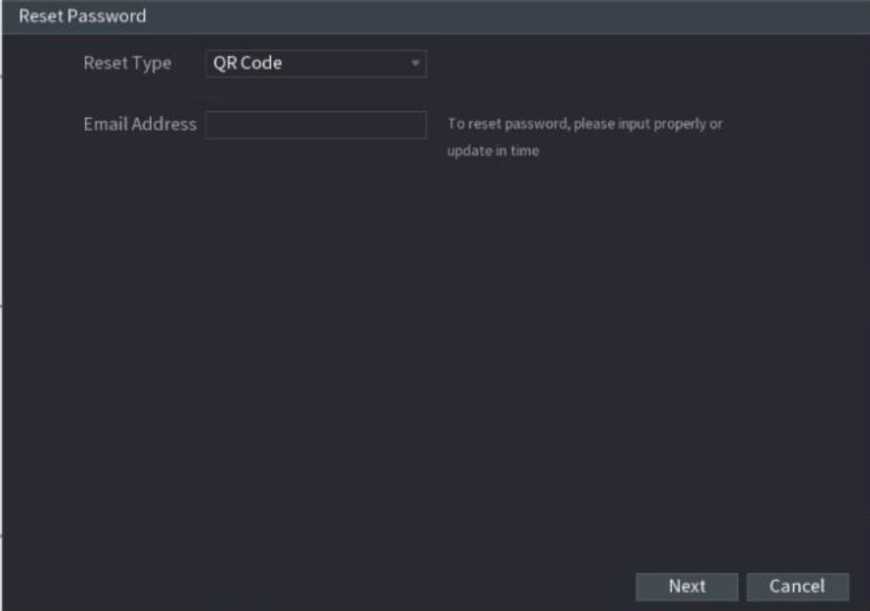
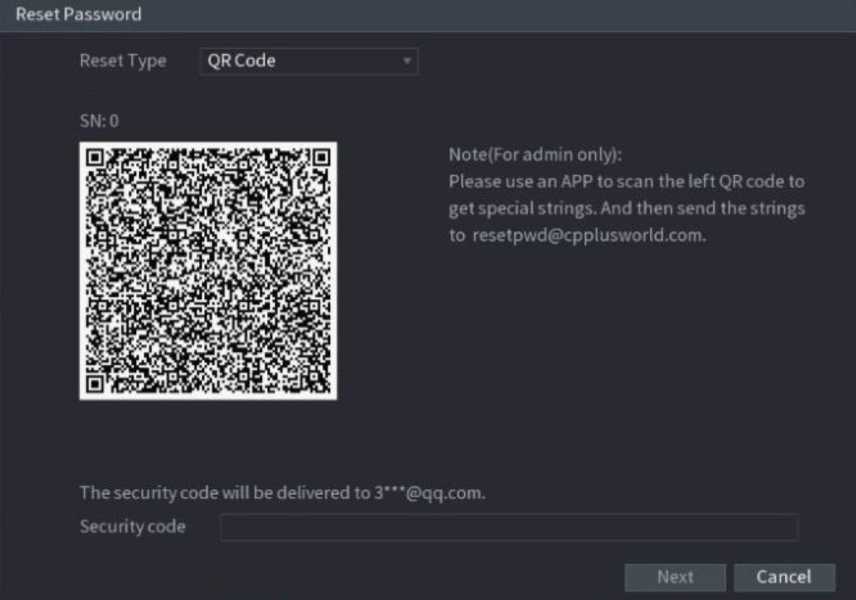
Figure 5-7
- QR code
Follow the onscreen instructions to get the security code in your reserved email address. In the Security code box, enter the security code.
CAUTION
- You are given the limited times to get the security code by scanning the QR code within 24 hours. Please operate carefully.
- Please use the security code received in your email box to reset the password within 24 hours; otherwise the security code becomes invalid.
• Security questions
- On the Reset the password interface as shown in Figure 5-6, in the Reset Type list, select Security Questions, the Security Questions interface is displayed, see Figure 5-8.
EQ NOTE
If you did not configure the security questions before, in the Reset Type list, there will be no Security Questions.
- In the Answer box, enter the correct answers.
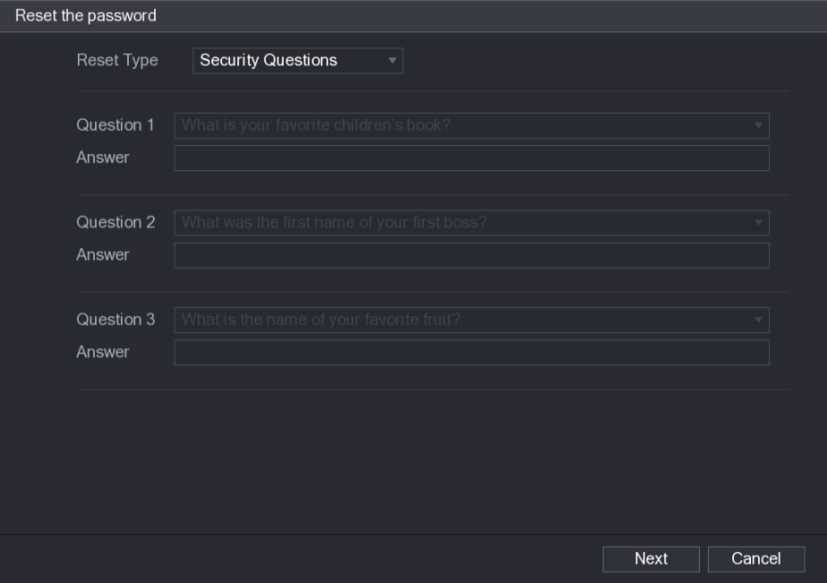
Figure 5-8
The new password resetting interface is displayed. See Figure 5-9.
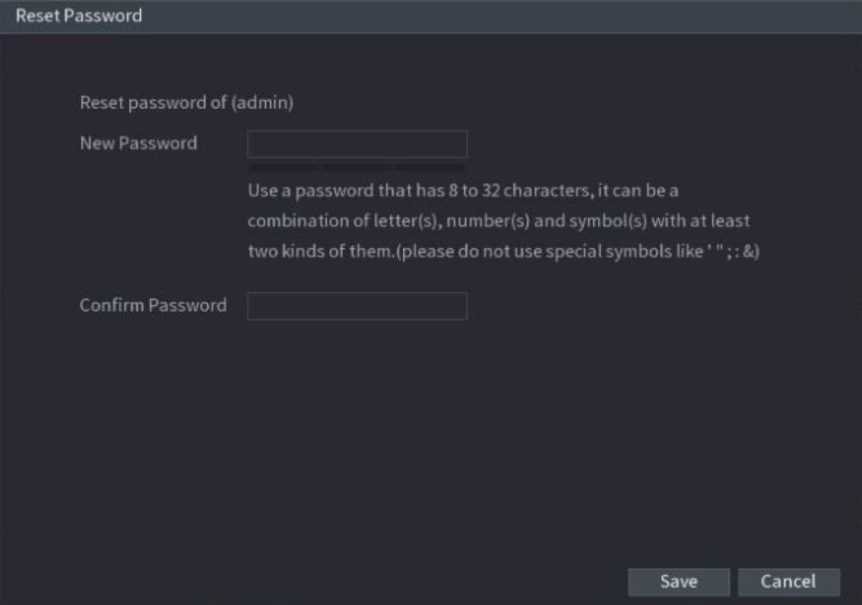
Step 6
Step 7
Figure 5-9
In the New Password box, enter the new password and enter it again in the Confirm Password box.
Click Save. The password resetting is started.
After resetting is completed, a pop-up message is displayed.
Click OK.
A pop-up message is displayed asking if you want to sync the password with the remote devices, see Figure 5-10.
- Click Cancel, the resetting is finished.
- Click OK, the Sync Info interface is displayed. See Figure 5-10.
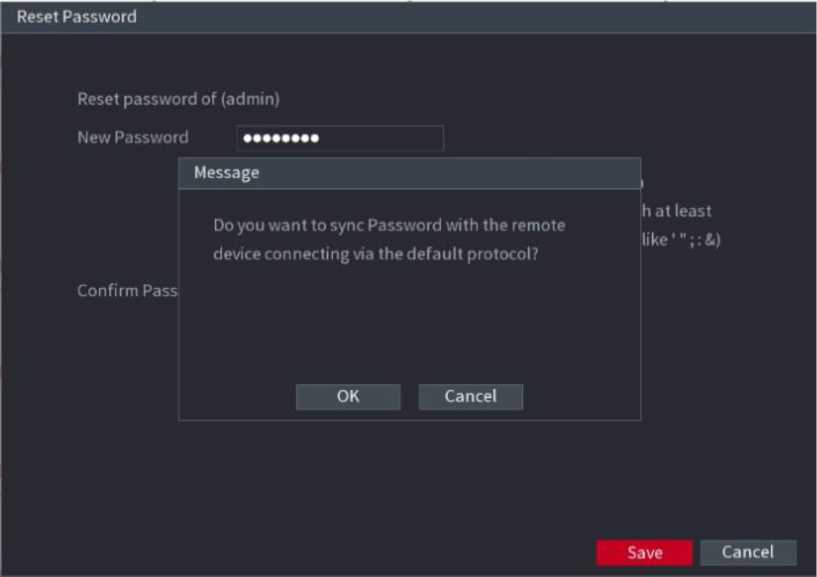
Figure 5-10
![]()
This message appears only when there are digital channels instead of complete analog channels.
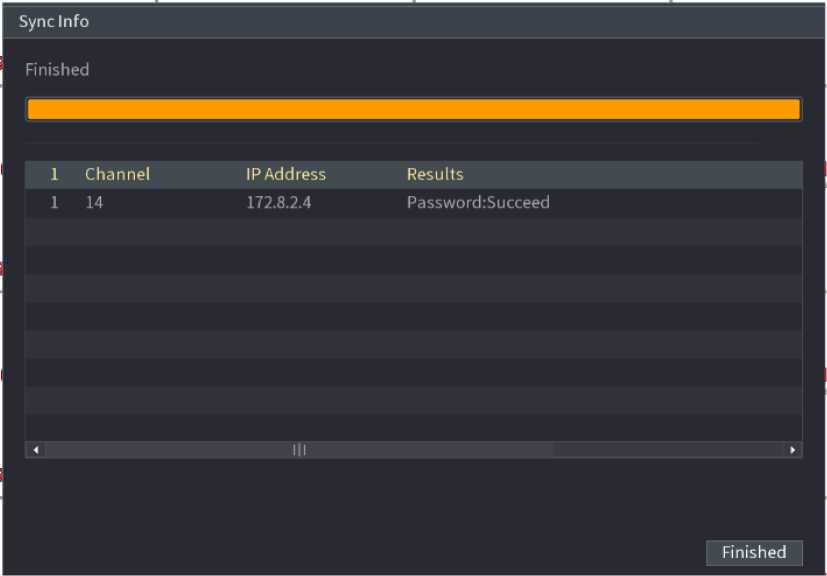
Figure 5-11
5.1.4 Setting Up with the Startup Wizard
The Startup Wizard helps you configure the basic settings to set up the Device.
After you have initialized the Device, the Startup Wizard interface is displayed. See Figure 512.
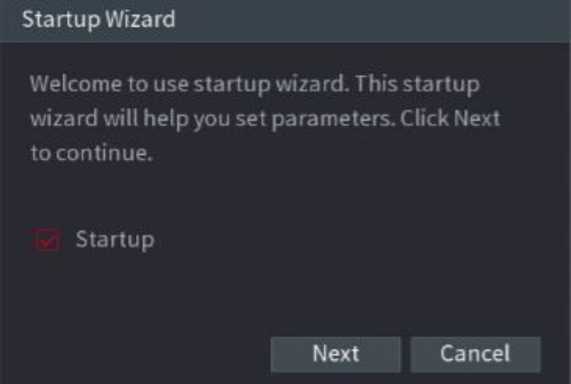
Figure 5-12
If you select the Auto-check for updates check box, the system will notify you automatically when updates are available.
You can configure the general settings for the Device such as Device name, language, and settings for instant playback.
You can also configure general settings by selecting Main Menu ■+ System ■+ General ^ General.
Step 1 On the Startup Wizard interface, click Next.
The General interface is displayed. See Figure 5-13.
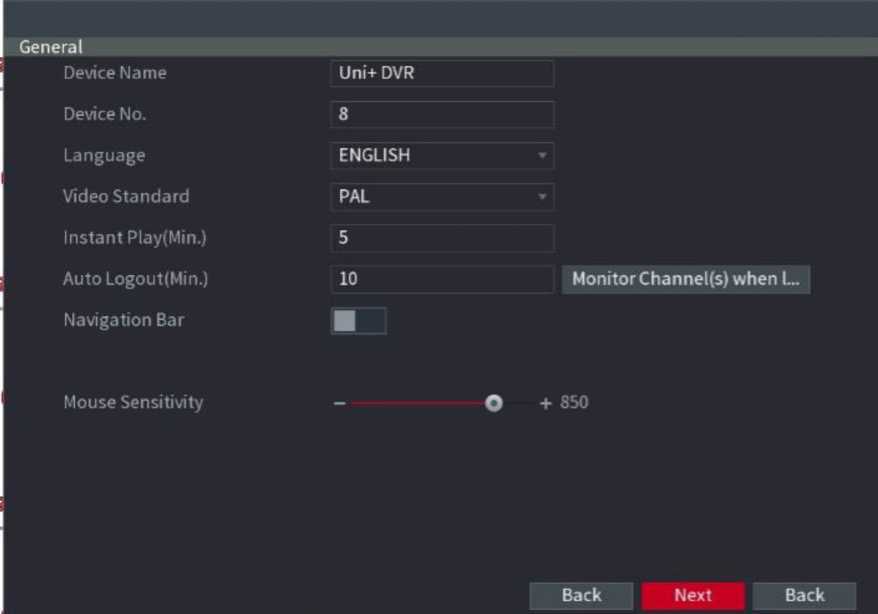
Figure 5-13
Step 2 Configure the general settings parameters. See Table 5-3.
Table 5-3
You can configure the system time, choose the time zone, set the daylight saving time, and enable the NTP server.
You can also configure date and time settings by selecting Main Menu ^ System ■+ General ^ Date &Time.
Step 1 After you have configured the general settings, on the General interface, click Next
The Date & Time interface is displayed. See Figure 5-14.
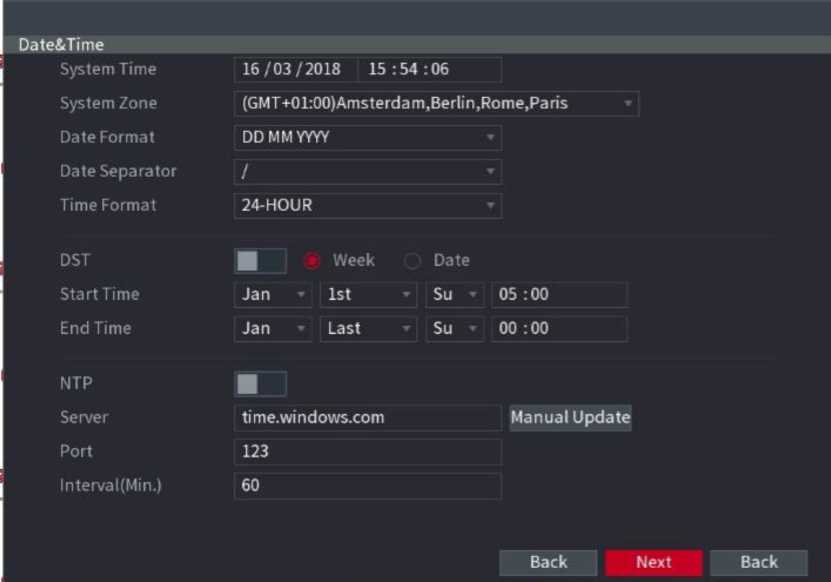
Figure 5-14
Step 2 Configure the settings for date and time parameters. See Table 5-4.
Table 5-4
You can configure the basic network settings such as net mode, IP version, and IP address of the Device.
You can also configure network settings by selecting Main Menu ^ Network ^ TCP/IP.
Step 1 After you have configured the date and time settings, on the Date&Time interface, click Next.
The NETWORK interface is displayed. See Figure 5-15.
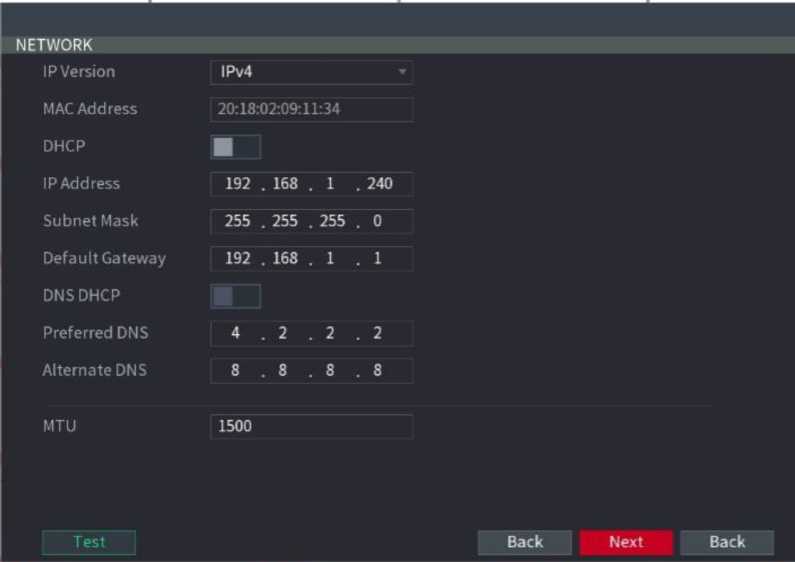
Figure 5-15
Step 2 Configure the settings for network parameters. See 0.
two Ethernet ports is disconnected as detected by networking testing, the system network status is regarded as offline.
Normally only one Ethernet port is working and when this port fails, the other port will start working automatically to ensure the network connection. When testing the network status, the network is regarded as offline only when both of the two Ethernet ports are disconnected. The two Ethernet ports are used under the same LAN.
are working at the same time to share the network load averagely. If one of them fails, the other can continue working normally. When testing the network status, the network is regarded as offline only when both of the two Ethernet ports are disconnected. The two Ethernet ports are used under the same LAN. CQ NOTE The Device with single Ethernet port does not support this function. |
|
| Default Ethernet Port | In the Ethernet Card list, select an Ethernet port as a default port.
This setting is available only when the Multi-address is selected in the Net Mode list. |
| IP Version | In the IP Version list, you can select IPv4 or IPv6. Both versions are supported for access. |
| MAC Address | Displays the MAC address of the Device. |
| DHCP | Enable the DHCP function. The IP address, subnet mask and default gateway are not available for configuration once DHCP is enabled.
Address box, Subnet Mask box and Default Gateway box. If not, all values show 0.0.0.0.
DHCP function first.
default gateway, and DHCP are not available for configuration. |
| IP Address | Enter the IP address and configure the corresponding subnet mask and default gateway.
CQ NOTE IP address and default gateway must be in the same network segment. |
| Subnet Mask | |
| Default Gateway | |
| DNS DHCP | Enable the DHCP function to get the DNS address from router. |
| Preferred DNS | In the Preferred DNS box, enter the IP address of DNS. |
| Alternate DNS | In the Alternate DNS box, enter the IP address of alternate DNS. |
| MTU | In the MTU box, enter a value for network card. The value ranges from 1280 byte through 1500 byte. The default is 1500. |
| Parameter | Description |
| CQ NOTE | |
| • Modifying MTU value will cause network interruption and restart, | |
| which interrupt the network service. There is a pop-up message to | |
| let you confirm if you want to save the modification, if yes, the | |
| modification takes effect. | |
| • Suggested MTU values are as below. | |
| O 1500: The biggest value of Ethernet information package. | |
| This value is typically selected if there is no PPPoE or VPN | |
| connection, and it is also the default value of some routers, | |
| network adapters and switches. | |
| O 1492: Optimized value for PPPoE. | |
| O 1468: Optimized value for DHCP.
O 1450: Optimized value for VPN. |
|
| Test | Click Test to test if the entered IP address and gateway are interworking. |
Table 5-5
You can add the Device into your cell phone client or the platform to manage.
You can also configure InstaOn function by selecting Main Menu ^ Network ■+ InstaOn Cloud.
NOTE
Make sure the DVR (WITHOUT HDD) is connected into the Internet, and if yes, in the Status box of the InstaOn interface, it shows Online.
Step 1 After you have configured the network settings, on the NETWORK interface, click Next.
The InstaOn Cloud interface is displayed. See Figure 5-16.
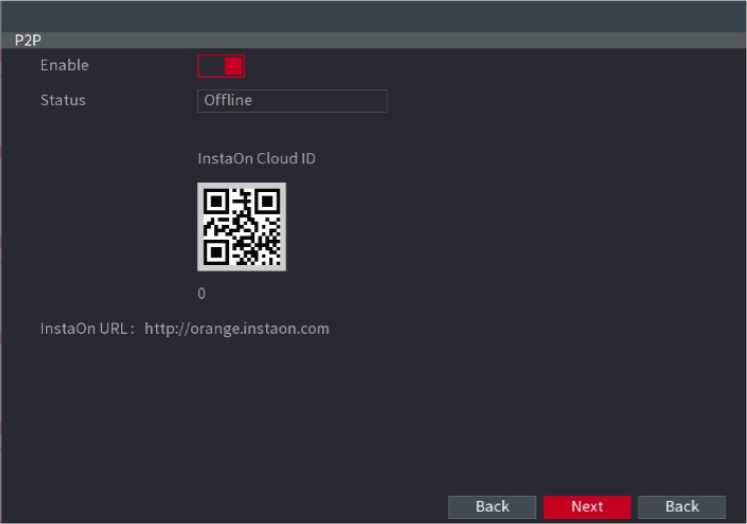
Figure 5-16
Step 2 Enable the InstaOn function.
Step 3 Click Apply.
You can start adding the device.
- Cell Phone Client: Use your mobile phone to scan the QR code to add the device into the Cell Phone Client, and then you can start accessing the Device.
- Platform: Obtain the Device SN by scanning the QR code. Go to the InstaOn management platform and add the Device SN into the platform. Then you can access and manage the device in the WAN. For details, please refer to the InstaOn operation manual.
ED NOTE
You can also enter the QR code of Cell Phone Client and Device SN by clicking
on the top right of the interfaces after you have entered the Main Menu.
PG
To use this function, take adding device into Cell Phone Client as an example.
Adding Device into Cell Phone Client
Step 1 Use your cell phone to scan the QR code under Cell Phone Client to download the application.
Step 2 On your cell phone, open the application, and then tap .
The menu is displayed. You can start adding the device.
- Tap Device Manager.
The Device Manager interface is displayed. See Figure 5-17.
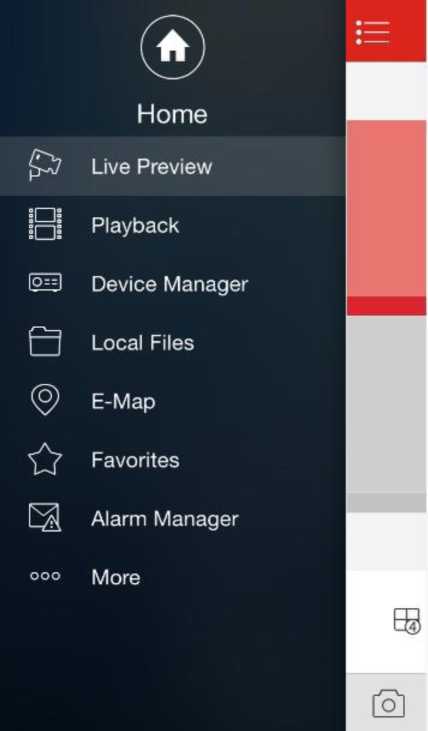
Figure 5-17
The interface requiring device initialization is displayed. A pop-up message reminding you to make sure the Device is initialized is displayed.
- Tap OK.
O If the Device has not been initialized, Tap Device Initialization to perform initializing by following the onscreen instructions.
O If the Device has been initialized, you can start adding it directly.
- Tap Add Device.
The Add Device interface is displayed. See Figure 5-18.
LJ NOTE
You can add wireless device or wired device. The Manual takes adding wired device as an example.
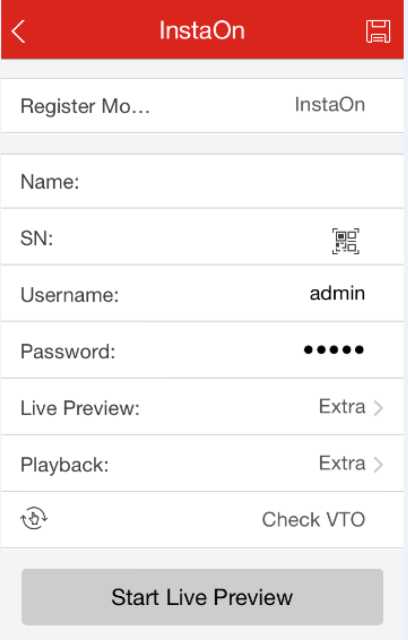
Figure 5-18
The InstaOn interface is displayed. See Figure 5-19.
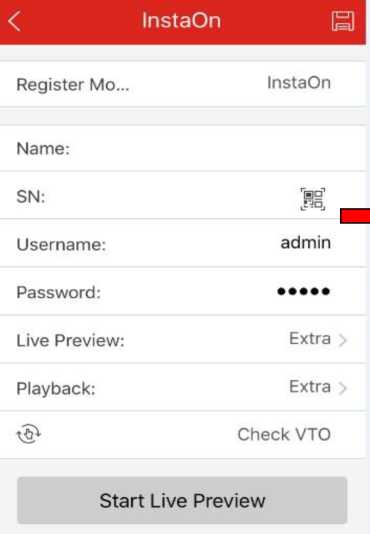
..■Il E 10:39 O 41%
(V) Scan QR Code
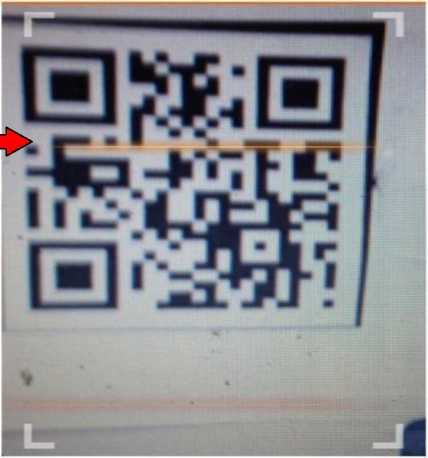
Figure 5-19
- Enter a name for the DVR (WITHOUT HDD), the username and password, scan the QR code under Device SN.
- Tap Start Live Preview.
The Device is added and displayed on the live view interface of the cell phone.
See Figure 5-20.
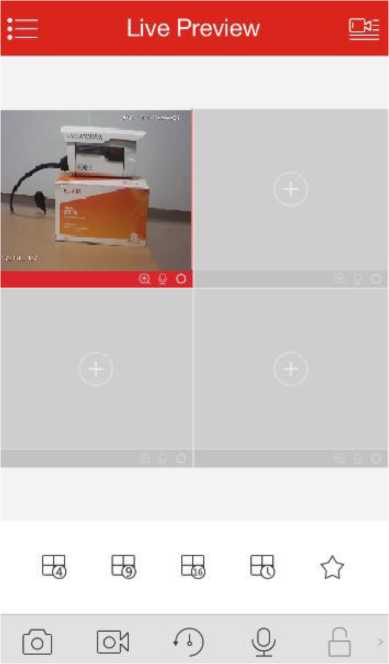
Figure 5-20
You can configure the settings of main stream and sub stream for the Device.
You can also configure encode settings by selecting Main Menu ^ Camera ■+ Encode ^ Encode.
Step 1 After you have configured the InstaOn settings, on the InstaOn interface, click Next. The Encode interface is displayed. See Figure 5-21.
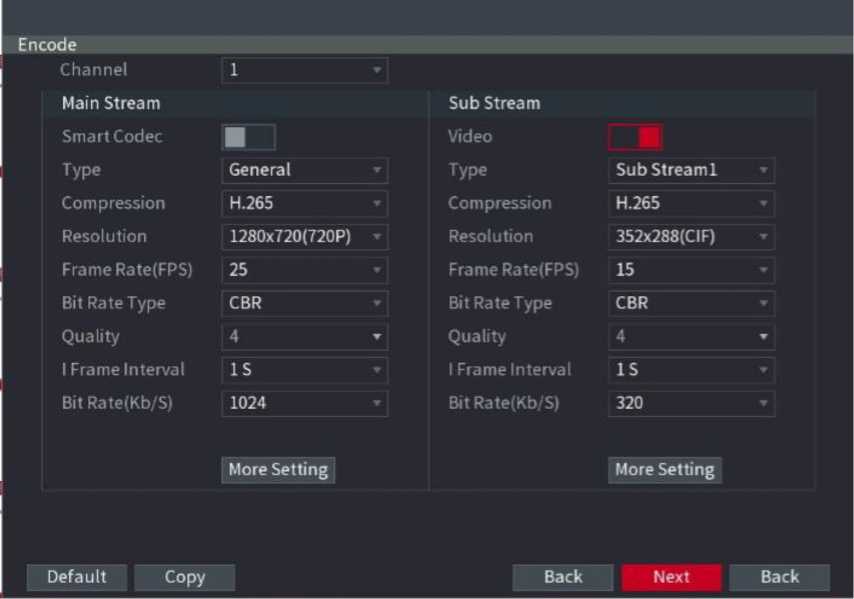
Figure 5-21
Step 2 Configure the settings for the main/sub streams parameters. See Table 5-6.
| Parameter | Description |
| Channel | In the Channel list, select the channel that you want to configure the settings for. |
| Smart Codec | Enable the smart codec function. This function can reduce the video bit stream for non-important recorded video to maximize the storage space. |
| Type |
Detect), or Alarm.
|
| Compression | In the Compression list, select the encode mode.
definition. This setting is recommended.
bit stream compared with other settings for the same definition. |
| Resolution | In the Resolution list, select resolution for the video.
The maximum video resolution might be different dependent on your device model. |
| Frame Rate (FPS) | Configure the frames per second for the video. The higher the value, the clearer and smoother the image will become. Frame rate changes along with the resolution.
Generally, in PAL format, you can select the value from 1 through 25; in NTSC format, you can select the value from 1 through 30. |
| However, the actual range of frame rate that you can select depends on the capability of the Device. | |
| Bit Rate Type | In the Bit Rate Type list, select CBR (Constant Bit Rate) or VBR (Variable Bit Rate). If you select CBR, the image quality cannot be configured; if you select VBR, the image quality can be configured. |
| Quality | This function is available if you select VBR in the Bit Rate List. The bigger the value is, the better the image will become. |
| I Frame Interval | The interval between two reference frames. |
| Bit Rate (Kb/S) | In the Bit Rate list, select a value or enter a customized value to change the image quality. The bigger the value is, the better the image will become. |
| Video | Enable the function for sub stream. |
| Audio Encode | Click More Setting, the More Setting interface is displayed.
stream. You need to manually enable it for sub stream 1. Once this function is enabled, the recorded video file is composite audio and video stream.
and HDCVI. O LOCAL: The audio signal is input from Audio In port. O HDCVI: The audio signal is input from HDCVI camera.
need. |
| Audio Source | |
| Audio Format |
Table 5-6
You can configure the basic snapshot settings such as quantity of snapshot each time, channel(s) to take snapshot, and image size and quality of snapshot.
You can also configure general settings by selecting Main Menu ■> Camera ^ Encode ^ Snapshot.
For more information about snapshot settings, see “5.8 Configuring Snapshot Settings.”
Step 1 After you have configured the encode settings, on the Encode interface, click Next.
The SNAPSHOT interface is displayed. See Figure 5-22.
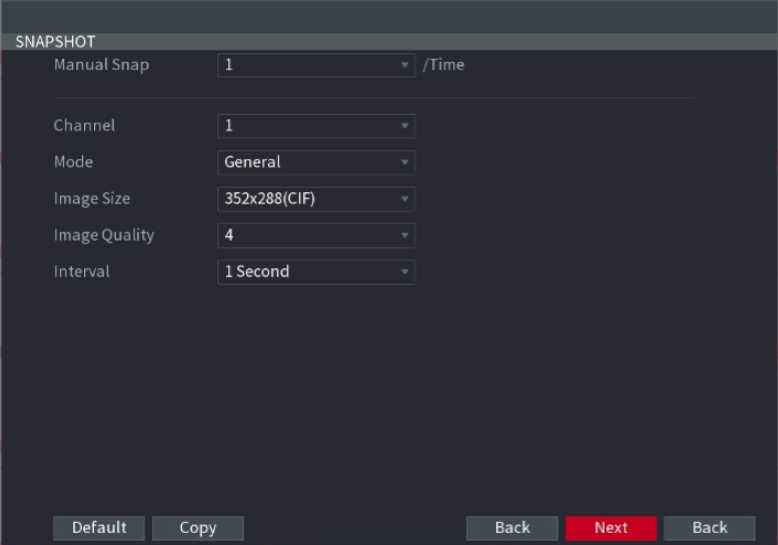
Figure 5-22
Step 2 Configure the settings for the snapshot parameters. See Table 5-7.
Table 5-7
You can configure the settings for the situations when HDD is full, file length and time length of recorded video, and the settings if to auto-delete the old files.
You can also configure basic storage settings by selecting Main Menu ^ Storage ^ BASIC.
Step 1 After you have configured the encode settings, on the SNAPSHOT interface, click Next.
The BASIC interface is displayed. See Figure 5-23.
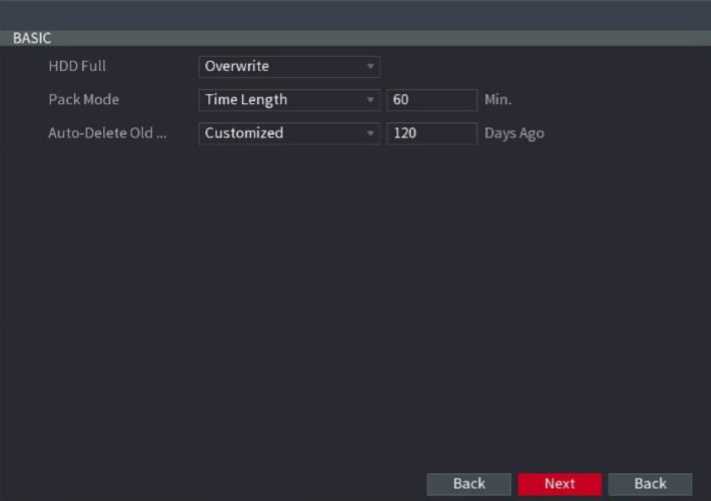
Figure 5-23
Step 2 Configure the basic storage settings parameters. See Table 5-8.
| Parameter | Description |
| HDD Full | Configure the settings for the situation when all the read/write discs are full, and there is no more free disc.
from the earliest time. |
| Pack Mode | Configure the time length and file length for each recorded video. |
| Auto-Delete Old Files | Configure whether to delete the old files and if yes, in the AutoDelete Old Files list, select Customized to configure the time length for how long you want to keep the old files. |
Table 5-8
You can configure the schedule for the recorded video such as channels to record, alarm settings, and the armed period.
You can also configure recorded video storage settings by selecting Main Menu ■+ Storage ■+ Schedule ^ Record.
Step 1 After you have configured the basic storage settings, on the BASIC interface, click Next.
The Record interface is displayed. See Figure 5-24.
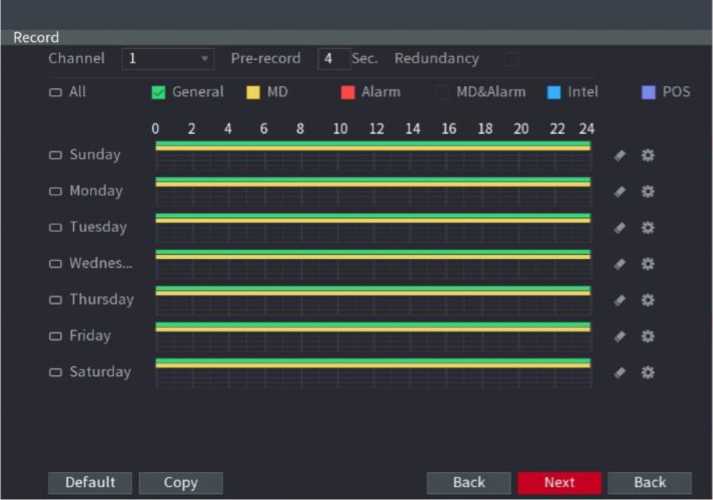
Figure 5-24
Step 2 Configure the record settings parameters. See Table 5-9.
| Parameter
Channel |
In the Channel list, select a channel to record the video. |
| Pre-record | In the Pre-record list, enter the amount of time that you want to start the recording in advance. |
| Redundancy | If there are several HDDs installed to the Device, you can set one of the HDDs as the redundant HDD to save the recorded files into different HDDs. In case one of the HDDs is damaged, you can find the backup in the other HDD.
a HDD as redundant HDD.
then select the Redundancy check box. O If the selected channel is not recording, the redundancy function takes effect next time you record no matter you select the check box or not. O If the selected channel is recording, the current recorded files will be packed, and then start recording according to the new schedule. CD NOTE
snapshots. |
| Event type | Select the check box of the event type which includes General, MD (motion detect, video loss, tempering, diagnosis), Alarm (IoT alarms, local alarms, alarms from alarm box, IPC external alarms, IPC Offline alarms), MD & Alarm, Intel (IVS events, face detection), and POS. |
| Period | Define a period during which the configured recording setting is active. |
Parameter
Description
| EO NOTE
The system only activates the alarm in the defined period. |
|
| Copy | Click Copy to copy the settings to other channels. |
Table 5-9
Step 3 Define the video recording period by drawing or editing. By default, it is active all the time.
• Define the period by drawing.
- Select the check box of event type. See Figure 5-25.
■ MD
| Alarm
MD&Alarm ■ Intel
■ 90S
Figure 5-25
- Define a period. The system supports maximum six periods.
o
Define for the whole week: Click H next to All, all the icon switches to □
o
you can define the period for all the days simultaneously.
Define for several days of a week: Click H before each day one by one, the
icon switches to S. You can define the period for the selected days
simultaneously.
On the timeline, drag to define a period. The Device starts recoding the selected
event type in the defined period. See Figure 5-26.
3)
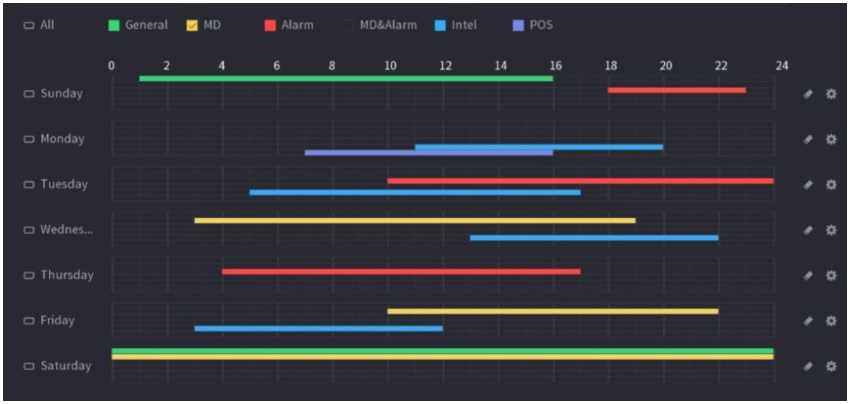
Figure 5-26
The color bar indicates the event type that is effective in a defined period:
CQ NOTE
- Recording priority in case of event types are overlapped: MD&Alarm •+ Alarm ^ Intel ^ MD ^ General.
•
Select the check box of event type, and then click
![]()
to clear the defined
period.
- When selecting MD&Alarm, the respective check box of MD and Alarm will be cleared.
• Define the period by editing. Take Sunday as an example.
1)
Click
![]()
The Period interface is displayed. See Figure 5-27.
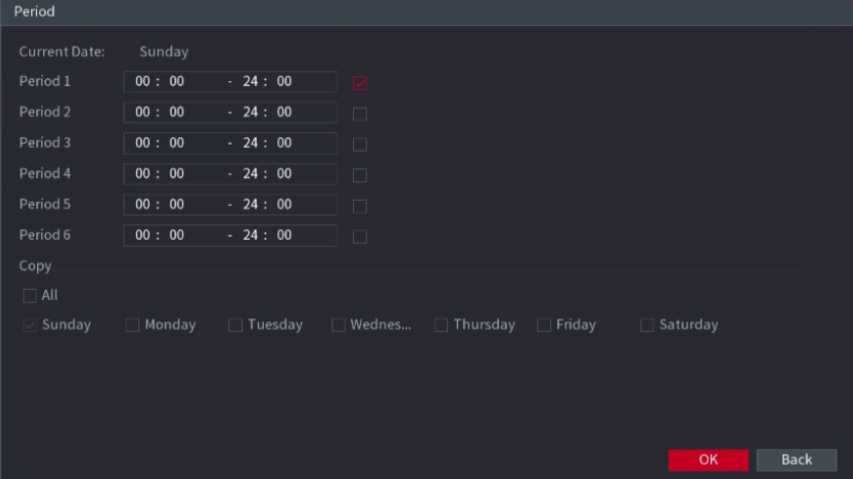
Figure 5-27
O There are six periods for you to set for each day.
O Under Copy, select All to apply the settings to all the days of a week, or select specific day(s) that you want to apply the settings to.
- Click Apply to save the settings.
Step 4 Click Apply to complete the settings.
EQ NOTE
- Click Copy to copy the settings to other channels.
- After configuring the recording schedule settings, you need to perform the following operations to start recording according to the defined schedule. O Enable the alarm event and cofigure the settings for the recording channel.
For details, see “5.10 Alarm Events Settings.”
O You need to enable the recording function, see “5.9.1 Enabling Record Control.”
5.1.4.10 Configuring Snapshot Storage Schedule
You can configure the storage schedule for the snapshot such as channels to take snapshot, alarm settings, and the armed period.
You can also configure snapshot storage settings by selecting Main Menu ^ Storage ■+
Schedule ^ Snapshot.
Step 1 After you have configured the video recording settings, on the Record interface, click Next.
The SNAPSHOT interface is displayed. See Figure 5-28.
| Snapshot | ||||||||
| Channel 1 | ||||||||
| o Alt | Q General | ■ MD | ■ Alarm | MD&Alarm | ■ Intel | |||
| 0 | 2 4 | 6 8 | 10 12 14 | 16 18 | 20 | 22 24 | ||
| o Sunday | a | |||||||
| □ Monday | a | |||||||
| o Tuesday | « | |||||||
| □ Wednes… | a | |||||||
| o Thursday | o | |||||||
| o Friday | a | |||||||
| o Saturday | a | |||||||
Default
Copy
Back Finished Back
Figure 5-28
Step 2 Configure the snapshot settings parameters. See Table 5-10.
| Parameter | Description |
| Channel | In the Channel list, select a channel to take a snapshot. |
| Event type | Select the check box of the event type which includes General, MD, Alarm, MD&Alarm, Intel, and POS. |
| Period | Define a period during which the configured snapshot setting is active. For details about defining a period, see “5.1.4.9 Configuring Recorded Video Storage Schedule.“ |
| Copy | Click Copy to copy the settings to other channels. |
Table 5-10
Step 3 Click Finished.
A pop-up message is displayed.
Step 4 Click OK.
The live view screen is displayed. The setting up with startup wizard is completed. You can start using the Device.
After you logged in the Device, the live view is displayed. See Figure 5-29. The number of channels displayed depends on your model.
To enter the live view screen from other interfaces, click
![]()
on the top right of the screen.
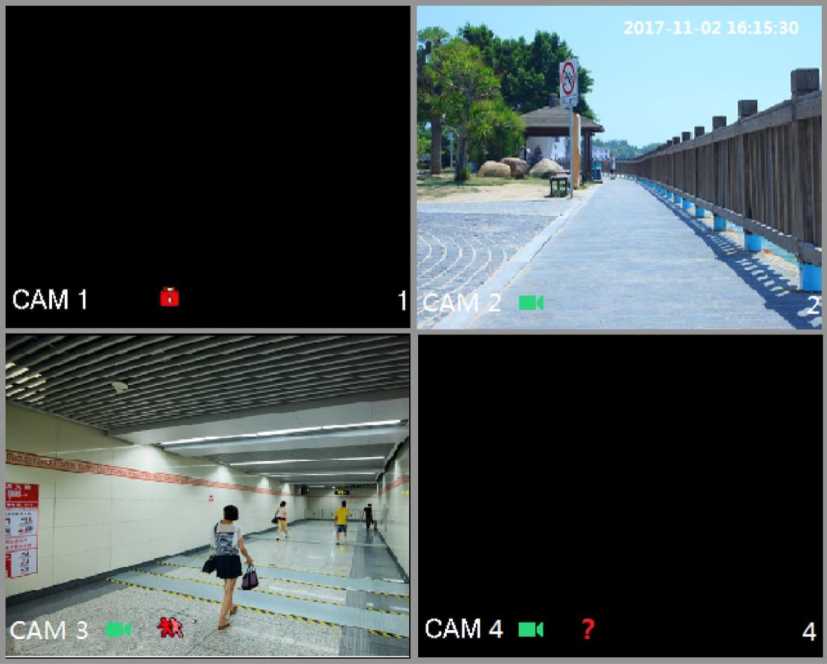
Figure 5-29
You can view the live video from the connected cameras through each channel on the screen.
- By default, the system time, channel name and channel number are displayed on each channel window. This setting can be configured by selecting Main Menu > Camera > OVERLAY.
- The figure in the bottom right corner represents channel number. If the channel position is changed or the channel name is modified, you can recognize the channel number by this figure and then perform the operations such as record query and playback.
For the icons displayed on each channel, see Table 5-11.
Table 5-11
TIPS
To switch the position of two channels, point to one of the two channels, and then drag the window to the other channel.
The live view control bar provides you access to perform the operations such as playback, zoom, real-time backup, manual snapshot, voice talk, adding remote devices, and streams switch.
When you move the pointer to the top middle position of a channel window, the live view control bar is displayed. See Figure 5-30 for analog channel and Figure 5-31 for digital channel.
NOTE
If there is not operation for six seconds after the control bar is displayed, the control bar hides automatically.
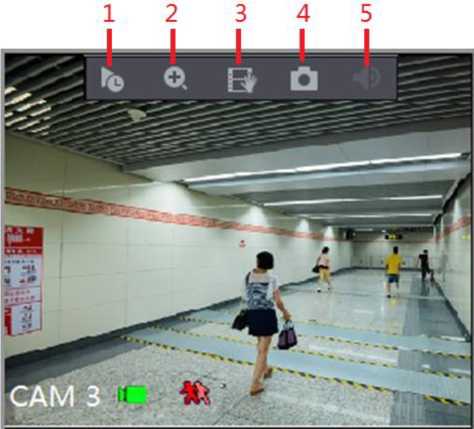
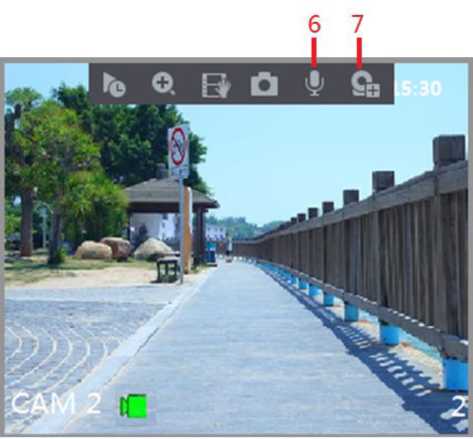
| No. | Function | No. | Function | No. | Function |
| 1 | Instant Play | 4 | Manual Snap | 7 | Add IP Camera |
| 2 | Digital Zoom | 5 | Mute | ||
| 3 | Real-time
Backup |
6 | Audio Talk |
You can play back the previous five minutes to sixty minutes of the recorded video.
By clicking □, the instant playback interface is displayed. The instant playback has the
following features:
- Move the slider to choose the time you want to start playing.
- Play, pause and close playback.
- The information such as channel name and recording status icon are shielded during instant playback and will not display until exited.
- During playback, screen split layout switch is not allowed.
- To change the playback time, select Main Menu ^ System > GENERAL, in the Instant Play box, enter the time you want to play back. See Figure 5-32.
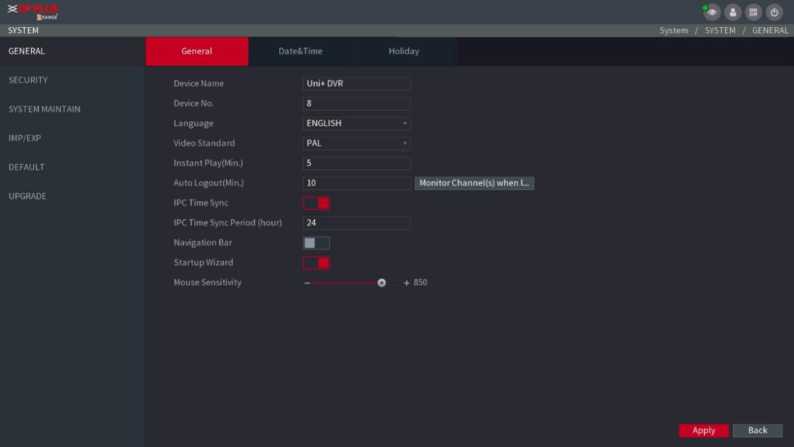
Figure 5-32
You can enlarge a specific area of the image to view the details by either of the following two ways.
- Click Ltl, the icon switches to ^3. Hold down the left mouse button to select the area
you want to enlarge. The area is enlarged after the left mouse button is released.
- Point to the center that you want to enlarge, rotate the wheel button to enlarge the area.
NOTE
- For some models, when the image is enlarged in the first way described previously, the selected area is zoomed proportionally according to the window.
- When the image is in the enlarged status, you can drag the image toward any direction to view the other enlarged areas.
•
Right-click on the enlarged image to return the original status.
You can record the video of any channel and save the clip into a USB storage device.
By clicking , the recording is started. To stop recording, click this icon again. The clip is
automatically saved into the connected USB storage device.
You can take one to five snapshots of the video and save into a USB storage device.
By clicking you can take snapshots. The snapshots are automatically saved into the
connected USB storage device. You can view the snapshots on your PC.
NOTE
To change the quantity of snapshots, select Main Menu ^ Camera ^ Encode ^ Snapshot, in the Manual Snap list, select the snapshot quantity.
You can mute the video sound by clicking
![]()
. This function is supported in single-channel
view.
You can perform the voice interaction between the Device and the remote device to improve
efficiency of emergency. This function is supported only when the remotely connected IPC
device supports bidirectional talk.
, the icon switches to ^3, the bidirectional talk of the remote device is turned
on. The bidirectional talk of other digital channels is disabled.
• Click □ to cancel the bidirectional talk. The bidirectional talk of other digital channels is resumed.
• Click
You can view the information of remote devices and add new remote devices to replace the current connected devices.
By clicking LJ, the Camera Registration interface is displayed. For details about adding the
remote devices, see “5.6 Configuring Remote Devices.”
You can access the functions to perform operations through the function icons on the navigation bar. For example, you can access Main Menu and switch window split mode. See Figure 5-33. CD NOTE
The navigation bar is disabled by default. It does not appear in the live view screen until it is enabled. To enable it, select Main Menu ^ System ^ General, enable the Navigation Bar, and then click Apply.
![]()
Figure 5-33
| Icon | Function | |
| □ | Open Main Menu. | |
| 0 | Expand or condense the navigation bar. | |
| i_uuia» | Select view layout. | |
| Go to the previous screen. | ||
| IE] | Go to the next screen. | |
| Enable tour function. The icon switches to ^^3. | ||
| □ | Open the PTZ control panel. For details, see “5.4 Controlling PTZ Cameras.“ | |
| Open the Color Setting interface. For details, see “5.2.5 Color Setting.”
CD NOTE |
||
| This function is supported only in single-channel layout. | ||
| Open the record search interface. For detail, see “5.9 Playing Back Video.“ | ||
| H | Open the EVENT interface to view the device alarm status. For details, see “5.19.3 Viewing Event Information.“ | |
| E3 | Open the CHANNEL INFO interface to display the information of each channel. | |
| Open the CAMERA REGISTRATION interface. For details, see “5.6.1 Adding Remote Devices.“ | ||
| Open the NETWORK interface. For details, see “5.14.1 Configuring Network Settings.“ | ||
| o | Open the HDD MANAGER interface. For details, see “5.17.3 Configuring HDD Manager.“ | |
| Icon | Function | |
| Open the USB MANAGER interface. For details about USB operations, see “5.13.2 Backing up Files”, “5.19.2 Viewing Log Information”, “5.18.5 Exporting and Importing System Settings”, “5.18.7 Upgrading the Device.“ | ||
Table 5-12
You can quickly access some function interfaces such as main menu, record search, PTZ setting, color setting and select the view split mode.
Right-click on the live view screen, the shortcut menu is displayed. See Figure 5-34. For details about the functions of shortcut menu, see Table 5-13.
CD NOTE
After you access any interface through shortcut menu, you can return to the previous screen by right-clicking on the current screen.
Main Menu
Q Search
W PTZ
■ View 1 ►
S View 4 »
■- View 8 ►
S View 9 ►
Si View 16 : Previous Screen : Next Screen
S Manual ►
Preview Mode »
S Color Setting
3G
a Image
Figure 5-34
| Function | Description |
| Main Menu | Open Main Menu interface. |
| Search | Open the Playback interface where you can search and play back record files. |
| PTZ | Open the PTZ interface. |
| View Layout | Configure the live view screen as a single-channel layout or multichannel layout. |
| Previous Screen | Click Previous Screen to go to the previous screen. For example, if you are using 4-split mode, the first screen is displaying the channel 1-4, click Next screen, you can view channel 5-8. |
| Next Screen | |
| Camera Registration | Open the CAMERA REGISTRATION interface. For details, see “5.6 Configuring Remote Devices |
| Function | Description |
| Adding Remote Devices.“ | |
| Manual |
Auto or Manual, or stop the recording. You can also enable or disable snapshot function
|
| Preview Mode |
displayed in the bottom of the live view screen. |
| Auto Focus | Point to the channel window and right-click on it to open the shortcut menu, and then click Auto Focus.
Cfl NOTE |
| Not all cameras support this function. | |
| Color Setting | Open the COLOR interface where you can adjust the video image color. |
| Image | Click to modify the camera properties. |
Table 5-13
You can adjust the video image color effect such as sharpness, brightness, and contrast. The parameters are different according to the connected camera type. Take analog channel as an example.
In the live view screen, right-click on the analog channel to see the shortcut menu, and then select Color Setting, the COLOR interface is displayed. See Figure 5-35.
For details, see “5.5.1 Configuring Image Settings.”
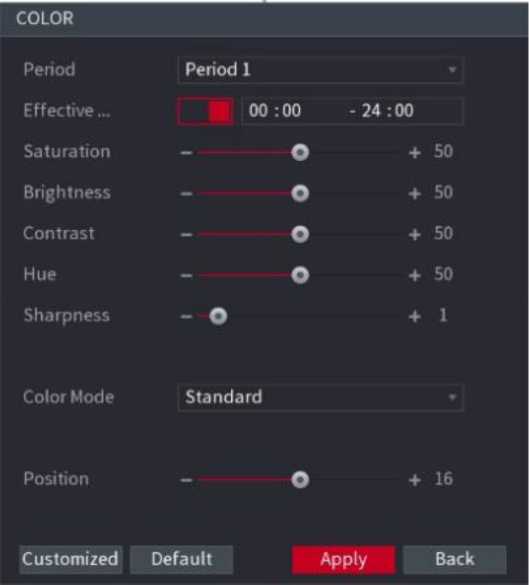
| Parameter | Description |
| Period | Divide 24 hours into two periods and configure the corresponding color settings. |
| Effective Time | Enable the function and then set the effective time for each period. |
| Sharpness | Adjust the sharpness of image edge. The bigger the value is, the more obvious the image edge, and the noise is also greater.
The value ranges from 1 to 15. The default value is 1. |
| Hue | Adjust the hue of image. The value ranges from 0 to 100. The default value is 50. |
| Brightness | Adjust the image brightness. The value ranges from 0 to 100. The default value is 50.
The bigger the value is, the brighter the image will become. You can adjust this value when the image as a whole looks dark or bright. However, the image is likely to become dim if the value is too big. The recommended range is between 40 and 60. |
| Contrast | Adjust the image contrast. The bigger the value is, the more obvious the contrast between the light area and dark area will become. You can adjust this value when the contrast is not obvious. However, if the value is too big, the dark area is likely to become darker and the light area over exposed. If the value is too small, the image is likely to become dim.
The value ranges from 0 to 100. The default value is 50. The recommended range is between 40 and 60. |
| Saturation | Adjust the color shades. The bigger the value, the lighter the color will become. This value does not influence the general image lightness.
The value ranges from 0 to 100. The default value is 50. The recommended range is between 40 and 60. |
| Color Mode | In the Color Mode list, you can select Standard, Soft, Bright, Colorful, Bank, Customized 1, Customized 2, Customized 3, and Customized 4.
The sharpness, hue, brightness, contrast and saturation will adjust automatically according to the selected color mode. |
| EQ | Enhance the image effect. Adjust the effect value.
♦ Click ^3, image is adjusted to the optimized effect automatically. • Click ^3, the current effect setting will be locked. EO NOTE |
| Only HD analog channel supports this function. | |
| Position | Adjust the display position of the image in the channel window.
The value indicates pixel. The default value is 16. CO NOTE |
| This function is only supported by analog channel. |
| Parameter | Description |
| Customized | You can customize four color modes.
displayed.
Then configure the settings for sharpness, hue, brightness, contrast and saturation. If you select All, the configuration will apply to all four customized color modes.
select the customized color mode. |
Table 5-14
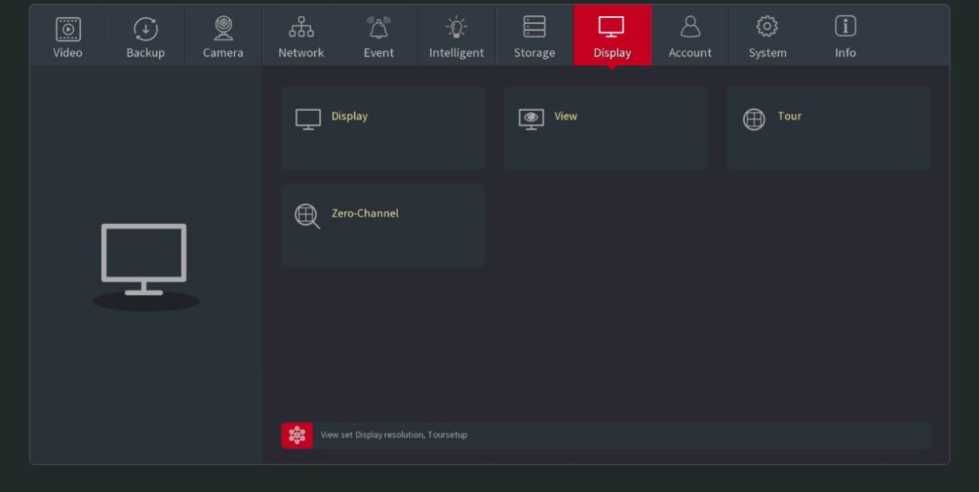
You can configure the display effect such as displaying time title and channel title, adjusting image transparency, and selecting the resolution.
Step 1 Select Main Menu ^ Display ■+ Display.
The DISPLAY interface is displayed.See Figure 5-36.
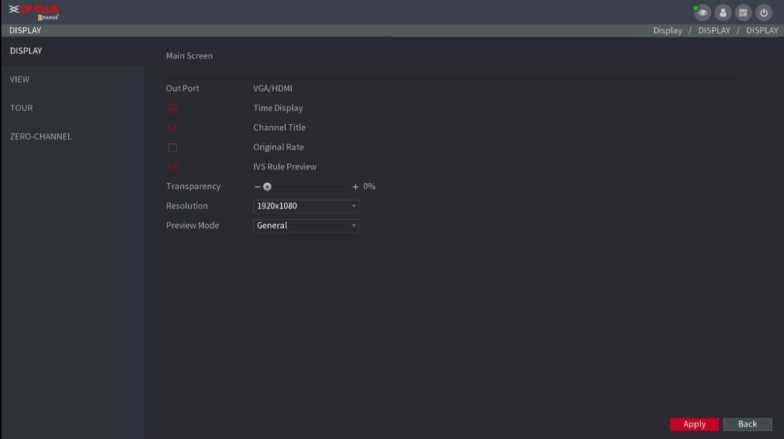
Figure 5-36
Step 2 Configure the settings for the display parameters. See Table 5-15.
| Parameter | Description | |
| Main
Screen |
Out Port | Indicates the main screen port. |
| Time Title | Select the Time Title check box, the current system time displays in each channel window in live view screen. To hide the time, clear the check box. | |
| Channel Title | Select the Channel Title check box, the channel name, channel number and recording status display in each channel window in live view screen. To hide the time, clear the check box. | |
| Original Rate | Select the Original Rate check box, the video image displays in its actual size in the channel window. | |
| IVS Rule Preview | Select the IVS Rule Preview check box to enable IVS rule preview function. | |
| Transparency | Configure the transparency of the graphical user interface (GUI). The higher the value, the more transparent the GUI becomes. | |
| Resolution | Select resolution for the video. The default resolution for VGA port and HDMI port is 1280×1024.
OJ NOTE |
|
| Some of the resolution options might not be supported on the | ||
| HDMI port. | ||
| Preview Mode |
window.
taken as a result of face detection on the bottom of the live view screen. CQ NOTE |
|
| Not all models support this function. | ||
Parameter
Description
| Enable | Enable extra screen function. After this function is enabled, you can select which port as extra screen port, and the other port automatically becomes the main screen port. | |
| Extra
Screen |
Out Port | Select the VGA port or HDMI port as the port connected by a secondary monitor. For example, if you select HDMI port as the extra screen port, the VGA port automatically becomes the main screen port. |
| Resolution | Select resolution for the video. The default resolution for VGA port and HDMI port is 1280×720.
CD NOTE |
|
| Some of the resolution options might not be supported on the | ||
| HDMI port. |
CD NOTE
• The main menu does not display on the extra screen.
• If you do not enable the extra screen function, both the VGA port and HDMI port
display the same image.
Table 5-15
You can configure the view layout in the live view screen.
Step 1 Select Main Menu ^ Display ^ VIEW.
The View Setting interface is displayed.See Figure 5-37.
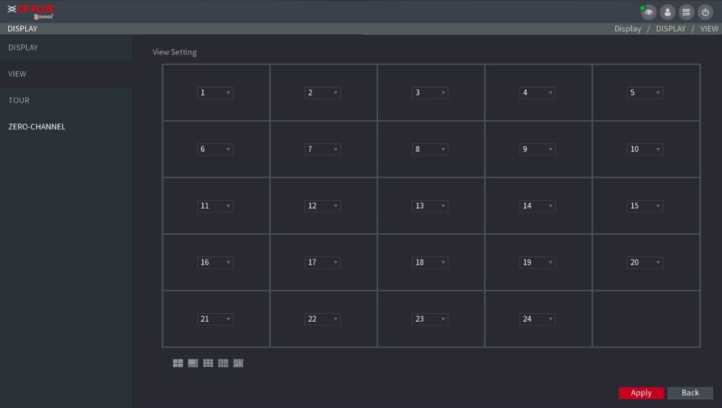
Figure 5-37
Step 2 Configure the view layout by clicking the layout buttons on the bottom. See Figure 538.

Figure 5-38
For example, click and select 9-16, the view layout changes immediately,
see
Ji
DISPLAY
DISPLAY
VIEW
TOUR
ZERO-CHANNEL
• A S (!)
Display / DISPLAY / VIEW
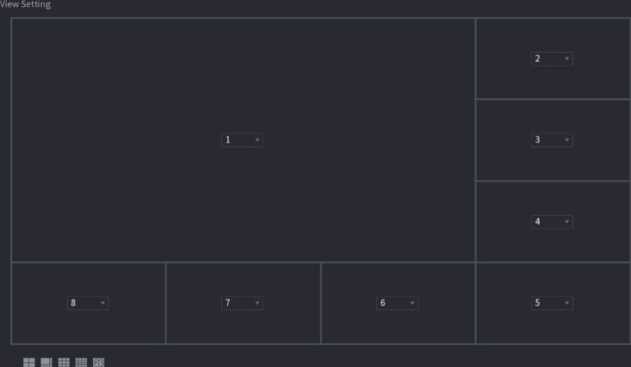
Apply Back
Figure 5-39
Step 3 Adjust the position of channels if needed.
In the channel list, for example, in the channel 9 list, you can select 10, and then the channel 9 and channel 10 exchange positions.
Step 4 Click Apply to complete the settings.
The live view screen displays the same layout as configured in this section.
You can view several video sources on one channel on the web end.
Step 1 Select Main Menu ■> Display ■> Zero-Channel.
The ZERO-CHANNEL interface is displayed.See Figure 5-40.
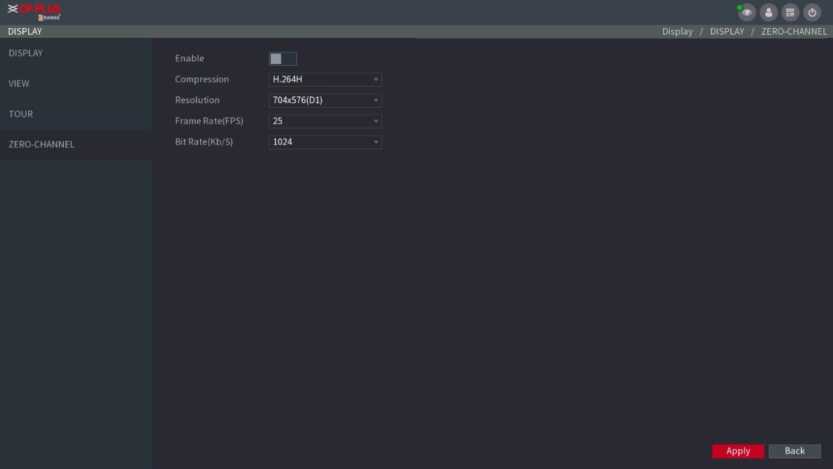
Step 2 Configure the settings for the zero-channel parameters. See Table 5-16.
Table 5-16
Step 3 Click Apply to save the settings.
In the live interface on the web, click
![]()
to select one of the
multi-channel modes, and then you can view the local video image.
ΠNOTE
Not all models support this function.
You can adjust the border margins in top, bottom, left and right directions as well as the brightness of the monitor connected to the Video out port of the Device.
Step 1 Select Main Menu ^ Display ^ Tv Adjust.
The TV ADJUST interface is displayed.See Figure 5-41.
| DISPLAY | Tûp Mai yin | -Ö | + 0 | |
| VIEW | Rcltcwn Margin | -o | + Û | |
| KHJR | Leit Mai jo | -o | + 0 | |
| ZERO-CHANHEL | FùgFl Mai pn | -o | + 0 | |
| TV ADJUST | Brightness | o | + 12« |
Figure 5-41
Step 2 Configure the parameters according to your actual situation.
Step 3 Click Apply to complete the settings.
You can configure a tour of selected channels to repeat playing videos. The videos display in turn according to the channel group configured in tour settings. The system is playing one channel group for a certain period and then automatically changes to the next channel group.
Step 1 Select Main Menu ■> Display ^ TOUR.
The TOUR interface is displayed. There are MainScreen tab and ExtraScreen tab, see Figure 5-42 and Figure 5-43.
![]()
| DISPLAY | Display > | ‘ DISPLAY / | ‘ TOUR | ||
| DISPLAY | Main Screen | ||||
| VIEW | Enable | !■ | |||
| Interval(Sec) | 5 | ||||
| TOUR | |||||
| Video Detect | View 1 | ||||
| ZERO-CHANNEL | Alarm | Viewl | |||
| Window Split | Viewl |

Add Modify Delete Move up Move down
Default
Apply Back
Figure 5-42
| CtSFLAV | Mùiî Szceri | EKii’j Soma | |
| YEW | En-sWe | ■_ | |
| 1C4JR | Itïï-vAÎSm. j | 5 | |
| ffiAOrCMWfflÊL | |||
| Lfrrta Efdii | |||
| 77Âri.ii.F$,T | |||
| IB J | C-A-nd i”r>xi2 |
![]()
a j a
3 2
4 ■/ 4
- i
- / ?
u j a
B J S
TO J TO
Md Krikty lifte to Mow up «uwiiwffl
Figure 5-43
Step 2 Configure the settings for the tour parameters for both Main Screen and Extra Screen.
See Table 5-17.
| Parameter | Description |
| Enable | Enable tour function. |
| Interval (Sec.) | Enter the amount of time that you want each channel group displays on the screen. The value ranges from 5 seconds to 120 seconds, and the default value is 5 seconds. |
| Video Detect, Alarm | Select the View 1 or View 8 for Motion Detect tour and Alarm Tour (system alarm events). |
| Window Split | In the Window Split list, select View 1, View 4, View 8, or other modes that are supported by the Device. |
| Channel Group | Display all channel groups under the current Window Split setting.
channel, select the channels to form a group, and then click Save.
group, and then click Delete.
and then click Modify, or double-click on the group. The Modify Channel Group dialog box is displayed. You can regroup the channels.
group. |
Table 5-17
Step 3 Click Apply to save the settings. TIPS
•
•
On the top right of the live view screen, use the left mouse button or press Shift
to switch between (image switching is allowed) and ‘•=?> (image switching is
not allowed) to turn on/off the tour function.
| On the navigation bar, click | o | to enable the tour and click | to disable |
it.
Adding a Channel Group
Step 1 Click Add.
The Add Group interface is displayed. See Figure 5-44.
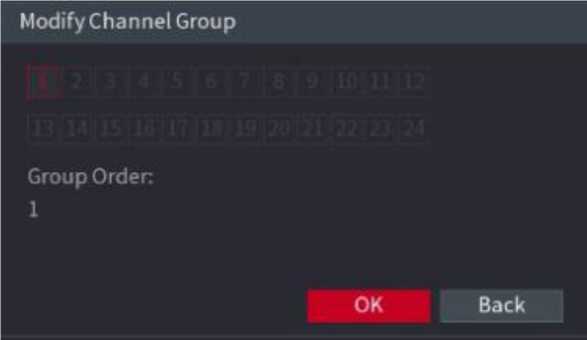
Figure 5-44
Step 2 Select the channels that you want to group for tour. See Figure 5-45.
EQ NOTE
If you want to select more than one channel, in the Window Split list, do not select View 1.
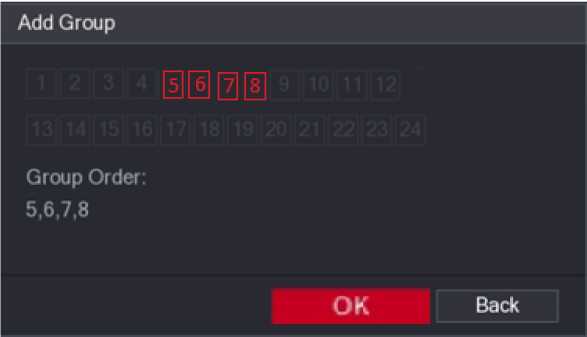
Figure 5-45
Step 3 Click OK to complete the settings.
Double-click on a channel group, the Modify Channel Group interface is displayed. See Figure 5-46.
You can modify channel group and click OK to complete the settings.
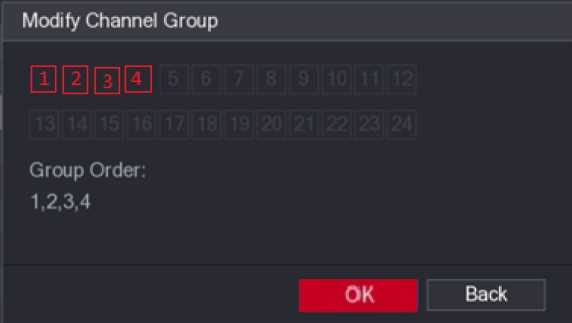
Figure 5-46
Right-click on the live view screen, the shortcut menu is displayed, Click Main Menu and then login the system. The Main Menu is displayed, see Figure 5-47.
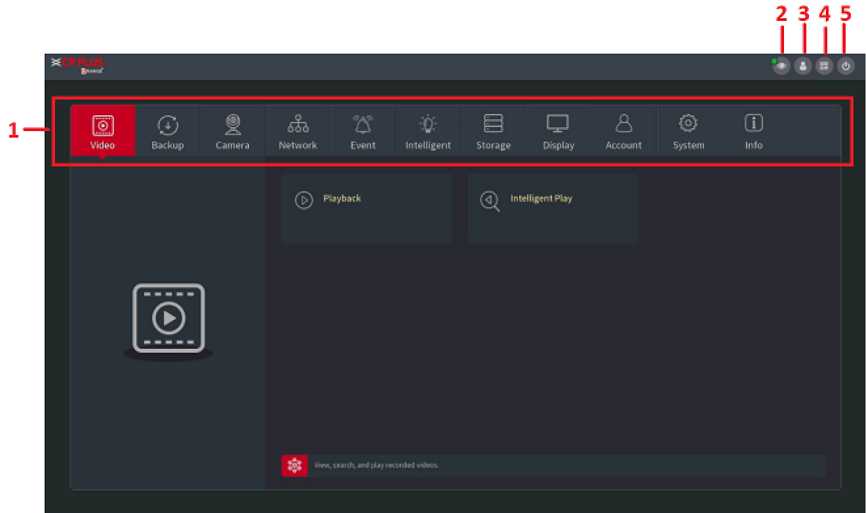
| No. | Icon | Description | ||
| 1 | Function tiles | Includes eleven function tiles: Video, Backup, Camera, Network, Event, intelligent, Storage, Display, Account, System, and Info. Click each tile to open the configuration interface of the tile.
Device.
external storage device such as USB storage device.
snapshot settings etc.
InstaOn Cloud etc.
actions.
detecting tripwire, intrusion, abandoned objects, and missing objects, POS (Point of Sale), Face Detection and loT.
snapshot.
image transparency, and resolution, and enable the zero-channel function.
Onvif User.
time, language settings and PTZ settings.
|
||
| 2 | Live | Click to go to the live view screen. | ||
| 3 | D | When you point to ^3, the current user account is displayed. | ||
| 4 | ■ ■ | Click Q, select Logout, Reboot, or Shutdown according to your actual situation. | ||
| 5 | □ | Displays Cell Phone Client and Device SN QR Code.
add the device into the Cell Phone Client, and then you can start accessing the Device from your cell phone.
the InstaOn management platform and add the Device SN into the platform. Then you can access and manage the device in the WAN. For details, please refer to the InstaOn operation manual. You can also configure InstaOn function in the local configurations. See “5.1.4.5 Configuring InstaOn Settings.“ |
||
Table 5-18
PTZ is a mechanical platform that carries a camera and a protective cover and performs overall control remotely. A PTZ can move in both horizontal and vertical direction to provide all-around view to the camera.
CD NOTE
Before operating PTZ, please assure the network connection between PTZ and the Device.
You need to configure the PTZ connection settings before use.
- Local connection: RS485 Port for connecting Speed Dome or coaxial cable for connecting coaxial camera.
- Remote connection: local area network.
Step 1 Select Main Menu ■> Camera ^ PTZ.
The PTZ interface is displayed. See Figure 5-48.
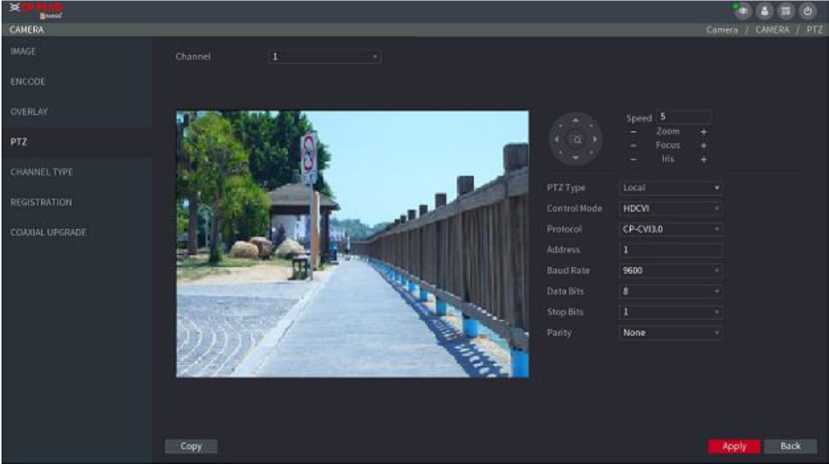
Figure 5-48
Step 2 Configure the settings for the PTZ connection parameters. See Table 5-19.
| Parameter | Description |
| Channel | In the Channel list, select the channel that you want to connect the PTZ camera to. |
| PTZ Type |
camera to the Device. |
| Control Mode | In the Control Mode list, select Serial or HDCVI. For HDCVI series product, please select HDCVI. The control signal is sent to the PTZ through the coaxial cable. For the serial mode, the control signal is sent to the PTZ through the RS485 port. |
| Protocol | In the Protocol list, select the protocol for the PTZ camera, for example, select HDCVI3.0. |
Table 5-19
Step 3 Click Apply to save the settings.
EQ NOTE
Click Copy to copy the settings to other channels.
PTZ control panel performs the operations such as directing camera in eight directions, adjusting zoom, focus and iris settings, and quick positioning.
Right-click on the live view screen and then select PTZ. The PTZ control panel is displayed. See Figure 5-49.

Figure 5-49
![]()
The functions with buttons in gray are not supported by the system.
| Speed | Controls the movement speed. The bigger the value is, the faster the movement will be. |
| Zoom | 3: Wide angle.
^3: Long shot. |
| Focus | 3: Zoom in. ^3: Zoom out. |
| Parameter | Description |
| Iris | 3: Small.
^3: Large. |
| PTZ movement | Supports eight directions. |
| Fast positioning button.
• Positioning: Click ^3 to enter the fast positioning screen, and then click anywhere on the live view screen, the PTZ will turn to this point and move it to the middle of the screen. ♦ Zooming: On the fast positioning screen, drag to draw a square on the view. The square supports zooming. O Dragging upward is to zoom out, and dragging downward is to zoom in. O The smaller the square, the larger the zoom effect. CQ NOTE Not all models support this function and can only be controlled through mouse operations. |
|
| □ | Click U, you can control the four directions (left, right, up, and down) PTZ movement through mouse operation. |
| Click ^3 to open the expanded PTZ control panel. | |
Table 5-20
On the basic PTZ control panel, click
to open the expanded PTZ control panel to find more
options. See Figure 5-50.
![]()

Figure 5-50
• The functions with buttons in gray are not supported by the system.
• Right-click once to return to the interface of PTZ basic control panel.
| Icon | Function | Icon | Function |
| 01 | Preset | Auto Pan |
| A * *-• | Tour | Flip | |||||
| Pattern | Reset | ||||||
| Autoscan | Click the AUX Config icon to open the PTZ functions settings interface. | ||||||
| 3 | AUX Switch | □ | Click the Enter Menu icon to open the MENU OPERATION interface. | ||||
Table 5-21
Step 1 On the Expanded PTZ Control Panel, click
![]()
The Preset interface is displayed. See Figure 5-51.
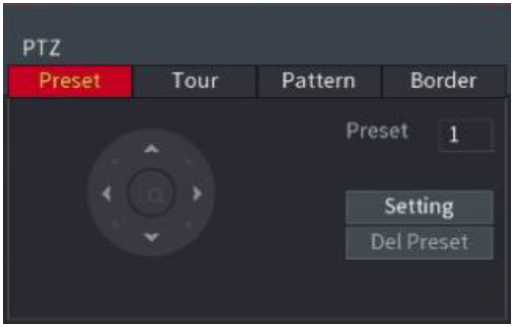
Figure 5-51
Step 2 Click the direction arrows to the required position.
Step 3 In the Preset box, enter the value to represent the required position.
Step 4 Click Setting to complete the preset settings.
Step 1 On the Expanded PTZ Control Panel, click
The PTZ interface is displayed.
Step 2 Click the Tour tab.
The Tour tab is displayed. See Figure 5-52.
PTZ Preset Tour Pattern Border
Preset i
Patrol… o
Add Preset
Del Preset
Del Tour
Figure 5-52
Step 3 In the Patrol No. box, enter the value for the tour route.
Step 4 In the Preset box, enter the preset value.
Step 5 Click Add Preset.
A preset will be added for this tour.
ED NOTE
- You can repeat adding more presets.
- Click Del Preset to delete the preset for this tour. This operation can be repeated to delete more presets. Some protocols do not support deleting.
Step 1 On the Expanded PTZ Control Panel, click
![]()
The PTZ interface is displayed.
Step 2
Click the Pattern tab.
The Pattern interface is displayed. See Figure 5-53.
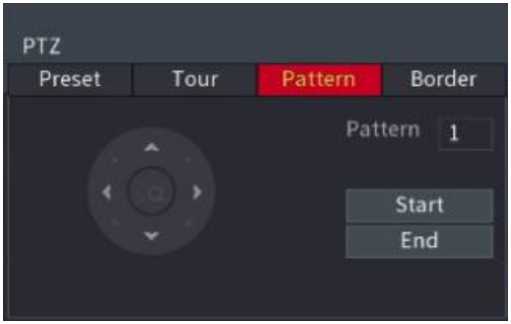
Figure 5-53
Step 3 In the Pattern box, enter the value for pattern.
Step 4 Click Start to perform the directions operations. You can also go to the PTZ Control Panel to perform the operations of adjusting zoom, focus, iris, and directions.
Step 5 On the PTZ interface, click End to complete the settings.
Step 1 On the Expanded PTZ Control Panel, click .
The PTZ interface is displayed.
Step 2 Click the Border tab.
The Border interface is displayed. See Figure 5-54.
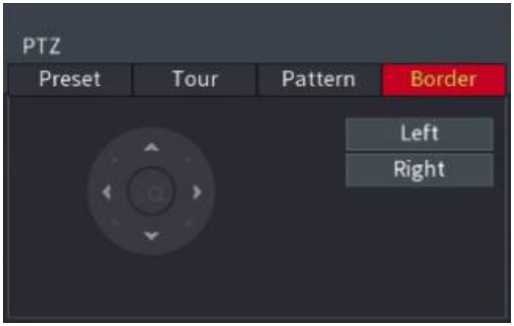
Figure 5-54
Step 3 Click the direction arrows to position the left and right borders.
After you have configured the PTZ settings, you can call the PTZ functions for monitoring from the Expanded PTZ Control Panel. See Figure 5-55.
| a. Speed 5 | No. 0 | 9 | ▼ | |
| — Zoom | + | |||
| < i.Q ► _ | 0| | • • 1 | ||
| — Focus | + | |||
| v 8 — Iris | + | iol ♦* | 0 |
Figure 5-55
Step 1 On the Expanded PTZ Control Panel, in the No. box, enter the value of the preset that you want to call.
Step 2 Click [Si to call the preset.
Step 3 Click [Si again to stop calling the preset.
Step 1 On the Expanded PTZ Control Panel, in the No. box, enter the value of the tour that you want to call.
Step 2 Click to call the tour.
Step 3 Click
![]()
again to stop calling the tour.
Step 1 On the Expanded PTZ Control Panel, in the No. box, enter the value of the pattern that you want to call.
Step 2 Call I9l to call the pattern.
The PTZ camera moves according to the configured pattern repeatedly.
Step 3 Click ISI again to stop calling the pattern.
Step 1 On the Expanded PTZ Control Panel, in the No. box, enter the value of the border that you want to call.
Step 2 Click SI.
The PTZ camera performs scanning according to the configured borders.
Step 3 Click l^l again to stop auto canning.
Step 1
On the Expanded PTZ Control Panel, click
![]()
to start moving in horizontal direction.
Step 2 Click s
again to stop moving.
On the Expanded PTZ Control Panel, click , the AUX setting interface is displayed. See Figure 5-56.
- In the Direct Aux list, select the option that corresponds to the applied protocol.
- In the Aux Num box, enter the number that corresponds to the AUX switch on the
decoder.
AUX
On Off
On Off
Direct Aux
NONE
Aux Num
1
Figure 5-56
For the coaxial camera, you can call the OSD menu through the Expanded PTZ Control Panel. See Figure 5-55.
Step 1
On the Expanded PTZ Control Panel, click
![]()
The MENU OPERATION interface is displayed. See Figure 5-57.
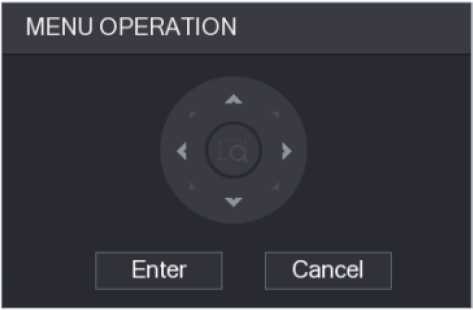
Figure 5-57
The OSD menu is displayed. See Figure 5-58.
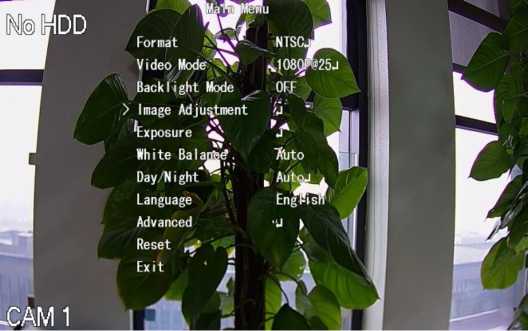
Figure 5-58
Step 3 On the MENU OPERATION interface, click the arrow button to select the onscreen parameters.
Step 4 Click Enter to complete the settings.
5.5 Configuring Camera Settings
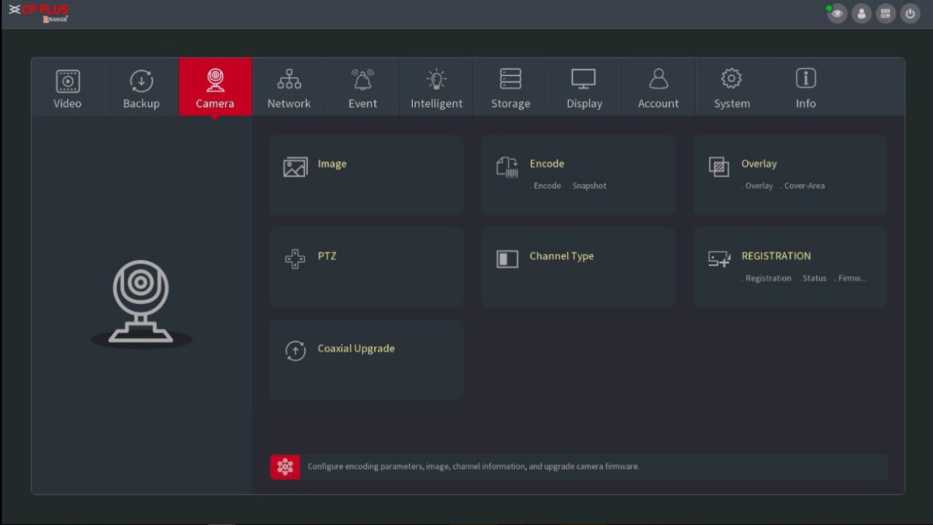
You can configure the image settings such as saturation, contrast, brightness, sharpness for
each connected camera.
Step 1 Select Main Menu ^ Camera ^ IMAGE.
The IMAGE interface is displayed.See Figure 5-59 for analog channel and Figure 5 60 for digital channel.
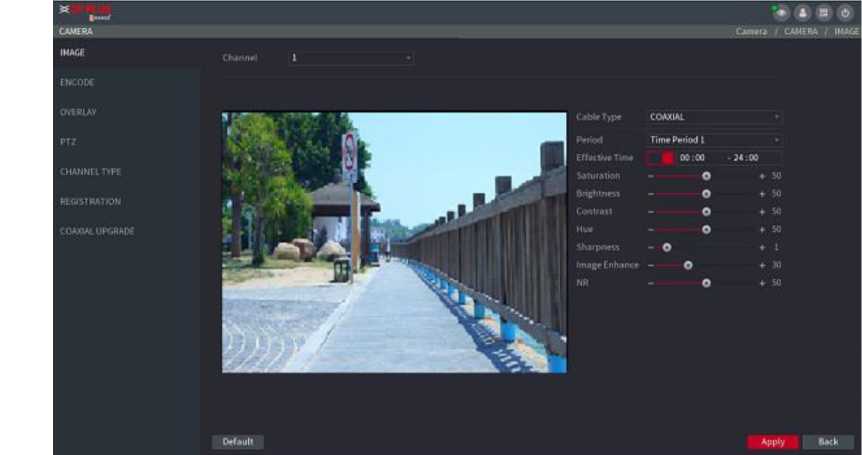
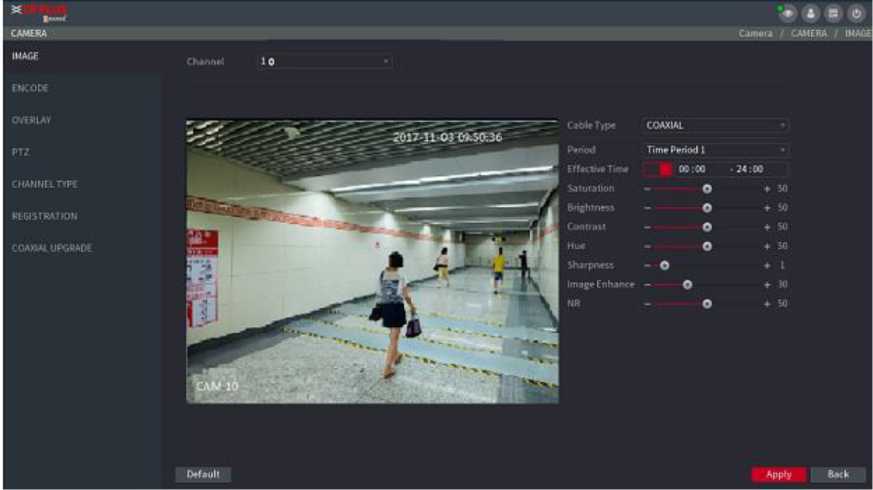
Figure 5-60
Step 2 Configure the settings for the image parameters. See Table 5-22.
On the digital channel interface, click More Setting to display more parameters.
| Parameter | Description |
| Channel | In the Channel list, select the channel that you want to configure. |
| Cable Type | In the Cable Type list, select the cable type that the camera uses. EQ NOTE |
| Not all models support this function. | |
| Period | In the Period list, select a time period for the image settings. The image settings will be only used during the selected period. |
| Effective Time | Enable the effective function.
In the Effective Time box, enter the start time and end time for the period you selected. |
| Saturation | Adjusts the color shades. The bigger the value, the lighter the color will become. This value does not influence the general image lightness.
The value ranges from 0 to 100. The default value is 50. The recommended range is between 40 and 60. |
| Contrast | Adjusts the image contrast. The bigger the value is, the more obvious the contrast between the light area and dark area will become. You can adjust this value when the contrast is not obvious. However, if the value is too big, the dark area is likely to become darker and the light area over exposed. If the value is too small, the image is likely to become dim.
The value ranges from 0 to 100. The default value is 50. The recommended range is between 40 and 60. |
| Parameter | Description |
| Brightness | Adjusts the image brightness. The bigger the value is, the brighter the image will become. You can adjust this value when the image as a whole looks dark or bright. However, the image is likely to become dim if the value is too big.
The value ranges from 0 to 100. The default value is 50. The recommended range is between 40 and 60. |
| Hue | Adjusts the hue of image. The value ranges from 0 to 100. The default value is 50. |
| Sharpness | Adjusts the sharpness of image edge. The bigger the value is, the more obvious the image edge, and the noise is also greater.
The value ranges from 1 to 15. The default value is 1. |
| Image Enhance | Adjusts the image definition. The bigger the value is, the clearer the image will become, but there will be more noises. |
| NR | Reduces the noises from image. The bigger the value is, the better the image will become. |
| Config File | In the Config File list, select Day, Night, Normal, or Switch By Period. The system configures the parameters correspondingly.
the sunrise time and sunset time where you are located. |
| Mirror | Enable the function, the left and right side of the video image will be switched. It is disabled by default. |
| 3D Denoise | This function specially applies to the image which frame rate is configured as 2 at least. It reduces the noises by making use of the information between two frames. The bigger the value is, the better the effect. |
| Flip | In the Flip list, you can select 180° to change the video image display.
By default, the setting is No Flip. |
| Light | In the Light list, select Close or Enable to use the backlight compensation or not. |
| Scene Mode | Configure the white balance to adjust the general hue of the image.
The default setting is Auto.
make the image color display normally.
values. |
| Parameter | Description |
| Day & Night | Configure the color and black&white mode of the image. This setting is not affected by the configuration files. The default setting is Auto. • Color: The camera outputs color image only.
whether there is an IR light, either color image or black&white image is output.
the sunrise time and sunset time. |
Table 5-22
Step 3 Click Apply to complete the settings.
Step 1 Select Main Menu ^ Camera^ ENCODE ^ Encode.
The Encode interface is displayed.See Figure 5-61.
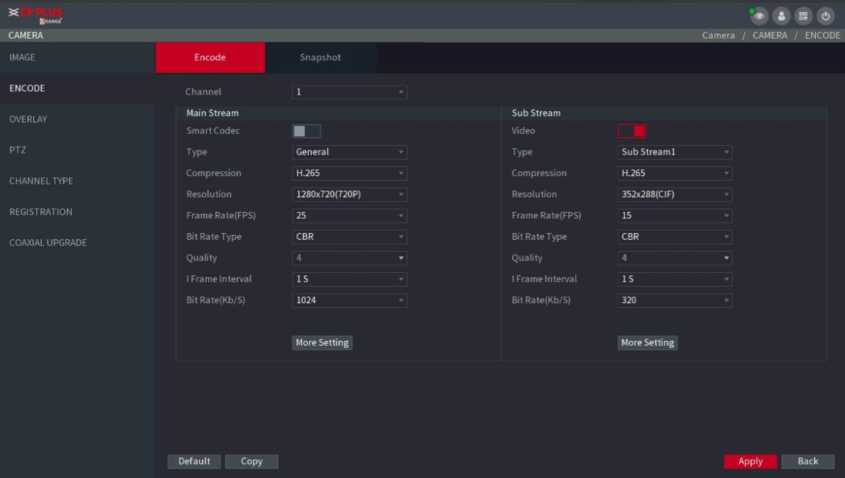
Figure 5-61
Step 2 Configure the settings for the main/sub streams parameters. See Table 5-23.
| Parameter | Description |
| Channel | In the Channel list, select the channel that you want to configure the settings for. |
| Smart Codec | Enable the smart codec function. This function can reduce the video bit stream for non-important recorded video to maximize the storage space. |
| Type |
Detect), or Alarm.
|
Table 5-23
Step 3 Click Apply to complete the settings.
![]()
Click Copy to copy the settings to other channels.
Step 1 Select Main Menu^ Camera^ Encode > Snapshot.
The Snapshot interface is displayed.See Figure 5-62.
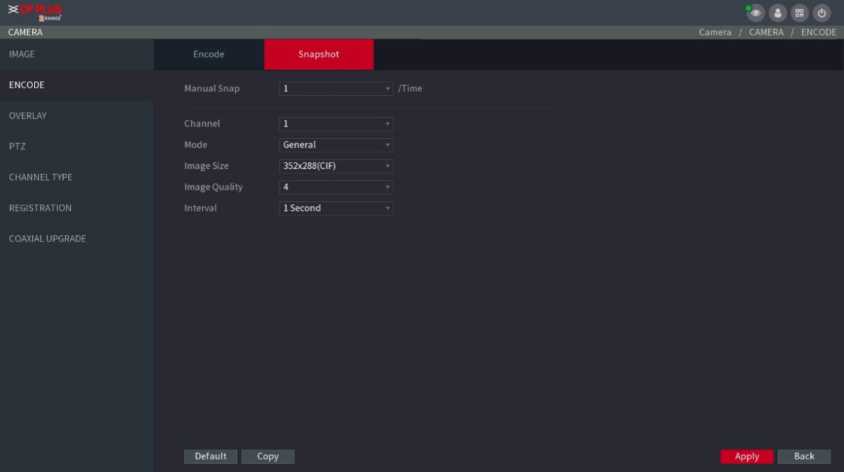
Figure 5-62
Step 2 Configure the settings for the snapshot parameters. See Table 5-24.
Table 5-24
Step 3 Click Apply to complete the settings.
EQ NOTE
Click Copy to copy the settings to other channels.
You can configure to display system time and channel name on each channel window in the live view screen.
Step 1 Select Main Menu ^ Camera ^ OVERLAY ^ Overlay.
The Overlay interface is displayed. See Figure 5-63.
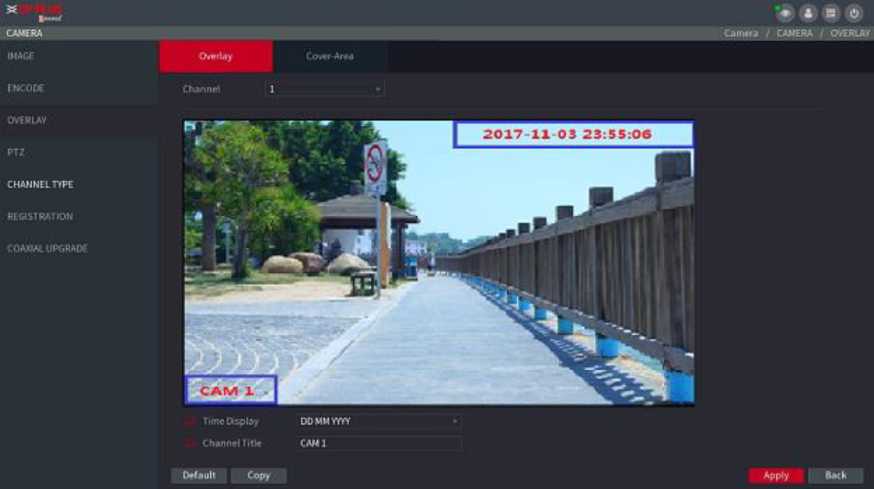
Figure 5-63
Step 2 Configure the settings for the text overlay parameters. See Table 5-25.
Table 5-25
Step 3 Click Apply to complete the settings.
Click Copy to copy the settings to other channels.
Step 1 Select Main Menu ^ Camera ^ OVERLAY ^ Cover-Area.
The Cover-Area interface is displayed. See Figure 5-64.
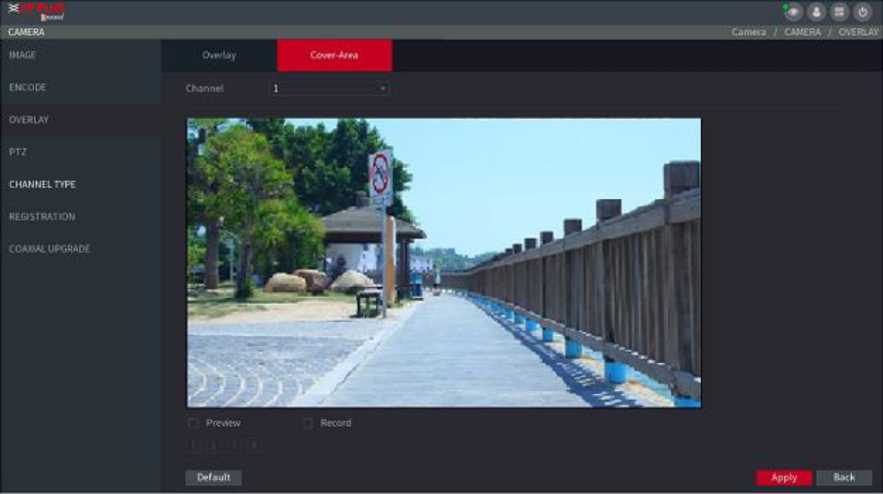
Figure 5-64
Step 2 Configure the settings for the covered area parameters. See Table 5-26.
| Parameter | Description |
| Channel | In the Channel list, select the channel that you want to configure the settings for. |
| Preview
Record |
covered block to the selected channel window in the live view screen.
covered block to the selected channel window during recording. To configure covering block, do the following:
select the both. The “1,2, 3, 4” buttons are activated.
to the area that you want to cover and adjust the size of the block.
|
Table 5-26
Step 3 Click Apply to complete the settings.
You can configure the channel type as Analog or IP channel.
Step 1 Select Main Menu^ Camera ^ CHANNEL TYPE.
The CHANNEL TYPE interface is displayed. See Figure 5-65.
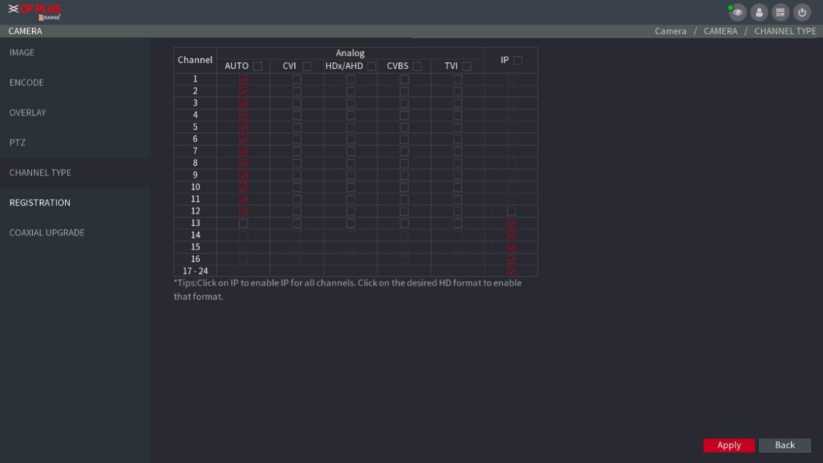
Figure 5-65
Step 2 Configure the channels.
- Analog Channel: Select the transmission medium such as CVI, CVBS, and then follow the onscreen instructions to complete the settings.
- IP Channel: Select a channel for IP camera from the last channel number, for example, in Figure 5-65, select from the 17-24 check box. Then follow the onscreen instructions to complete the settings.
ΠNOTE
- The 17-24 channels are only for IP camera and the range changes dependent on the model you purchased.
- The channel selection for analog camera or IP camera are in sequence, for example, if you want to select channels for IP camera, you need to select the 17-24 check box first, and then you cannot jump to select the channel 15 directly until you have selected the channel 16.
Step 3 Click Apply and follow the onscreen instructions to complete the settings.
5.5.7 Upgrading Coaxial Camera
Step 1 Select Main Menu ^ Camera ^ COAXIAL UPGRADE.
The COAXIAL UPGRADE interface is displayed.See Figure 5-66.
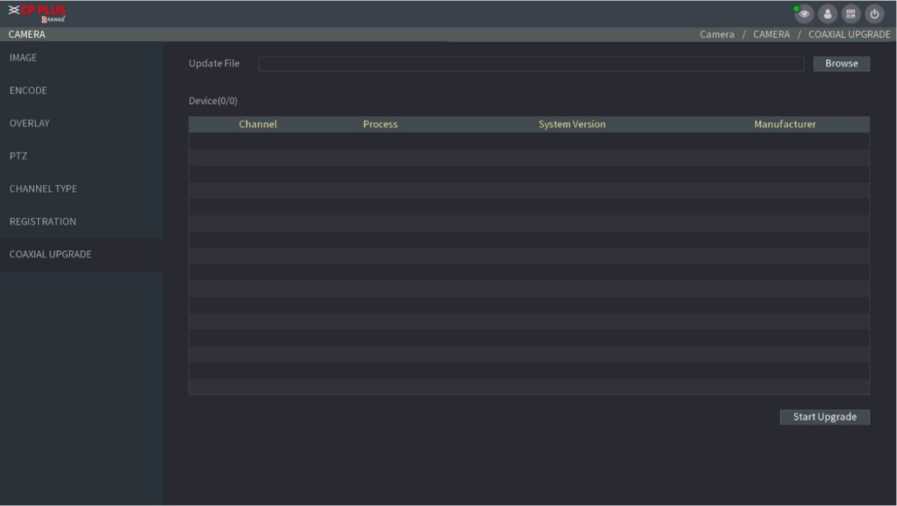
Figure 5-66
The Browse interface is displayed.
Step 3 Select the upgrade file and click OK.
The COAXIAL UPGRADE interface is displayed.
ED NOTE
You need to insert the USB storage device that contains the upgrading files.
Step 4 Select the check box of the channel that you want to upgrade.
Step 5 Click Start Upgrade.
If the upgrading is successful, the system pops up a message indicating the upgrading
is completed. If the upgrading is failed, please check if the Device
5.6 Configuring Remote Devices
EQ NOTE
This function is available after you have configured the channel type as IP channel as described in previous section, see “5.5.6 Configuring Channel Type.”
You can add remote devices by adding the IP address.
Select Main Menu ^ Camera ^ REGISTRATION > Registration, the Registration interface is displayed. See Figure 5-67.
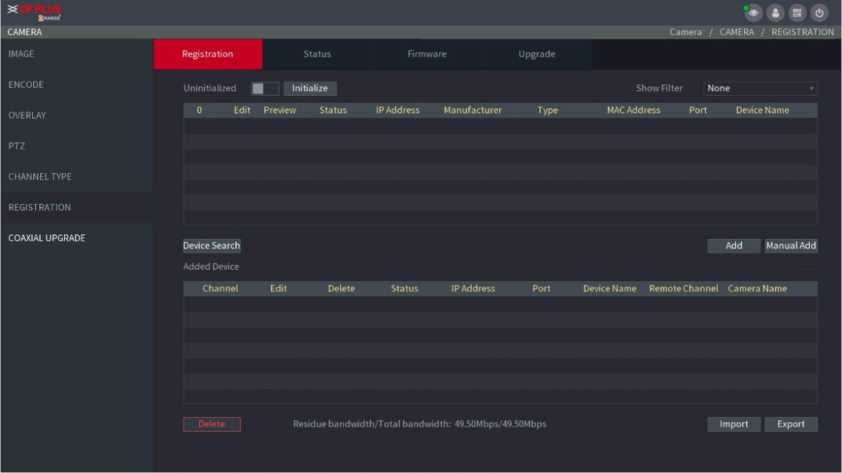
Figure 5-67
| Parameter | Description |
| Uninitialized | Enable the Uninitialized function, the uninitialized devices out of the searched devices are displayed in the searched device list. |
| Initialize | Select the uninitialized device from the uninitialized device list, and the click Initialize to start initializing device. |
| Show Filter | In the Show Filter list, select the remote device type that you want to display in the searched device list.
NVR, DVR (WITHOUT HDD) and HCVR.
(WITHOUT HDD) type. |
| Searched Device List | Displays the searched devices. You can view the device information such as status, IP address. |
| Device Search | Click Device Search, the searched devices display in the searched device list.
To adjust the display sequence, in the title line, you can click the IP address, Manufacturer, Type, MAC Address, Port, or Device Name text. For example, click the IP address text, the sequence icon OZES is displayed. CQ NOTE |
| “*” is displayed next to the added device. | |
| Add | In the Searched Device List area, select the device that you want to add. |
| Manual Add | Add the device by manually configuring settings such as IP address, channel selection. For details, see “5.6.1.4 Adding Remote Devices Manually.“ |
| Added Device List | Displays the added devices. You can edit and delete the device, and view the device information. |
| Parameter | Description |
| Delete | Select the check box of the added device, and then click Delete to delete the added device. |
| Import | Select the searched devices and then click Import to import the devices in batches. |
| Export | Select the added devices and then click Export. The exported devices information is saved into the USB storage device. |
Table 5-27
5.6.1.2 Initializing Remote Devices
You can reset the password and IP address of the remote devices through initializing.
Step 1 Click Device Search.
The searched devices are displayed in the table. See Figure 5-68.
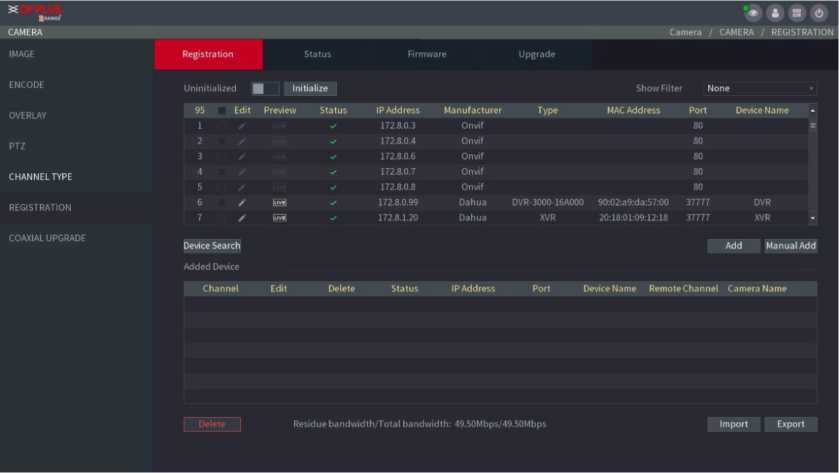
Figure 5-68
Step 2 Enable the Initialized function.
The uninitialized devices are displayed. See Figure 5-69.
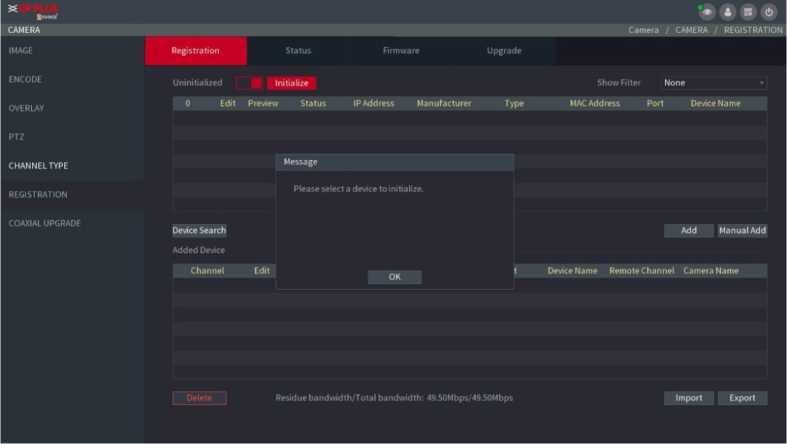
Figure 5-69
Step 3 Select the uninitialized device that you want to initialize.
Step 4 Click Initialize.
The Enter Password interface is displayed. See Figure 5-70
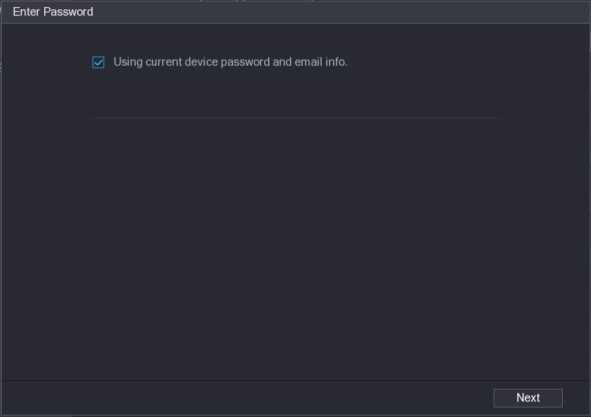
Figure 5-70
Step 5 Configure the password and email information.
Q NOTE
If you select the Using current device password and email info check box, the remote device automatically uses the current password and email information, so you do not need to set the password and email address again and can go to Step 6.
- Clear the Using current device password and email info check box.
The password setting interface is displayed. See Figure 5-71.
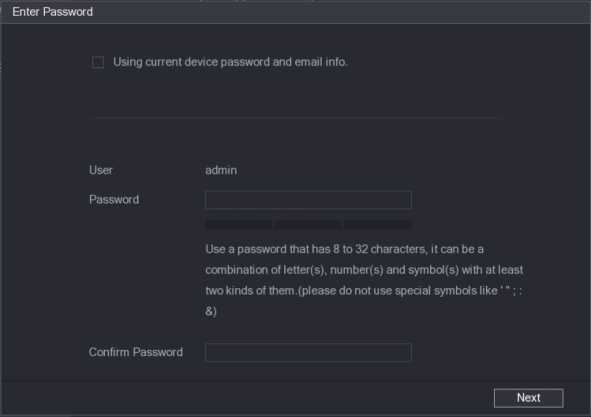
Figure 5-71
2) Configure the settings for the password setting parameters. See Table 5-28.
Table 5-28
3) Click Next.
The Password Protection interface is displayed. See Figure 5-72
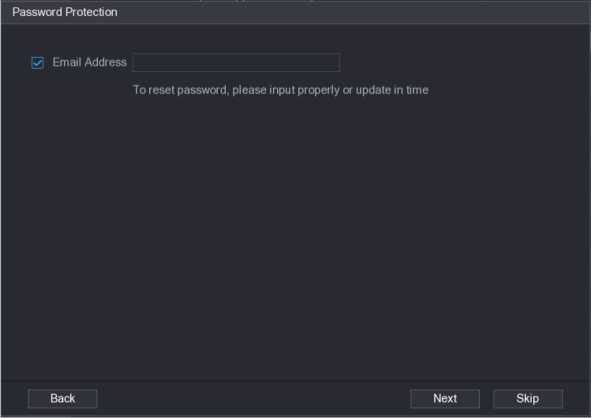
Figure 5-72
- Select the Email Address box and enter the email address that you want to reserve for password reset in the future.
CQ NOTE
If you do not want to set the reserved email address, click Skip.
Step 6 Click Next.
The NETWORK interface is displayed. See Figure 5-73.
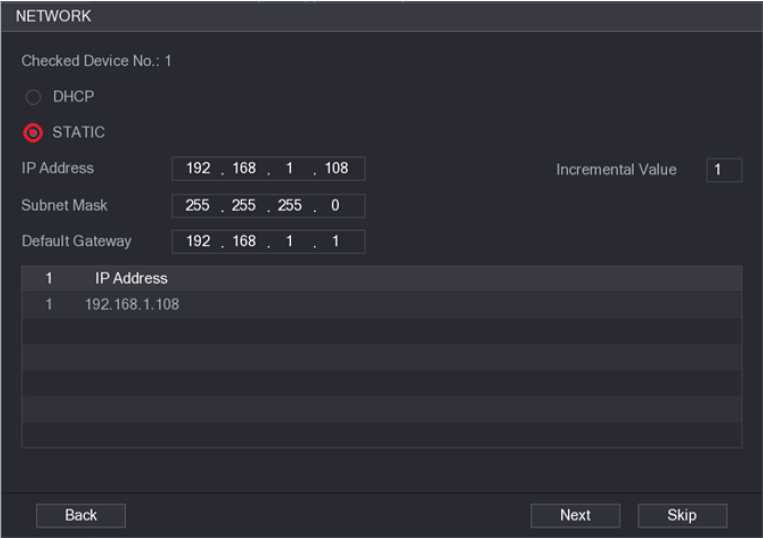
Figure 5-73
Step C Configure the IP address.
- Select the DHCP check box, you do not need to enter the IP address information, because the system will allocate one IP address to the remote device.
- Select the STATIC check box, you need to enter the IP address, subnet mast, default gateway, and incremental value. The system will allocate the IP address to the remote devices by progressively increasing the last part of the IP address when initializing devices in batches.
EQ NOTE
When configuring IP address for multiple remote devices which were not in the same network segment, these remote devices will belong to the same network segment after configuration.
Step 8 Click Next.
The initializing is started. After the process is completed, see Figure 5-74.
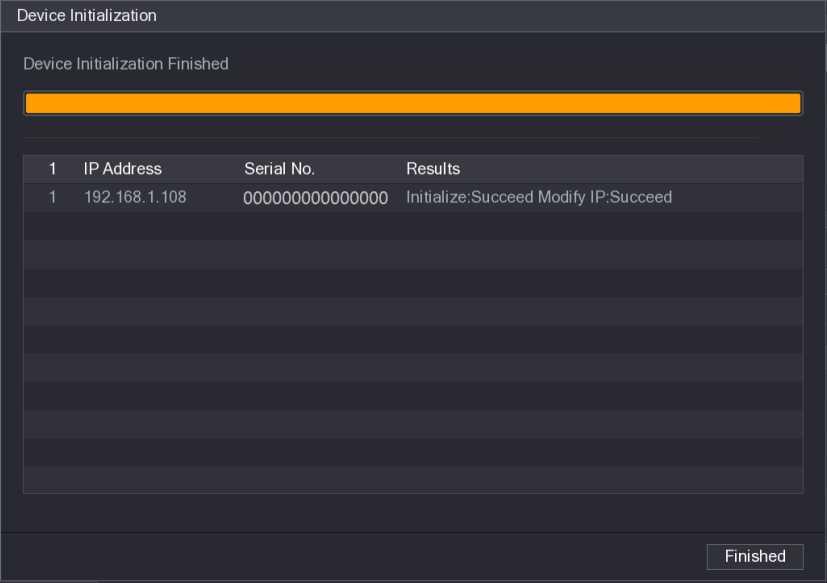
Figure 5-74
Step 9 Click Finished to complete the settings.
5.6.1.3 Adding Remote Devices Automatically
Step 1 On the Registration interface, click Device Search
The searched devices are displayed. See Figure 5-75.
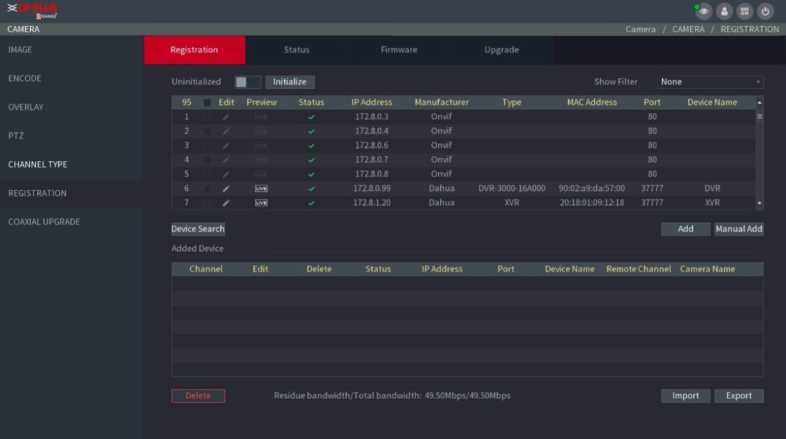
Figure 5-75
Step 2 Select the check box of the device.
Step 3 Click Add.
The device is added into the Added Device area.
Q NOTE
- You can also double-click the device to add it into the Added Device area.
- You can add devices in batches.
5.6.1.4 Adding Remote Devices Manually
Step 1 On the Registration interface, click Manual Add.
The Manual Add interface is displayed. See Figure 5-76.

Figure 5-76
Step 2 Configure the settings for the manual adding device parameters. See Table 5-29.
Table 5-29
Step 3 Click Apply to save the settings.
CD NOTE
• Only one device can be added manually at one time.
•
![]()
indicates successful connection and
![]()
indicates connection failed.
You can modify and delete the added devices.
- To modify the remote devices, do the following:
Step 1 Click □ or double-click a device.
The Edit interface is displayed. See Figure 5-77.
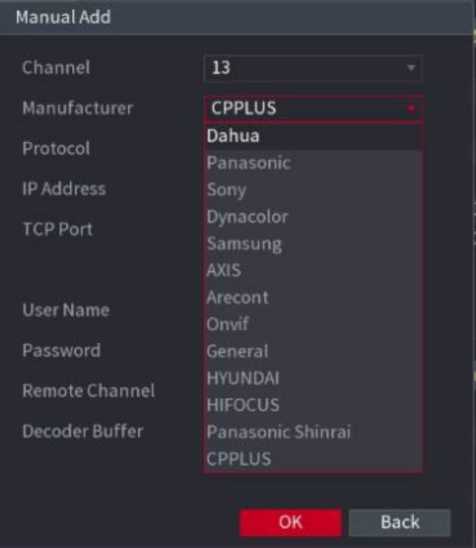
Figure 5-77
Step 2 In the Channel list, select the channel that you want to modify settings for.
Step 3 Click OK to save the settings.
ED NOTE
Click Copy to copy the user name and password to other channels.
- To delete one or more added devices, do the following:
Click
![]()
to delete one device
o Select the check box of the devices that you want to delete, and then click Delete.
You can modify a single IP address or multiple IP addresses of remote devices at the one time.
• To modify a single IP address, do the following:
Step 1 In the Searched Device list area, click □ for the device that you want to modify IP.
The Modify IP interface is displayed. See Figure 5-78.
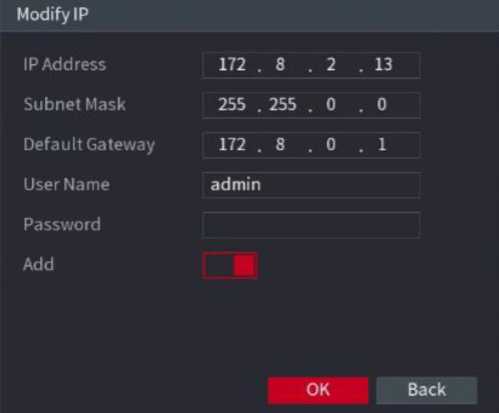
Figure 5-78
Step 2 Configure the settings for IP address, subnet mask, default gateway, user name, and password.
Step 3 Enable the Add function to add the device into the Added Device area.
Step 4 Click OK to save the settings.
• To modify IP address in batches, do the following:
Step 1 In the Searched Device list area, select the devices that you want to modify IP address in batches.
Step 2
Click □.
The Modify IP interface is displayed. See Figure 5-79.
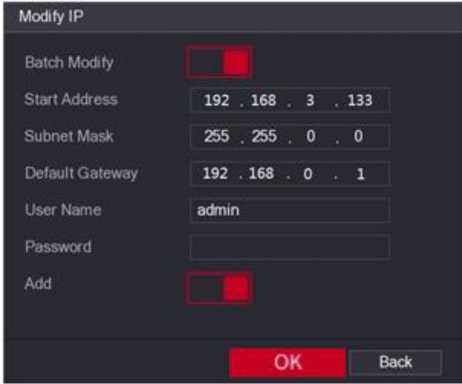
Figure 5-79
Step 3 Enable the Batch Modify function.
Step 4 Configure the settings for start IP address (the IP address is allocated in sequence), subnet mask, default gateway, user name, and password.
Step 5 Enable the Add function to add the devices into the Added Device area.
Step 6 Click Apply to save the settings.
You can export the added IP address to the USB storage device.
CD NOTE
The exported information is saved in .csv file, which includes IP address, port number, channel number, manufacturer, user name, and password.
Step 1 Insert the USB storage device to the USB port of the Device.
Step 2 Click Export.
The Browse interface is displayed. See Figure 5-80.
Browse
Device Name sdcl(USBUSB) • 3.71 GB/3.73 GB(Free/Total) Refresh Format
Address /
| Name | Size | Type | Delete | Play |
| ■ {fd2b025a-ac98-e383-13ea-lcf86fc539fb} | Folder | a | ||
| ■ ScreenShot | Folder | a | ||
| là printf_20180317141255.txt.lnk | 1.8 KB | File | a | |
| lg kmsg_printf_20180317141255.txt.lnk | 1.8 KB | Ale | dk | |
| 1 SmartPlayer.exe.lnk | L7 KB | File | □ | |
| a Uni+ DVR_chl_main_20180317134749_… | 26 KB | File | n | |
| g Uni+ DVR_chl_main_20180317135000_… | 26 KB | File | n | 5′ |
| Bl ty.lnk | 1.7 KB | File | n | |
| Bl printf_20180317143922.txt.lnk | 1.8 KB | Ale | n | |
| Bl kmsg_printf_20180317143922.txt.lnk | 1.8 KB | Ale | 3 |
New Folder OK Back
Figure 5-80
Step 3 Configure the save path.
Step 4 Click OK to save the settings.
A pop-up message indicating “Successfully exported” is displayed.
Step 5 Click OK.
You can add remote devices by importing IP address information.
Step 1 Insert the USB storage device to the USB port of the Device.
Step 2 Click Import.
The Browse interface is displayed. See Figure 5-81.
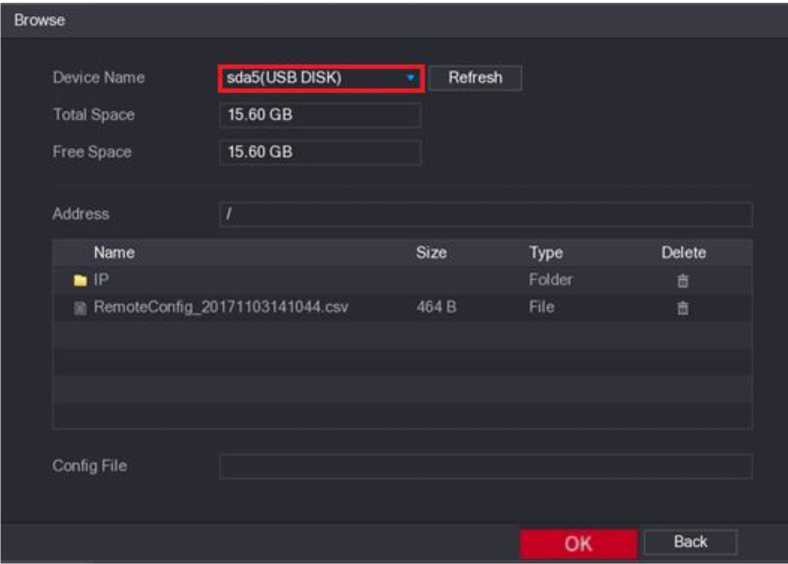
Figure 5-81
Step 3 Select the file that you want to import.
Step 4 Click OK to start importing.
After importing is completed, a pop-up message indicating “The import succeeded” is displayed.
EQ NOTE
If the IP address that you want to import already exists in the Device, the system will pop up a message to ask you whether to overwrite the existing content.
- Click OK to replace the existing one.
- Click Cancel to add it as a separate device in the Added Device area.
CAUTION
- You can edit the exported .csv file and be cautious not to change the file format; otherwise the file cannot be imported as it will be judged as invalid.
- The language of .csv file must match the Device language.
- The import and export through customized protocol is not supported.
You can view the status of remote devices and upgrade.
You can view the device information such as connection status, IP address, motion detection, video loss detection, camera name, and manufacturer.
Select Main Menu ^ Camera ^ REGISTRATION > Status, the Status interface is displayed.
See Figure 5-82.
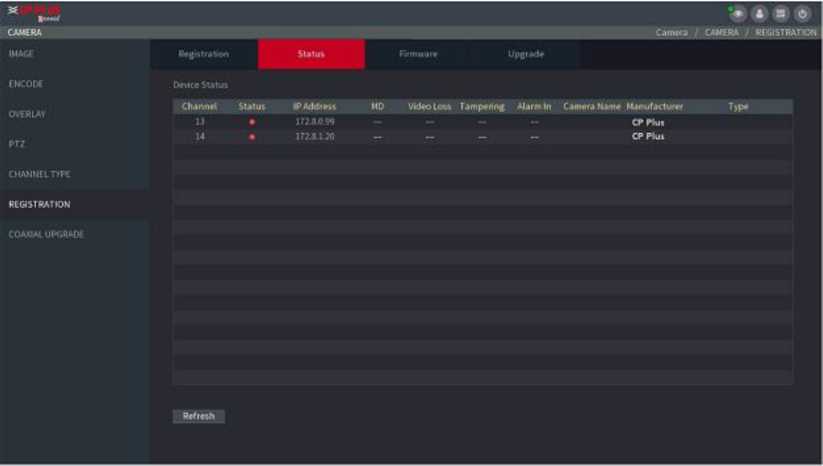
Figure 5-82
You can view the device firmware information such as channel number, IP address, manufacturer, system version, video input, audio input, and alarm in.
Select Main Menu ^ Camera ^ REGISTRATION > Firmware, the Firmware interface is displayed. See Figure 5-83.
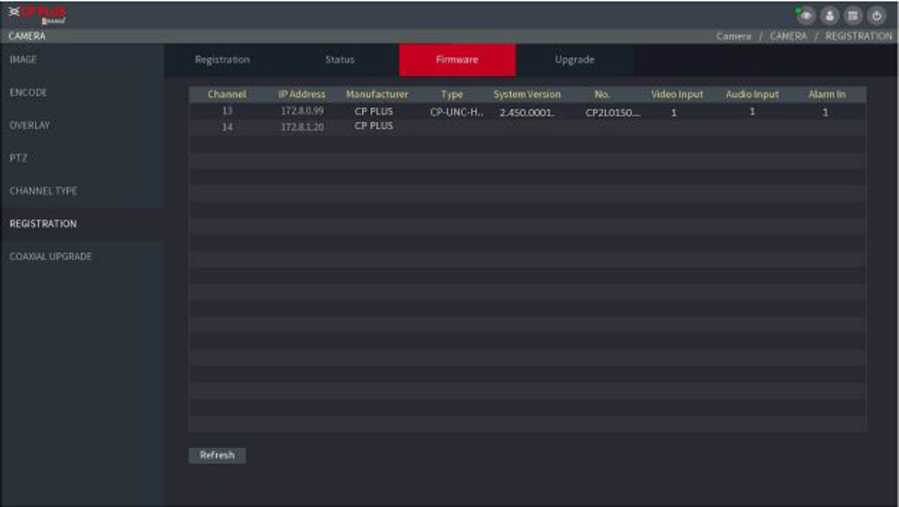
Figure 5-83
Step 1 Select Main Menu ■> Camera ^ REGISTRATION > Upgrade.
The Upgrade interface is displayed.See Figure 5-84.
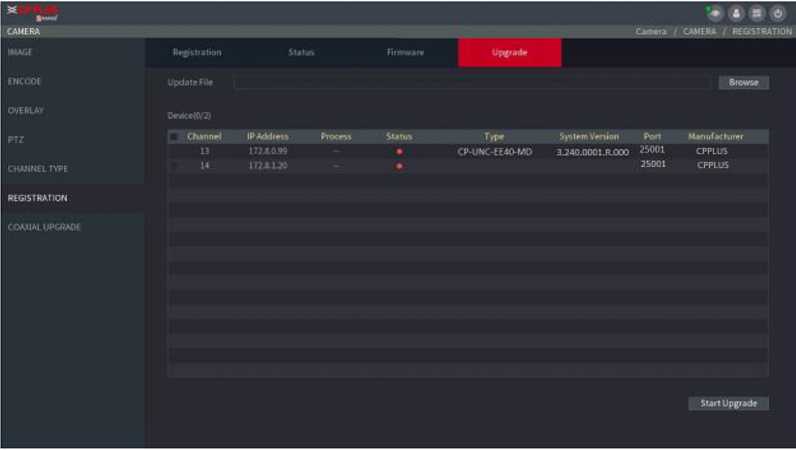
Figure 5-84
• File Upgrade
- Insert a USB storage device containing the upgrade files into the USB port of the Device.
- Select the devices that you want to upgrade.
- Click File upgrade.
The File Upgrade interface is displayed.
- Select the upgrading files and click Apply.
• Online Upgrade
- Click Detect or select the check box the device that you want to upgrade and click Manual Check.
The system starts detecting if there is a new version on the online server.
- Select the check box of all the devices that have new version.
- Click Online Upgrade.
EQ NOTE
- The system will pop up a message to indicate if the upgrading is successful.
- You can use the Type list to filter the devices so that you can find the devices
quickly.
You can record video manually or automatically and configure the recording settings to main stream and sub stream respectively.

CAUTION
- Manual recording operation requires the user have the permission to access STORAGE settings.
- Check to ensure the HDD installed in the Device has been formatted properly.
To enter the record control interface, do the following:
Step 1 Right-click on the live view screen, the shortcut menu is displayed. On the shortcut menu, select Manual ■> Record Control. The RECORD interface is displayed, see Figure 5-85.
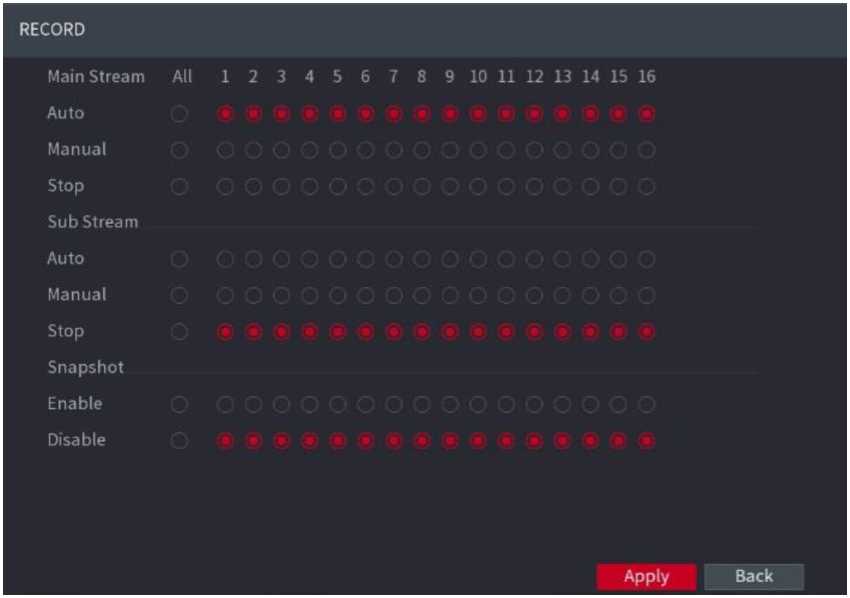
Figure 5-85
Step 2 Configure the settings for the record control parameters. See Table 5-30.
Table 5-30
Step 3 Click Apply.
You need to configure the storage schedule for the recorded video so that the recorded video can be saved. For details, see “5.1.4.9 Configuring Recorded Video Storage Schedule.”
The snapshot is divided into scheduled snapshot, event triggered snapshot, and face detection triggered snapshot. When the both are enabled, the event triggered snapshot has the priority.
- If there is no alarm event, the system performs scheduled snapshot.
- If there is any alarm event, the system performs event triggered snapshot.
5.8.1.1 Configuring Scheduled Snapshot
Step 1 Right-click on the live view screen, the shortcut menu is displayed.
Step 2 On the shortcut menu, select Manual ^ Record Control.
The RECORD interface is displayed.
Step 3 In the Snapshot area, enable the snapshot for the channels if needed. See Figure 586.
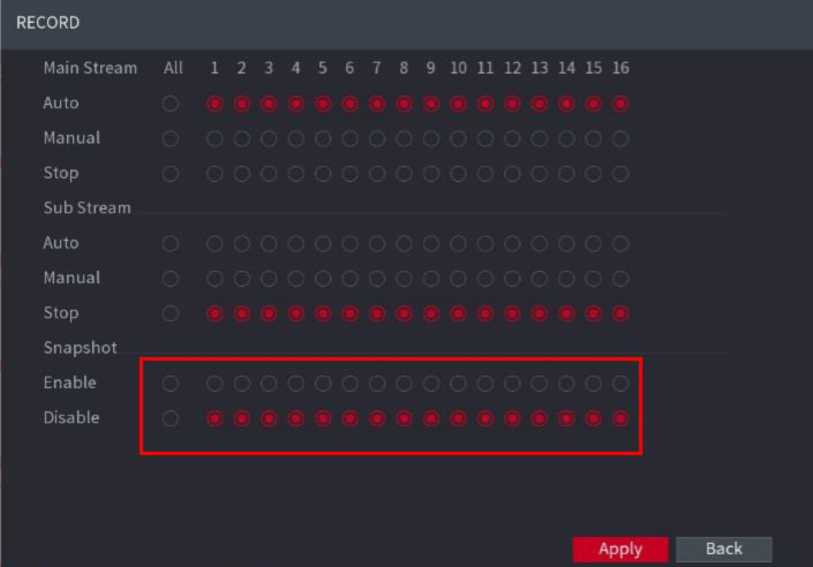
Figure 5-86
Step 4 Select Main Menu ^ Camera ^ Encode ^ Snapshot.
The Snapshot interface is displayed.
Step 5 In the Mode list, select General, and then configure other parameters. See Figure 587.
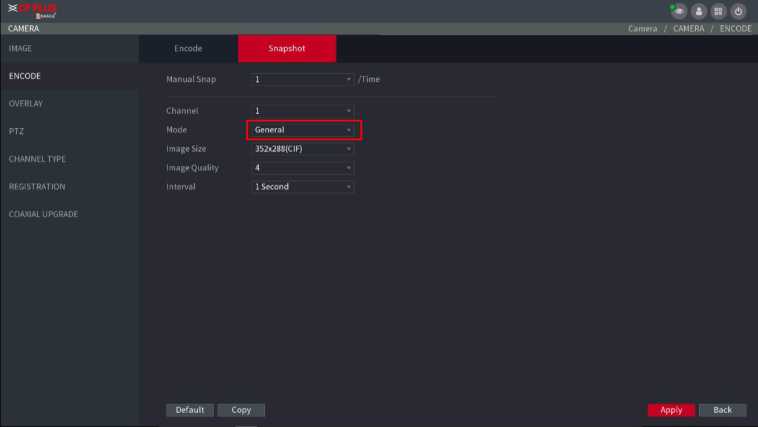
Figure 5-87
Step 6 Click Apply to save the settings.
- If you have configured the snapshot schedule, the configuration has been completed.
- If you have not configured the snapshot schedule, see “5.1.4.10 Configuring Snapshot Storage Schedule.”
Step 1 Select Main Menu ■> Camera ^ Encode ^ Snapshot.
The Snapshot interface is displayed.
Step 2 In the Mode list, select Event, and then configure other parameters. See Figure 5-88.
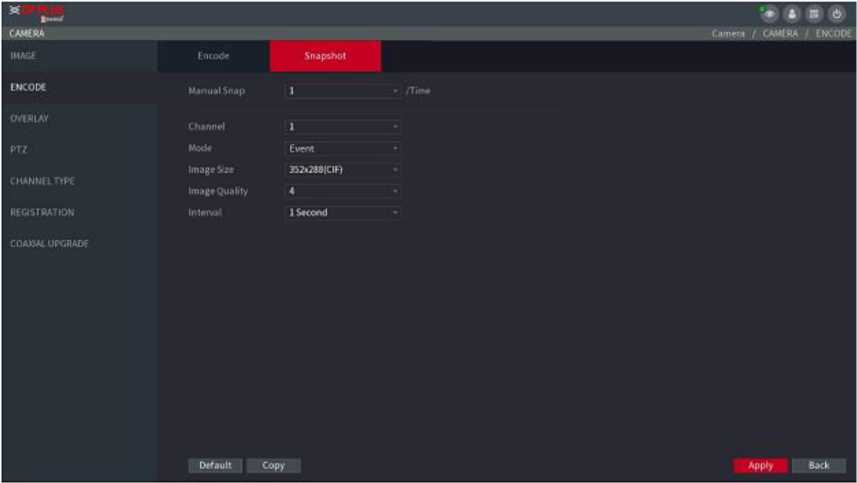
Figure 5-88
Step 3 Select Main Menu ^ Event ■> VIDEO DETECT, and select the event type to configure, for example, select the Motion Detect tab. See Figure 5-89.
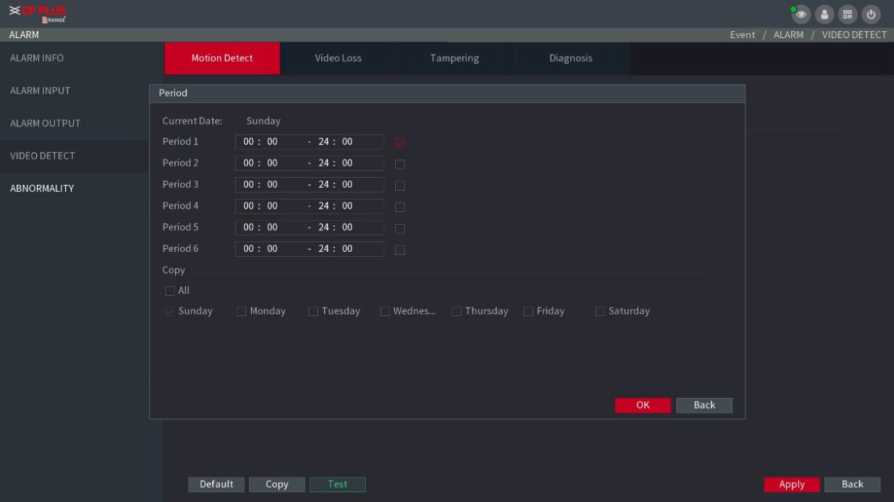
Figure 5-89
Step 4 Select the Snapshot check box and select the corresponding channel.
Step 5 Click Apply.
Step 1 Select Main Menu ■> Camera ^ Encode > Snapshot.
The Snapshot interface is displayed.
Step 2 In the Mode list, select Human Face, and then configure other parameters. See Figure 5-90.
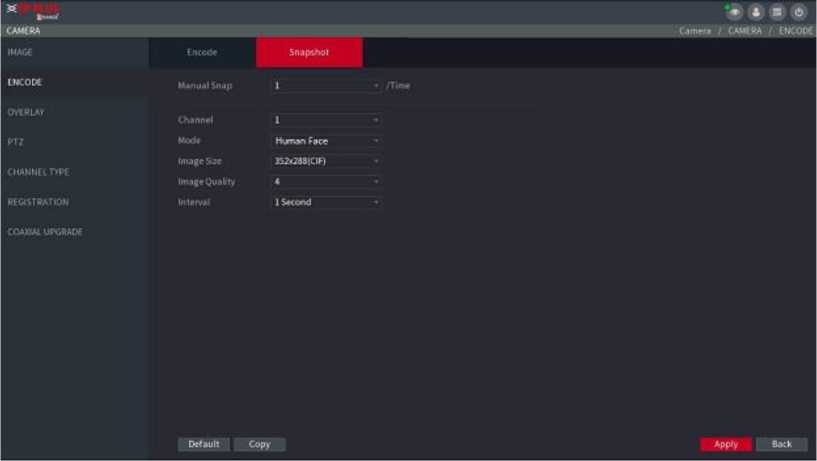
Figure 5-90
Step 3 Select Main Menu ->Intelligent^ Face Detect ^ Parameters > Human Face.
The Human Face interface is displayed. See Figure 5-91.
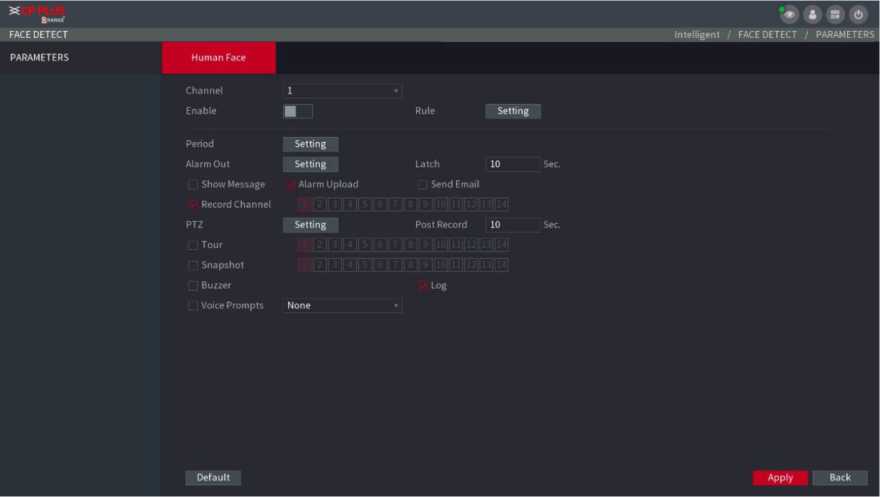
Figure 5-91
Step 4 Select the Snapshot check box and select the corresponding channel.
Step 5 Click Apply.
You need to configure the storage schedule for the snapshot so that the snapshot can be saved.
For details, see “5.1.4.10 Configuring Snapshot Storage Schedule.”
Step 1 Select Main Menu ■> Storage ^ FTP.
The FTP interface is displayed. See Figure 5-92.
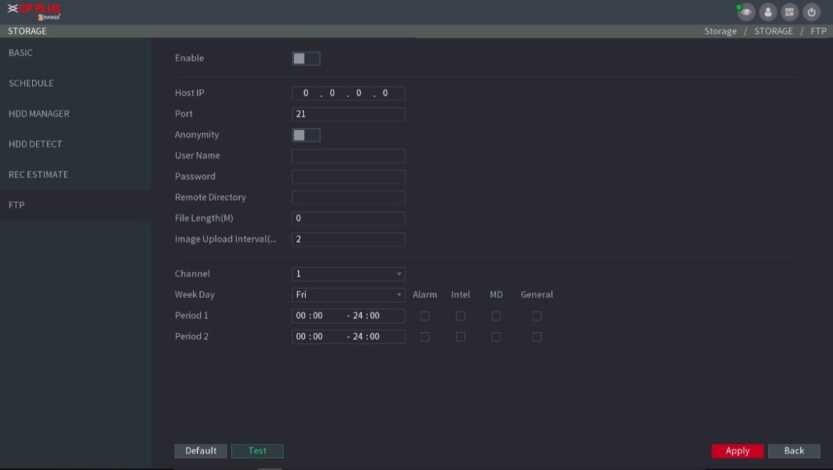
Step 2 Enable the FTP function and configure the parameters. For details, see “5.17.8 Configuring FTP Storage Settings.”
The snapshots will be uploaded to FTP for backup.
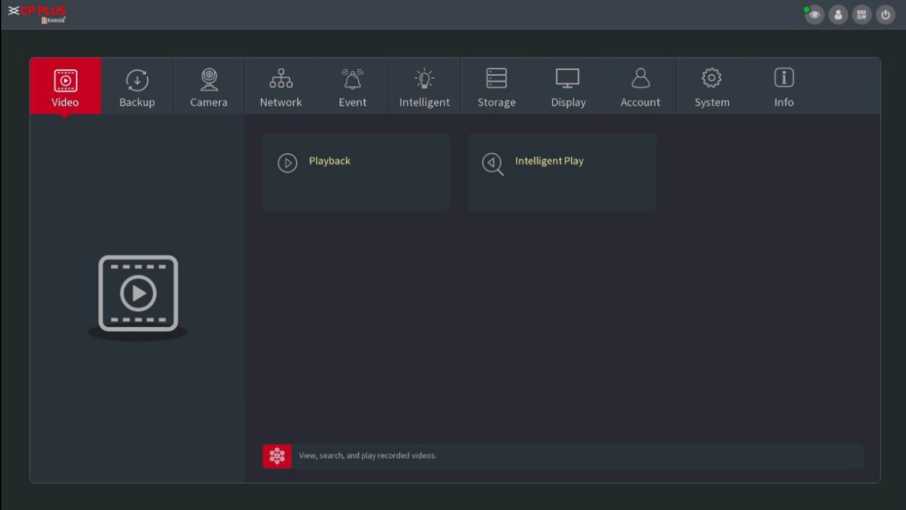

CAUTION
- Manual recording operation requires the user have the permission to access STORAGE settings.
- Check to ensure the HDD installed in the Device has been formatted properly.
To enter the record control interface, do the following:
Step 1 Right-click on the live view screen, the shortcut menu is displayed. On the shortcut menu, select Manual ■> Record Control. The RECORD interface is displayed, see Figure 5-93.
RECORD
Mainstream All 1 2 3 4 5 6 7 8 9 10 11 12 13 14 15 16
Auto
Manual
Stop
Sub Stream
Auto
Manual
Stop
Snapshot
Enable
Disable
Apply Back
Figure 5-93
Step 2 Configure the settings for the record control parameters. See 0.
Table 5-31
You can use the instant playback function to play back the previous five minutes to sixty minutes of the recorded video in any channel. For details about instant playback function, see “5.2.2.1 Instant Playback.”
You can search for and play back the recorded video saved on the Device.
Select Main Menu ^ Video, the video search interface is displayed. See Figure 5-94.
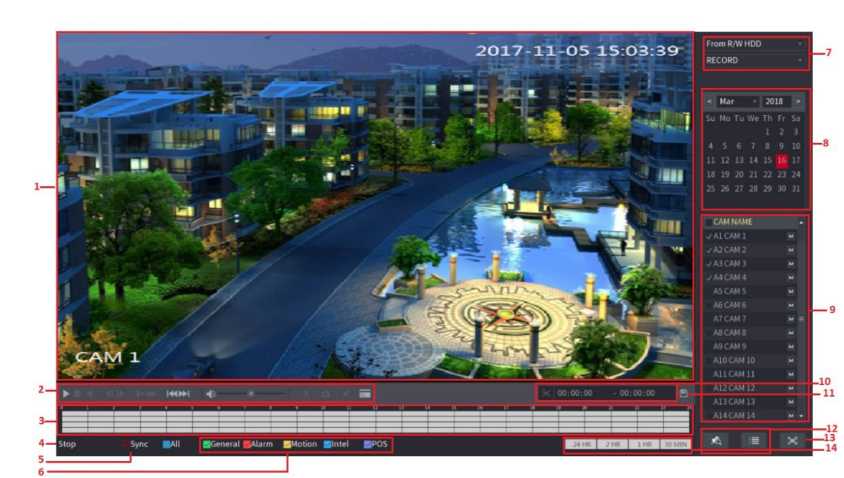
Figure 5-94
| No. | Function | Description |
| 1 | Display Window | Display the searched recorded video or picture. It supports playing in single-channel, 4-channel, 9-channel, and 16-channel simultaneously.
ED NOTE |
| When playing back in a single channel mode, hold down the left | ||
| mouse button to select the area that you want to enlarge. The | ||
| area is enlarged after the left mouse button is released. To exit the | ||
| enlarged status, right-click on the image. | ||
| 2 | Playback
Controls Bar |
Playback control buttons. For details about the control buttons, see “5.9.3.2 Introducing Playback Controls.“ |
| 3 | Time Bar | Display the type and time period of the current recorded video.
displayed; in the other view layouts, only one-time bar is displayed.
the wheel button on the time bar, the time bar is zooming in from 0. In the situation when playback is ongoing, rotate the wheel button on the time bar, the time bar is zooming from the time point where the playback is located.
external alarm; Yellow indicates motion detection; Blue indicates intelligent events; Purple indicates POS events.
the time bar, the system automatically jumps to the next time point where there is a recorded video located. |
| 4 | Play Status | Includes two playback statuses: Play and Stop. |
| 5 | Sync | Select the Sync check box to simultaneously play recorded videos of different channels in the same period in multi-channel view. |
| No. | Function | Description | ||||||
| 6 | Record type | Select the check box to define the recording type to search for. | ||||||
| 7 | Search type | Select the content to play back: Record, PIC, Splice Playback.
For details about the selecting search type, see “5.9.3.3 Selecting |
||||||
| 8 | Calendar | Click the date that you want to search, the time bar displays the corresponding record.
The dates with record or snapshot have a small solid circle under the date. |
||||||
| 9 | View Layout and Channel Selection | In the CAM NAME list, select the channel(s) that you want to play back.
• The window split is decided by how you select the channel(s). For example, if you select one channel, the playback is displayed in the single-channel view; if you select two to four channels, the playback is displayed in the four-channel view. The maximum is eight channels. |
||||||
| • Clink | M | tn Q\A/itnh thn Qtrnam«; | M | indicates main . | ||||
| stream, and | S | indicates sub stream | ||||||
| 10 | Video Splice | Splice a section of recorded video and save it. For details about splicing a recorded video, see “5.9.3.4 Clipping Recorded Video.“ | ||||||
| 11 | Backup | Back up the recorded video files. For details, see “5.9.3.5 Backing up Recorded Video.“ | ||||||
| 12 | List Display | This area includes Mark List and File List.
list is displayed. Double-click the file to start playing.
list is displayed. You can lock the files. For details, see “5.9.8 Using the File List.“ |
||||||
| 13 | Full Screen | Click ^3 to display in full screen. In the full screen mode, point to the bottom of the screen, the time bar is displayed. Right-click on the screen to exit full screen mode. | ||||||
| 14 | Time Bar Unit | You can select 24hr, 2hr, 1hr, or 30min as the unit of time bar. The time bar display changes with the setting. | ||||||
Table 5-32
You can perform the operations such as control the speed of playback, add mark, and take
snapshots through the playback controls bar. See Figure 5-95 and Table 5-33.

CD NOTE
The play backward function and playback speed are dependent on the product version. The actual product shall govern. You can also contact the technical support to consult the hardware version information.
| Icon | Function |
| □. m | Play/Pause.
During playing back, you can switch between play and pause. |
| □ | Stop.
During playing back, you can click the Stop button to stop playback. |
| □.m | Play Backward.
• During playing back, click the Play Backward button to backward play the recorded video, the button switches to EH; click EH to stop playing backward. ♦ During playing back, click to start playing forward. |
| □. □ | Previous Frame/Next Frame.
* When the playback is paused, click UJ or click U3 to play single-frame recorded video. ♦ When playing back single-frame recorded video, click 13 to start playing forward. |
| □ | Slow Playback.
playback as SlowX1/2, SlowX1/4, SlowX1/8, or SlowX1/16.
playback. |
| □ | Fast Playback.
♦ During playing back, click ^3 to set the speed of fast playback as FastX2, FastX4, FastX8, or FastX16. * During slow playback, click ^3 to speed up slow playback. |
| El. d | Previous Day/Next Day.
Click ^3 or click C2 to play the previous day or next day of the current recorded video. |
| L o | | Adjust volume of playback. |
| Smart Search. For details about the using the smart search, see “5.9.4 Smart Search.“ |
| Icon | Function | |||
| El | In the full screen mode, click to take a snapshot and save into
the USB storage device or mobile HDD. |
|||
| □ | Add Mark for the recorded view. For details about adding mark, see “5.9.5 Marking and Playing Back Video.“ | |||
| Hide POS Hide. | ||||
| During single-channel playback, click information on the screen. | ^9 | to display or hide POS | ||
Table 5-33
You can search the recorded videos, splice, or snapshots from HDD or external storage device.
- From R/W HDD: Recorded videos or snapshots playback from HDD of the Device. See Figure 5-96.

Figure 5-96
- From I/O Device: Recorded videos playback from external storage device. See Figure 597.
Click Browse, select the save path of recorded video file that you want to play. Doubleclick the video file or click 13 to start playing.
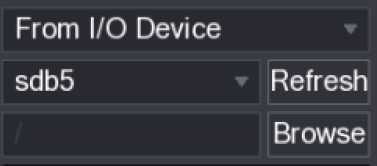
Figure 5-97
5.9.3.4 Clipping Recorded Video
During playback, clip sections of recorded video and save to the USB storage device. For the video clip interface, see Figure 5-98.
00:00:00 – 00:00:00
Figure 5-98
Step 1 Select a recorded video that you want to play.
• Click to start playing from the beginning.
• Double-click anywhere in the time bar colored area to start playback.
Step 2
Click on the time bar to select the start time, and then click
![]()
to start clipping.
Step 3 Click on the time bar to select the start time, and then click
![]()
to stop clipping.
Step 4 Click .
The BACKUP dialog box is displayed. You can back up the files.
NOTE
- You can clip the video of a single-channel or multiple channels.
- Maximum 1024 files can be backed up at one time.
- The files that are selected in the File List cannot be clipped.
5.9.3.5 Backing up Recorded Video
You can back up the recorded video file or splice video file into the USB storage device.
Step 1 Select the recorded video file that you want to back up. You can select the following two types of files:
- Recorded video file: Click ^3, the File List area is displayed. Select the file(s) that you want to back up.
- Splice video file. For details about splicing video file, see “5.9.3.4 Clipping Recorded Video.“
Step 2 Click .
The BACKUP dialog box is displayed. See Figure 5-99.
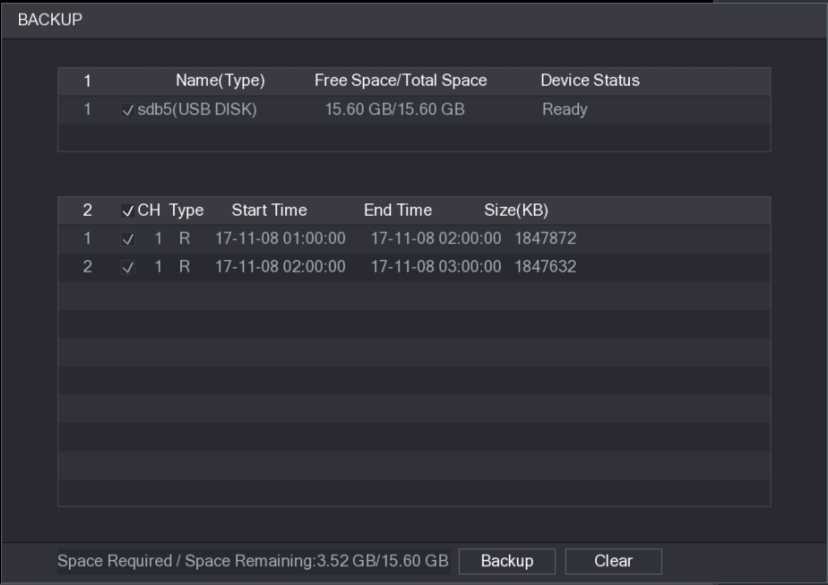
Figure 5-99
ED NOTE
If you do not want to back the file, clear the check box.
During playback, you can analyze a certain area to find if there was any motion detection event occurred. The system will display the images with motion events of the recorded video.
ED NOTE
Not all models support this function.
To use the Smart Search function, you need to enable the motion detection for the channel by selecting Main Menu ^ Alarm ^ Video Detect ^ Motion Detect.
To use the Smart Search function, do the following:
Step 1 Select Main Menu ■> Video, the video search interface is displayed.
Step 2 In the CAME NAME list, select the channel(s) that you want to play.
Step 3 Click 13 or double-click anywhere in the time bar colored area to start playback.
Step 4 Click
![]()
The grid is displayed on the screen.
EQ NOTE
- Only single-channel supports smart search.
- If multi-channels are selected, double-click on the channel window to display this channel only on the screen, and then you can start using smart search function.
Step 5 Drag the pointer to select the searching area. ED NOTE
The grid area supports 22×18(PAL) and 22×15(NTSC).
Step 6
Click
![]()
The screen starts playing back the motional splices of recorded video for the selected searching area.
Step 7
Click
![]()
to exit the playback.
5.9.5 Marking and Playing Back Video
You can mark the recording for somewhere important. Then you can easily find the marked recording by searching time and mark name.
Step 1 Select Main Menu ■> Video, the video search interface is displayed.
Step 2 In the playback mode, click
.
The Add Mark dialog box is displayed. See Figure 5-100.

Figure 5-100
Step 3 In the Name box, enter a name.
Step 4 Click OK.
This marked video file displays in the Mark List.
CD NOTE
This function is supported on single-channel playback.
Step 1 In the CAME NAME list, select one channel.
Step 2 Click
![]()
The Mark List interface is displayed. See Figure 5-101.
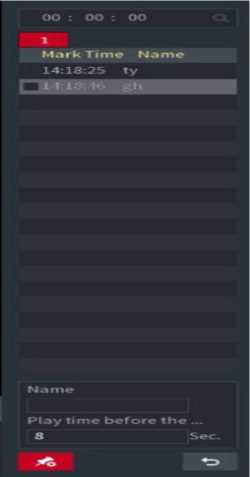
Figure 5-101
Step 3 Double-click the file that you want to play back.
To search the marked video by time, in the SEARCH box on the top of the interface,
enter the time, and then click
![]()
Playing Back Time before the Mark
You can configure to play N seconds of the marked video before the marked time.
Step 1 In the Name box, enter the name of a marked video.
Step 2 In the Playback time before the mark box, enter N seconds.
Step 3 Click
![]()
The playback starts from N seconds before the marked time.
NOTE
If there is N seconds exist before the marked time, the playback starts from N seconds before the marked time. If there is not, it plays back as much as there is.
In the Mark List interface, click ^3, the Manager interface is displayed. See Figure 5-102.
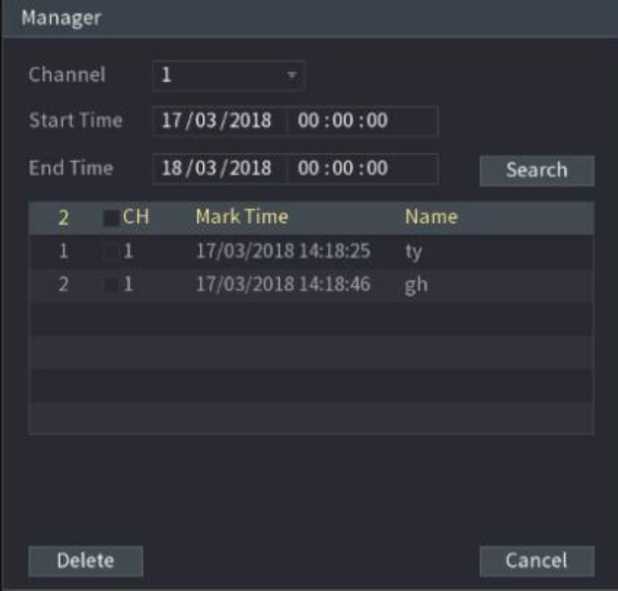
Figure 5-102
- Be default, it manages all the marked videos of the selected channel.
- To search the marked video, select channel number from the Channel list, enter time in Start Time box and End Time box, and then click Search.
- All the marked videos display in time order.
- To modify the name of marked video, double-click a marked video, the Edit Mark dialog box is displayed.
- To delete the marked video, select the marked video, and then click Delete.
NOTE
After opening the Manger interface, the playback will pause until exiting this interface. If the marked video that was in playing back is deleted, the playback will start from the first marked video in the Mark List.
You can search and play back the snapshots.
Step 1 Select Main Menu ■> Video, the video search interface is displayed.
Step 2 In the Search Type list, select PIC.
Step 3 In the Channel list, select a channel number.
Step 4 In the Calendar area, select a date.
Step 5 Click 13.
The system starts playing snapshots according to the configured intervals.
You can clip the recorded video files into splices and then play back at the same time to save your time.
NOTE
Not all models support this function.
Step 1 Select Main Menu ■> Video, the video search interface is displayed.
Step 2 In the Search Type list, select Splice Playback; In the Split Mode list, select 4, 9, or
16. See Figure 5-103.
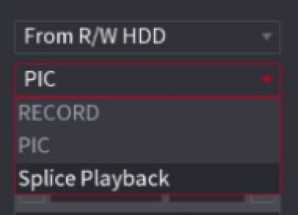
Figure 5-103
Step 3 In the Calendar area, select a date.
Step 4 In the CAM NAME list, select a channel.
Q NOTE
Only single-channel supports this function.
Step 5 Start playing back splices. See Figure 5-104.
• Click □, the playback starts from the beginning.
• Double-click anywhere on the time bar, the playback starts from where you click.

Figure 5-104
Every recorded video file must be at least five minutes. If a recorded video file is less than 20 minutes but still choose to split into four windows, the system will automatically adjust the windows quantity to ensure every splice is more than five minutes, and in this case it is possible that there are no images are displaying in some windows.
You can view all the recorded videos within a certain period from any channel in the File List.
Step 1 Select Main Menu ■> Video, the video search interface is displayed.
Step 2 Select a channel(s).
Step 3
Click
![]()
The File List interface is displayed. See Figure 5-105.

Figure 5-105
- Click , the playback starts from the first file by default.
- Click any file, the system plays back this file.
Q2 NOTE
- In the time box on the top of the file list interface, you can enter the specific time to search the file that you want to view.
- In the File List area, there are 128 files can be displayed.
- File type: R indicates general recorded video; A indicates recorded video with external alarms; M indicates recorded video with motion detection events; I indicates recorded video with intelligent vents.
- Click a to return to the interface with calendar and CAM NAME list.
Locking and Unlocking the Recorded Video
- To lock the recorded video, in the File List interface, select the check box of the recorded
video, and then click LU. The locked video will not be covered.
•
To view the locked information, click
, the FILE LOCKED interface is displayed.
NOTE
The recorded video that is under writing or overwriting cannot be locked.
- To unlock the recorded video, in the FILE LOCKED interface, select the video, and then click Unlock. See Figure 5-106.
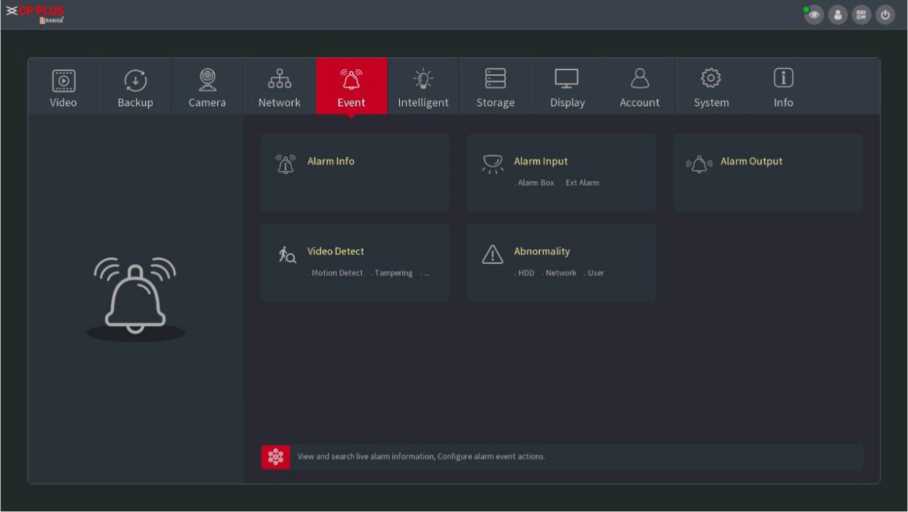
Video detection adopts computer vision and image processing technology. The technology analyzes the video images to detect the obvious changes such as moving objects and blurriness. The system activates alarms when such changes are detected.
When the moving object appears, and moves fast enough to reach the preset sensitivity value, the system activates the alarm.
To configure the motion, detect settings, do the following:
Step 1 Select Main Menu^ Events VIDIEO DETECT > Motion Detect.
The Motion Detect interface is displayed.See Figure 5-107.
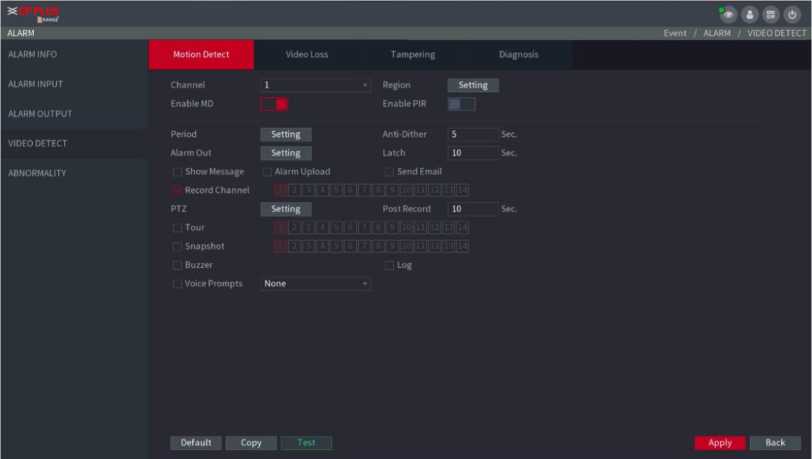
Figure 5-107
Step 2 Configure the settings for the motion detection parameters. See Table 5-34.
| Parameter | Description |
| Channel | In the Channel list, select a channel to set the motion detection. |
| Region | Click Setting to define the motion detection region. |
| Enable MD | Enable or disable the motion detection function. |
| Enable PIR | PIR function helps enhancing the accuracy and validity of motion detect. It can filter the meaningless alarms that are activated by the objects such as falling leaves, flies. The detection range by PIR is smaller than the field angle.
PIR function is enabled by default if it is supported by the cameras. Enabling PIR function will get the motion detect to be enabled automatically to generate motion detection alarms; if the PIR function is not enabled, the motion detect just has the general effect. £D NOTE
enabled.
unusable.
displayed on the interface. |
| Period | Define a period during which the motion detection is active. |
| Anti-Dither | Configure the event detection lasting time. The system records only one event during this period. The value ranges from 5 seconds to 300 seconds. |
| Parameter | Description |
| Alarm Out | Click Setting to display setting interface.
devices connected to the selected output port.
connected alarm box.
connected by USB gateway or camera gateway. |
| Latch | Set a length of time for the Device to delay turning off alarm after the external alarm is cancelled. The value ranges from 0 seconds to 300 seconds, and the default value is 10 seconds. If you enter 0, there will be no delay. |
| Show Message | Select the Show Message check box to enable a pop-up message in your local host PC. |
| Alarm Upload | Select the Alarm Upload check box to enable the system to upload the alarm signal to the network (including alarm center) when an alarm event occurs. |
| Send Email | Select the Send Email check box to enable the system to send an email notification when an alarm event occurs.
ED NOTE |
| To use this function, make sure the email function is enabled in | |
| Main Menu ■> Network ^ Email. | |
| Record Channel | Select the channel(s) that you want to record. The selected channel(s) starts recording after an alarm event occurs.
ED NOTE |
| The recording for motion detection and auto recording function | |
| must be enabled. For details, see “5.1.4.9 Configuring Recorded | |
| Video Storage Schedule” and “5.9.1 Enabling Record Control.“ | |
| PTZ | Click Setting to display the PTZ interface.
Enable PTZ activation function. For each PTZ camera, select the preset that you want to be called when an alarm event occurs. ED NOTE |
| Motion Detect can only activate PTZ preset. | |
| Post Record | Set a length of time for the Device to delay turning off recording after the alarm is cancelled. The value ranges from 10 seconds to 300 seconds, and the default value is 10 seconds. |
| Tour | Select the Tour check box to enable a tour of the selected channels.
ED NOTE |
| To use this function, make sure the tour is enabled and configured | |
| in Main Menu ^ Display ■+ Tour. |
Table 5-34
Step 3 Click Apply to save the settings.
EQ NOTE
- Click Default to restore the default setting.
- Click Copy, in the Copy dialog box, select the additional channel(s) that you want to copy the motion detection settings to, and then click Apply.
- Click Test to test the settings.
Setting the Motion Detection Region
Step 1 Next to Region, click Setting.
The region setting screen is displayed.
Step 2 Point to the middle top of the interface.
The setting interface is displayed. See Figure 5-108.
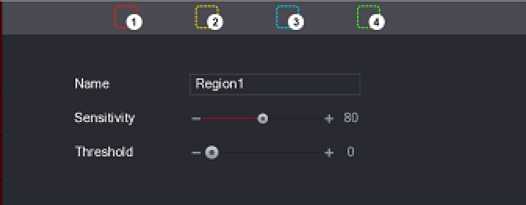
Figure 5-108
Step 3 Configure the regions settings. You can configure totally four regions.
- Select one region, for example, click .
- Drag on the screen to select the region that you want to detect.
The selected area shows the color that represents the region.
3) Configure the parameters.
| Parameter | Description |
| Name | Enter a name for the region. |
| Sensitivity | Every region of every channel has an individual sensitivity value. The bigger the value is, the easier the alarms can be activated. |
| Threshold | Adjust the threshold for motion detect. Every region of every channel has an individual threshold. |
Figure 5-109
ED NOTE
When anyone of the four regions activates motion detect alarm, the channel where this region belongs to will activate motion detect alarm.
Step 4 Right-click on the screen to exit the region setting interface.
Step 5 On the Motion Detect interface, click Apply to complete the settings.
Setting Motion Detection Period
ED NOTE
The system only activates the alarm in the defined period.
Step 1 Next to Period, click Setting.
The Setting interface is displayed. See Figure 5-110.
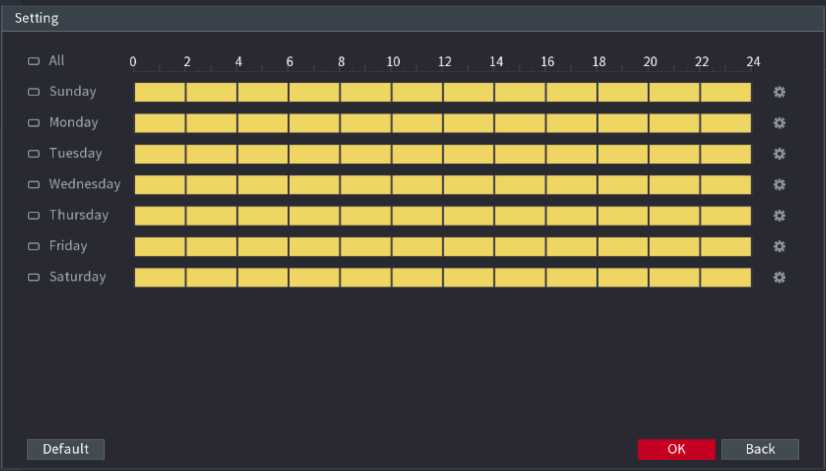
Figure 5-110
Step 2 Define the motion detection period. By default, it is active all the time.
- Define the period by drawing.
O Define for a specified day of a week: On the timeline, click the half-hour blocks to select the active period.
O Define for several days of a week: Click ^9 before each day, the icon
switches to a. On the timeline of any selected day, click the half-hour blocks to select the active periods, all the days with a will take the same settings.
O Define for all days of a week: Click All, all e switches to E3. On the
timeline of any day, click the half-hour blocks to select the active periods, all the days will take the same settings.
- Define the period by editing. Take Sunday as an example.
1) Click
![]()
The Period interface is displayed. See Figure 5-111.
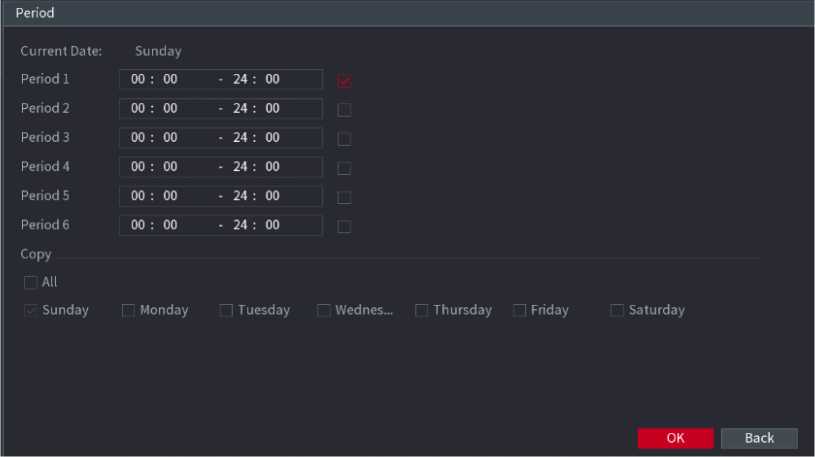
Figure 5-111
O There are six periods for you to set for each day.
O Under Copy, select All to apply the settings to all the days of a week, or select specific day(s) that you want to apply the settings to.
- Click OK to save the settings.
Step 3 On the Motion Detect interface, click Apply to complete the settings.
5.10.1.2 Configuring Video Loss Settings
When the video loss occurs, the system activates the alarm. To configure the Video loss settings, do the following:
Step 1 Select Main Menu ■> Event ^ VIDIEO DETECT ■> Video Loss.
The Video Loss interface is displayed. See Figure 5-112.
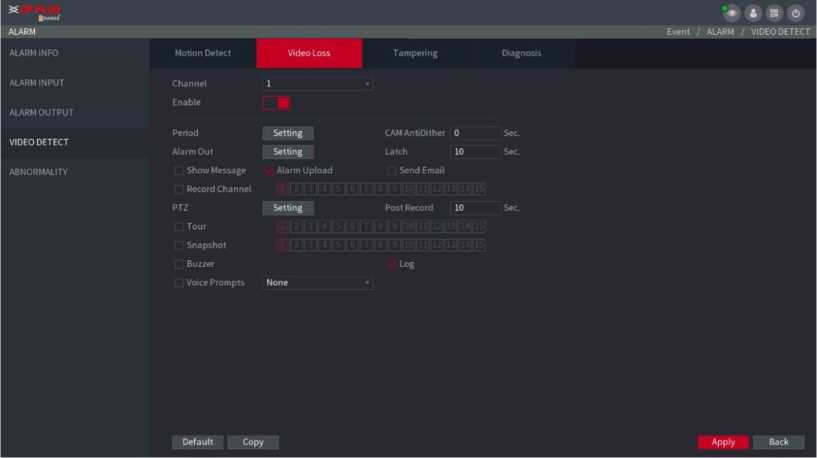
Figure 5-112
Step 2 To configure the settings for the video loss detection parameters, see “5.10.1.1 Configuring Motion Detect Settings.”
EQ NOTE
For PTZ activation, different from motion detection, the video loss detection can activate PTZ preset, tour, and pattern.
Step 3 Click Apply to complete the settings.
EQ NOTE
- Click Default to restore the default setting.
- Click Copy, in the Copy dialog box, select the additional channel(s) that you want to copy the motion detection settings to, and then click Apply.
5.10.1.3 Configuring Tampering Settings
When the camera lens is covered, or the video is displayed in a single color because of the causes such as sunlight status, the monitoring cannot be continued normally. To avoid such situations, you can configure the tampering alarm settings.
Step 1 Select Main Menu ^ Event ^ VIDIEO DETECT ^ Tampering.
The Tampering interface is displayed.See Figure 5-113.
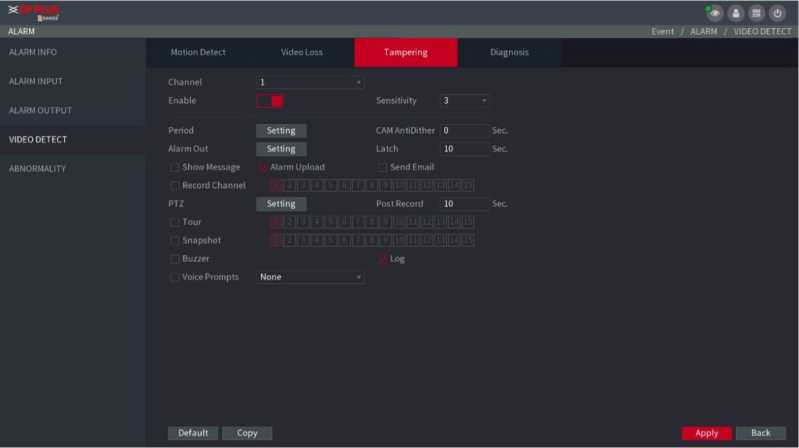
Figure 5-113
Step 2 To configure the settings for the tampering detection parameters, see “5.10.1.1 Configuring Motion Detect Settings.”
EQ NOTE
For PTZ activation, different from motion detection, the video loss detection can activate PTZ preset, tour, and pattern.
Step 3 Click Apply to complete the settings.
EQ NOTE
- Click Default to restore the default setting.
- Click Copy, in the Copy dialog box, select the additional channel(s) that you want to copy the motion detection settings to, and then click Apply.
5.10.1.4 Configuring Diagnosis Settings
EQ NOTE
This function can be used only when it is supported by the camera.
When the video appear the conditions such as blurry, overexposed, or the color changes, the system activates the alarm.
To configure the diagnosis settings, do the following:
Step 1 Select Main Menu ^ Events VIDIEO DETECT > Diagnosis.
The Diagnosis interface is displayed.See Figure 5-114.
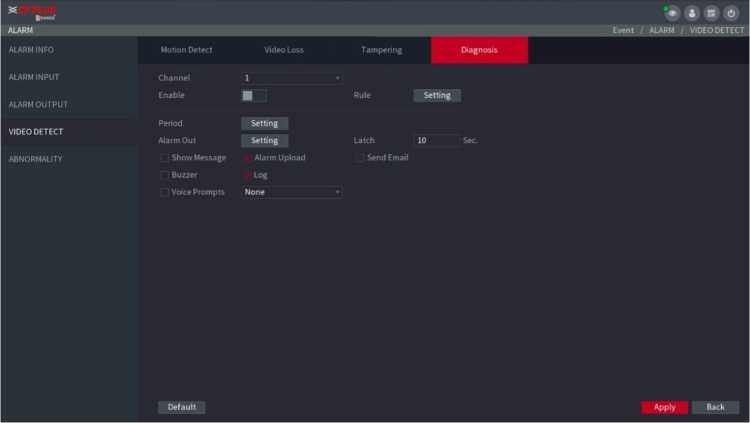
Figure 5-114
Step 2 To configure the settings for the diagnosis parameters, see “5.10.1.1 Configuring
Step 3 Click Apply to complete the settings.
EQ NOTE
Click Default to restore the default setting.
Setting the Types for Diagnosing Targets
Step 1 Next to Rule, click Setting.
The Diagnosis interface is displayed. See Figure 5-115.
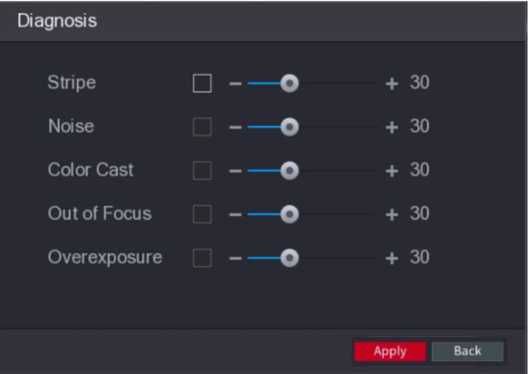
Figure 5-115
Step 2 Select the items that you want to diagnose and set the threshold (30 by default). See Table 5-35.
| Parameter | Description |
| Stripe | A horizontal, vertical or diagonal stripe that might appear in the video because of device aging or electronic interruption. Such stripe brings visual interruption. |
| Noise | Video noises such as blurriness or quality reduction that is caused by optical distortion or device problem during camera shooting. |
| Color Cast | Variances in the normal proportions of RGB colors. |
Table 5-35
Step 3 Click OK to save the settings.
The system returns to the Diagnosis interface.
Step 4 Click Apply to complete the settings.
ED NOTE
Click Default to restore the default setting.
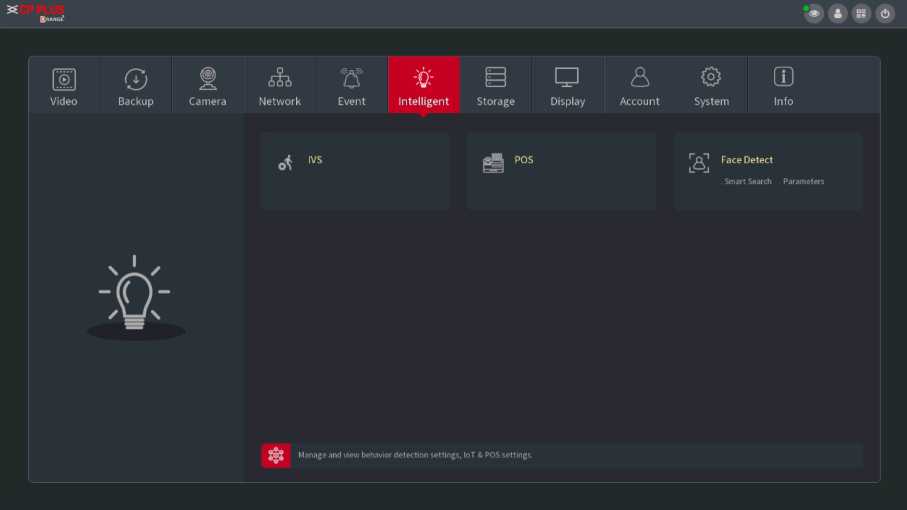
![]()
Please disable IP channels function first before using IVS function.
IVS function processes and analyzes the images to extract the key information to match with the preset rules. When the detected behaviors match with the rules, the system activates alarms.
Step 1 Select Main Menu ■> Intelligent.
The INTELL SETTING interface is displayed. See Figure 5-116.
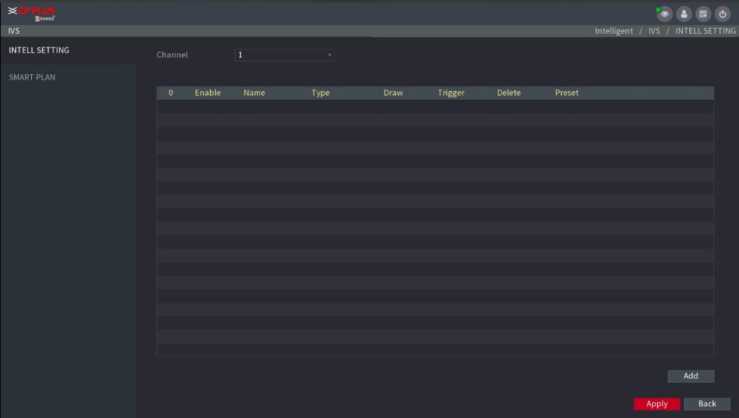
Figure 5-116
Step 2 In the Channel list, select the channel number that you want to configure the IVS function for.
Step 3 Click Add.
One line of rule is displayed. See Figure 5-117.
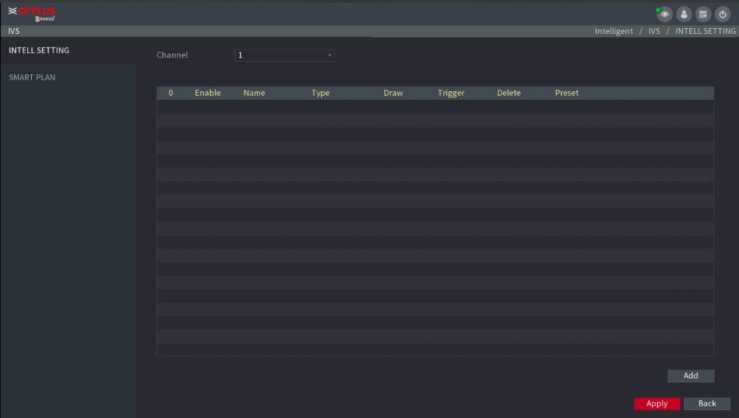
Figure 5-117
Step 4 Configure the parameters for the rule that you selected.
Step 5 Select the check box of the rule to enable it.
Step 6 Click Apply to complete the settings.
When the target object crosses the tripwire in the defined direction, the system activates alarms.
- The tripwire can be configured as a straight line or broken line.
- Supports detecting one-way or two-way tripwire crossing.
- Supports multiple tripwires in the same scenario to meet the complexity.
- Supports size filtering for target.
Step 1 On the rule line that you added, in the Type list, select Tripwire. See Figure 5-118.
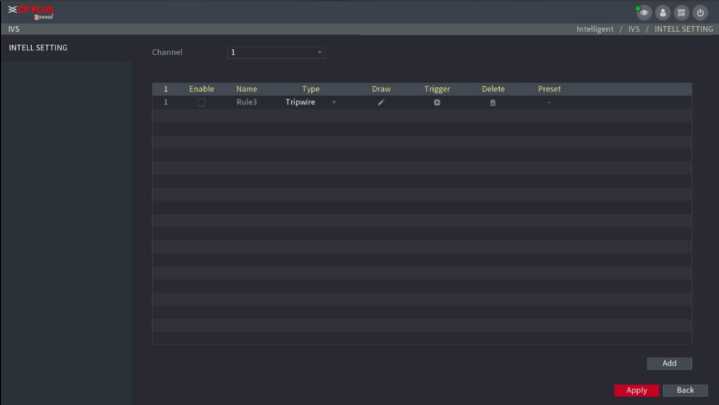
Figure 5-118
- In the Channel list, select the channel that you want to configure the rules for.
- Click □.
The monitoring screen to configure the tripwire rules is displayed. See Figure 5119.
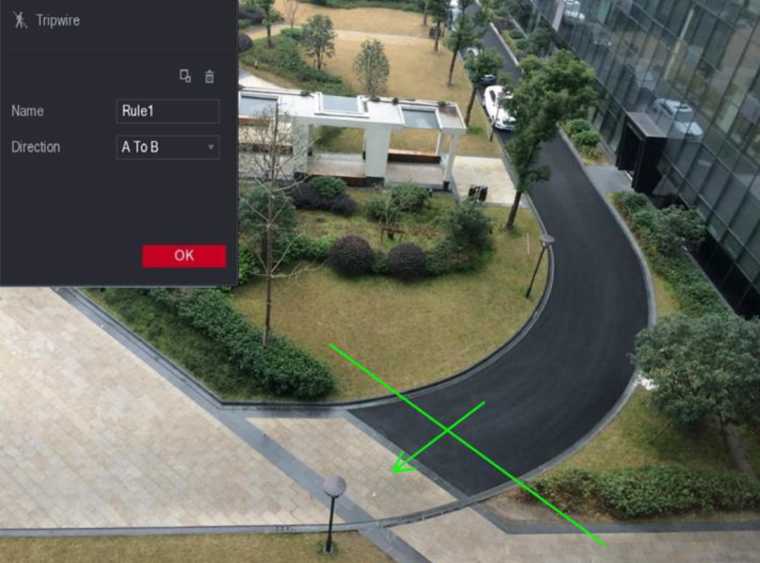
Figure 5-119
3) Configure the settings for the parameters of drawing rules. See Table 5-36.
| Parameter | Description |
| CQ NOTE | |
| You can configure two filtering targets (maximum size and | |
| minimum size). When the target that is crossing the tripwire is | |
| smaller than the minimum size or larger than the maximum size, | |
| no alarms will be activated. The maximum size should be larger | |
| than the minimum size. |
Table 5-36
- Drag to draw a tripwire. The tripwire can be a straight line, broken line or polygon.
- Click Save to save the settings.
Step 3 Click
![]()
to set the actions to be triggered.
The Trigger interface is displayed. See Figure 5-120.
Trigger
| Period
Alarm Out Show Message Record Channel |
Setting | Latch
Send Email |
10 | Sec. |
| Setting
Alarm Upload |
||||
| PTZ | Setting | Post Record | 10 | Sec. |
| Tour | ||||
| Snapshot | ||||
| Buzzer | Log | |||
| Voice Prompts | None |
OK Back
Figure 5-120
Step 4 Configure the triggering parameters. See Table 5-37.
| Parameter | Description |
| Period | Click Set to display set interface.
Define a period during which the motion detection is active. For details, see “Setting Motion Detection Period” section in “5.10.1.1 Configuring Motion Detect Settings.“ |
| Alarm Out | Click Setting to display setting interface.
devices connected to the selected output port.
connected alarm box.
connected by USB gateway or camera gateway. |
| Parameter | Description |
| Latch | Set a length of time for the Device to delay turning off alarm after the external alarm is cancelled. The value ranges from 0 seconds to 300 seconds, and the default value is 10 seconds. |
| Show Message | Select the Show Message check box to enable a pop-up message in your local host PC. |
| Alarm Upload | Select the Alarm Upload check box to enable the system to upload the alarm signal to the network (including alarm center) when an alarm event occurs. |
| Send Email | Select the Send Email check box to enable the system to send an email notification when an alarm event occurs.
ED NOTE |
| To use this function, make sure the email function is enabled in | |
| Main Menu ■> Network ^ Email. | |
| Record Channel | Select the channel(s) that you want to record. The selected channel(s) starts recording after an alarm event occurs. ED NOTE |
| The recording for intelligence event and auto recording function | |
| must be enabled. For details, see “5.1.4.9 Configuring Recorded | |
| Video Storage Schedule” and “5.9.1 Enabling Record Control.“ | |
| PTZ | Click Set to display the PTZ interface.
Enable PTZ activation function. For each PTZ camera, select the preset that you want to be called when an alarm event occurs. CD NOTE |
| Motion Detect can only activate PTZ preset. | |
| Post Record | Set a length of time for the Device to delay turning off recording after the alarm is cancelled. The value ranges from 10 seconds to 300 seconds, and the default value is 10 seconds. |
| Tour | Select the Tour check box to enable a tour of the selected channels.
ED NOTE |
| To use this function, make sure the tour is enabled and configured | |
| in Main Menu ^ Display^ Tour. | |
| Select the Snapshot check box to take a snapshot of the selected channel.
ED NOTE |
|
| To use this function, make sure the following settings are | |
| Snapshot | configured: |
| • The snapshot function is enabled for motion detect alarms in | |
| Main Menu ^ Storage ^ Schedule ■+ Snapshot. | |
| • Select Main Menu ^Camera ^ Snapshot, in the Mode list, | |
| select Event. | |
| Video Matrix | Select the check box to enable the function. When an alarm event occurs, the video output port outputs the settings configured in “Main Menu ^ Display ^ Tour.” |
Table 5-37
Step 5 Click Apply to save the settings.
The INTELL SETTING interface is displayed.
Step 6 Select the Enable check box, and then click Apply.
The tripwire detecting function is active. When the target object crosses the tripwire in the defined direction, the system activates alarms.
5.10.2.2 Configuring Intrusion Rules
When the target enters and leaves the area, or the target appears in the defined area, the system activates alarms.
- You can define the shape and quantity of intrusion areas.
- Supports detecting the behaviors that enter and leave the intrusion areas.
- Supports detecting the behaviors that are moving in the intrusion areas. The quantity of
areas and lasting time can be configured.
- Supports size filtering for target.
Step 1 On the rule line that you added, in the Type list, select Intrusion. See Figure 5-121.
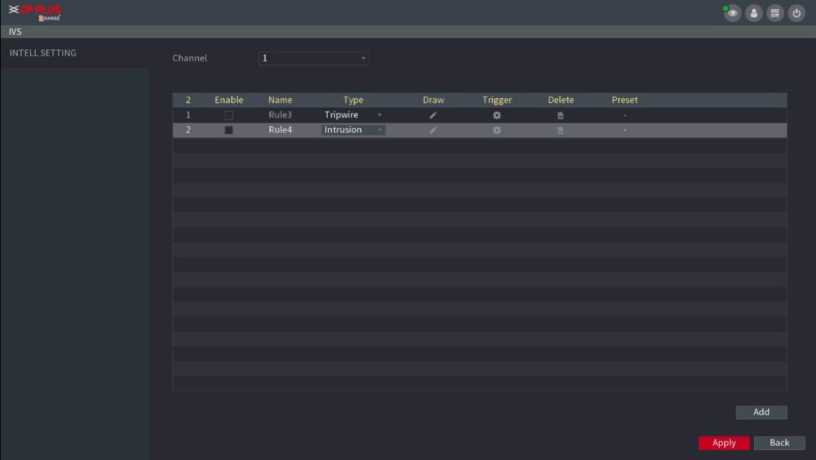
Figure 5-121
- In the Channel list, select the channel that you want to configure the rules for.
- Click □.
The monitoring screen to configure the intrusion rules is displayed. See Figure 5122.
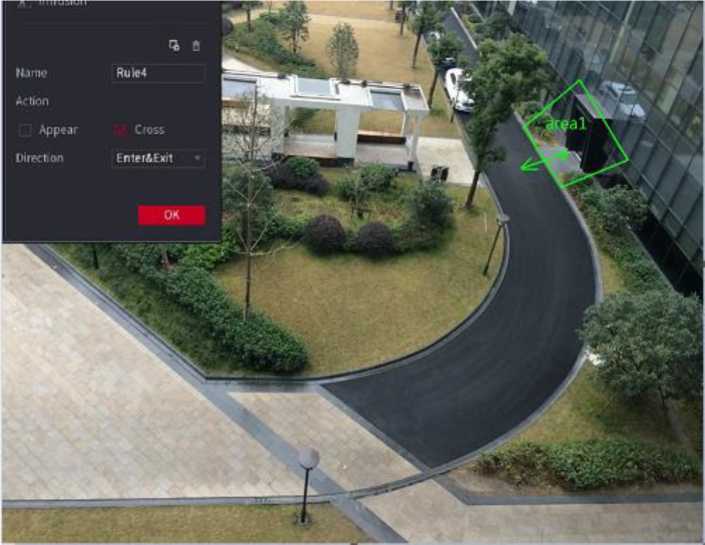
Figure 5-122
3) Configure the settings for the parameters of drawing rules. See Table 5-38Table 5-36.
Table 5-38
- Drag to draw an area.
- Click Save to save the settings.
Step 3 Click
![]()
to set the actions to be triggered. For details, see “5.10.2.1 Configuring
Step 4 Select the Enable check box, and then click Apply.
The intrusion detecting function is active. When the target enters and leaves the area, or the target appears in the defined area, the system activates alarms.
5.10.2.3 Configuring Abandoned Rules
When the object is placed in the defined detection area for more than the set time, the system activates alarms.
- You can define the shape and quantity of intrusion areas.
- Period value can be configured.
- Supports size filtering for target.
Step 1 On the rule line that you added, in the Type list, select Abandoned.
The Abandoned interface is displayed. See Figure 5-123.
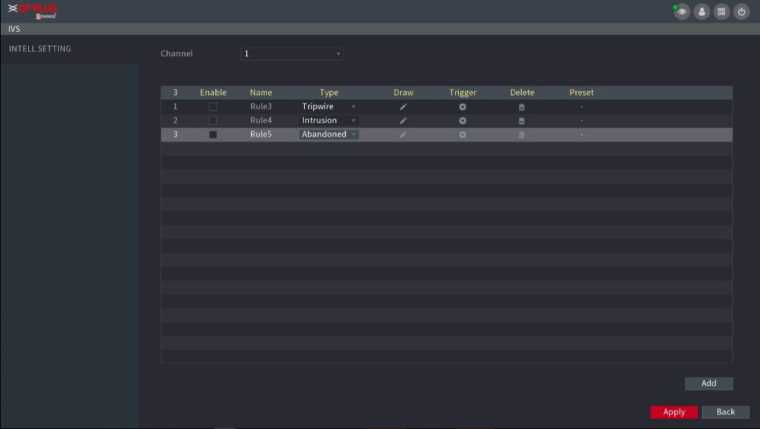
Figure 5-123
- In the Channel list, select the channel that you want to configure the rules for.
2)
Click
![]()
The monitoring screen to configure the abandoned rules is displayed. See Figure 5-124.
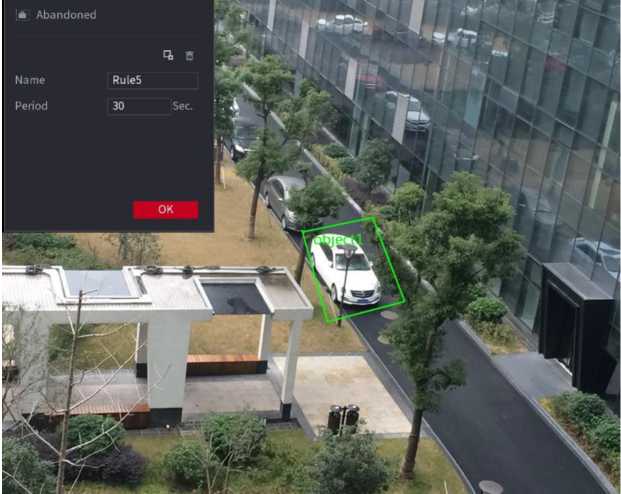
3) Configure the settings for the parameters of drawing rules. See Table 5-39.
Table 5-39
- Drag to draw an area.
- Click Save to save the settings.
Step 3 Click
![]()
to set the actions to be triggered. For details, see “5.10.2.1 Configuring
Step 4 Select the Enable check box, and then click Apply.
The abandoned object detecting function is active. When the object is placed in the defined detection area for more than the set time, the system activates alarms.
5.10.2.4 Configuring Missing Rules
When the target is taken away from the defined area exceeds the set time, the system activates alarms.
Step 1 On the rule line that you added, in the Type list, select Missing.
The Missing interface is displayed. See Figure 5-125.
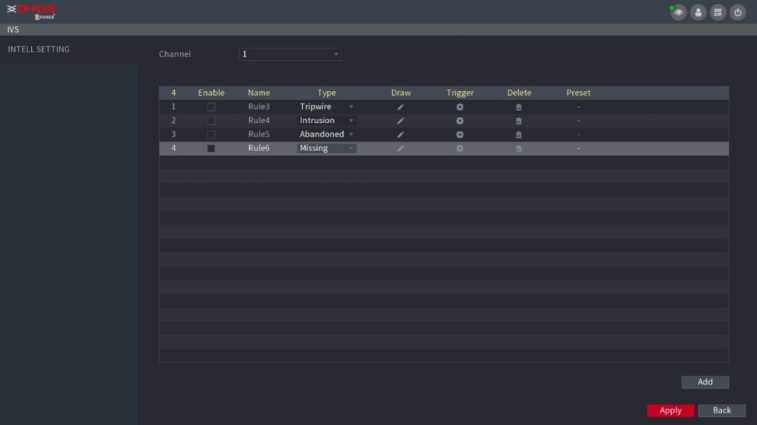
Figure 5-125
1) In the Channel list, select the channel that you want to configure the rules for.
2)
Click
![]()
The monitoring screen to configure the missing rules is displayed. See Figure 5126.
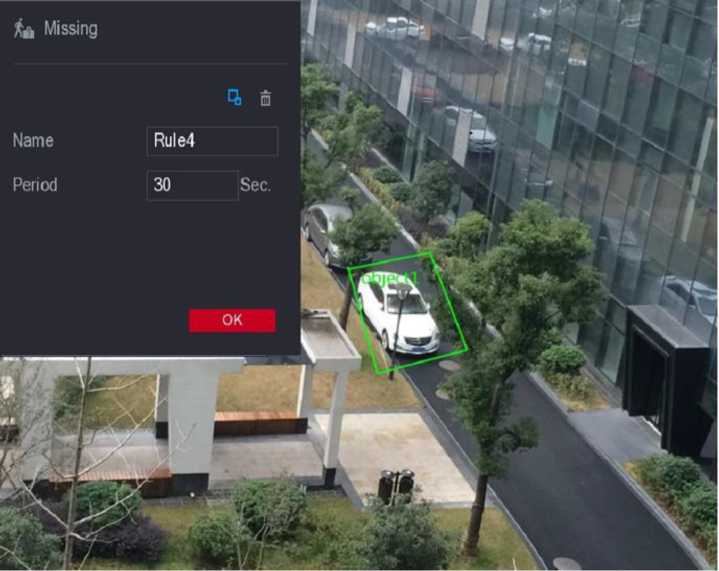
Figure 5-126
3) Configure the settings for the parameters of drawing rules. See Table 5-40.
Table 5-40
- Drag to draw an area.
- Click Save to save the settings.
Click
![]()
to set the actions to be triggered. For details, see “5.10.2.1 Configuring
Step 3 Select the Enable check box, and then click Apply.
The missing object detecting function is active. When the target is taken away from the defined area exceeds the set time, the system activates alarms.
You can configure the face detection settings and search the detected faces in the defined time period.
When the Device detects the human faces, the system activates alarms.
CD NOTE
- Not all models support this function.
- Smart IPC must be equipped with face detect function.
Step 1 Select Main Menu ■> Intelligent^ Face Detect ^ Parameters.
The Human Face interface is displayed. See Figure 5-127.
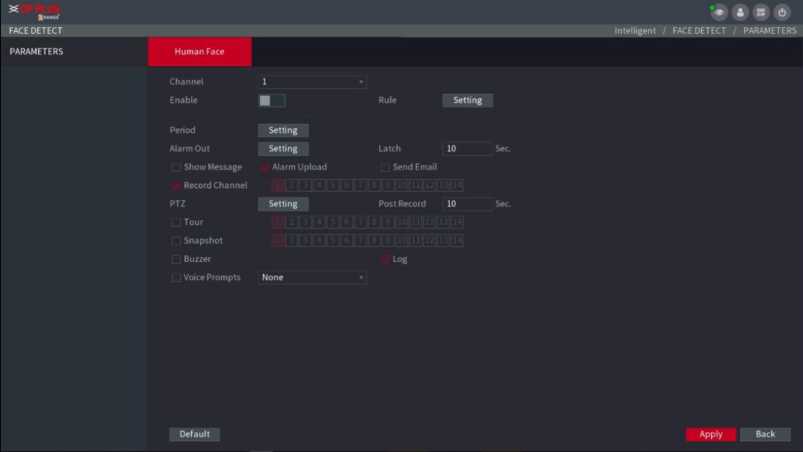
![]()
Step 2 Configure the settings for the face detection parameters. See Table 5-41.
| Parameter | Description | ||
| Channel | In the Channel list, select a channel to set the face detection. | ||
| Click Setting to draw areas to filter the target.
CD NOTE |
|||
| Target Filter | You can configure two filtering targets (maximum size and | ||
| minimum size). When the target is smaller than the minimum size | |||
| or larger than the maximum size, no alarms will be activated. The | |||
| maximum size should be larger than the minimum size. | |||
| Enable | Enable or disable the face detection function. | ||
| Period | Define a period during which the motion detection is active. | ||
| Alarm Out | Click Setting to display setting interface.
Enable alarm activation function. Select the alarm output port(s) to which the peripheral alarm devices are connected. When an alarm event occurs, the system activates the peripheral alarm devices connected to the selected output port. |
||
| Parameter | Description | |||||||||
| Latch | Set a length of time for the Device to delay turning off alarm after the external alarm is cancelled. The value ranges from 0 seconds to 300 seconds, and the default value is 10 seconds. If you enter 0, there will be no delay. | |||||||||
| Send Email | Select the Send Email check box to enable the system to send an email notification when an alarm event occurs.
CD NOTE |
|||||||||
| To use this function, make sure the email function is enabled in | ||||||||||
| Main Menu ■> Network •+ EMAIL. | ||||||||||
| Record Channel | Select the channel(s) that you want to record. The selected channel(s) starts recording after an alarm event occurs.
CD NOTE |
|||||||||
| The recording for intelligence event and auto recording function | ||||||||||
| must be enabled. For details, see “5.1.4.9 Configuring Recorded | ||||||||||
| Video Storage Schedule” and “5.9.1 Enabling Record Control.‘ | ||||||||||
| PTZ | Click Setting to display the PTZ interface.
Enable PTZ activation function. For each PTZ camera, select the preset that you want to be called when an alarm event occurs. CD NOTE |
|||||||||
| Motion Detect can only activate PTZ preset. | ||||||||||
| Post Record | Set a length of time for the Device to delay turning off recording after the alarm is cancelled. The value ranges from 10 seconds to 300 seconds, and the default value is 10 seconds. | |||||||||
| Select the Snapshot check box to take a snapshot of the selected channel.
ED NOTE |
||||||||||
| To use this function, make sure the following settings are | ||||||||||
| Snapshot | configured: | |||||||||
| • | The snapshot function is enabled for motion detect alarms in | |||||||||
| Main Menu ^ Storage ^ Schedule ^ Snapshot. | ||||||||||
| • | Select Main Menu ^ Camera ^ Encode ^ Snapshot, in | |||||||||
| the Mode list, select Event. | ||||||||||
| Buzzer | Select the check box to activate a buzzer noise at the Device. | |||||||||
| Log | Select the check box to enable the Device to record a local alarm log. | |||||||||
| Voice Prompts | Select to enable audio broadcast/voice prompts in response to a human face detection event. | |||||||||
Table 5-41
Step 3 Click Apply to complete the settings.
Step 1 Select Main Menu ^Video^ Intelligent Play^ Smart Search.
The SMART SEARCH interface is displayed.See Figure 5-128.
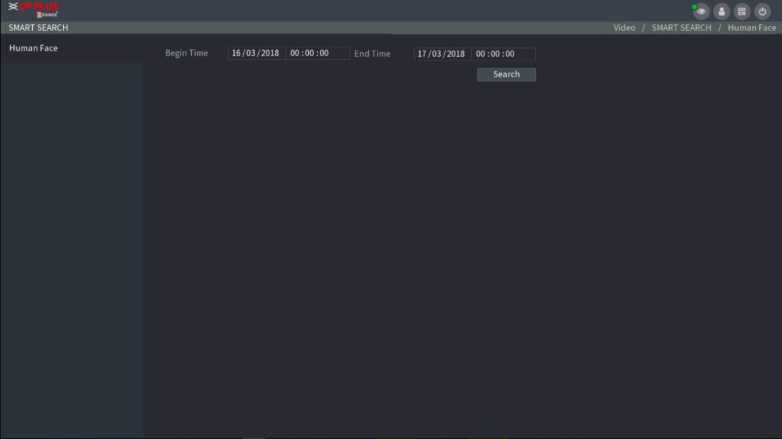
Figure 5-128
Step 2 In the Begin Time box and End Time box, enter the time.
Step 3 Click Search.
The faces searched in the defined period display. See Figure 5-129.
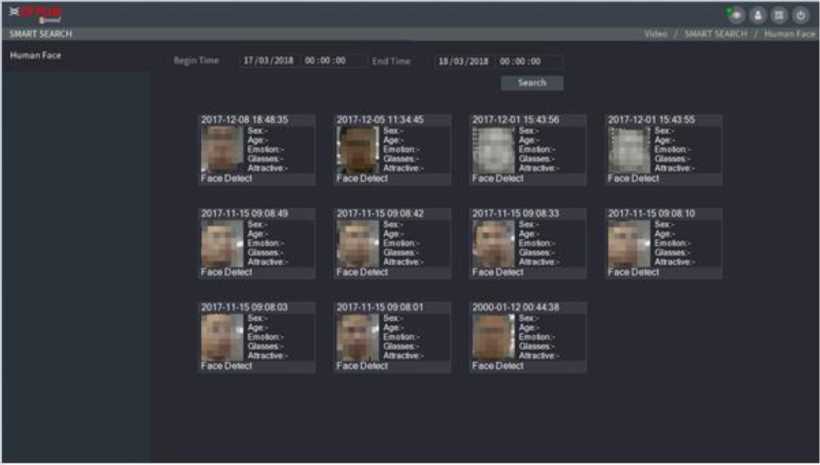
Figure 5-129
You can configure the alarm output for three types of system event (HDD, Network, and User). When there is an abnormal system event occurs, the system activates alarms in the way that you configure in this section.
Step 1 Select Main Menu ■> Events Abnormity > HDD.
The HDD interface is displayed.See Figure 5-130.
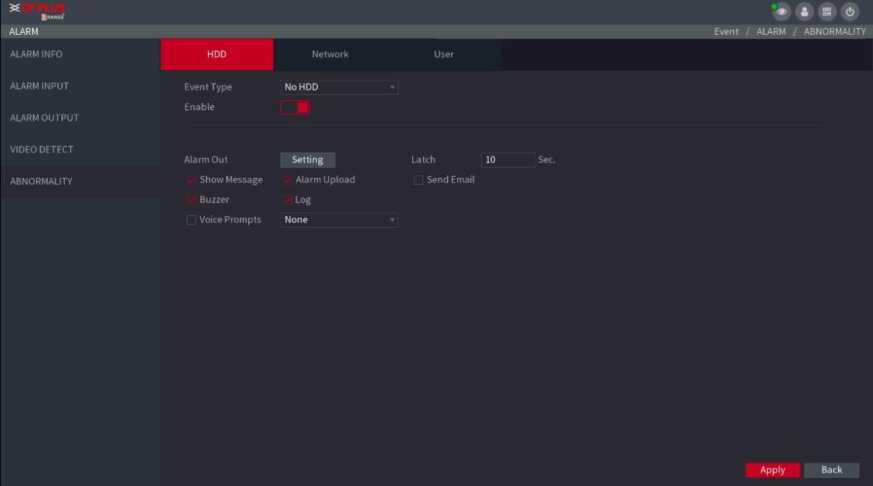
Figure 5-130
Step 2 Configure the settings for the HDD event. See Table 5-42.
Table 5-42
Step 3 Click Apply to complete the settings.
Step 1 Select Main Menu ■> Event ^ Abnormity ^ Network.
The Network interface is displayed.See Figure 5-131.
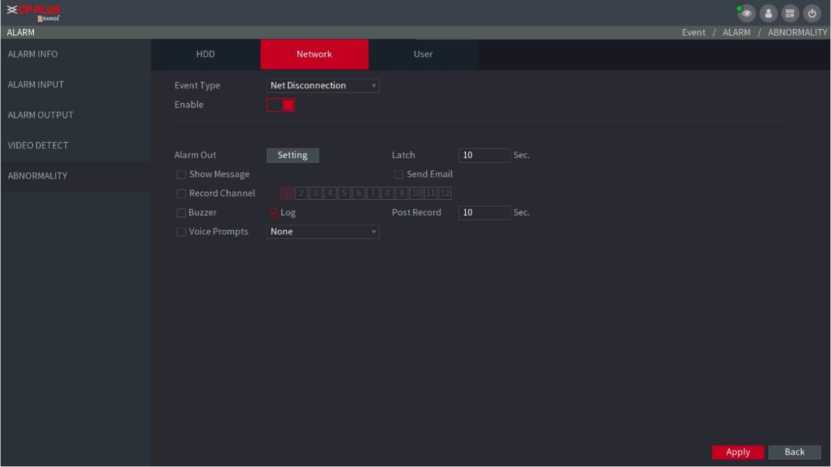
Figure 5-131
Step 2 Configure the settings for the Network event. See Table 5-43.
| Parameter | Description |
| Voice Prompts | Select to enable audio broadcast/voice prompts in response to a network alarm event. |
Table 5-43
Step 3 Click Apply to complete the settings.
Step 1 Select Main Menu ^ Event ^ Abnormity ^ User.
The User interface is displayed.See Figure 5-132.
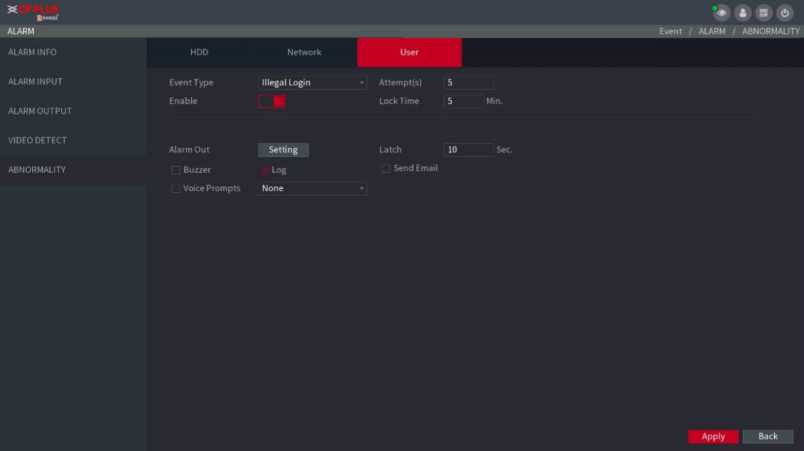
Figure 5-132
Step 2 Configure the settings for the User event. See Table 5-44.
Table 5-44
Step 3 Click Apply to complete the settings.
Step 1 Select Main Menu ■> Event ^ Abnormity > Device.
The Device interface is displayed.See Figure 5-133.
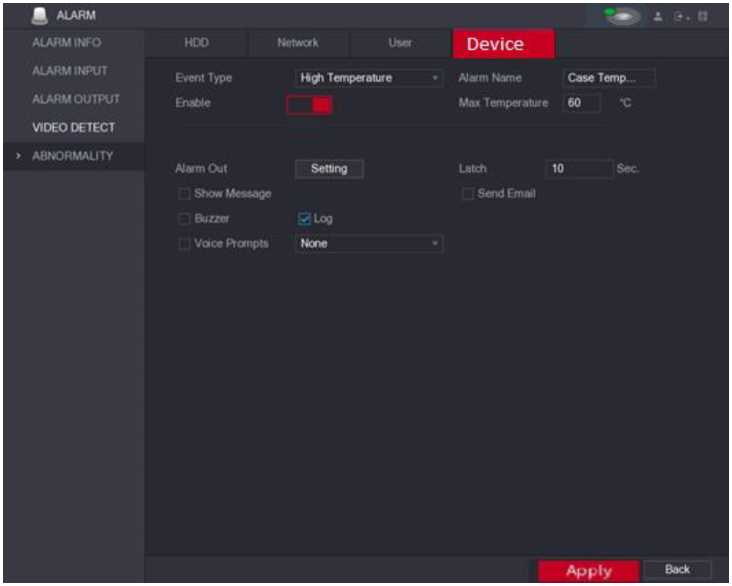
Figure 5-133
Step 2 Configure the settings for the device event. See Table 5-45.
Table 5-45
Step 3 Click Apply to complete the settings.
Connect the alarm input and output ports by referring to “4.3 Connecting to Alarm Input and Output.” You can configure the alarm settings for each channel individually or apply the settings to all channels and then save the settings.
You can connect the alarm device to the alarm input port of the Device. When the alarm is activated on the alarm device, the alarm information will be uploaded to the Device, and then the Device outputs the local alarms in the way that you configure in this section.
Step 1 Select Main Menu ■> Events ALARM INPUT ■> Local.
The Local interface is displayed.See Figure 5-134.
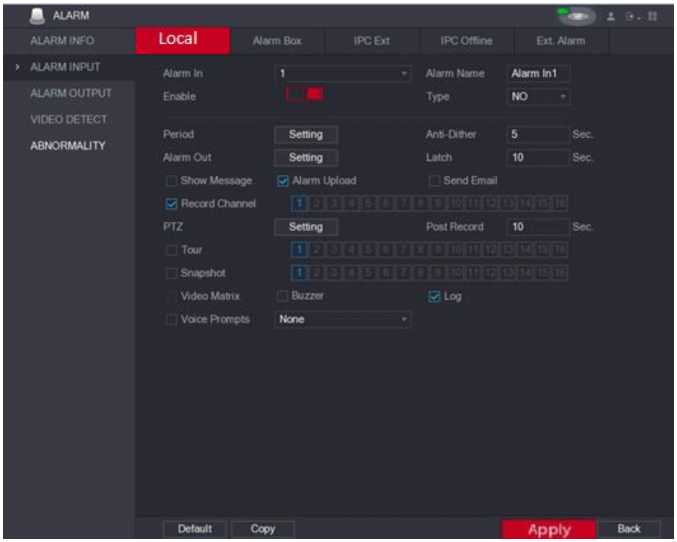
Figure 5-134
Step 2 Configure the settings for the local alarms. See Table 5-46.
Description
| Alarm In | Select the channel number. |
| Alarm Name | Enter the customized alarm name. |
| Enable | Enable or disable the local alarm function. |
| Type | In the Type list, select NO or select NC as the voltage output type. |
| Period | Click Setting to display setting interface.
Define a period during which the motion detection is active. For details, see “Setting Motion Detection Period” section in “5.10.1.1 Configuring Motion Detect Settings.“ |
| Anti-Dither | Configure the event detection lasting time. The system records only one event during this period. The value ranges from 5 seconds to 600 seconds. |
| Alarm Out | Click Setting to display setting interface.
connected to the selected output port.
alarm box.
connected by USB gateway or camera gateway. |
| Latch | Set a length of time for the Device to delay turning off alarm after the external alarm is cancelled. The value ranges from 0 seconds to 300 seconds, and the default value is 10 seconds. |
| Show Message | Select the Show Message check box to enable a pop-up message in your local host PC. |
| Alarm Upload | Select the Alarm Upload check box to enable the system to upload the alarm signal to the network (including alarm center) when an alarm event occurs. |
| Parameter | Description |
| Select the Send Email check box to enable the system to send an email notification when an alarm event occurs. | |
| Send Email | EQ NOTE |
| To use this function, make sure the email function is enabled in Main | |
| Menu ^ Network ^ EMAIL. | |
| Select the channel(s) that you want to record. The selected channel(s) starts recording after an alarm event occurs. | |
| Record Channel | EQ NOTE |
| The recording for alarm and auto snapshot must be enabled. For | |
| details, see “5.1.4.9 Configuring Recorded Video Storage Schedule” | |
| and “5.9.1 Enabling Record Control.“ | |
| Click Setting to display the PTZ interface. | |
| PTZ | Enable PTZ activation function. For each PTZ camera, select the preset that you want to be called when an alarm event occurs. |
| Set a length of time for the Device to delay turning off recording after | |
| Post Record | the alarm is cancelled. The value ranges from 10 seconds to 300 seconds, and the default value is 10 seconds. |
| Select the Tour check box to enable a tour of the selected channels. | |
| Tour | EQ NOTE |
| To use this function, make sure the tour is enabled and configured in | |
| Main Menu ^ Display ^ TOUR. | |
| Select the Snapshot check box to take a snapshot of the selected channel. | |
| EQ NOTE | |
| Snapshot | To use this function, make sure the following settings are configured: |
| • The snapshot function is enabled for motion detect alarms in Main | |
| Menu ^ Storage ^ Schedule ^ Snapshot. | |
| • Select Main Menu ■+ Camera ^ Encode ^ Snapshot, in the | |
| Mode list, select Event. | |
| Select the check box to enable the function. When an alarm event | |
| occurs, the video output port outputs the settings configured in “Main | |
| Video Matrix | Menu ^ Display ■+ TOUR.” |
| EQ NOTE | |
| Not all models support this function. | |
| Buzzer | Select the check box to activate a buzzer noise at the Device. |
| Log | Select the check box to enable the Device to record a local alarm log. |
| Voice Prompts | Select to enable audio broadcast/voice prompts in response to a local alarm event. |
Table 5-46
Step 3 Click Apply to complete the settings.
EQ NOTE
- Click Default to restore the default setting.
- Click Copy, in the Copy dialog box, select the additional channel(s) that you want to copy the local alarm settings to, and then click Apply.
You can connect the alarm box to the RS485 port of the Device. When the alarm is detected by the alarm box, the alarm information will be uploaded to the Device, and then the Device outputs the alarms in the way that you configure in this section.
Step 1 Select Main Menu ^ Event^ALARM INPUT ^ Alarm Box.
The Alarm Box interface is displayed.See Figure 5-135
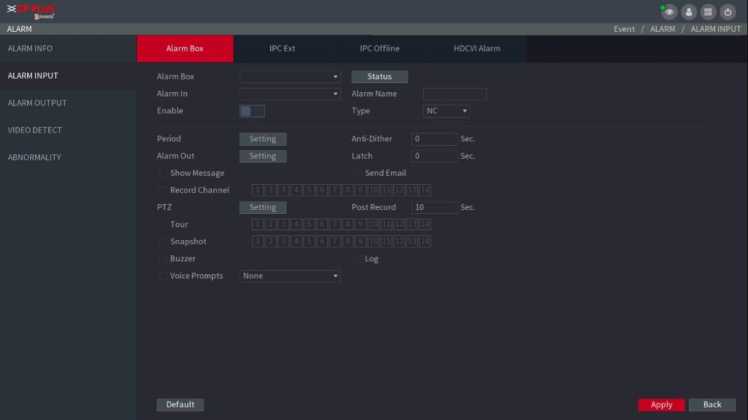
![]()
Step 2 In the Alarm Box list, select the alarm box number corresponding to the address number configured by the DIP switch on the Alarm Box.
Step 3 In the Alarm In list, select the alarm input port on the Alarm Box.
Step 4 Configure the settings for other parameters of the Alarm Box. For details, see Table 546.
Step 5
Click Apply to complete the settings.
Click Default to restore the default setting.
Step 1 Select Main Menu ^ Events ALARM INPUT ^ IPC Ext.
The IPC Ext interface is displayed.See Figure 5-136.
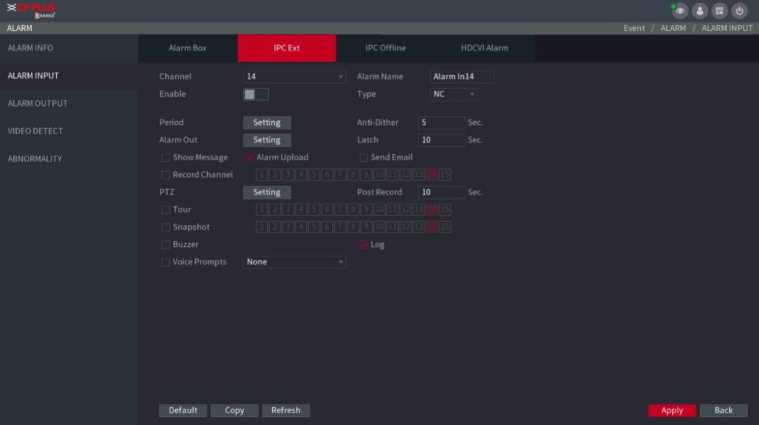
Figure 5-136
Step 2 Configure the alarm input settings from the external IPC. For details, see Table 5-46.
Step 3 Click Apply to complete the settings.
![]()
- Click Default to restore the default setting.
- Click Copy to copy the settings to other channels.
- Click Refresh to refresh configured settings.
5.10.5.4 Configuring Alarms for IP Camera Offline
You can configure the alarm settings for the situation when the IP camera is offline.
Step 1 Select Main Menu ^ Event ^ ALARM INPUT ^ IPC Offline.
The IPC Offline interface is displayed.See Figure 5-137.
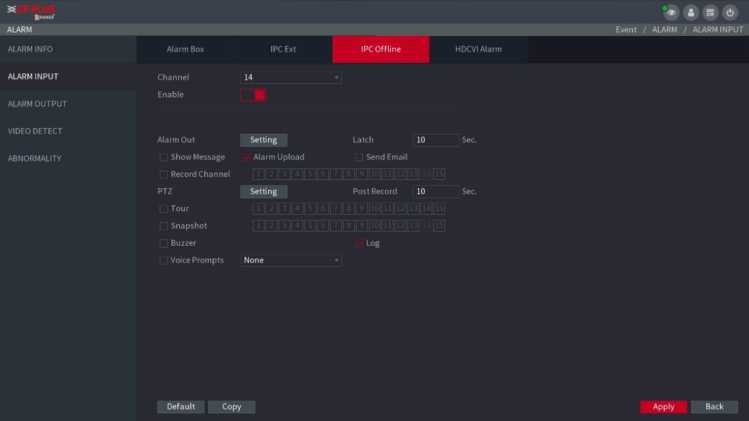
![]()
Step 2 Configure the alarm input settings from the external IPC. For details, see Table 5-46.
Step 3 Click Apply to complete the settings.
Q NOTE
- Click Default to restore the default setting.
- Click Copy to copy the settings to other channels.
5.10.5.5 Configuring Alarms from External Devices
Step 1 Select Main Menu ^Event^ ALARM INPUT ^ HDCVI Alarm.
The Ext. Alarm interface is displayed.See Figure 5-138.
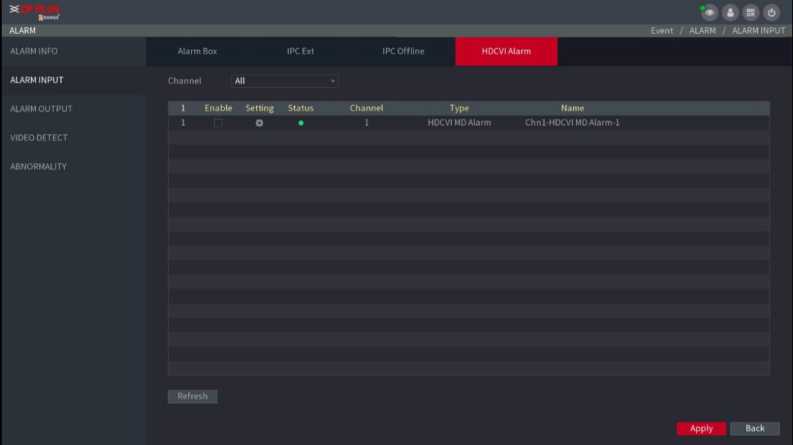
Figure 5-138
Step 2 In the Channel list, select a channel or all.
![]()
Step 3 Click
The Setting interface is displayed. See Figure 5-139.
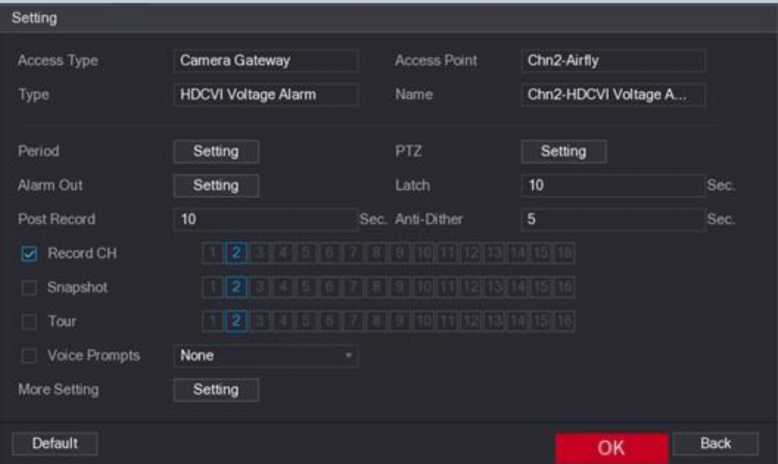
Figure 5-139
Step 4 Configure the settings for other parameters of the Alarm Box. For details, see Table 546.
Step 5 Click OK to complete the settings.
When the Device activates alarms, the connected alarm device generates alarms in the way that you can configure in this section. You can connect to the output port of the Device or connect wirelessly.
- Auto: When an alarm event is triggered on the Device, the connected alarm device generates alarms.
- Manual: The alarm device is forced to keep generating alarms.
- Stop: The alarm output function is not enabled.
Step 1 Select Main Menu^ Event ^ ALARM OUTPUT.
The ALARM OUTPUT interface is displayed.See Figure 5-140.
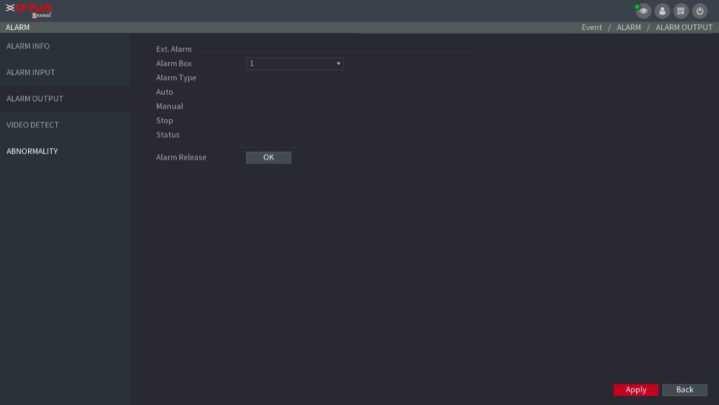
Figure 5-140
Step 2 Configure the settings for the alarm output. For details, see Table 5-47.Table 5-46
Table 5-47
Step 3 Click Apply to save the settings.
You can connect external sensors wirelessly through the Device with USB gateway or through connecting to a camera gateway. After connection, you can activate alarm events through external sensors.
CD NOTE
Only the Device with USB gateway supports this function.
Step 1 Select Main Menu ^ Intelligent^ IoT ^Manager ^ Sensor Pairing.
The Sensor Pairing interface is displayed. See Figure 5-141.
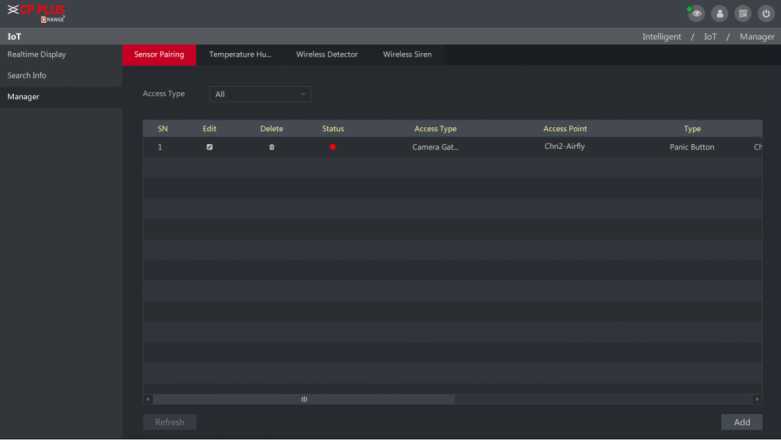
Figure 5-141
Step 2 In the Access Type list, select USB Gateway.
Step 3 Click Add.
The Add interface is displayed. See Figure 5-142.
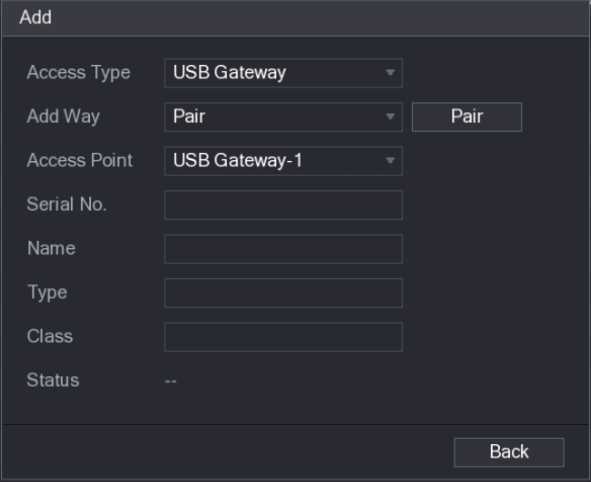
Figure 5-142
The Device starts pairing with the sensor.
After pairing is completed, see Figure 5-143.
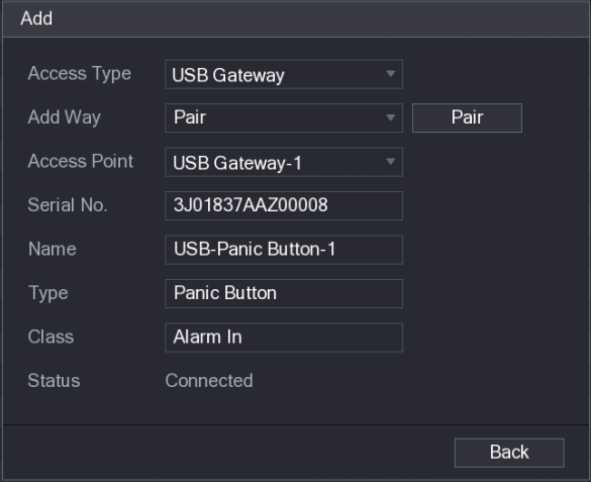
Figure 5-143
Step 5 Click Back to exit the pairing interface.
The added sensor information is displayed. See Figure 5-144. Q NOTE
Click
![]()
to modify the sensor name; click
![]()
to delete sensor information.
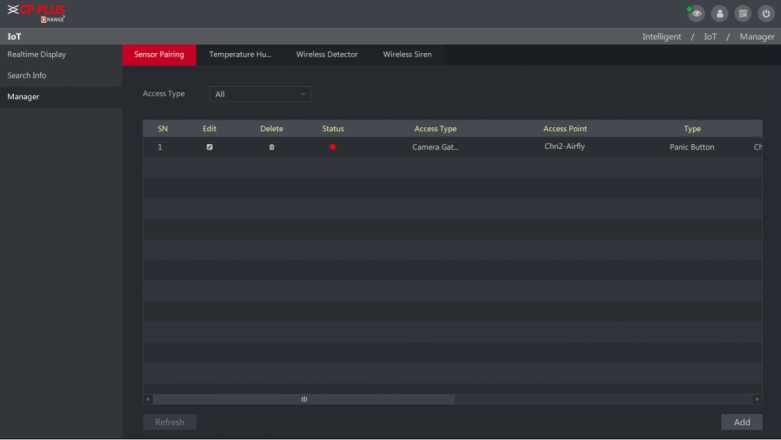
Figure 5-144
NOTE
Only the camera with gateway supports this function.
Step 1 Select Main Menu ■> Intelligent^ IoT ^ Manager ^ Sensor Pairing.
The Sensor Pairing interface is displayed.See Figure 5-145.
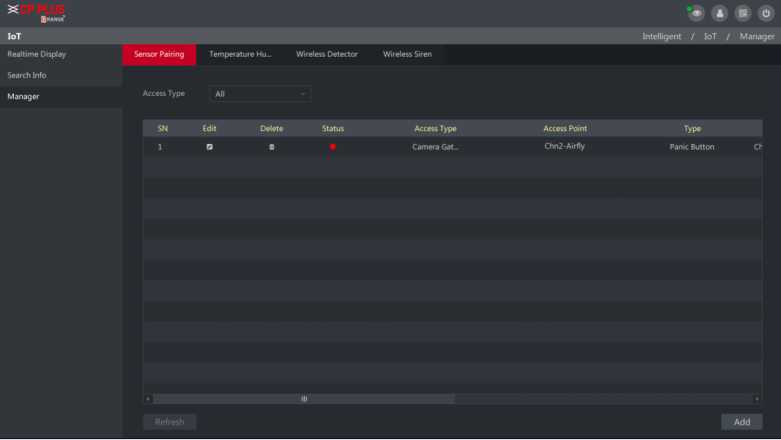
Figure 5-145
Step 2 In the Access Type list, select Camera Gateway.
Step 3 In the Channel list, select the channel that is connected to the camera.
Step 4 Click Add.
The Add interface is displayed. See Figure 5-146.
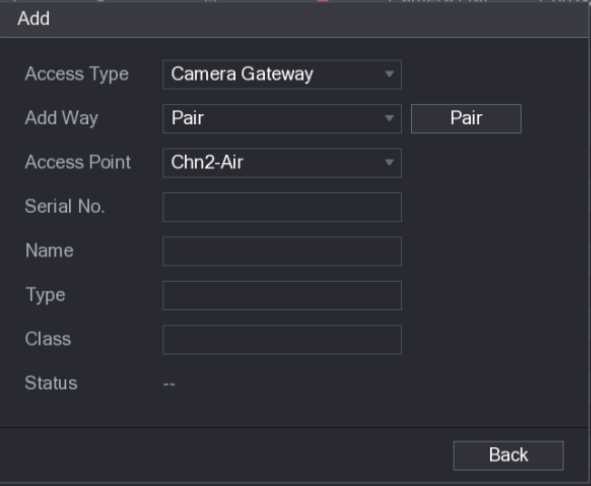
Figure 5-146
The Device starts pairing with the sensor.
After pairing is completed, see Figure 5-147.
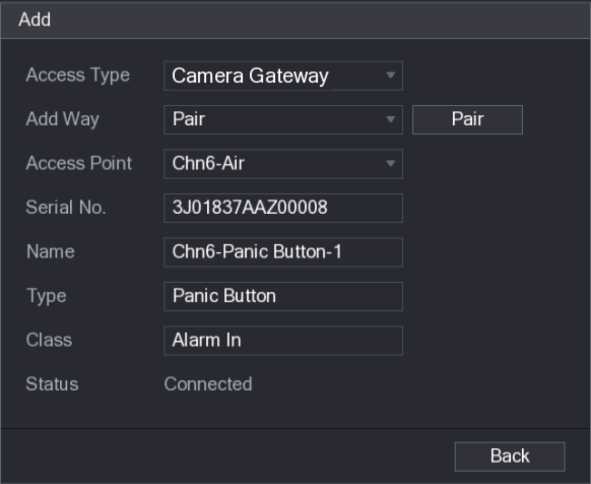
Figure 5-147
Step 6 Click Back to exit the pairing interface.
The added sensor information is displayed. See Figure 5-148. Q NOTE
Click
![]()
to modify the sensor name; click
![]()
to delete sensor information.
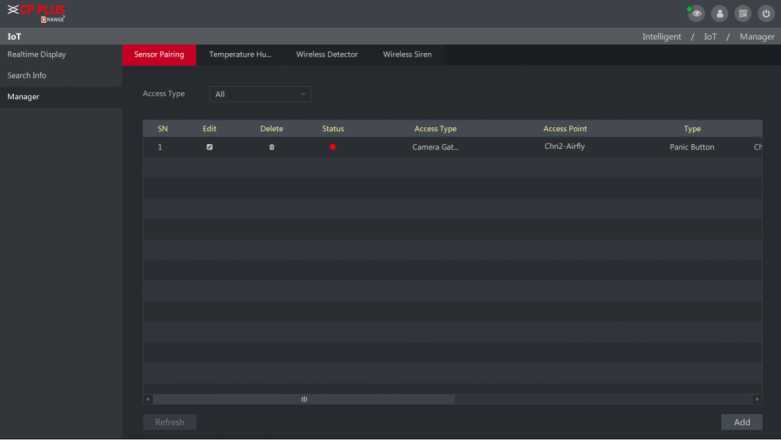
Figure 5-148
5.11.1.3 Configuring Alarm Linkage
Step 1 Select Main Menu ^ Intelligent^ IoT ^ Manager ^ Wireless Detector.
The Wireless Detector interface is displayed.See Figure 5-149.
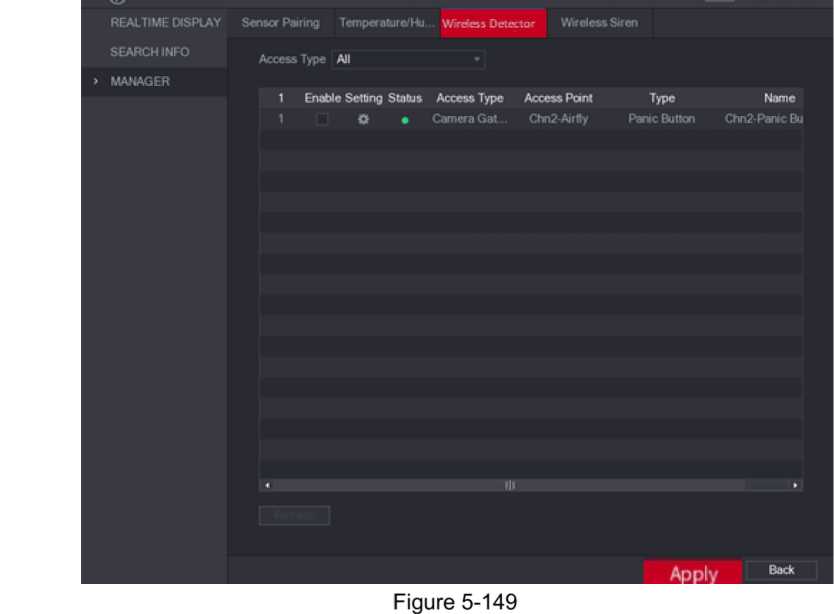
Step 2 In the Access Type list, select USB, Camera, or All.
Step 3 Click
![]()
The Setting interface is displayed. See Figure 5-139.
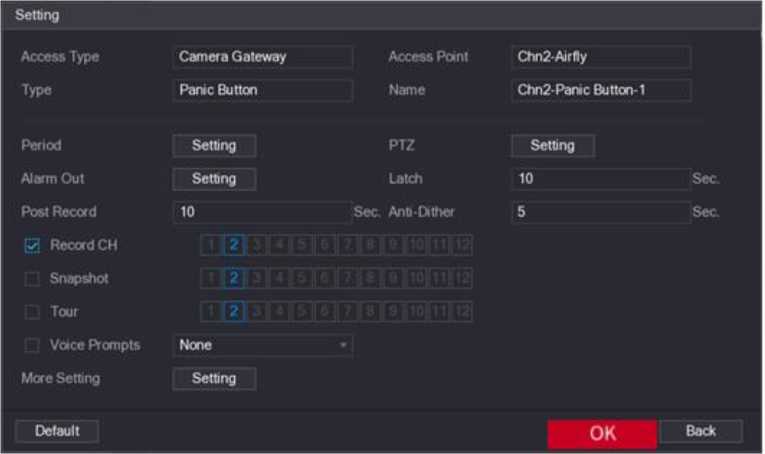
Figure 5-150
Step 4 Configure the settings for alarm linkage. For details, see Table 5-48.
| Parameter | Description |
| Name | Enter the customized alarm name. |
| Period | Click Setting to display setting interface.
Define a period during which the motion detection is active. For details, see “Setting Motion Detection Period” section in “5.10.1.1 Configuring Motion Detect Settings.“ |
| PTZ | Click Setting to display the PTZ interface.
Enable PTZ activation function. For each PTZ camera, select the preset that you want to be called when an alarm event occurs. |
| Alarm Out | Click Setting to display setting interface.
connected to the selected output port.
alarm box.
connected by USB gateway or camera gateway. |
| Latch | Set a length of time for the Device to delay turning off alarm after the external alarm is cancelled. The value ranges from 0 seconds to 300 seconds, and the default value is 10 seconds. |
| Post Record | Set a length of time for the Device to delay turning off recording after the alarm is cancelled. The value ranges from 10 seconds to 300 seconds, and the default value is 10 seconds. |
| Anti-Dither | Configure the event detection lasting time. The system records only one event during this period. The value ranges from 5 seconds to 600 seconds. |
| Parameter | Description |
| Record Channel | Select the channel(s) that you want to record. The selected channel(s) starts recording after an alarm event occurs.
CQ NOTE |
| The recording for alarm and auto snapshot must be enabled. For | |
| details, see “5.1.4.9 Configuring Recorded Video Storage Schedule” | |
| and “5.9.1 Enabling Record Control.“ | |
| Select the Snapshot check box to take a snapshot of the selected channel.
CD NOTE |
|
| Snapshot | To use this function, make sure the following settings are configured: |
| • The snapshot function is enabled for motion detect alarms in Main | |
| Menu ^ Storage ^ Schedule ^ Snapshot. | |
| • Select Main Menu ^ Camera ^ Encode ^ Snapshot, in the | |
| Mode list, select Event. | |
| Tour | Select the Tour check box to enable a tour of the selected channels. nn. note |
| To use this function, make sure the tour is enabled and configured in | |
| Main Menu ^ Display ^ TOUR. | |
| Voice Prompts | Select to enable audio broadcast/voice prompts in response to a local alarm event. |
| More Setting |
pop-up message in your local host PC.
Device.
an alarm event occurs, the video output port outputs the settings configured in “Main Menu ^ Display ^ TOUR.” CQ NOTE |
| Not all models support this function.
• Send Email: Enable the system to send an email notification when an alarm event occurs. CQ NOTE |
|
| To use this function, make sure the email function is enabled in Main | |
| Menu ^ Network ^ EMAIL.
• Log: Select the check box to enable the Device to record a local alarm log |
Table 5-48
Step 5 Click OK to save the settings.
Step 6 On the Wireless Detector interface, click Apply to complete the settings.
You can view, search and export the temperature and humidity data of camera with such sensors and configure the alarm event settings.
To use this function, please make sure there is at least one camera with temperature and humidity sensor has been connected to the Device.
You should enable the IoT function the first time when you enter this interface.
Step 1 On the main menu^Intelligent, click loT ^ Manager ^ Temperature/Humidity.
The Temperature/Humidity interface is displayed. See Figure 5-151.
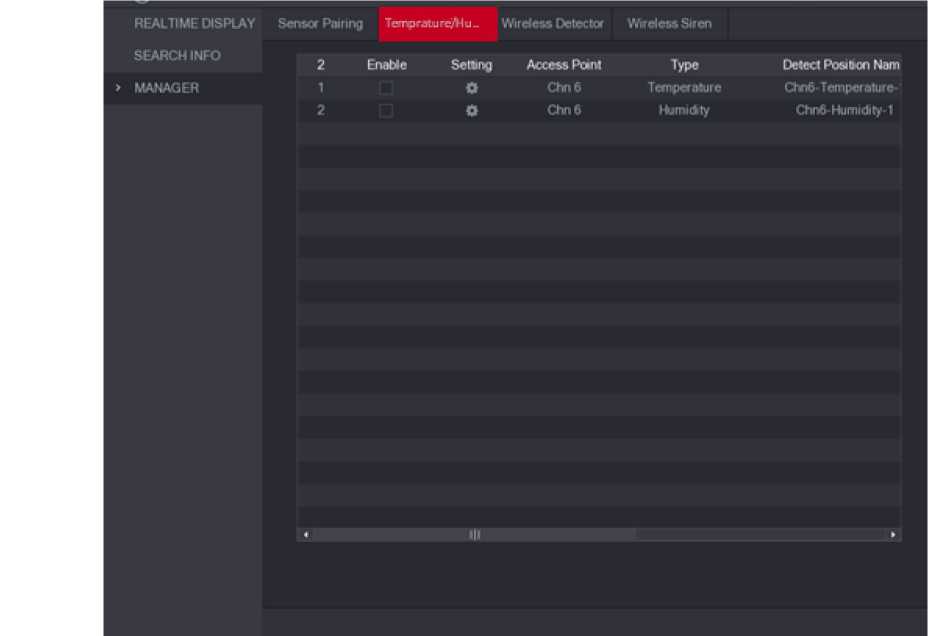
Figure 5-151
Step 2 Select the Enable check boxes to enable IoT function. See Figure 5-152.
REALTIME DISPLAY
SEARCH INFO
> MANAGER
Tempraturev^u- Wirde» Detector VrSrdc» Siren
| 2 | Enable | Setting | Access Point | l?Pi | Detect PosOon Nam |
| 1 | a | Ch»6 | Ternipaatiire | Chn6 Temperature |
Sçnjçr Piiirmg
![]()
Figure 5-152
The Device starts detecting the temperature and humidity data from the camera and display on the Realtime Display interface.
You can view the temperature and humidity data on the Realtime Display interface after the IoT function is enabled.
In the Refresh Interval box, select data refresh interval. For example, you can select 5 Sec.
You can also display the temperature and humidity data in graphical way by selecting the Display Graph check box to. See Figure 5-153 for humidity data in graphical way.
> REALTIME DISPLAY
SEARCH INFO
MANAGER
| r+eh’«fi interval | 5Sk | |||
| tiifXay Gras* | Accth Rani dm 6 | tn*
Trtfnpcf dlijf f |
Oawcr Roa bon Na*ii Chnfi-lenipcf alurc-1 | Curr enl Vai u are |
| dify | Ghnfrltaiirftï 1 | * m |
Témçièr Mui fr Ciiarl Humdiity Chart
<kRH|

C*e»f
Figure 5-153
![]()
Click Clear to delete the data.
You can export the temperature and humidity data in .BMP format. Take exporting humidity data as an example.
Step 1 Prepare a USB device and plug it into the Device.
Step 2 On the Realtime Display interface, click the Humidity tab. See Figure 5-154
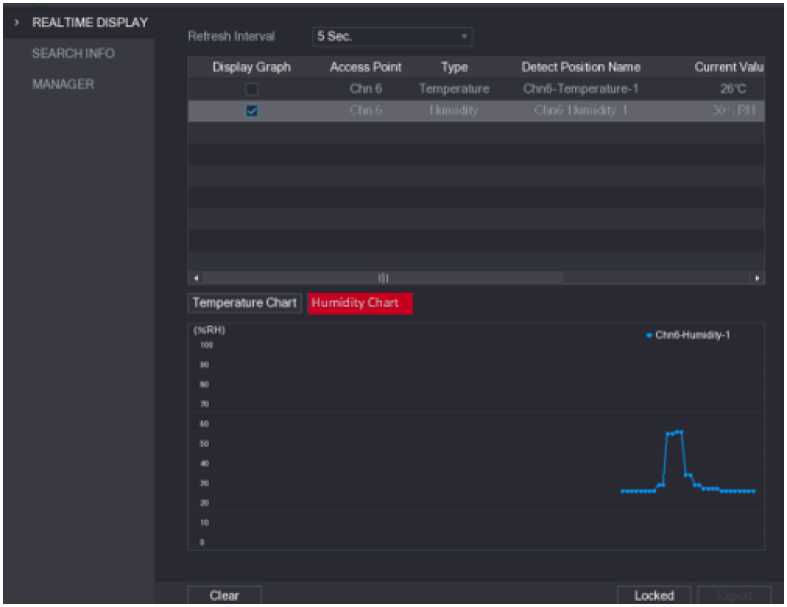
Figure 5-154
Step 3 Click Locked to lock the data.
The export button is enabled.
Step 4 Click Export. The system starts exporting the data.
After exporting is finished, a Message dialog box is displayed.
Step 5 Click OK.
You can find the exported data on your USB device.
You can configure alarm linkage settings for temperature and humidity data.
-
-
-
-
- Configuring Alarm Linkage for Temperature Data
-
-
-
Step 1 On the main interface of Intelligent, click IoT ^ Manager ^ Temperature/Humidity. The Temperature/Humidity interface is displayed. See Figure 5-155.
REALTIME DISPLAY
SEARCH INFO
> MANAGER
Tempraturev^u- Wirde» Detector VrSrdc» Siren
| 2 | Enable | Setting | Access Point | W | Delect Position Nam |
| 1 | a | Ch»6 | Tern ¡para Cure | Chn6 Temperature |
Sçnjçr Pairing
![]()
Figure 5-155
![]()
Step 2 On the temperature information line, click
The Setting interface is displayed. See Figure 5-156.
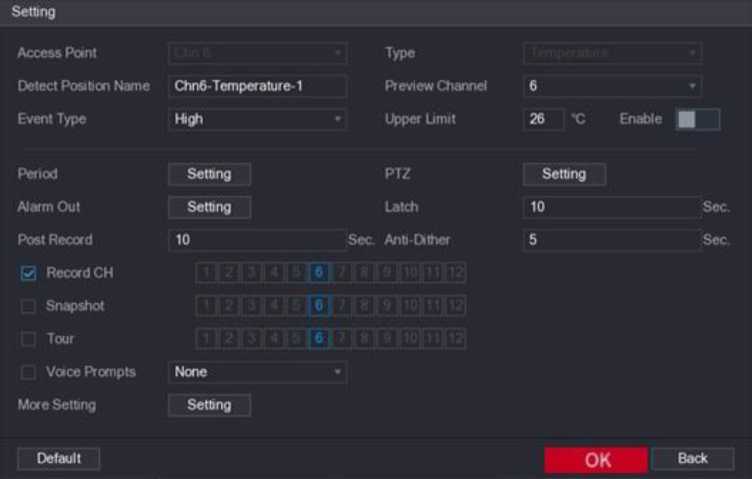
Figure 5-156
Step 3 Configure the settings for alarm linkage. See Table 5-49.
| Parameter | Description |
| Access Point | Indicates the channel that the camera is connected to. |
| Type | Temperature by default. |
| Detect Position
Name |
Set the detect position name. |
| Parameter | Description |
| Preview Channel | Select the channel that you want to preview to help monitor the channel of access point. This channel could be the channel of access point or any other channels according to your actual situation. |
| Event Type | Select event type as High or Low, and set the upper and low temperature limit respectively. For example, select event type as High and set upper limit as 28, the alarm occurs when the temperature reaches 28 (‘. |
| Upper Limit | |
| Enable | Enable the alarm function. |
| Period | Define a period during which the alarm setting is active. For more information about setting the period, see “5.10.1.1 Configuring Motion Detect Settings.“ |
| Alarm Out | Click Setting to display setting interface.
devices connected to the selected output port.
connected alarm box.
connected by USB gateway or camera gateway. |
| PTZ | Enable PTZ activation function.
Click Setting to display the PTZ interface. For each PTZ camera, select the preset, tour, or pattern that you want to be called when an alarm event occurs. |
| Latch | Set a length of time for the Device to delay turning off alarm after the external alarm is cancelled. The value ranges from 0 seconds to 300 seconds, and the default value is 10 seconds. If you enter 0, there will be no delay. |
| Post Record | Set a length of time for the Device to delay turning off recording after the alarm is cancelled. The value ranges from 10 seconds to 300 seconds, and the default value is 10 seconds. |
| Anti-Dither | Configure the event detection lasting time. The system records only one event during this period. The value ranges from 5 seconds to 300 seconds. |
| Snapshot | Select the check box to take a snapshot of the selected channel. CD NOTE
To use this function, make sure the snapshot is enabled motion detect alarms in Main Menu ■+ Storage ■+ Schedule ■+ Snapshot. |
| Record CH | Select the channel(s) that you want to record. The selected channel(s) starts recording after an alarm occurs.
CD NOTE The recording for IoT alarms and auto recording function must be enabled. For details, see “5.1.4.9 Configuring Recorded Video Storage Schedule” and “5.9.1 Enabling Record Control.“ |
| Parameter | Description |
| Tour | Select the check box to enable a tour of the selected channels.
CP NOTE |
| To use this function, make sure the tour is enabled and configured | |
| in Main Menu ^ Display •+ TOUR. | |
| Voice Prompts | Select to enable audio broadcast/voice prompts in response to a temperature alarm event. |
| More Setting |
enable a pop-up message in your local host PC.
Device.
When an alarm event occurs, the video output port outputs the settings configured in “Main Menu ^ Display ^ TOUR.” CP NOTE |
| Not all models support this function.
• Send Email: Enable the system to send an email notification when an alarm event occurs. CP NOTE |
|
| To use this function, make sure the email function is enabled in | |
| Main Menu ■> Network •+ EMAIL.
• Log: Select the check box to enable the Device to record a local alarm log |
Table 5-49
Step 4 Click Save to save the settings.
You can configure the alarm event by setting the humidity data.
Step 1 On the main interface of Intelligent, click IoT ■+ Manager ^ Temperature/Humidity.
The Temperature/Humidity interface is displayed. See Figure 5-157.
REALTIME DISPLAY
SEARCH INFO
> MANAGER
| Senser Pairing | Tempratu rcAI u_ | Wirde» Detector | Wir el ess Siren | ||
| 2 1 | E natte
s |
Sating
<5 |
Accession!
Chn6 |
Temperature | Deled Position Nam Chn6-Temperature |
![]()
Figure 5-157
![]()
Step 2 On the humidity information line, click
The Setting interface is displayed. See Figure 5-158.
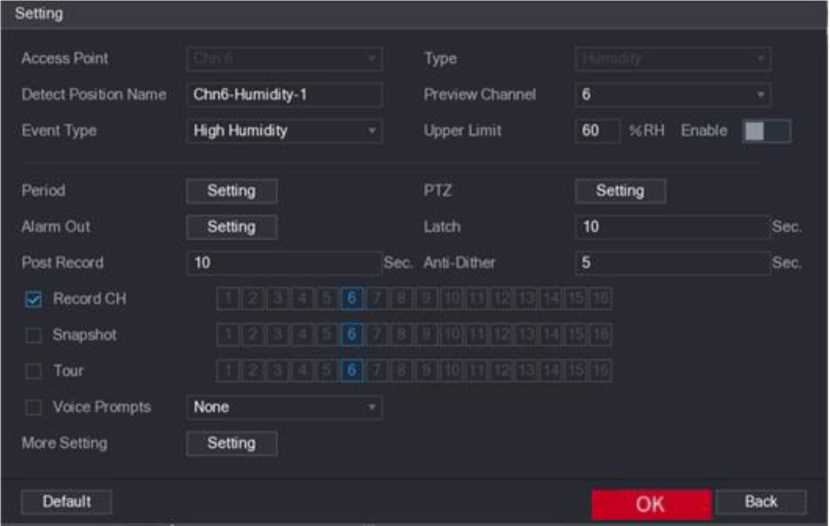
Figure 5-158
Step 3 Configure the settings for the following parameters. See Table 5-50.
| Parameter | Description |
| Access Point | Indicates the channel that the camera is connected to. |
| Type | Humidity by default. |
| Detect Position
Name |
Set the detect position name. |
| Parameter | Description |
| Preview Channel | Select the channel that you want to preview to help monitor the channel of access point. This channel could be the channel of access point or any other channels according to your actual situation. |
| Event Type | Select event type as High Humidity or Low Humidity, and set the upper and low humidity limit respectively. For example, select event type as High Humidity and set upper limit as 60, the alarm occurs when the humidity reaches 60%RH. |
| Upper Limit | |
| Enable | Enable the alarm function. |
| Period | Define a period during which the alarm setting is active. For more information about setting the period, see “5.10.1.1 Configuring Motion Detect Settings.“ |
| Alarm Out | Click Setting to display setting interface.
devices connected to the selected output port.
connected alarm box.
connected by USB gateway or camera gateway. |
| PTZ | Enable PTZ activation function.
Click Setting to display the PTZ interface. For each PTZ camera, select the preset, tour, or pattern that you want to be called when an alarm event occurs. |
| Latch | Set a length of time for the Device to delay turning off alarm after the external alarm is cancelled. The value ranges from 0 seconds to 300 seconds, and the default value is 10 seconds. If you enter 0, there will be no delay. |
| Post Record | Set a length of time for the Device to delay turning off recording after the alarm is cancelled. The value ranges from 10 seconds to 300 seconds, and the default value is 10 seconds. |
| Anti-Dither | Configure the event detection lasting time. The system records only one event during this period. The value ranges from 5 seconds to 300 seconds. |
| Snapshot | Select the check box to take a snapshot of the selected channel. CD NOTE
To use this function, make sure the snapshot is enabled motion detect alarms in Main Menu ■+ Storage ■+ Schedule ■+ Snapshot. |
| Record CH | Select the channel(s) that you want to record. The selected channel(s) starts recording after an alarm occurs.
CD NOTE The recording for IoT alarms and auto recording function must be enabled. For details, see “5.1.4.9 Configuring Recorded Video Storage Schedule” and “5.9.1 Enabling Record Control.“ |
| Parameter | Description |
| Tour | Select the check box to enable a tour of the selected channels.
CP NOTE |
| To use this function, make sure the tour is enabled and configured | |
| in Main Menu ^ Display •+ TOUR. | |
| Voice Prompts | Select to enable audio broadcast/voice prompts in response to a temperature alarm event. |
| More Setting |
enable a pop-up message in your local host PC.
Device.
When an alarm event occurs, the video output port outputs the settings configured in “Main Menu ^ Display ^ TOUR.” CP NOTE |
| Not all models support this function.
• Send Email: Enable the system to send an email notification when an alarm event occurs. CP NOTE |
|
| To use this function, make sure the email function is enabled in | |
| Main Menu ■> Network •+ EMAIL.
• Log: Select the check box to enable the Device to record a local alarm log |
Table 5-50
Step 4 Click Save to save the settings.
You can search and backup all your IoT data.
To back up the data, you should prepare a USB device and plug it into the Device.
Step 1 On the main interface of Intelligent, click IoT ^ SEARCH INFO. See Figure 5-159.
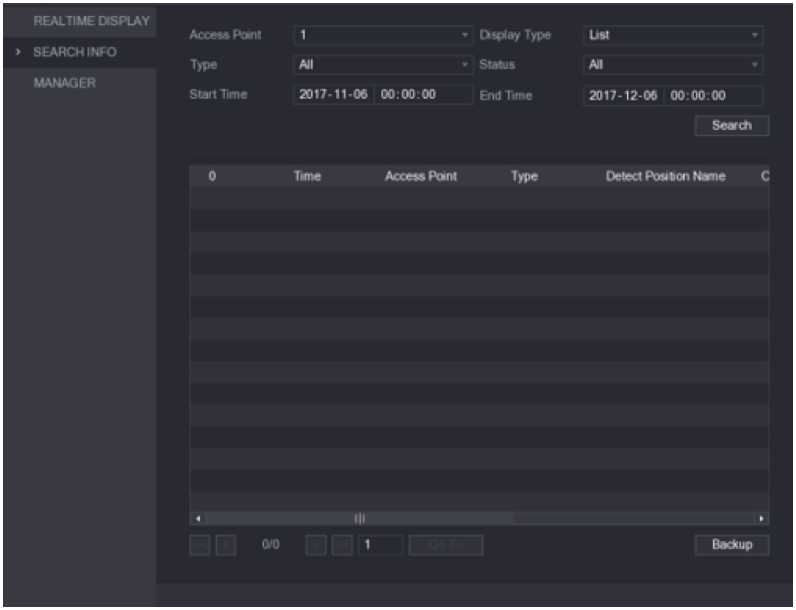
Figure 5-159
Step 2 Configure the parameters settings. See Table 5-51.
| Parameter | Description |
| Access Point | Indicates the channel that the camera is connected to. |
| Display Type | In the Display Type list, select List or Graph. |
| Type | Select the information type that you want to search. You can select
Humidity or Temperature. |
| Status | Select the information state that you want to search.
This option is available when you select List in the Display Type list. |
| Start Time | Enter the start time and end time for the information that you want to search. |
Table 5-51
Step 3 Click Search. The system starts search according to your parameters settings.
After searching is finished, the result displays.
- For the data displayed in list, see Figure 5-160.
NOTE
Click Go To to switch result pages.
| 1 | UM | |||
| All | M | |||
| wtTwne | 2017 11 06 | 00:0000 E | 2017-12-06 00 00 00 | |
| Search | ||||
| 120 | lime | Accew Pant | Type | Detect Paaton Name • |
| MI-0721 13 58 | Ovi t | Ctmt liznwStv 1 | ||
| * | ||||
| 4 201 | 1 1147 21 14 00
M147 71 14 09 MI-0721 14 10 Mt 47 21 14 14 Mi-07 21 14 23 F It 0721 1004 1 11 07 21.16 07 MI-0721 10 17 Ml 47 21 16 26 MI-07 21 16 77 1-1147 21 16 36 |
Kim*aty | • | |
| 1/ | 85 > » 1 | Go To | Backup |
Figure 5-160
- For the data displayed in graph, see Figure 5-161.
> SEARCI
Humodit/
Stall Ti
2017-11-06 00:00.00′
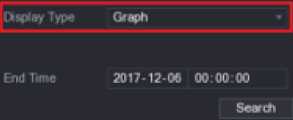
Ml
Cbnl HuMiny 1
Figure 5-161
Step 4 Click Backup. The system starts exporting the data.
After exporting is finished, a Message dialog box is displayed.
Step 5 Click OK.
You can find the exported data on your USB device.
5.11.3 Configuring Wireless Siren
You can connect the wireless siren to the Device, when there is an alarm event activated on the Device, the wireless siren generates alarms.
Step 1 Select Main Menu ^ Intelligent ^ IoT > Manager > Wireless Siren.
The Wireless Siren interface is displayed.See Figure 5-162Figure 5-140.
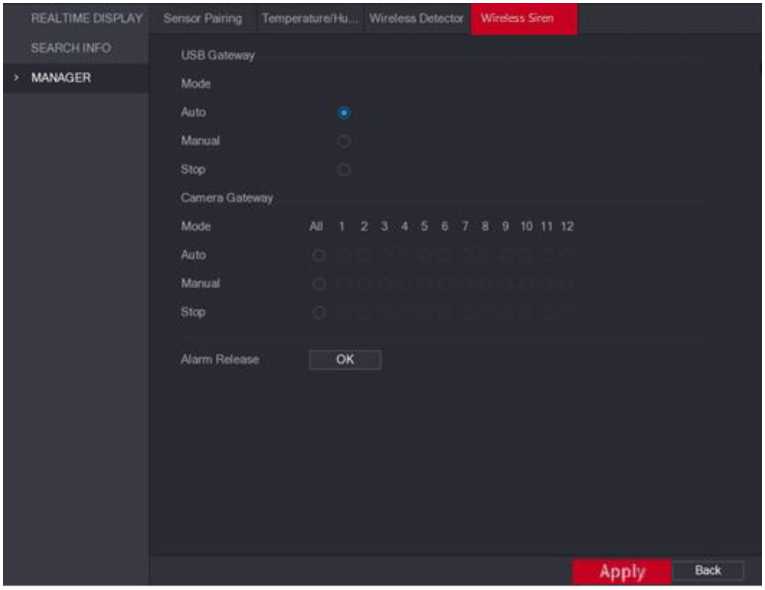
Figure 5-162
Step 2 Configure the settings for the wireless alarm output. For details, see Table 5-52.Table
| Parameter | Description |
| USB Gateway, Camera Gateway |
for wireless siren is enabled for specific events. For example, if you want to enable the alarm output through wireless siren for motion detection, see “Alarm Output” parameter in Table 534.
|
| Alarm Release | Click OK to clear all alarm output status of wireless siren. |
Table 5-52
Step 3 Click Apply to save the settings.
You can connect the Device to the POS (Point of Sale) machine and receive the information from it. This function applies to the scenarios such as supermarket POS machine. After connection is established, the Device can access the POS information and display the overlaid text in the channel window.
CD NOTE
Playing POS information in the local playback and viewing the POS information in the live view screen only support single-channel mode. Displaying monitoring screen and playing back in the web support multi-channel mode.
Step 1 Select Main Menu ■> Intelligent •+ POS ^ POS SEARCH.
The POS SEARCH interface is displayed.See Figure 5-163.
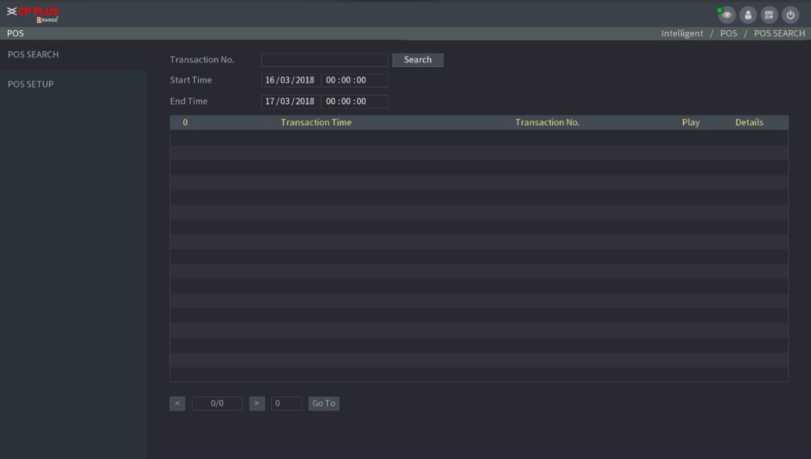
Figure 5-163
Step 2 In the Transaction No. list, enter the transaction number on your receipt printed out by POS machine.
Step 3 In the Start Time box and End Time box, enter the time period that you want to search the POS transaction information.
Step 4 Click Search.
The searched transaction results display in the table.
Step 1 Select Main Menu ■+ Intelligent^ POS ^ POS SETUP.
The POS SETUP interface is displayed.See Figure 5-164.
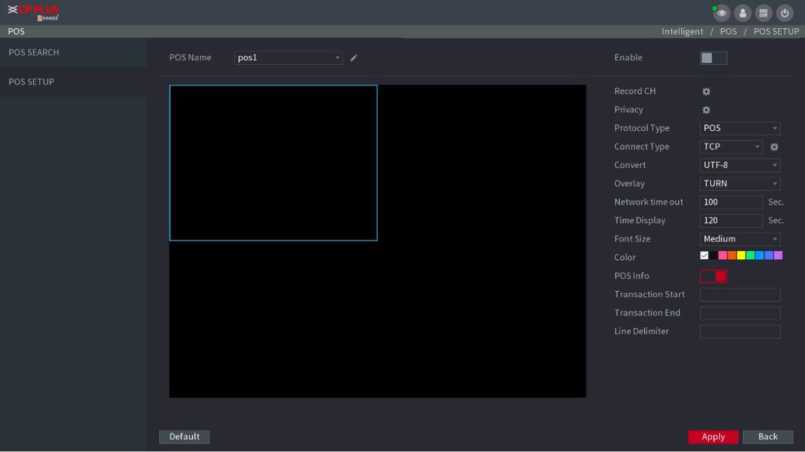
Figure 5-164
Step 2 Configure the settings for the POS parameters. See Table 5-53.
| Parameter | Description |
| POS Name | In the POS Name list, select the POS machine that you want to configure settings for. Click ^3 to modify the POS name. CQ NOTE
The POS name supports 21 Chinese characters or 63 English characters. |
| Enable | Enable the POS function. |
| Record CH | Select the channel(s) that you want to record. The selected channel(s) starts recording after an alarm occurs.
CQ NOTE The recording for POS alarms and auto recording function must be enabled. For details, see “5.1.4.9 Configuring Recorded Video Storage Schedule” and “5.9.1 Enabling Record Control.“ |
| Privacy Setup | Enter the privacy content. |
| Protocol Type | Select POS by default. Different machine corresponds to different protocol. |
| Connect Type | In the Connect Type list, select the connection protocol type.
Click ^3, the IP Address interface is displayed. In the Source IP box, enter the IP address (the machine that is connected to the Device) that sends messages. |
| Convert | Select a character encoding mode. |
| Overlay | In the Overlay list, Select Turn or ROLL. |
| Network time out | When the network is not working correctly and cannot be recovered after the entered timeout limit, the POS information will not display normally. After the network is recovered, the latest POS information will be displayed. |
| Time Display | Enter the time that how long you want to keep the POS information displaying. For example, enter 5, the POS information disappear from the screen after 5 seconds. |
| Font Size | In the Font Size list, select Small, Medium, or Big as the text size of POS information |
| COLOR | In the color bar, click to select the color for the text size of POS information. |
| POS Info | Enable the POS Info function, the POS information displays in the live view screen. |
| Transaction Start | Enter the transaction start character and end character. |
| Transaction End | |
| Line Delimiter | Enter the line delimiter that you want to use. |
Table 5-53
Step 3 Click Apply to complete the settings.
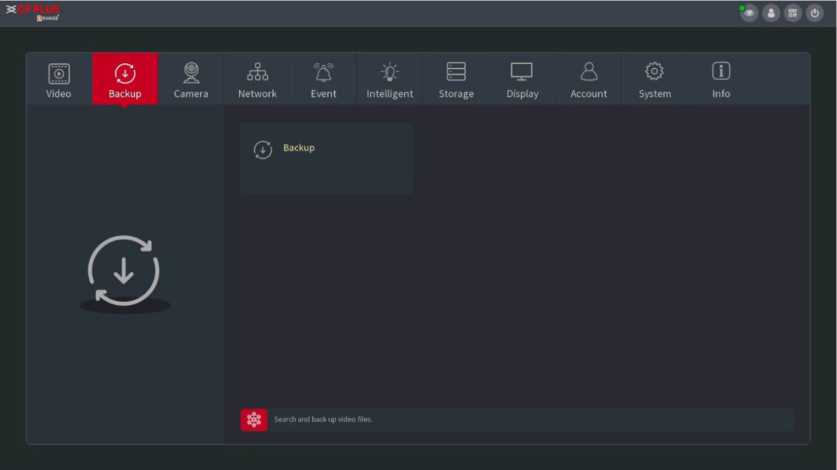
When you inset a USB storage device into the USB port of the Device, the Device detects the USB storage device and pops up “Find USB device” interface, which provides you a shortcut to perform backup and upgrading operations. See Figure 5-165.
For details, see “5.13.2 Backing up Files”, “5.19.2 Viewing Log Information”, “5.18.5 Exporting and Importing System Settings”, and “5.18.7 Upgrading the Device.”
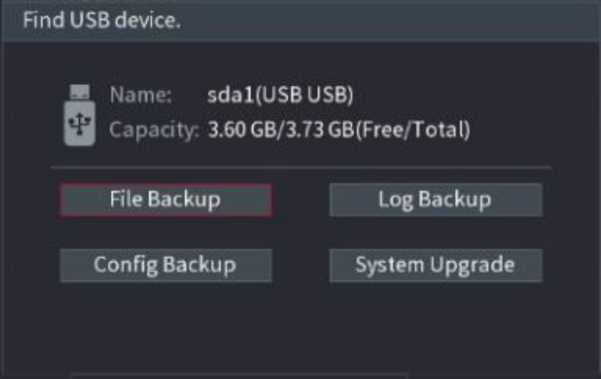
Figure 5-165
You can back up the recorded videos and snapshots.
Step 1 Select Main Menu ^ BACKUP.
The BACKUP interface is displayed.See Figure 5-166.
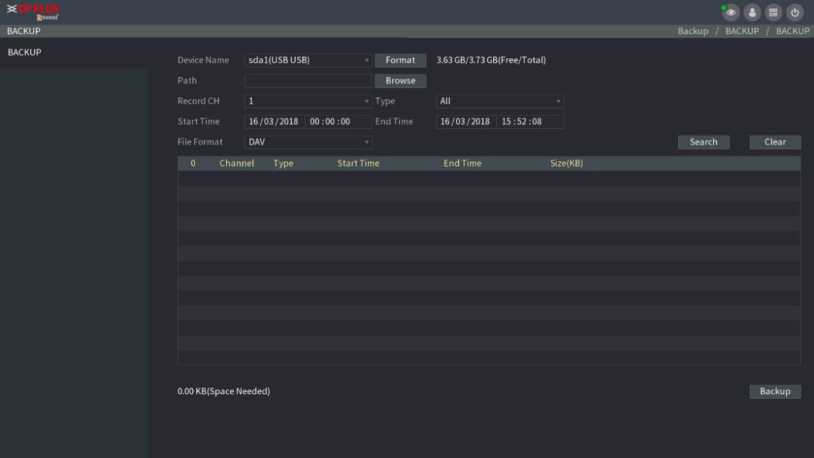
Figure 5-166
Step 2 Configure the settings for the backup parameters. See Table 5-54.
Table 5-54
Step 3 Click Search to search the files that meet the configured settings.
The searched results will display in the table.
Step 4 Select the files that you want to back up.
Step 5 Click Backup to back up the selected files to the configured path. Q NOTE
Click Clear to remove all the searched results.
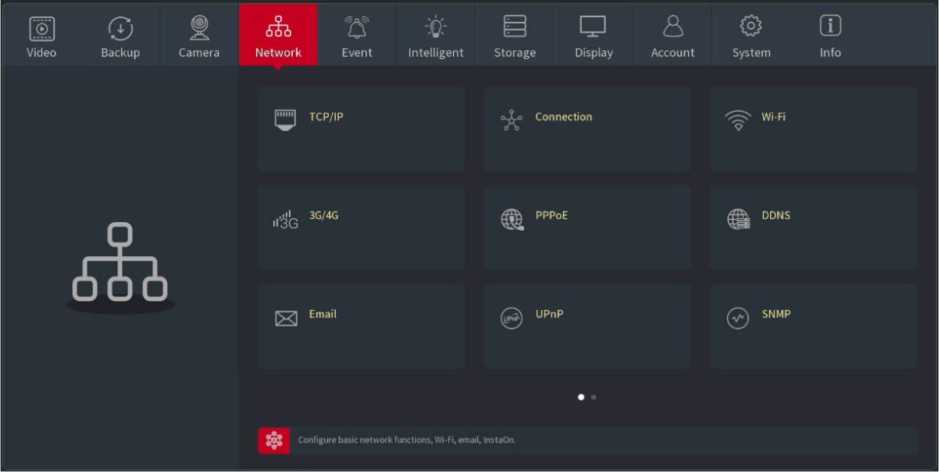
You can ensure the network interworking between the Device and other devices through configuring the network settings.
You can configure the settings for the Device such as IP address, DNS according to the networking plan.
Select Main Menu ^ Network ^ TCP/IP, the TCP/IP interface is displayed. See Figure 5-167.
For details about parameter settings, see “5.1.4.4 Configuring Network Settings.”
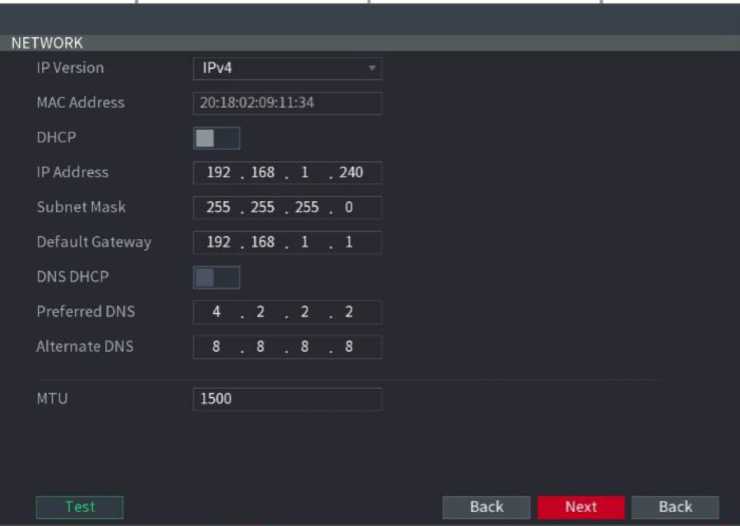
Figure 5-167
You can configure the maximum connection accessing the Device from Client such as WEB, Platform, and Mobile Phone and configure each port settings.
Step 1 Select Main Menu ^ Network ^ CONNECTION.
The CONNECTION interface is displayed.See Figure 5-168.
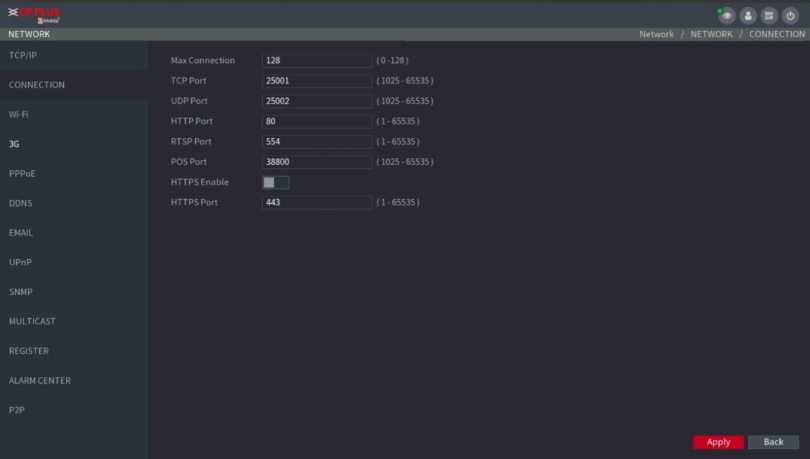
Figure 5-168
Step 2 Configure the settings for the connection parameters. See Table 5-55. Q2 NOTE
The connection parameters except Max Connection cannot take effects until the Device has been restarted.
Table 5-55
Step 3 Click Apply to complete the settings.
You can make wireless connection between the Device and the other devices in the same network through Wi-Fi settings, facilitating the devices connection and mobility.
NOTE
Only the Device with Wi-Fi module supports this function.
Step 1 Select Main Menu ■> Network ■> Wi-Fi.
The Wi-Fi interface is displayed.See Figure 5-169.
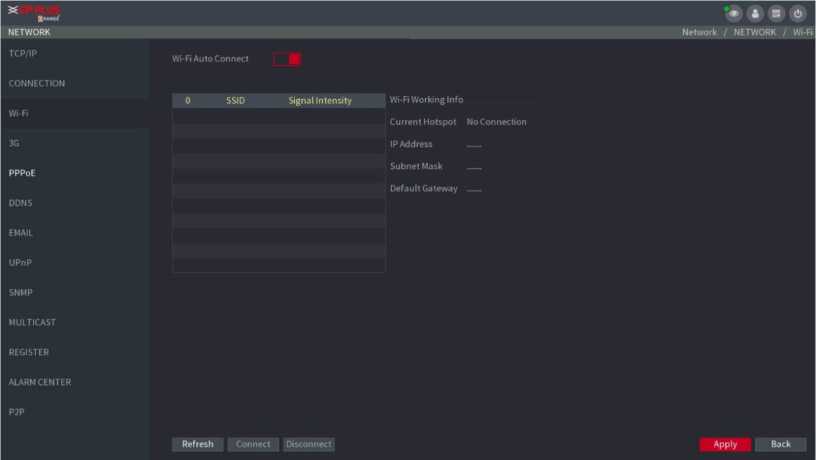
Figure 5-169
Step 2 Configure the settings for the Wi-Fi connection parameters. See Table 5-56.
Table 5-56
Step 3 Click Apply to complete the settings.
After the Device is connected to a Wi-Fi hotspot, in the Wi-Fi Working Info area, the current hotspot, IP address, subnet mask, and default gateway are displayed.
PPPoE is another way for the Device to access the network. You can establish network connection by configuring PPPoE settings to give the Device a dynamic IP address in the WAN. To use this function, firstly you need to obtain the user name and password from the Internet Service Provider.
Step 1 Select Main Menu ^ Network ^ PPPoE.
The PPPoE interface is displayed. See Figure 5-170.
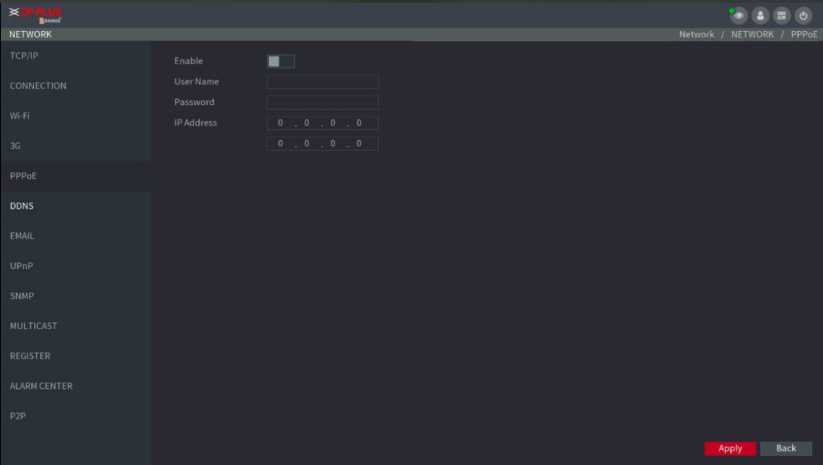
Figure 5-170
Step 2 Enable the PPPoE function.
Step 3 In the User Name box and Password box, enter the user name and password accordingly provided by the Internet Service Provider.
Step 4 Click Apply to complete the settings.
The system pops up a message to indicate the successfully saved. The IP address appears on the PPPoE interface. You can use this IP address to access the Device. CD NOTE
When the PPPoE function is enabled, the IP address on the TCP/IP interface cannot be modified.
When the IP address of the Device changes frequently, the DDNS function can dynamically refresh the correspondence between the domain on DNS and the IP address, ensuring you access the Device by using the domain.
Please confirm if the Device supports the DDNS Type and log in the website provided by the DDNS service provider to register the information such as domain from PC located in the WAN.
- If DDNS belongs to Quick DDNS type, domain registration is not needed.
- If DDNS belongs to other type, you need to login the DDNS website to register the information such as user name, password, and domain name.
CD NOTE
After you have registered and logged in the DDNS website successfully, you can view the information of all the connected devices under this user name.
Step 1 Select Main Menu ■> Network ^ DDNS.
The DDNS interface is displayed. See Figure 5-171.
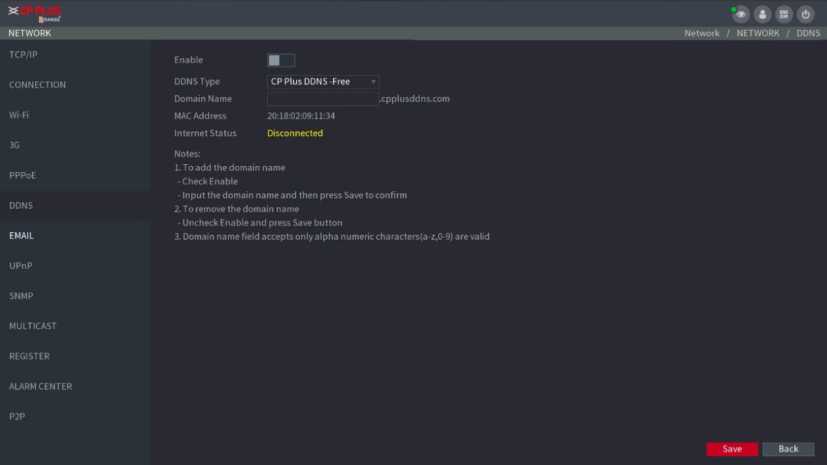
Figure 5-171
Step 2 Configure the settings for the DDNS parameters. • DDNS type. See Table 5-57.
Table 5-57
Step 3 Click Apply to complete the settings.
Enter the domain name in the browser on your PC, and then press Enter.
If the web interface of the Device is displayed, the configuration is successful. If not, the configuration is failed.
You can configure the email settings to enable the system to send the email as a notification when there is an alarm event occurs.
Step 1 Select Main Menu ^ Network ^ EMAIL.
The EMAIL interface is displayed.See Figure 5-172.
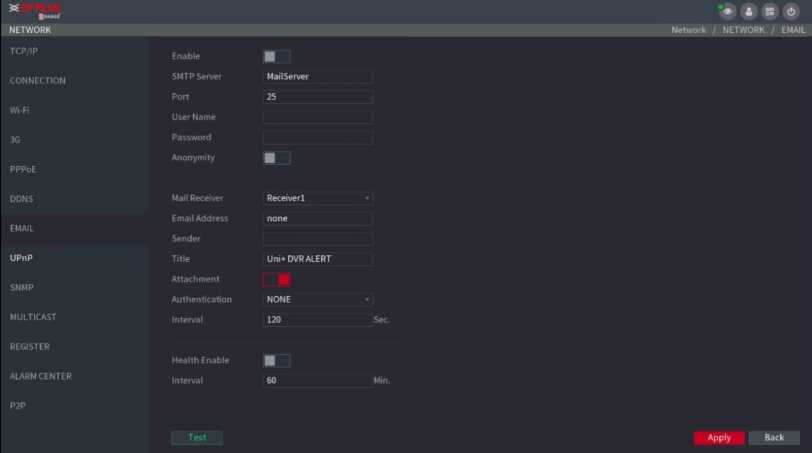
![]()
Step 2 Configure the settings for the email parameters. See Table 5-58.
Table 5-58
Step 3 Click Apply to complete the settings.
You can map the relationship between the LAN and the WAN to access the Device on the LAN through the IP address on the WAN.
- Login the router to set the WAN port to enable the IP address to connect into the WAN.
- Enable the UPnP function at the router.
- Connect the Device with the LAN port on the router to connect into the LAN.
- Select Main Menu ^ Network ^ TCP/IP, configure the IP address into the router IP
address range, or enable the DHCP function to obtain an IP address automatically.
Step 1 Select Main Menu ■> Network ^ UPnP.
The UPnP interface is displayed.See Figure 5-173.
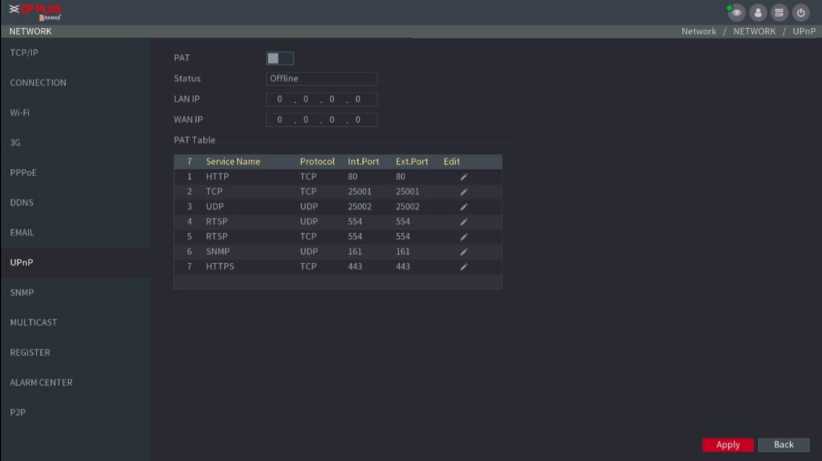
Figure 5-173
Step 2 Configure the settings for the UPnP parameters. See Table 5-59.
| Parameter | Description | |||||||||
| PAT | Enable the UPnP function. | |||||||||
| Status | Indicates the status of UPnP function.
* Offline: Failed. • Online: Succeeded. |
|||||||||
| LAN IP | Enter IP address of router on the LAN.
Cfl NOTE |
|||||||||
| After mapping succeeded, the system obtains IP address | ||||||||||
| automatically without performing any configurations. | ||||||||||
| WAN IP | Enter IP address of router on the WAN.
LJ NOTE |
|||||||||
| After mapping succeeded, the system obtains IP address | ||||||||||
| automatically without performing any configurations. | ||||||||||
The settings in PAT table correspond to the UPnP PAT table on the router.
Wl NOTE |
||||||||||
| • | To avoid the conflict, when setting the external port, try to use | |||||||||
| the ports from 1024 through 5000 and avoid popular ports | ||||||||||
| PAT Table | from 1 through 255 and system ports from 256 through 1023. | |||||||||
| • | When there are several devices in the LAN, please | |||||||||
| reasonably arrange the ports mapping to avoid mapping to the same external port. | ||||||||||
| • | When establishing a mapping relationship, please ensure the | |||||||||
| mapping ports are not occupied or limited. | ||||||||||
| • | The internal and external ports of TCP and UDP must be the | |||||||||
| same and cannot be modified. | ||||||||||
| • | Click ^3 to modify the external port. | |||||||||
Table 5-59
Step 3 Click Apply to complete the settings.
In the browser, enter http://WAN IP: External IP port. You can visit the LAN Device.
. . NOTE
Not all models support this function.
You can connect the Device with some software such as MIB Builder and MG-SOFT MIB Browser to manage and control the Device from the software.
- Install the software that can manage and control the SNMP, such as MIB Builder and MGSOFT MIB Browser
- Obtain the MIB files that correspond to the current version from the technical support.
Step 1 Select Main Menu ■> Network ^ SNMP.
The SNMP interface is displayed. See Figure 5-174.
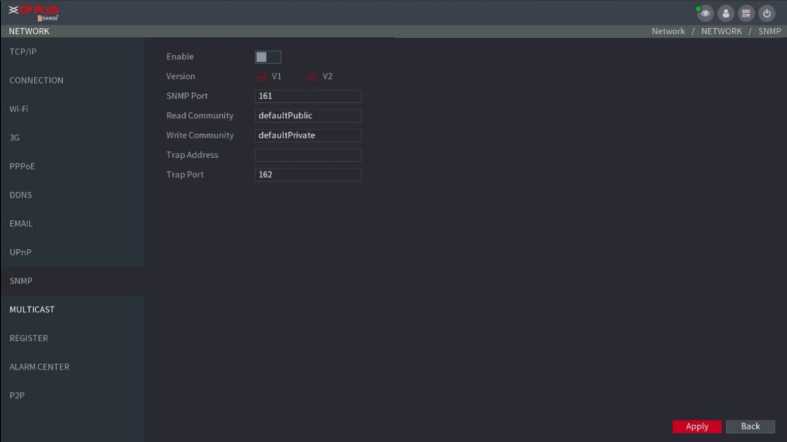
Figure 5-174
Step 2 Configure the settings for the SNMP parameters. See Table 5-60.
Table 5-60
Step 3
Step 4
Step 5
Step 6
Compile the two MIB files by MIB Builder.
Run MG-SOFT MIB Browser to load in the module from compilation.
On the MG-SOFT MIB Browser, enter the Device IP that you want to manage, and
then select the version number to query.
On the MG-SOFT MIB Browser, unfold the tree-structured directory to obtain the
configurations of the Device, such as the channels quantity and software version.
When you access the Device from the network to view the video, if the access is exceeded, the video will not display. You can use the multicast function to group the IP to solve the problem.
Step 1 Select Main Menu ■> Network ^ MULTICAST.
The MULTICAST interface is displayed.See Figure 5-175.
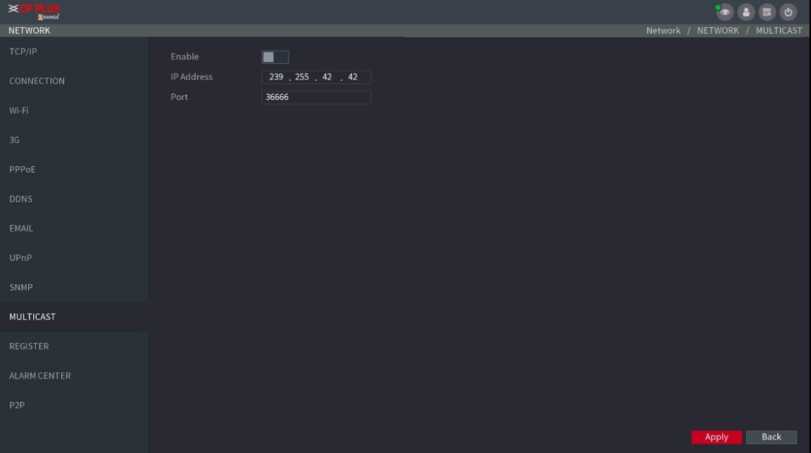
![]()
Step 2 Configure the settings for the multicast parameters. See Table 5-61.
Table 5-61
Step 3 Click Apply to complete the settings.
You can use the multicast IP address to login the web. See Figure 5-176.
On the web login dialog box, in the Type list, select MULTICAST. The web will automatically obtain the multicast IP address and join. Then you can view the video through multicast function.
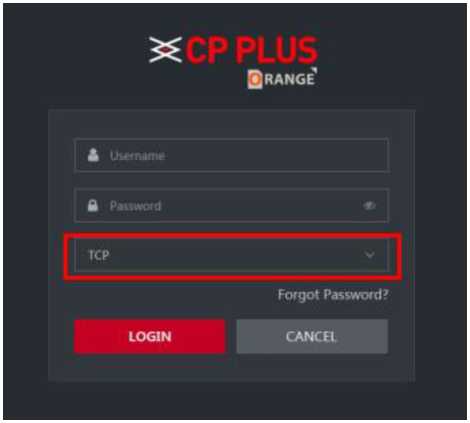
You can register the Device into the specified proxy server which acts as the transit to make it easier for the client software to access the Device.
Step 1 Select Main Menu ^ Network ^ REGISTER.
The REGISTER interface is displayed.See Figure 5-177.
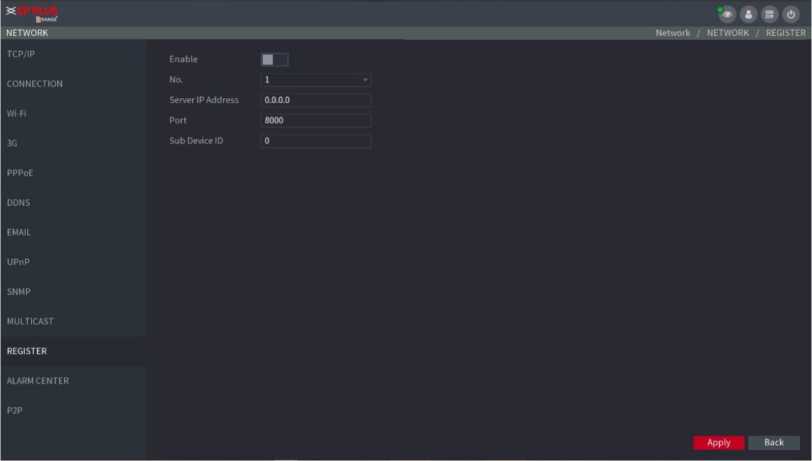
Figure 5-177
Step 2 Configure the settings for the register parameters. See Table 5-62.
Table 5-62
Step 3 Click Apply to complete the settings.
You can configure the alarm center server to receive the uploaded alarm information. To use this function, the Alarm Upload check box must be selected. For details about alarm event settings, see “5.10 Alarm Events Settings.”
Step 1 Select Main Menu ^ Network ^ ALARM CENTER.
The ALARM CENTER interface is displayed.See Figure 5-178.
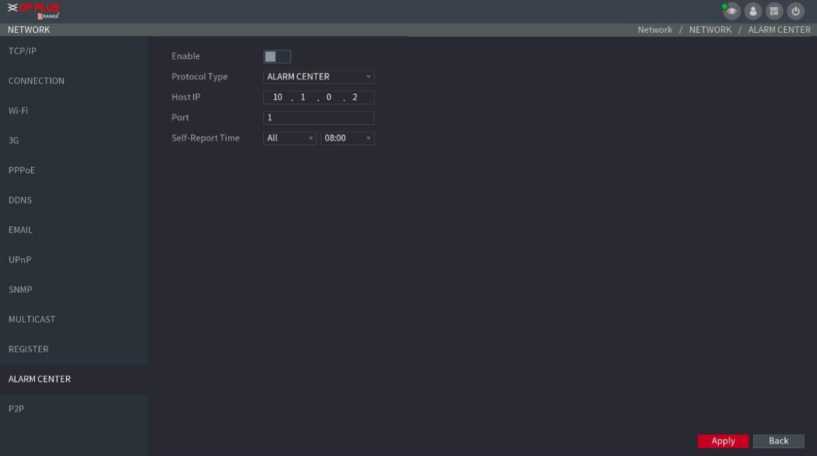
Figure 5-178
Step 2 Configure the settings for the alarm center parameters. See Table 5-63.
Table 5-63
Step 3 Click Apply to complete the settings.
You can manage the devices by using InstaOn technology to download the application and register the devices. For details, see “5.1.4.5 Configuring InstaOn Settings.”
You can test the network connection status between the Device and other devices.
Step 1 Select Main Menu ■> INFO ^ Network ^ Test.
The Test interface is displayed. See Figure 5-179.
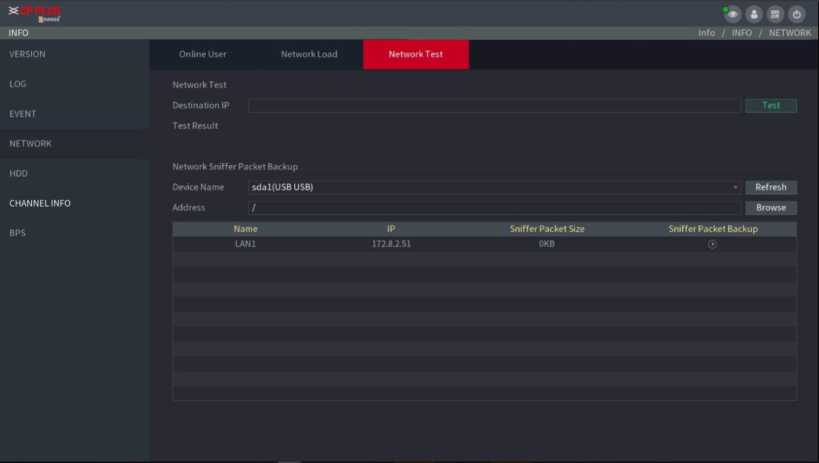
Figure 5-179
Step 2 In the Destination IP box, enter the IP address.
Step 3 Click Test.
After testing is completed, the test result is displayed. You can check the evaluation for average delay, packet loss, and network status. See Figure 5-180.
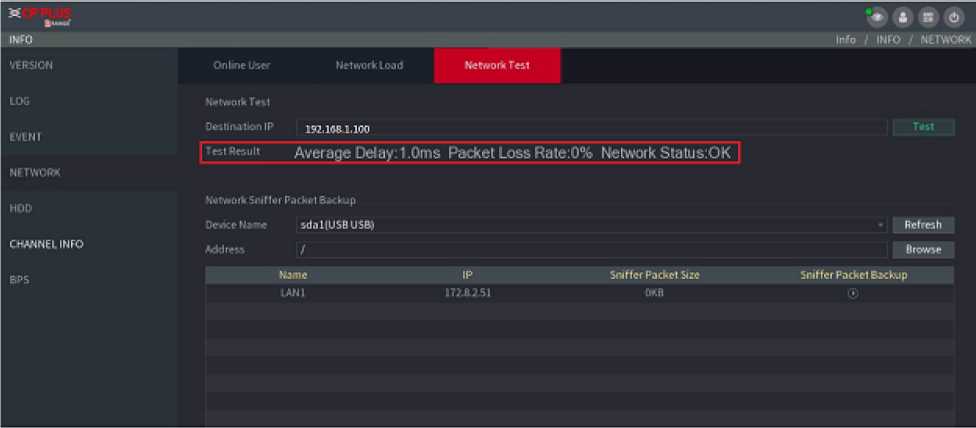
Figure 5-180
Packet capture means the operations such as capturing, resending, and editing data that are sent and received during network transmission. When there is network abnormality, you can perform packet capturing and back up into the USB storage device. This date can be provided to the technical support for analyzing the network condition.
Step 1 Select Main Menu ■> Info ^ Network > Network Test.
The Network Test interface is displayed.See Figure 5-181.
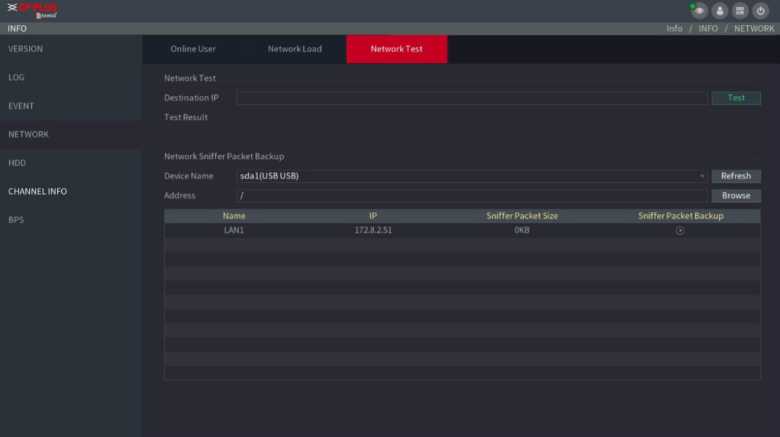
Figure 5-181
Step 2 Connect a USB storage device to the Device.
Step 3 Click Fresh.
The Device starts detecting the USB storage device and displays its name in the Device Name box.
Step 4 Select the route of the data that you want to capture and back up.
1) In the Network Sniffer Packet Backup, click Browse.
The Browse interface is displayed. See Figure 5-182.
Device Name
Total Space
Free Space
Address
sdal(USBUSB) Refresh Format
3.73 GB
3.27 GB
| Name | Size | Type | Delete |
| ■ ScreenShot | Folder | B | |
| ® LANl-20180313213059.pcap | 111.7 KB | File | a |
| ® LANl-20180313213722.pcap | 182.1 KB | Rie | □ |
| ■ printf_20180314111548.txt | 1.2 KB | Rie | fl |
| a kmsg_printf_20180314111548.txt | 19.8 KB | File | □ |
| ® printf.txt | 1.97 MB | Rie | Q |
| l&l kmsg_printf.txt | 1.1KB | Rie | fl |
| @1 pnntf_2O18O3161539O3.txt | 964 B | File | fl |
| SI kmsg_printf_20180316153903.txt | 2L2KB | Rie | B |
| W pnntf_20180316154049.txt | 1.5 KB | Rie | fl |
| ® kmsg_printf_201803161S4049.txt | 21.7 KB | Rie | g |
| @1 printf_2O18O316155148.txt | 2.2 KB | Rie | fl |
| Ml kmsg_phntf_20180316155148.txt | 21.6 KB | Rie | fl |
| ® printf_2O18O316161436.txt | 2.5 KB | File | fl |
| Bl kmsg_printf_20180316161436.txt | 21.9 KB | Rie | a |
Import
Export
Figure 5-182
2)
Select the route.
ED NOTE
- If there are several USB storage devices are connected to the Device, you can select from the Device Name list.
- Click Refresh to total space, free space and the file list in the selected USB storage device.
- In the case of insufficient capacity, click Fl
to delete the needless files.
- Click New Folder to create a new folder in the USB storage device.
3) Click Apply to save the route selection settings.
The Test interface is displayed again.
Step 5
Click

to start packet capturing and backing up.
CO NOTE
- Only the data packet of one LAN can be captured at one time.
- After capturing starts, you can exit the Test interface to perform other operations
such as web login and monitoring.
Step6 Click © to stop capturing.
The backup data is saved in the selected route under the naming style “LAN name- time.pcap.” See Figure 5-183. You can open it by using Wireshark software.
Device Name
Total Space
Free Space
Address
sdal(USBUSB) Refresh Format
3.73 GB
3.27 GB
| Name | Size | Type | Delete |
| ■ ScreenShot | Folder | Q | |
| ® LANl-20180313213059.pcap | 111.7 KB | Rte | B |
| @ LAN 1-20180313213722.pcap | 182.1 KB | Rie | B |
| ;i‘i printf_20180314111548.txt | 1 2 KB | Rie | |
| @ kmsg_printf_20180314111548.txt | 19.8 KB | File | o |
| g) printf.txt | 1.97 MB | Rie | B |
| I«l kmsg_printf.txt | 1.1KB | Rie | * |
| H pnntf_20180316153903.txt | 964 B | File | Sk |
| (£i kmsg_printf_20180316153903.txt | 2L2KB | Rie | □ |
| M printf_20180316154049.txt | 1.5 KB | Rie | M |
| IB kmsg_printf_20180316154049.txt | 2L7KB | Rie | B |
| ® printf_20180316155148.txt | 22 KB | Rie | a |
| ■ kmsg_printf_20180316155148.txt | 21.6 KB | Rie | a |
| printf.20180316161436.txt | 25 KB | Rie | B |
| 81 kmsg_printf_20180316161436.txt | 2L9KB | Rie | B |
New Folder
Import Export
Figure 5-183
5.15 Configuring Account Settings
You can add, modify and delete user accounts, groups, and ONVIF users, and set security questions for admin account.
CD NOTE
- The user name supports 31 characters and group name supports 15 characters. The user name can be consisted of letter, number, “_”, “@”, “.”.
- You can set maximum 64 users and 20 groups. The group name by “User” and “Admin” cannot be deleted. You can set other groups and define the relevant permissions. However, the admin account cannot be set randomly.
- You can manage the account by user and group and the name cannot be repeated. Every user must belong to a group, and one user only belongs to one group.
Step 1 Select Main Menu ^ Account ^ User.
The USER interface is displayed.See Figure 5-184.
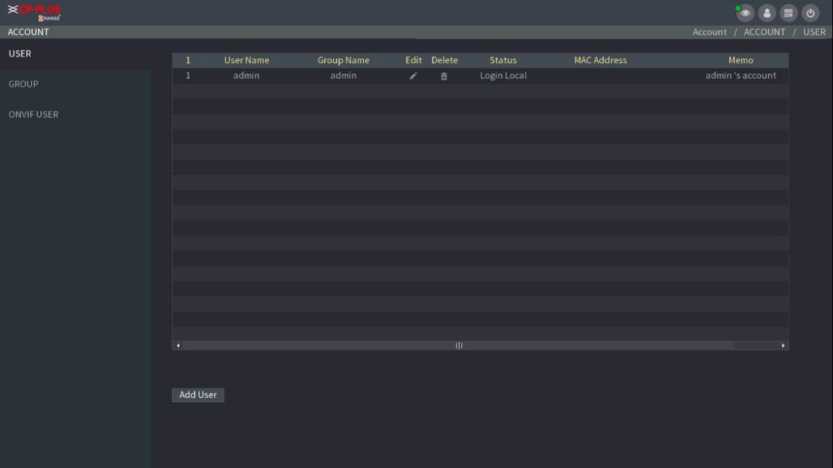
Figure 5-184
The Add User interface is displayed. See Figure 5-185.
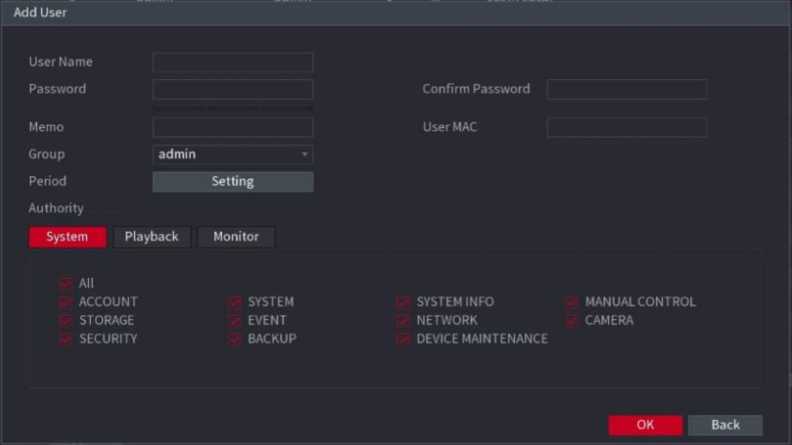
Figure 5-185
Step 3 Configure the settings for the parameters of adding a user account. See Table 5-64.
| Parameter | Description |
| User Name | Enter a user name and password for the account. |
| Password | |
| Confirm Password | Re-enter the password. |
| Memo | Optional.
Enter a description of the account. |
| User MAC | Enter user MAC address |
| Group | Select a group for the account.
w note The user rights must be within the group permission. |
| Period | Click Set to display Set interface.
Define a period during which the new account can login the device. The new account cannot login the device during the time beyond the set period. |
| Authority | In the Authority area, select the check boxes in the System tab, Playback tab, and Monitor tab.
CQ NOTE To manage the user account easily, when defining the user account authority, it is recommended not to give the authority to the common user account higher that the advanced user account. |
Table 5-64
Step 4 Click OK to complete the settings.
Step 1 Next to Period, click Setting.
The Setting interface is displayed. See Figure 5-186.
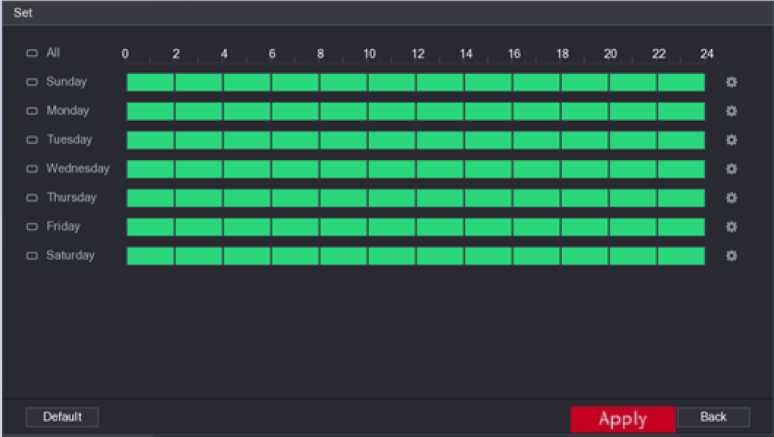
Figure 5-186
Step 2 Define the permitted period. By default, it is active all the time. • Define the period by drawing.
O Define for a specified day of a week: On the timeline, click the half-hour blocks to select the active period.
O Define for several days of a week: Click H before each day, the icon
switches to Q
. On the timeline of any selected day, click the half-hour blocks
to select the active periods, all the days with Q
will take the same settings.
O Define for all days of a week: Click All, all the switches to . On the
timeline of any day, click the half-hour blocks to select the active periods, all the days will take the same settings.
• Define the period by editing. Take Sunday as an example.
1) Click
![]()
The Period interface is displayed. See Figure 5-187.
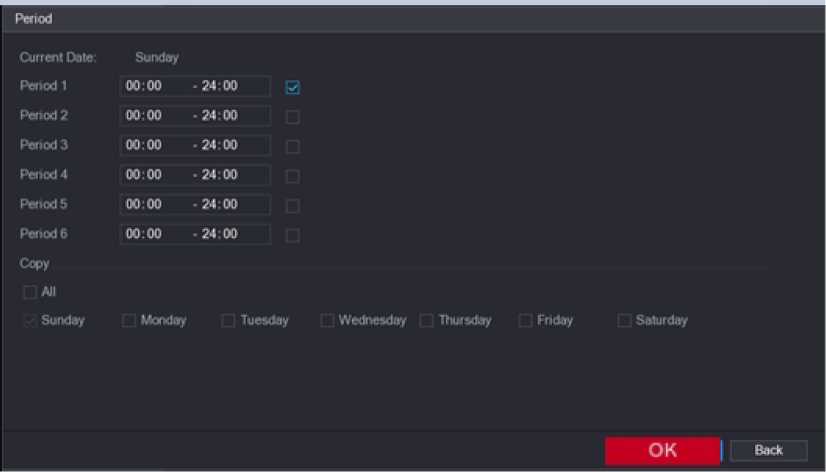
Figure 5-187
O There are six periods for you to set for each day.
O Under Copy, select All to apply the settings to all the days of a week, or select specific day(s) that you want to apply the settings to.
- Click OK to save the settings.
Step 3 Click OK.
5.15.1.2 Modify a User Account
Step 1 Select Main Menu ^ Account ^User.
The USER interface is displayed. See Figure 5-188.
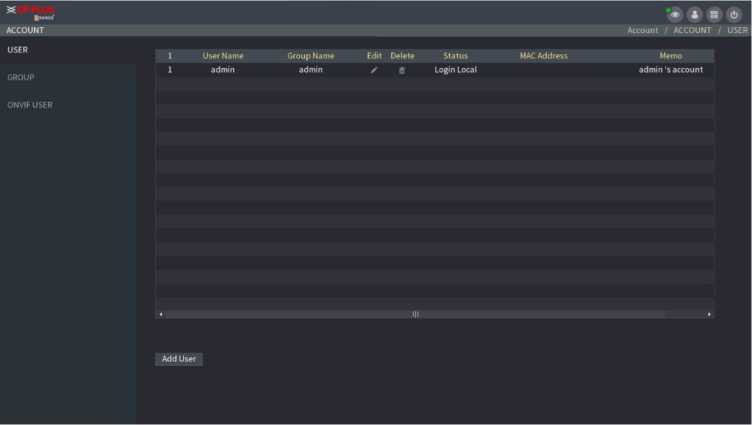
Figure 5-188
for the user account that you want to modify.
The Modify User interface is displayed. See Figure 5-189.
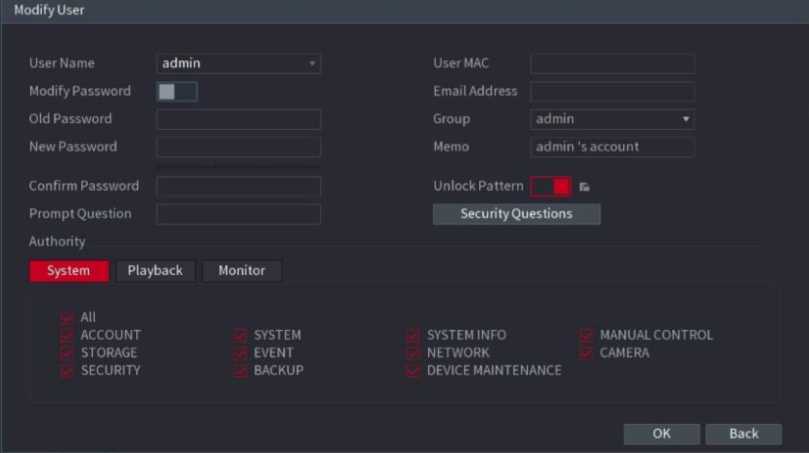
Figure 5-189
Step 3 Change the settings for password, user name, user group, user MAC, memo, period, and authority.
Q NOTE
The new password can be set from 8 digits through 32 digits and contains at least two types from number, letter and special characters (excluding , , “;”,”:” and “&”).
For the admin account, you can enter or modify email address, enable/disable the unlock pattern, modify the security questions.
• In the Email Address box, enter the email address, and the click Save to save the setting.
• To use the unlock pattern, enable Unlock Pattern, click
![]()
, draw a pattern in
the Unlock Pattern interface, and then click Save to save the setting.
• Configuring security questions.
- ) Click Security Questions.
The Security Questions interface is displayed. See Figure 5-190.
Security Questions
Successfully set. Please delete it first if you want to reset security question ¡again.
Question 1

Delete
Figure 5-190
- In the Question list, select questions and enter the answers in the Answer box.
- Click Setting to save the settings.
You can use the security questions and answers to reset the password for admin account.
EQ NOTE
To reset the security questions, on the Security Questions, enter the correct answers for each question, and then click Delete.
Step 4 Click OK to complete the settings.
5.15.1.3 Deleting a User Account
Step 1 Select Main Menu ■> Account ^ User.
The USER interface is displayed. See Figure 5-191.
■> USER
GROUP
ONVIFUSER
![]()
1 Usa Name Group»…. Modify Mat 5«ojs MAC A.. Memo
I admin admin Z t Login Local admin’s account
AiMUfrer
Figure 5-191
for the user account that you want to delete.
A Message is displayed.
Step 3 Click OK to delete a user account.
Step 1 Select Main Menu ^ Account ^ Group.
The GROUP interface is displayed.See Figure 5-192.
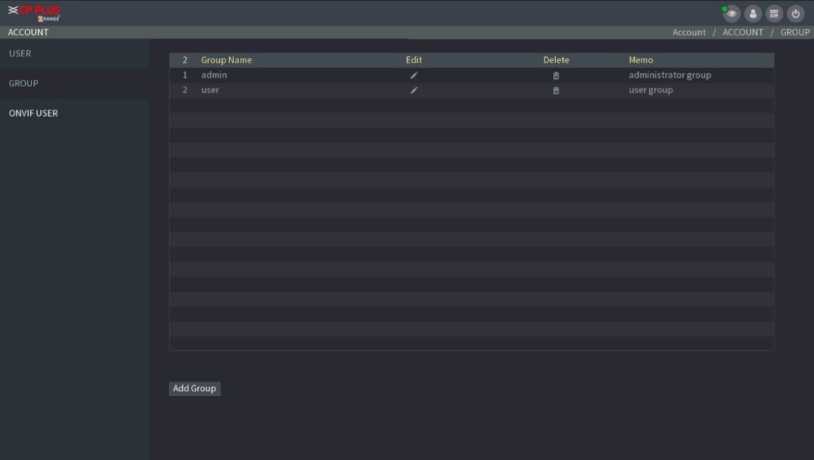
Figure 5-192
The Add Group interface is displayed. See Figure 5-193.
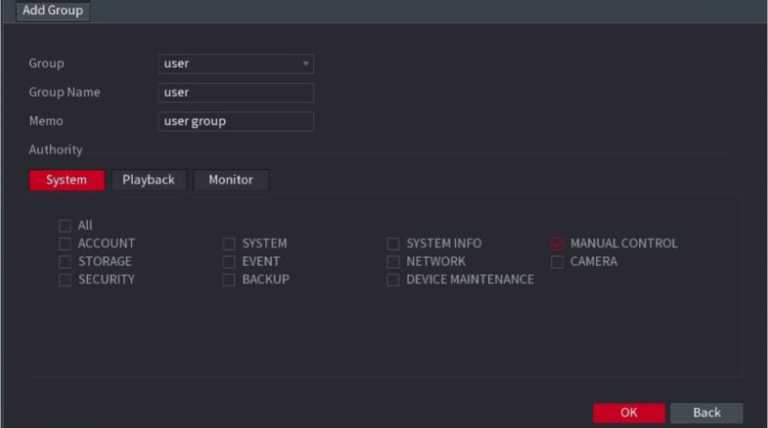
Figure 5-193
Step 3 Configure the settings for the parameters of adding a group. See Table 5-65.
Table 5-65
Step 4 Click OK to complete the settings.
Step 1 Select Main Menu ^ Account ^ Group.
The GROUP interface is displayed.See Figure 5-194.
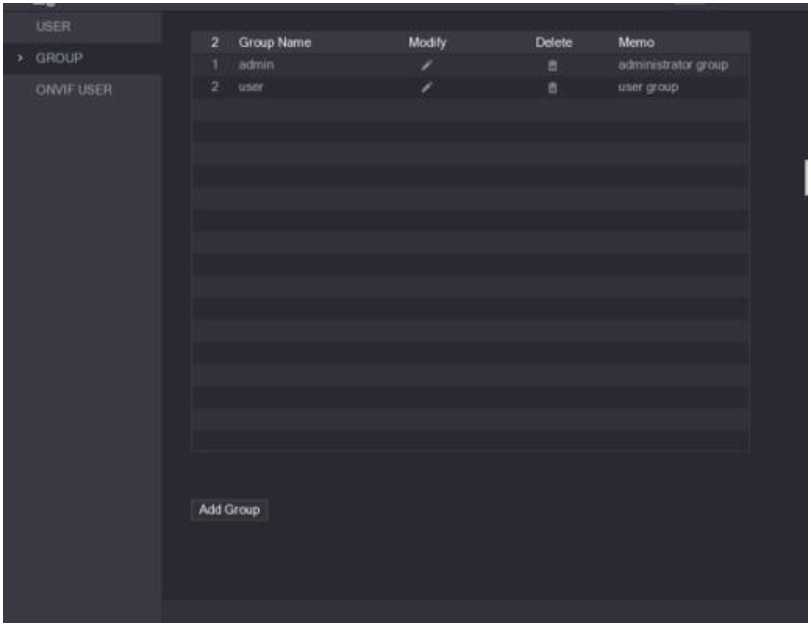
Figure 5-194
![]()
for the group account that you want to modify.
Step 3 The Modify Group interface is displayed. See Figure 5-195.
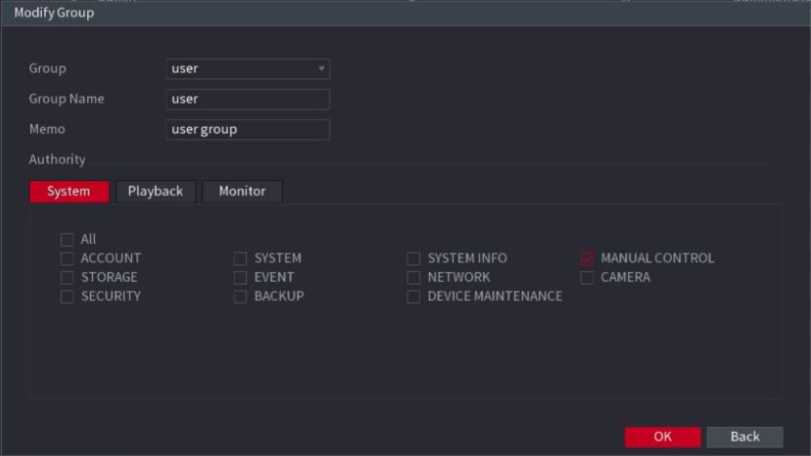
Figure 5-195
Step 4 Change the settings for group name, memo, and authority.
Step 5 Click OK to complete the settings.
Step 1 Select Main Menu ■> Account ^ Group.
The GROUP interface is displayed.See Figure 5-196.
| USER | 2 | GlCu® Nd inc | Miriiiy | Ddclc | Memo |
| □ROUP | 1 | admin | z | fl | aAnimâraMr ¡¡roup |
| onvif use n | 2 | user | / | fl | user 9*aup |
Add Owp
Figure 5-196
![]()
for the user account that you want to delete.
A Message is displayed.
Step 3 Click OK to delete a group.
The device manufactured by other company can connect to the Device through Onvif protocol by an authorized Onvif account.
NOTE
The admin account is created for Onvif users right after the Device has been initialized
Step 1 Select Main Menu ^ Account ^ ONVIF USER.
The ONVIF USER interface is displayed. See Figure 5-197.
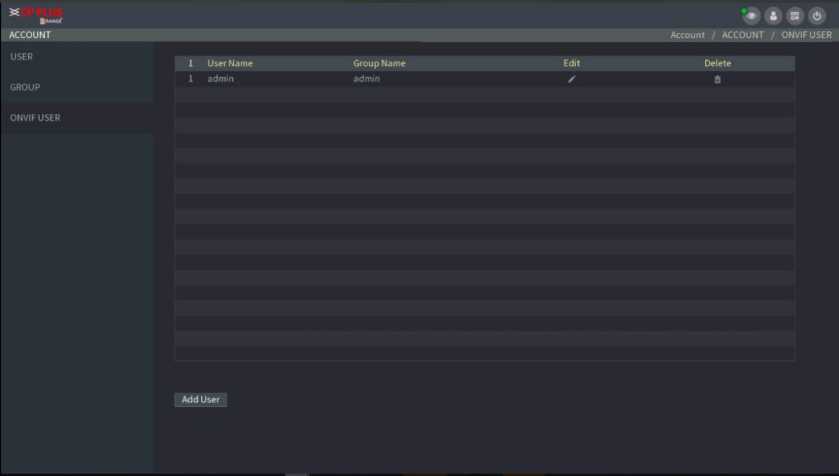
Figure 5-197
The Add User/Modify interface is displayed. See Figure 5-198.
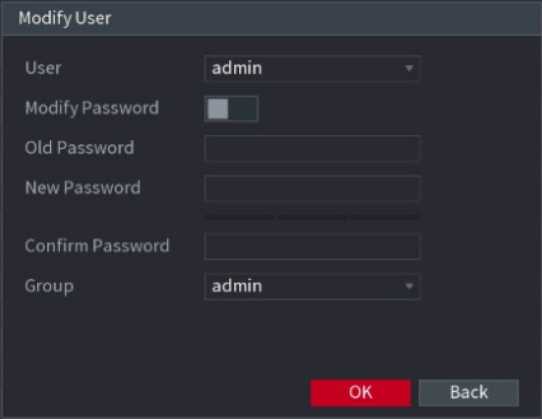
Figure 5-198
Step 3 Enter user name, password, and select the group that you want this account to belong to.
Step 4 Click OK to save the settings.
Q NOTE
Click □ to modify the account; Click Fl
to delete the account.
Voice management function manages audio files and configures the playing schedule. When there is an alarm event, the audio file can be activated.
You can add audio files, listen to audio files, rename and delete audio files, and configure the audio volume.
Step 1 Select Main Menu ^ System ^ Voice ^ FILE MANAGER.
The FILE MANAGER interface is displayed.See Figure 5-199.
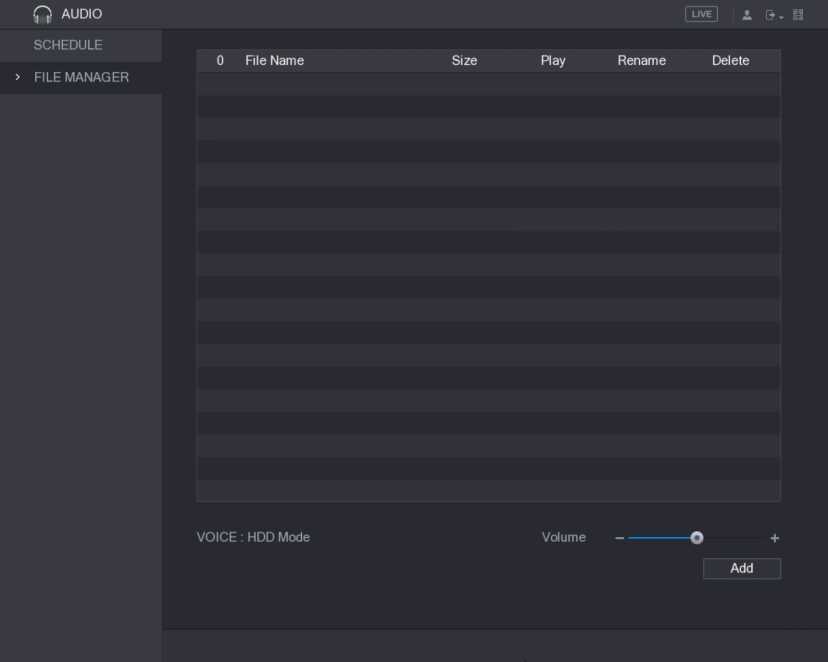
Figure 5-199
The Add interface is displayed. See Figure 5-200.
| Browse | ||||
| Device Name sdcl(USBUSB) 3.71GB/3.73GB(Free/Total) | Refresh | Format | ||
| Address / | ||||
| Name | Size | Type | Delete | Play |
| ■ (fd2b025a-ac98-e383-13ea-lcf86fc539fb) | Folder | a | ||
| ■ ScreenShot | Folder | B | ||
| ■ printf_20180317141255.txt.lnk | 1.8 KB | File | B | |
| g kmsg_printf_20180317141255.txt.lnk | 1.8 KB | File | B | |
| g| SmartPlayer.exe.Ink | 1.7 KB | File | 8 | |
| a Uni+ DVR_chl_main_20180317134749_… | 26 KB | File | □ | |
| a Uni+ DVR_chl_main_20180317135000_… | 26 KB | File | □ | |
| a ty.lnk | L7 KB | File | □ | |
| a printf_20180317143922.txt.lnk | 1.8 KB | File | a | |
| g kmsg_printf_20180317143922.txt.lnk | 1.8 KB | File | B | |
| New Folder | OK | Back | ||
Figure 5-200
Step 3 Select the audio files that you want to import.
Step 4 Click OK to start importing audio files from the USB storage device.
If the importing is successful, the audio files will display in the FILE MANAGER interface. See Figure 5-201.
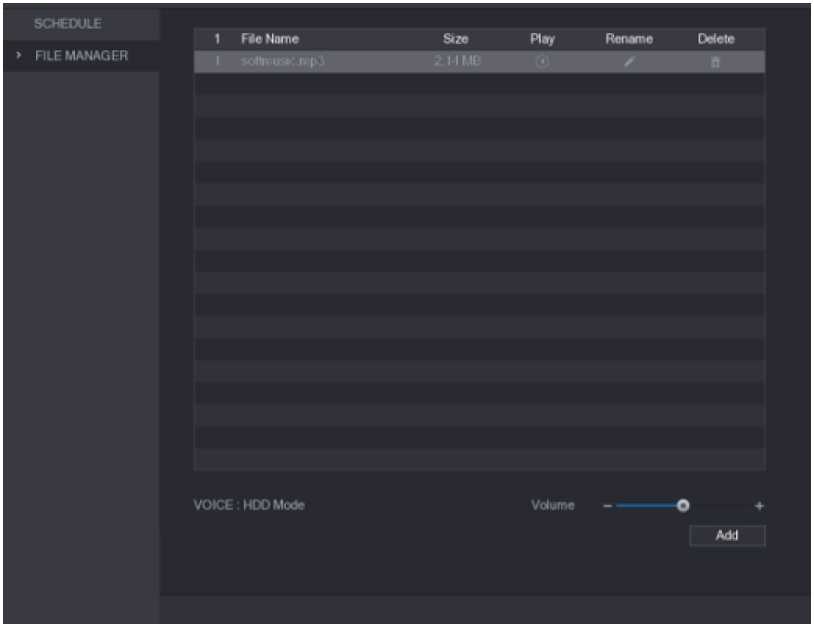
Figure 5-201
The imported audio files are automatically saved into the HDD, so you do not need to connect to the USB storage device to get the file next time.
•
•
Click
![]()
to play the audio file.
Click
![]()
to rename the audio file.
- Click to delete the audio file.
- To decrease or increase the playing volume, move the slider to the left or to the right.
5.16.2 Configuring Playing Schedule for Audio Files
You can configure the settings to play the audio files during the defined time period.
Step 1 Select Main Menu ^ System ^ Voice ^ SCHEDULE.
The SCHEDULE interface is displayed.See Figure 5-202.
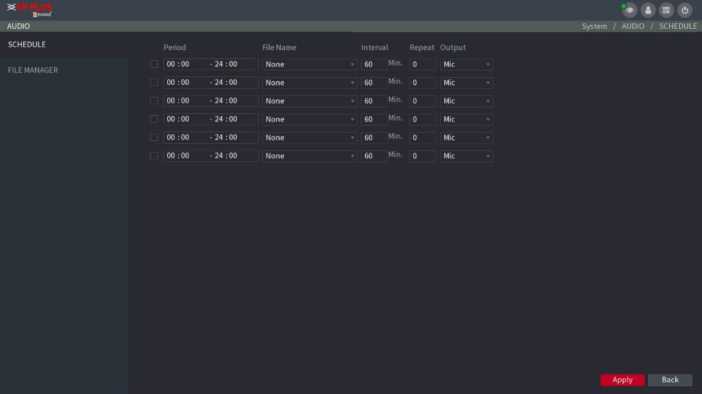
Figure 5-202
Step 2 Configure the settings for the schedule parameters. See Table 5-66.
Table 5-66
CQ NOTE
• The finish time for audio playing is decided by audio file size and the configured interval.
•
Playing priority: Alarm event > Talkback > Trial listening > Audio file.
Storage management function manages the stored resources such as recorded video files and storage space. The function aims at providing easier operation and improving the storage efficiency.
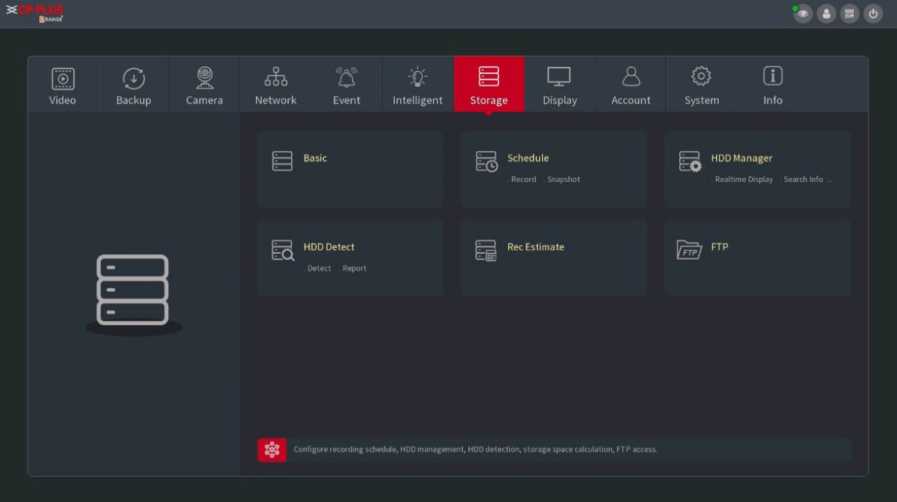
Step 1 Select Main Menu ^ Storage ■+ BASIC.
The BASIC interface is displayed.See Figure 5-203.
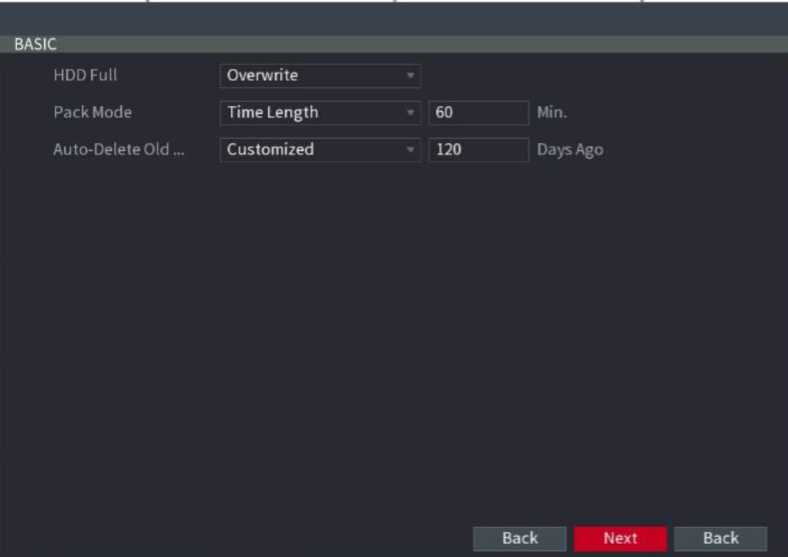
Figure 5-203
Step 2 Configure the settings for the basic settings parameters. See Table 5-67.
Table 5-67
Step 3 Click Apply to complete the settings.
The system starts recording and taking snapshot according to the configured schedule. For details, see “5.1.4.9 Configuring Recorded Video Storage Schedule” and “5.1.4.10 Configuring Snapshot Storage ScheduleConfiguring Snapshot Storage Schedule”
You can view the HDD information, format HDD, and configure the HDD type through HDD manager.
Step 1 Select Main Menu ■> Storage ^ HDD MANAGER.
The HDD MANAGER interface is displayed. See Figure 5-204.
In the table, you can view the information of current HDD, such as device name, HDD type, status, total space and free space, and serial number of the HDD port.
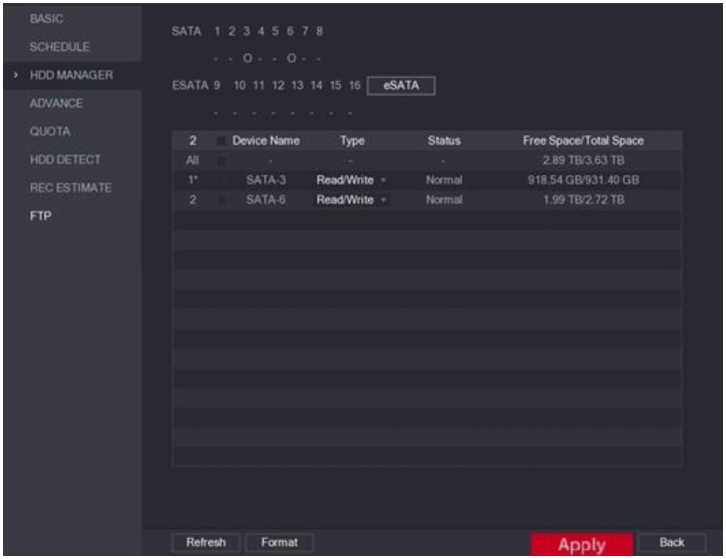
Figure 5-204
Step 2 Configuring the settings for the HDD manager.
- HDD type setting: In the Type list, select Read/Write, Read-Only or Redundant, and then click Apply to save the settings.
- HDD format: Select the HDD that you want to format, click Format, in the pop-up message, click OK to start formatting, and then following the onscreen message to complete formatting.
You can configure the HDD group to save the specified main stream, sub stream and snapshots
to the designated HDD group.

CAUTION
- If “Current HDD Mode is Quota Mode” is shown on the interface, you need to switch to HDD mode.
- You can enable either HDD Mode or Quota Mode at one time. The system reboots to activate the settings.
Step 1 Select Main Menu > STORAGE > ADVANCE.
The ADVANCE interface is displayed.See Figure 5-205.
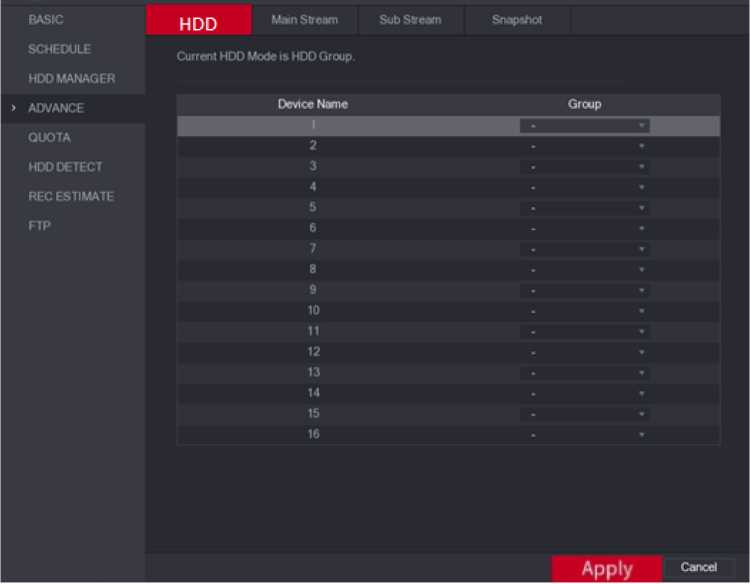
Figure 5-205
Step 2 Select the group for each HDD group, and then click Save to save the settings.
Step 3 After configuring HDD group, under the Main Stream tab, Sub Stream tab and Snapshot tab, configure settings to save the main stream, sub stream and snapshot to different HDD group as selected by you. See Figure 5-206, Figure 5-207, and Figure 5208.
| BASIC | HDD | Main Stream | Sub Steam | Snnpshol | ||||
| SCHEDULE | ||||||||
| Current HDD Mode is HDD Group. | ||||||||
| HDD MANAGER | ||||||||
| > ADVANCE | Set AJI Charnel* 1 | Adi | ||||||
| QUOTA | ÇKırnH | Group Channel | Group | Chitnncl | Group | Channel | Group | |
| 1 | 1 ’ 2 | 1 ’ | 3 | 1 ’ | 4 | 1 | ||
| HDD DETECT | 5 | 1 – § | 1 ’ | 7 | 1 ’ | 8 | 1 ’ | |
| REC ESTIMATE | 9 | 1 * 10 | 1 W | 11 | 1 ’ | 12 | 1 * | |
| FTP | 13 | 1 * 14 | 1 ’ | 15 | 1 • | Ifl | 1 • | |
Apply c«n“i
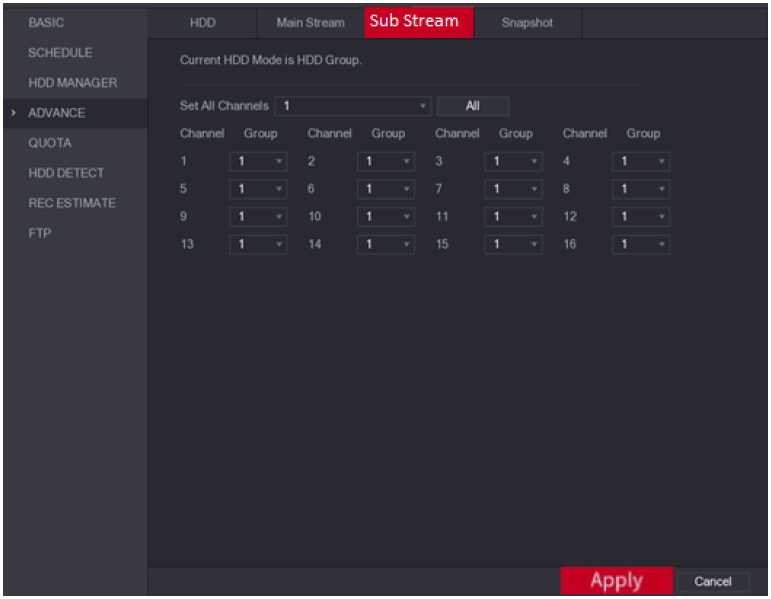
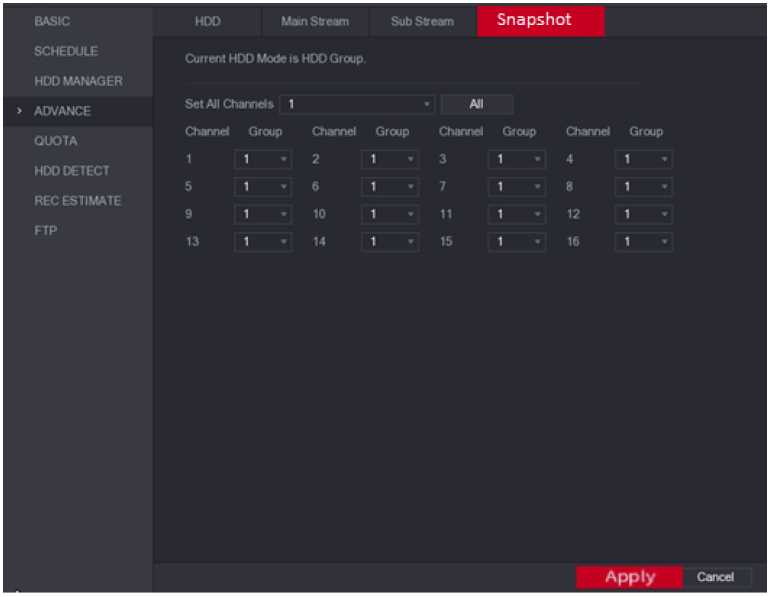
Figure 5-208
Step 4 Click Apply to complete the settings.
5.17.5 Configuring HDD Detecting Settings
CD NOTE
Not all models support this function.
HDD detecting function detects the current status of HDD to let you know the HDD performance and replace the defective HDD.
You can detect HDD by quick detect and global detect.
- Quick detect: Detect the files saved in HDD. The detected bad track can be repaired by formatting. If there are no files in HDD, the system cannot detect the bad track.
- Global detect: Detect the whole HDD through Windows, which takes time and might affect the HDD that is recording the video.
Step 1 Select Main Menu ■+ Storage ^ HDD DETECT ^ Detect.
The Detect interface is displayed.See Figure 5-209.
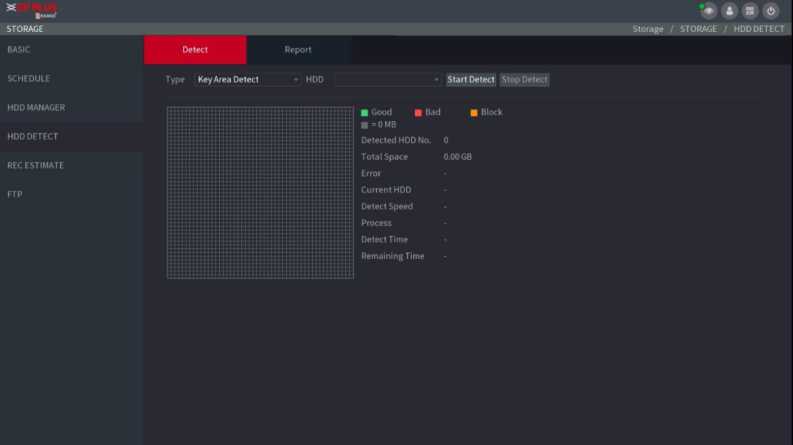
Figure 5-209
Step 2 In the Type list, select Quick Detect or Global Detect; and in the HDD list, select the HDD that you want to detect.
Step 3 Click Start Detect.
The system starts detecting the HDD. After detecting is completed, see Figure 5-210.
Q NOTE
During detecting, click Pause to pause detecting, click Continue to restart detecting, and click Stop Detect to stop detecting.
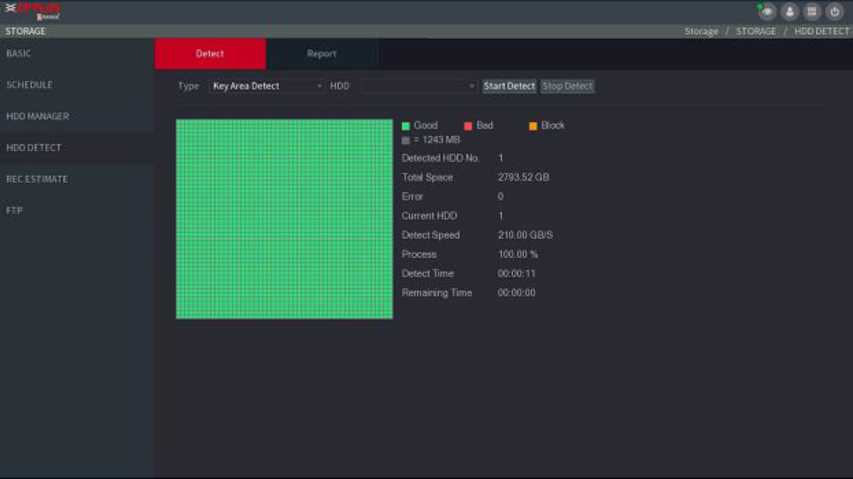
Figure 5-210
After the detecting is completed, you can view the detecting reports to find out the problem and
replace the defective HDD to avoid data loss.
Step 1 Select Main Menu ■> Storage ^ HDD DETECT ^ Report.
The Report interface is displayed.See Figure 5-211.
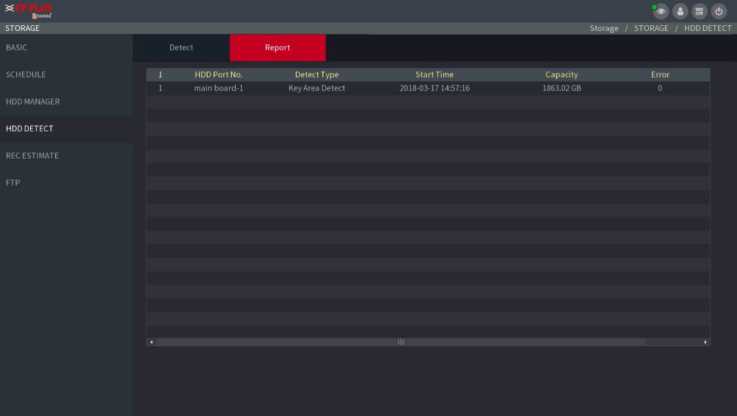
Figure 5-211
.
The Details interface is displayed. You can view detecting results and S.M.A.R.T reports. See Figure 5-212 and Figure 5-213.
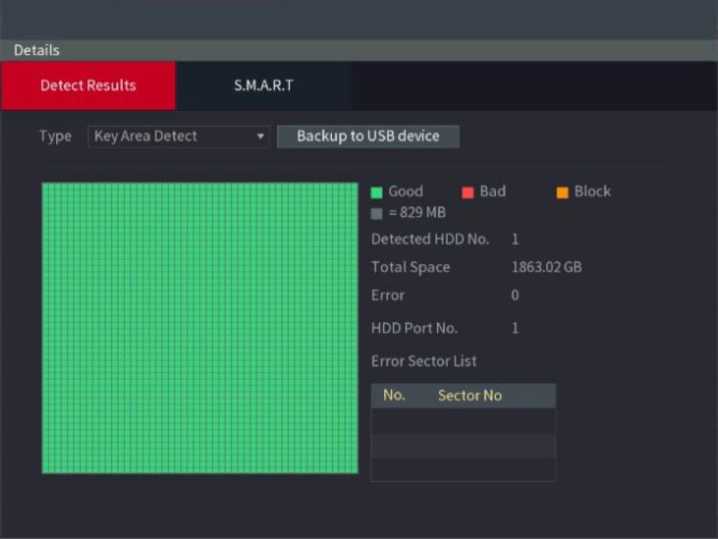
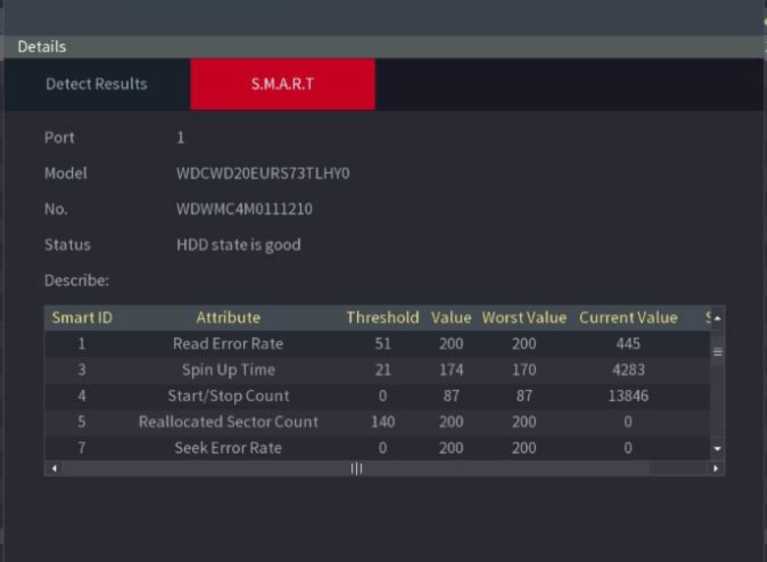
Figure 5-213
You can configure the quote for each channel to be saved into each HDD.

CAUTION
- If “Current HDD Mode is HDD Mode” is shown on the interface, you need to switch to Quota mode.
- You can enable either HDD Mode or Quota Mode at one time. The system reboots to activate the settings.
Step 1 Select Main Menu ^ Storage ^ QUOTA.
The QUOTA interface is displayed.See Figure 5-214.
| BASIC | Current HEX) Mode is | HOD Group | Change lo Quota Mode |
| QUOTA | HEX) Que
SATAI |
4a | SATA2 |
| REC ESTIMATE
FTP |
SATA3
SATAS SATA7 |
SATA4
SA TAG SATAS |
Apply
Figure 5-214
Step 2 In the Channel list, select the channel that you want to configure.
Step 3 In the SATA list, select the quota for the selected channel.
Step 4 Click Apply to complete the settings.
Click Statistics to view the quota of each channel. See Figure 5-215.
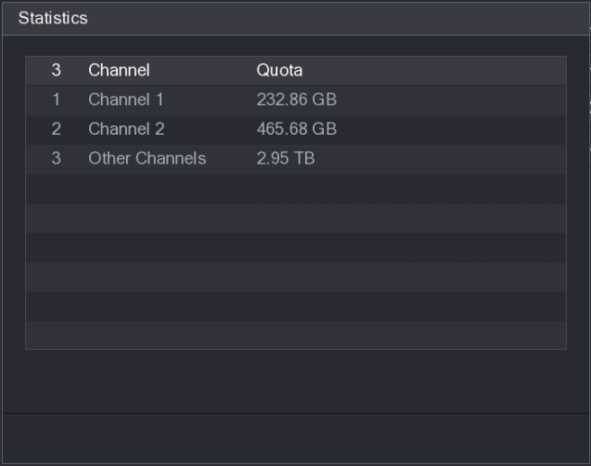
Record estimate function can calculate how long you can record video according to the HDD capacity, and calculate the required HDD capacity according to the record period.
Step 1 Select Main Menu ^ STORAGE ^ REC ESTIMATE.
The REC ESTIMATE interface is displayed.See Figure 5-216.
STORAGE Storage / STORAGE / REC ESTIMATE
| BASIC | Channel | Edit | Bit Rate(Kb/S) | Record Time | Resolution | Frame Rate | • |
| ■J 1 | X | 1024 | 24 | 1280×720(720P) | 25 | ||
| SCHEDULE | ■J 2 | Z | 1024 | 24 | 1280×720(720P) | 25 | |
| HDD MANAGER | V 3 | z | 1024 | 24 | 1280×720(720P) | 25 | |
| V 4 | ✓” | 1024 | 24 | 1280×720(720P) | 25 | ||
| HDD DETECT | •J 5 | z | 1024 | 24 | 1280×720(720P) | 25 | |
| •J 6 | z | 1024 | 24 | 1280×720(720P) | 25 | ||
| REC ESTIMATE | V 7 | 1024 | 24 | 1280×720(720P) | 25 | = | |
| •J 8 | z | 1024 | 24 | 1280×720(720P) | 25 | ||
| ■J 9 | 1024 | 24 | 1280×720(720P) | 25 | |||
| V 10 | z | 1024 | 24 | 1280×720(720P) | 25 | ||
| V 11 | z | 1024 | 24 | 1280×720(720P) | 25 | ||
| V 12 | z | 1024 | 24 | 1280×720(720P) | 25 | ||
| J 13 | z | 2048 | 24 | 1280*720{720P) | 25 | ||
| V 14 | z | 2048 | 24 | 1280’720(720P) | 25 | ||
| 15 | 2048 | 24 | 1280*720(720P) | 25 | |||
| 16 | z | 2048 | 24 | 1280*720(720P) | 25 | ||
| 17 / 2048 24 1280*720(720P)
Known Space Known Time Capacity 0 TB = 0 GB Select Time 0 Days Note: The record estimation data here is for reference only. Please be cautious when you are calculating record period. |
25 | ||||||
Figure 5-216
![]()
The Edit dialog box is displayed. See Figure 5-217.
You can configure the resolution, frame rate, bit rate and record time for the selected channel.
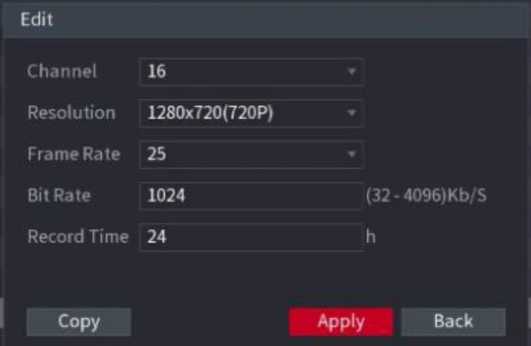
Figure 5-217
Step 3 Click OK to save the settings.
Then the system will calculate the time period that can be used for storage according to the channels settings and HDD capacity.
ED NOTE
Click Copy to copy the settings to other channels.
Step 1 On the REC ESTIMATE interface, click the Known Space tab.
The Known Space interface is displayed. See Figure 5-218.
Known Space Known Time
Capacity 0 TB= 0 GB Select
Time 0 Days
Note: The record estimation data here is for reference only. Please be cautious when you are calculating record period.
Figure 5-218
The Select HDD(s) interface is displayed.
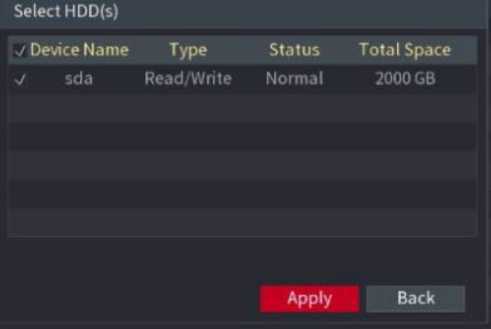
Step 3 Select the check box of the HDD that you want to calculate.
In the Known Space tab, in the Time box, the recording time is displayed. See Figure 5-219.
Known Space Known Time
Capacity 2.000 TB= 2000 GB Select
Time 10 Days
Note: The record estimation data here is for reference only. Please be cautious when you are calculating record period.
Figure 5-219
Calculating HDD Capacity for Storage
Step 1 On the REC ESTIMATE interface, click the Known Time tab.
The Known Time interface is displayed. See Figure 5-220.
Known Space Known Time
Time 0 Days
Capacity 0 TB = 0 GB
Note: The record estimation data here is for reference only. Please be cautious when you are calculating record period.
Figure 5-220
Step 2 In the Time box, enter the time period that you want to record.
In the Capacity box, the required HDD capacity is displayed. See Figure 5-221.
Known Space Known Time
Time 2 Days
Capacity 0.376 TB = 376 GB
Note: The record estimation data here is for reference only. Please be cautious when you are calculating record penod
Figure 5-221
You can store and view the recorded videos and snapshots on the FTP server.
Purchase or download a FTP server and install it on your PC.
CD NOTE
For the created FTP user, you need to set the write permission; otherwise the upload of recorded videos and snapshots will be failed.
Step 1 Select Main Menu ■> Storage •+ FTP.
The FTP interface is displayed.See Figure 5-222.
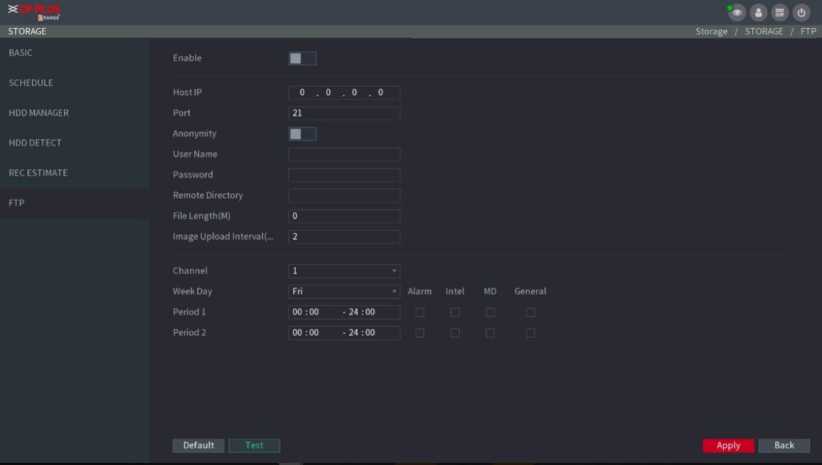
Figure 5-222
Step 2 Configure the settings for the FTP settings parameters. See Table 5-68.
| Parameter | Description |
| Enable | Enable the FTP upload function. |
| Host IP | IP address of the PC that is installed with FTP server. |
| Port | The default is 21. |
| Anonymity | Enter the user name and password to login the FTP server. |
| User Name | Enable the anonymity function, and then you can login |
| Password | anonymously without entering the user name and password. |
Table 5-68
Step 3 Click Test.
The system pops up a message to indicate success or failure. If failed, please check the network connection or configurations.
Step 4 Click Apply to complete the settings.
5.18 Configuring System Settings
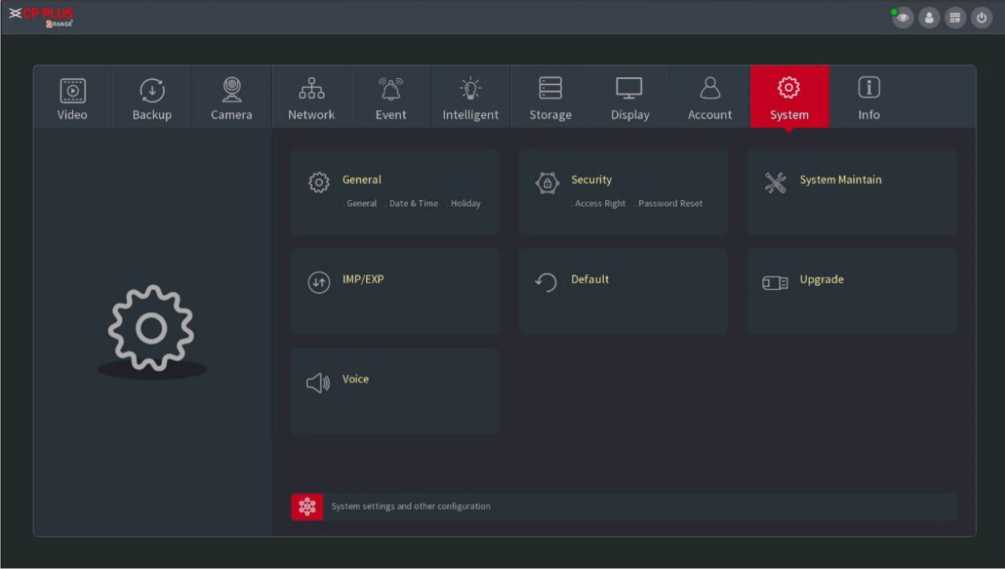
You can configure the device basic settings, time settings, and holiday settings.
For details about basic and time settings, see “5.1.4.2 Configuring General Settings” and “5.1.4.3 Configuring Date and Time Settings.”
To configure the holiday settings, do the following:
Step 1 Select Main Menu ^ System^ GENERAL ^ Holiday.
The Holiday interface is displayed.See Figure 5-223.
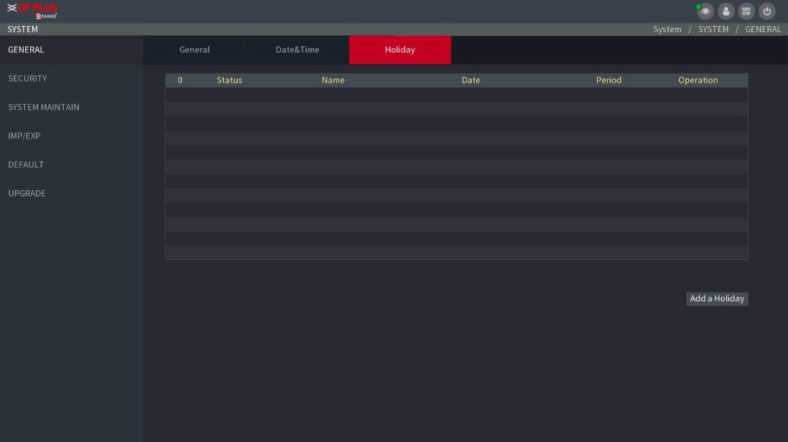
Figure 5-223
The Add a Holiday interface is displayed. See Figure 5-224.
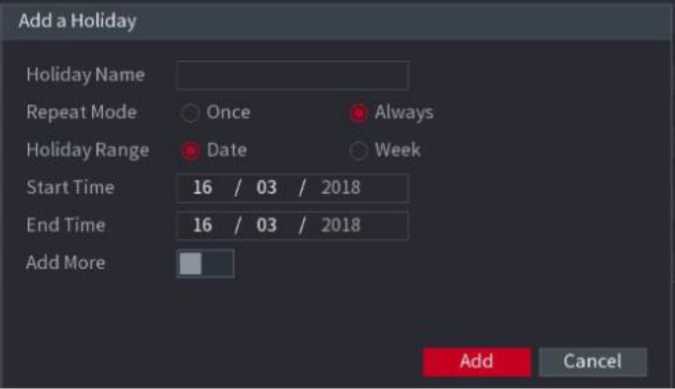
Figure 5-224
Step 3 Configure the holiday name, repeat mode, time range according to your actual situation.
Step 4 Click Add.
The added holiday information is displayed. See Figure 5-225. ED NOTE
Enable the Add More function, so you can continue adding holiday information.
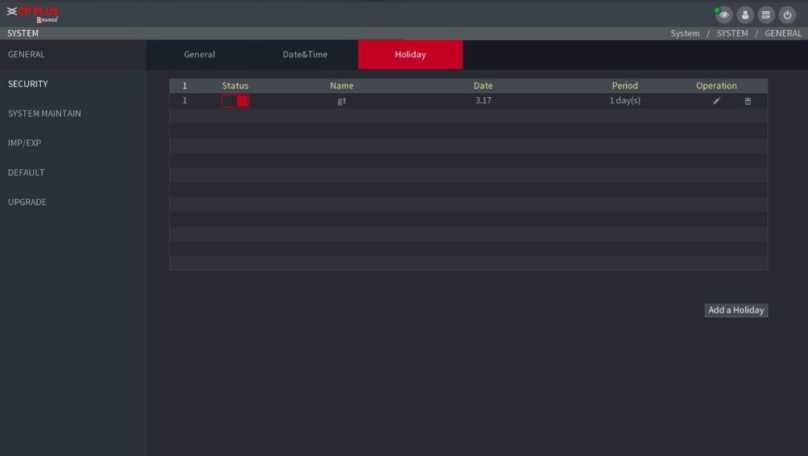
Figure 5-225
Step 1 Select Main Menu ^System ^ RS232.
The RS232 interface is displayed.See Figure 5-226.
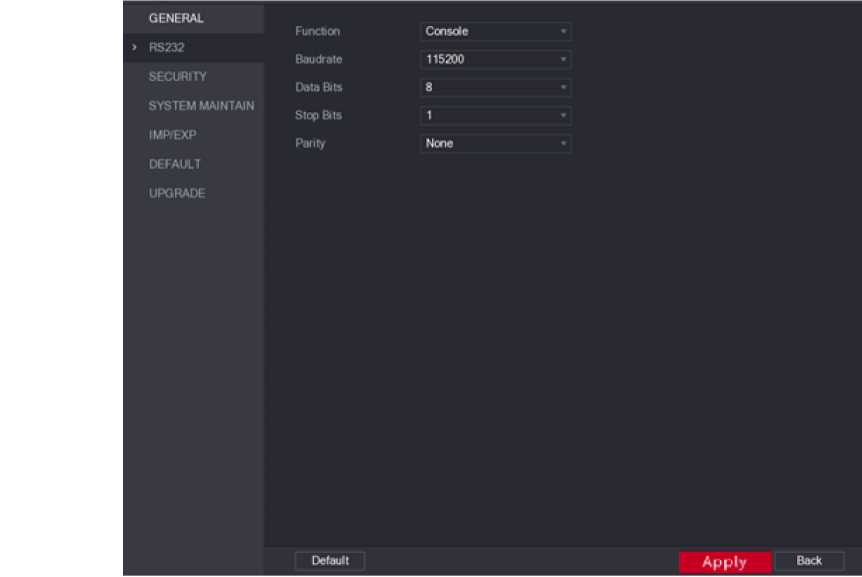
Figure 5-226
Step 2 Configure the settings for RS232 port parameters. See Table 5-69.
Table 5-69
Step 3 Click Apply to complete the settings.
To ensure the network security and protect data, you can configure the access permission to the Device from host IP (host IP means the PC or server that has an IP).
- White list includes the host IP that are permitted to access the Device.
- Back list includes the host IP that are not permitted to access the Device.
- Updata time white list includes the host IP that are permitted to sync the Device time.
Step 1 Select Main Menu ^ System ^ Security ^ Access Right.
The Access Right interface is displayed.See Figure 5-227.
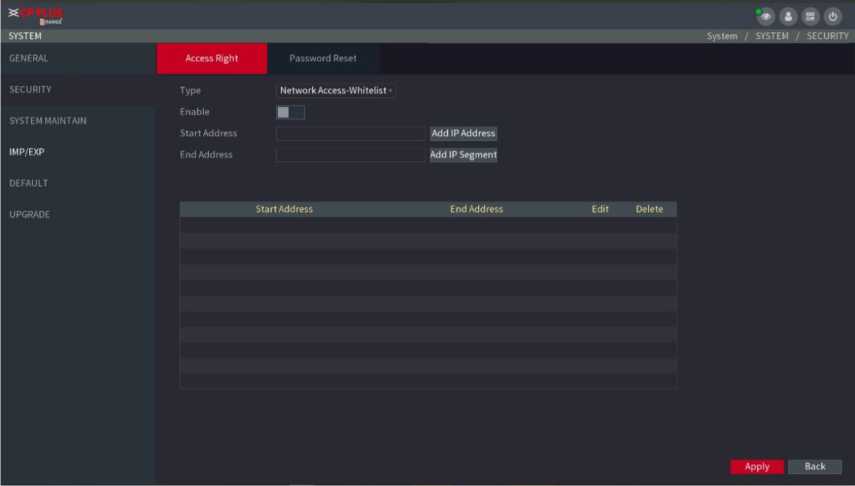
Figure 5-227
Step 2 Configure the settings for the security parameters. See Table 5-70.
Table 5-70
Step 3 Click Apply to complete the settings.
Select Main Menu ^ System ^ Security ^ Password Reset, the Password Reset interface
is displayed. The Enable check box is selected by default. See Figure 5-228.

CAUTION
If you clear the Enable check box, you can only use the security questions to reset the password. Make sure you have set the security questions before clearing the check box.
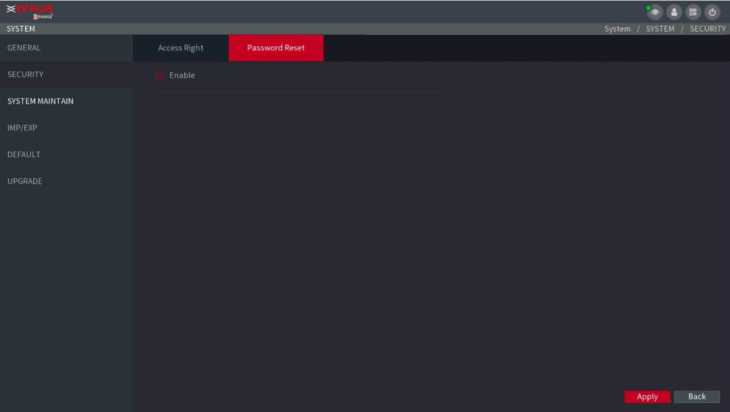
Figure 5-228
When the Device has been running for a long time, you can configure the auto reboot when the Device is not working. You can also configure the case fan mode to reduce noise and extend the service life.
Step 1 Select Main Menu ■> System ^ System Maintain.
The SYSTEM MAINTAIN interface is displayed. See Figure 5-229.
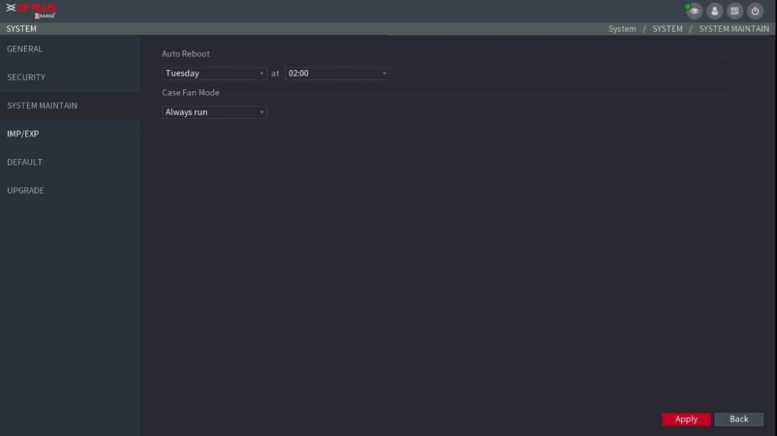
Figure 5-229
Step 2 Configure the settings for the system maintenance parameters. See Table 5-71.
| Parameter | Description | ||
| Auto Reboot | In the Auto Reboot list, select the reboot time. | ||
| Case Fan Mode | In the Case Fan Mode list, you can select Always run or Auto.
If you select Auto, the case fan will stop or start according to the external conditions such as the Device temperature. CQ NOTE |
||
| Not all models support this function, and it is only supported on | |||
| the local configuration interface. | |||
Table 5-71
Step 3 Click Apply to complete the settings.
You can export or import the Device system settings if there are several Devices that require the same setup.
NOTE
- The IMP/EXP interface cannot be opened if the backup operation is ongoing on the other interfaces.
- When you open the IMP/EXP interface, the system refreshes the devices and sets the current directory as the first root directory.
- Click Format to format the USB storage device.
Step 1 Select Main Menu ^ System ^ IMP/EXP.
The IMP/EXP interface is displayed. See Figure 5-230.
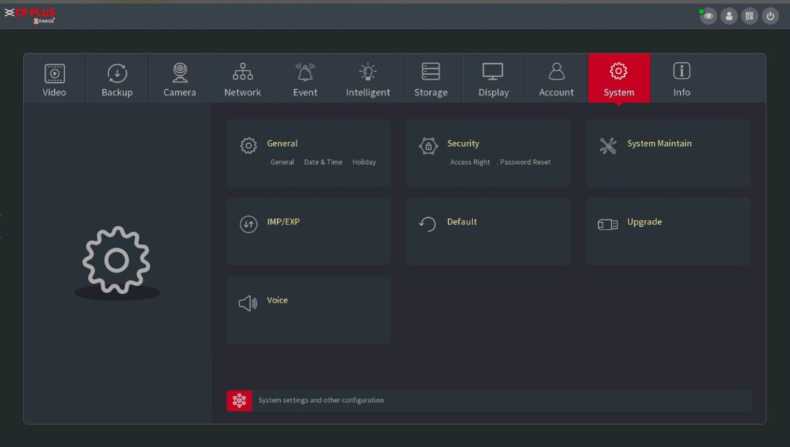
Figure 5-230
Step 2 Insert a USB storage device into one of the USB ports on the Device.
Step 3 Click Refresh to refresh the interface.
The connected USB storage device is displayed. See Figure 5-231.
| Ji | S Ô | |||||||
| SYSTEM | System | / SYSTEM | / IMP/EXP | |||||
| GENERAL | ||||||||
| Device Name sdal(USBUSB) | Refresh | Format | ||||||
| SECURITY | Total Space 3.73 GB | |||||||
| Free Space 3.27 GB | ||||||||
| SYSTEM MAINTAIN | ||||||||
| Address / | ||||||||
| IMP/EXP | ||||||||
| Name | Size | Typ« | Delete | |||||
| DEFAULT | ■ ScreenShot | Folder | B | |||||
| & LANl-20180313213059.pcap | 111.7 KB | File | a | |||||
| UPGRADE | ® LAN 1-20180313213722.peap | 182.1 KB | File | B | ||||
| ■ printf_20180314111548.txt | 1.2 KB | File | B | |||||
| 3 kmsg_printf_20180314111548.txt | 19.8 KB | File | B | |||||
| ® printf.txt | 1.97 MB | File | B | |||||
| iffl kmsg_printf.txt | LI KB | Rie | B | |||||
| B| printf_20180316153903.txt | 964 B | File | B | |||||
| g) kmsg_printf_20180316153903.txt | 2L2KB | file | B | |||||
| K printf_20180316154049.txt | 1.5 KB | file | B | |||||
| @ kmsg_printf_20180316154049.txt | 21.7 KB | file | a | |||||
| Q printf_20180316155148.txt | 2.2 KB | file | B | |||||
| ■ kmsg_printf_20180316155148.txt | 21.6 KB | Fite | B | |||||
| ® printf_20180316161436.txt | 2.5 KB | Fite | ||||||
| a kmsg_printf_20180316161436.txt | 2L9KB | file | B |
New Folder
Import Export
Figure 5-231
There is a folder under the name style of “Config_[YYYYMMDDhhmmss]”. Doubleclick this folder to view the backup files.
Step 1 Insert a USB storage device containing the exported configuration files from another Device) into one of the USB ports on the Device.
Step 2 Select Main Menu > SYSTEM > IMP/EXP.
The IMP/EXP interface is displayed.
Step 3 Click Refresh to refresh the interface.
The connected USB storage device is displayed.
Step 4 Click on the configuration folder (under the name style of “Config_[YYYYMMDDhhmmss]”) that you want to import.
Step 5 Click Import.
The Device will reboot after the imported is succeeded.
ΠNOTE
Only Admin account supports this function.
You can select the settings that you want to restore to the factory default.
Step 1 Select Main Menu ^ System ^ Default.
The DEFAULT interface is displayed.See Figure 5-232.
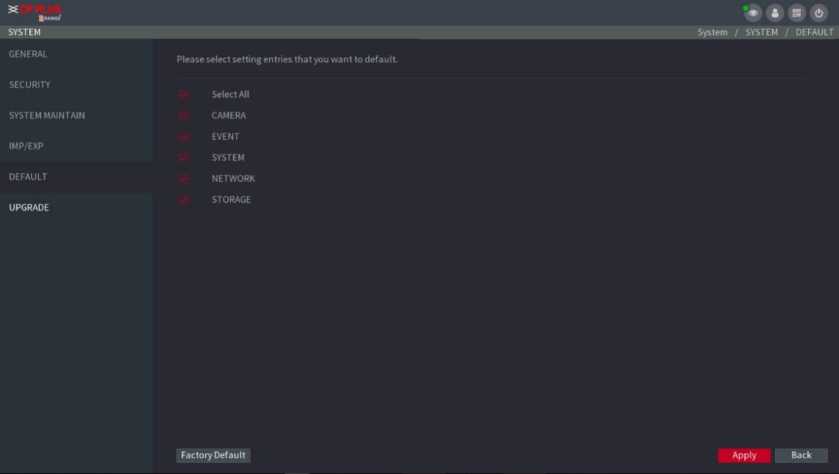
Figure 5-232
- Select the settings that you want to restore, and then click Apply. The system starts restoring the selected settings.
- Click Factory Default, and then click OK. The system starts restoring the whole settings.
Step 1 Insert a USB storage device containing the upgrade files into the USB port of the Device.
Step 2 Select Main Menu ^ System ^ Upgrade.
The UPGRADE interface is displayed. See Figure 5-233.
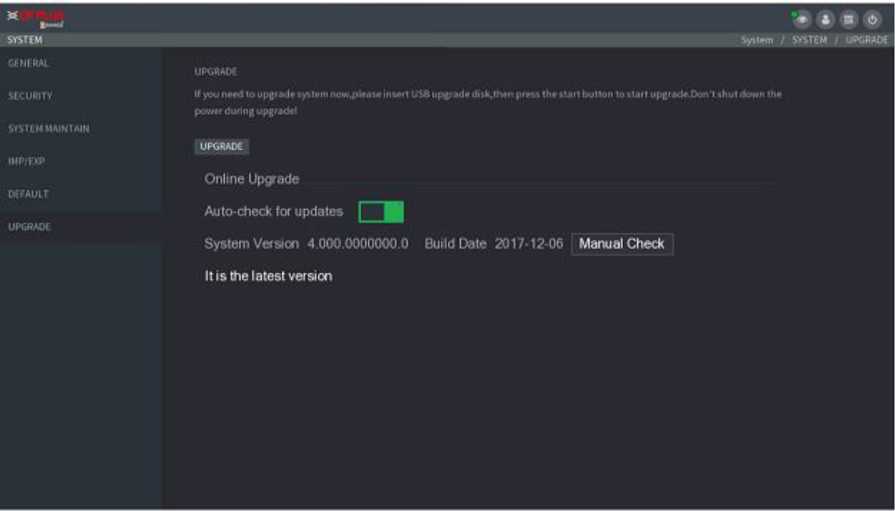
Figure 5-233
The System Upgrade interface is displayed. See Figure 5-234.
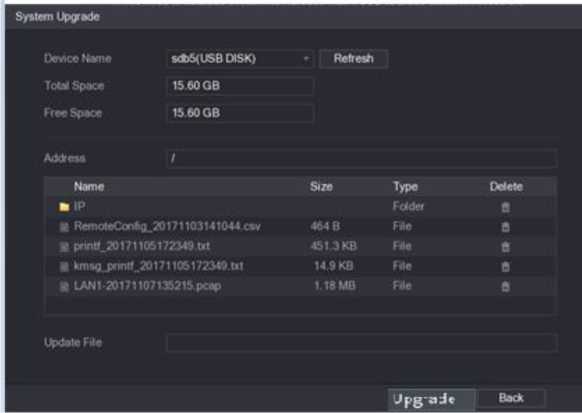
Figure 5-234
Step 4 Click the file that you want to upgrade.
The selected file is displayed in the Update File box.
Step 5 Click Start.
When the Device is connected to Internet, you can use online upgrade function to upgrade the system.
Before using this function, you need to check if there is any new version by auto check or manual check.
- Auto check: The Device checks if there is any new version available at intervals.
- Manual check: Perform real-time check if there is any new version available.
CAUTION
Ensure the correct power supply and network connection during upgrading; otherwise the upgrading might be failed.
Step 1 Select Main Menu ^ System ^ Upgrade.
The UPGRADE interface is displayed.See Figure 5-235.
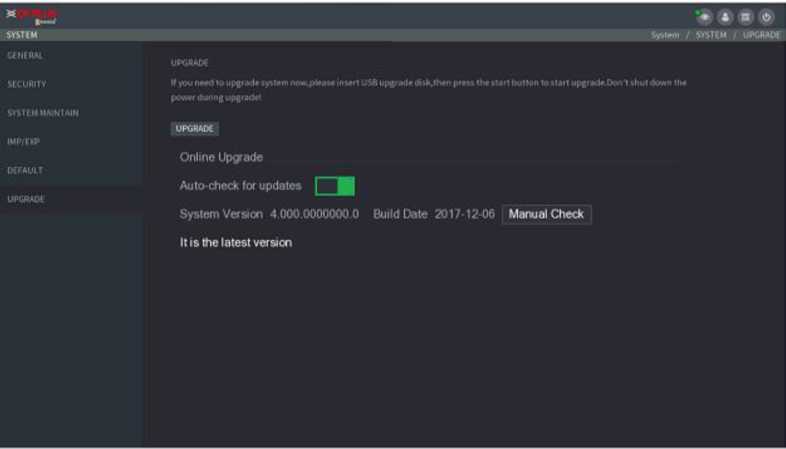
Figure 5-235
Step 2 Check if there is any new version available.
- Auto check: Enable Auto-check for updates.
- Manual check: Click Manual Check.
The system starts checking the new versions. After checking is completed, the check result is displayed.
- If the “It is the latest version” text is displayed, you do not need to upgrade.
- If the text indicating there is a new version, please go the step 3. See Figure 5
236.
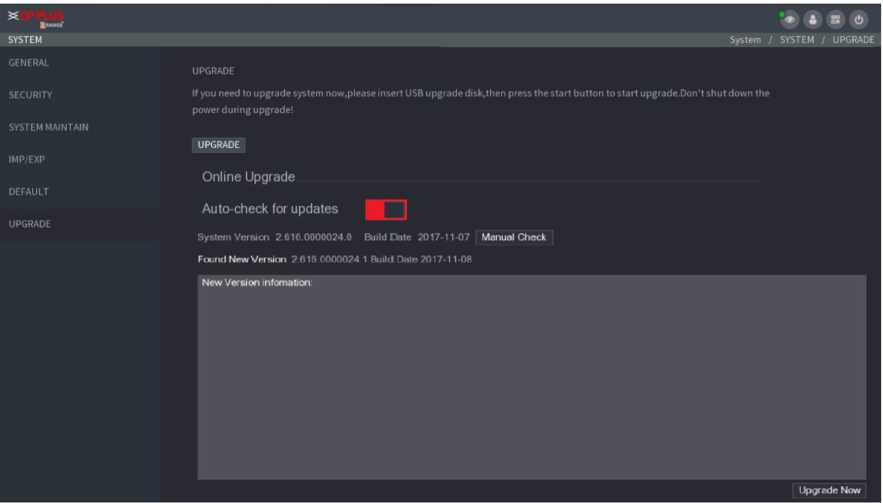
Step 3 Click Upgrade now.

CAUTION
- Under the root directory in the USB storage device, there must be “u-bootbin.img” file and “update.img” file saved, and the USB storage device must be in FAT32 format.
- Make sure the USB storage device is inserted; otherwise the upgrading cannot be performed.
When starting the Device, the system automatically check if there is a USB storage device connected and if there is any upgrade file, and if yes and the check result of the upgrade file is correct, the system will upgrade automatically. The Uboot upgrade can avoid the situation that you have to upgrade through +TFTP when the Device is halted.
You can view the information such as log information, HDD information, and version details
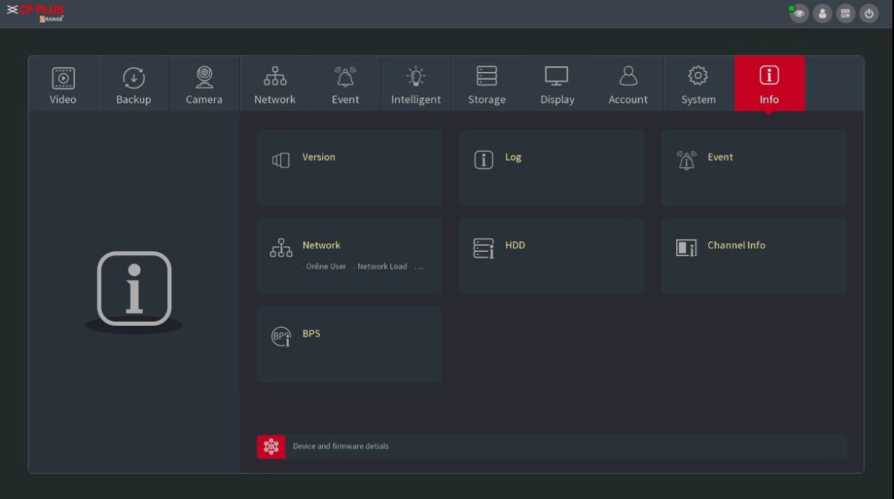
You can view the version details such as device model, system version, and build date.
Select Main Menu ^ Info ^ Version, the VERSION interface is displayed. See Figure 5-237.
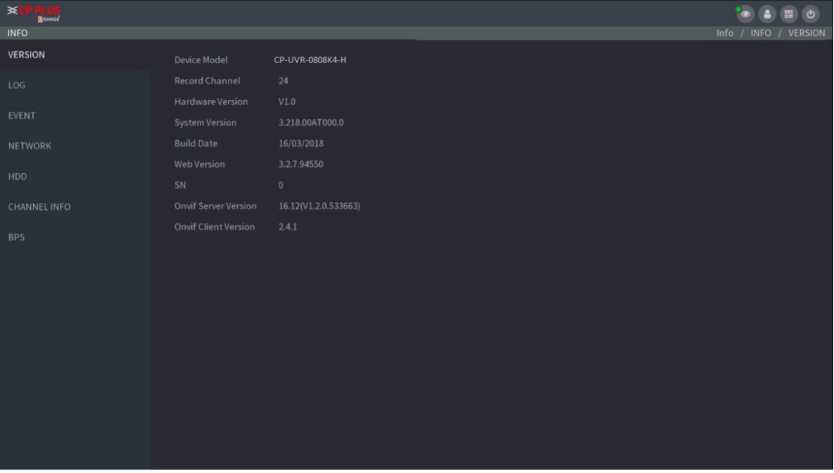
Figure 5-237
You can view and search the log information.
CD NOTE
- If there is no HDD installed, the system can save up to 10,000 logs.
- If there is HDD installed and has been formatted, the system can save up to 500,000 logs.
- If there is HDD installed, the logs about system operations are saved in the memory of the
Device and other types of logs are saved into the HDD. If there is no HDD installed, the other types of logs are also saved in the memory of the Device.
- When formatting the HDD, the logs will not be lost. However, if you take out the HDD from the Device, the logs might be lost.
Step 1 Select Main Menu ■> INFO ^ LOG, the LOG interface is displayed. See Figure 5
238.
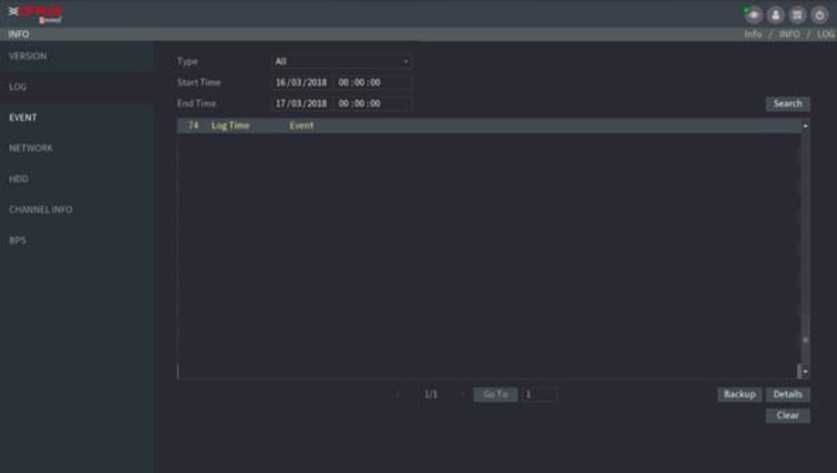
Step 2 In the Type list, select the log type that you want to view (System, Config, Storage, Record, Account, Clear, Playback, and Connection) or select All to view all logs.
Step 3 In the Start Time box and End Time box, enter the time period to search, and then click Search.
The search results are displayed. See Figure 5-239.
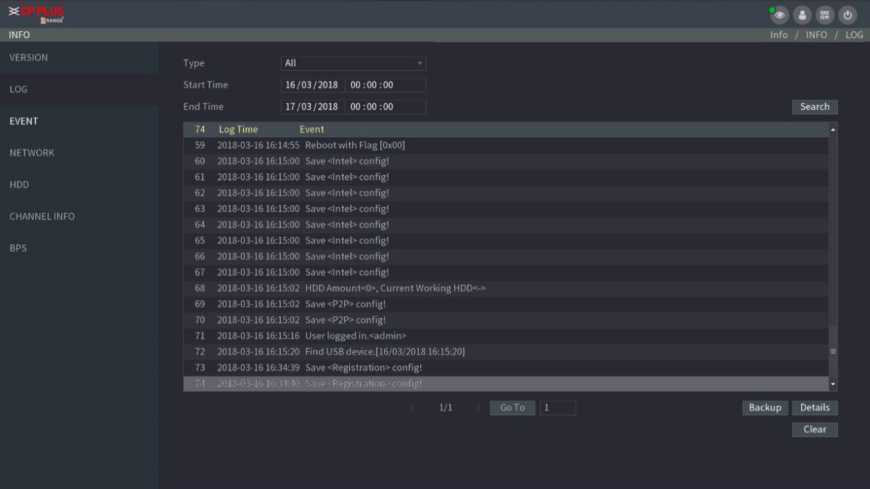
Figure 5-239
![]()
- Click Details or double-click the log that you want to view, the Detailed Information interface is displayed. Click Next or Previous to view more log information.
- Click Backup to back up the logs into the USB storage device.
- Click Clear to remove all logs.
You can view the event information of the Device and channel.
Select Main Menu ^ Info ^ Event, the EVENT interface is displayed. See Figure 5-240.
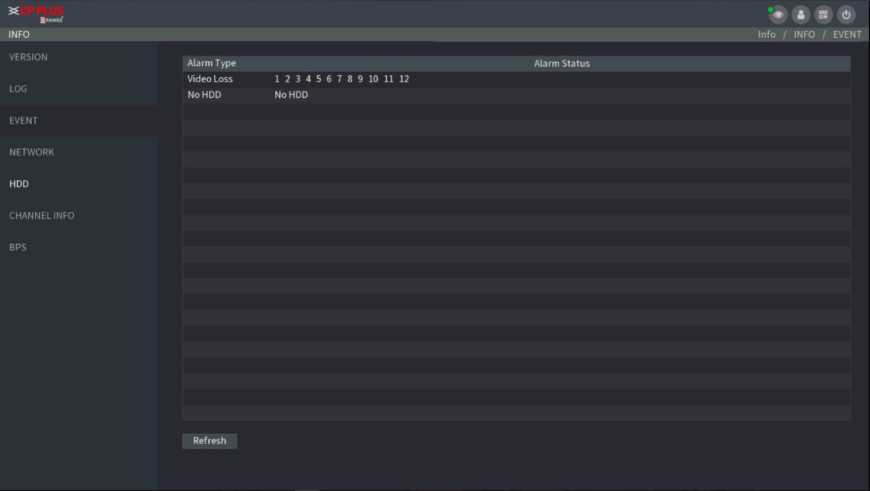
Figure 5-240
You can view the online users, network data transmission details, and test network. For details about testing network, see “5.14.2.1 Testing the Network.”
You can view the online user information and block any user for a period of time.
Select Main Menu ^ Info ^ Network ^ Online users, the Online users interface is displayed. See Figure 5-241.
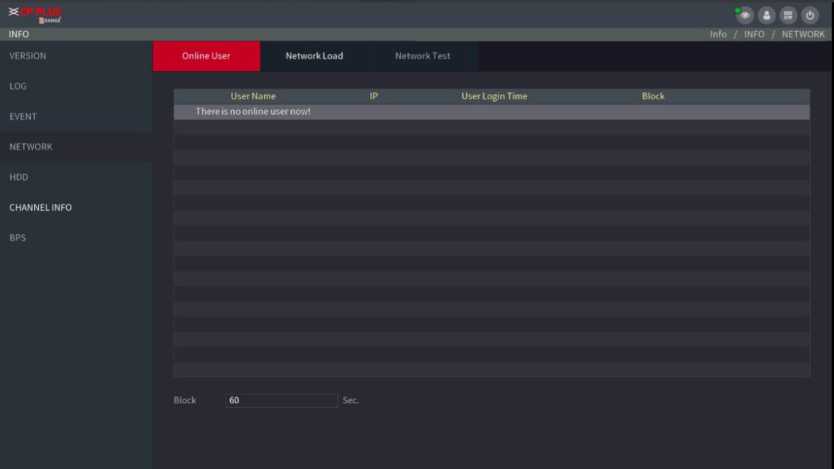
To block an online user, click and then enter the time that you want to block this user. The
maximum value you can set is 65535.
The system detects every 5 seconds to check if there is any user added or deleted, and update the user list timely.
Network load means the data flow which measures the transmission capability. You can view the information such as data receiving speed and sending speed.
Step 1 Select Main Menu ■> Info ^ NETWORK ^ Network Load.
The Network Load interface is displayed.See Figure 5-242.
![]()
VERSION
LOG
EVENT
♦ ASO
Info / INFO / NETWORK
Online User
Network Load
Network Test
Name MAC Address Status
LANI 20:18:02:09:11:34 Succeed
IP Address Type
172.8.2.51 Ethernet
MTU
1500
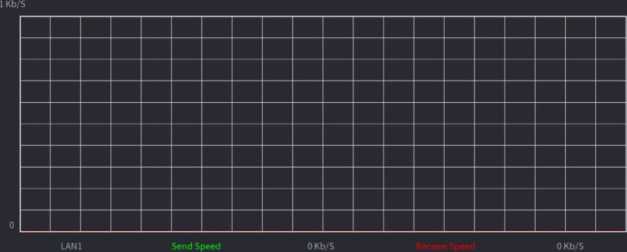
Figure 5-242
Step 2 Click the LAN name that you want to view, for example, LAN1.
The system displays the information of data sending speed and receiving speed.
ED NOTE
- The default display is LAN1 load.
- Only one LAN load can be displayed at one time.
You can view the HDD quantity, HDD type, total space, free space, status, and S.M.A.R.T information.
Select Main Menu ^ Info ^ HDD, the HDD interface is displayed. See Figure 5-243.
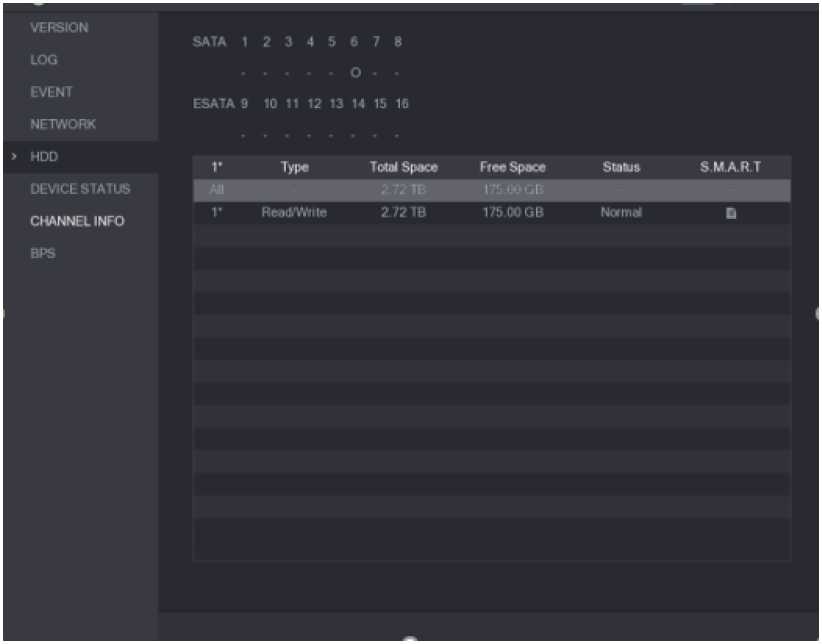
Figure 5-243
Table 5-72
You can view the information such as CPU temperature and memory usage to know the device status.
Select Main Menu ^ INFO ^ DEVICE STATUS, the DEVICE STATUS interface is displayed.
See Figure 5-244.
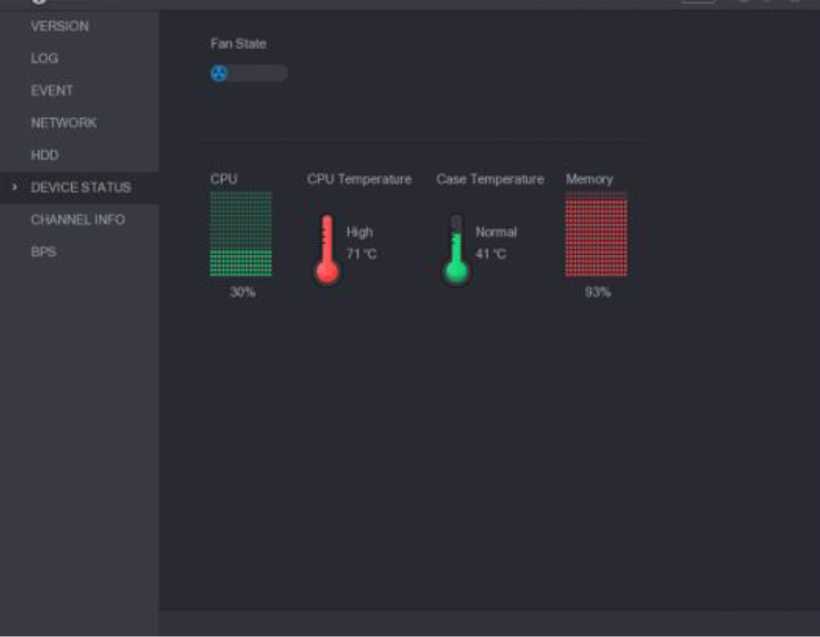
Figure 5-244
You can view the camera information connected to each channel.
Select Main Menu ^ Info ^ Channel Info, the CHANNEL INFO interface is displayed. See Figure 5-245.
VERSION
NETWORK
HDD
DEVICE STATUS
»■ CHANNEL INFO
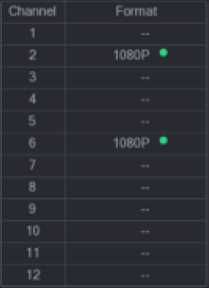
Figure 5-245
You can view the real-time data stream rate and resolution of each channel.
Select Main Menu ^ Info ^ BPS, the BPS interface is displayed. See Figure 5-246.
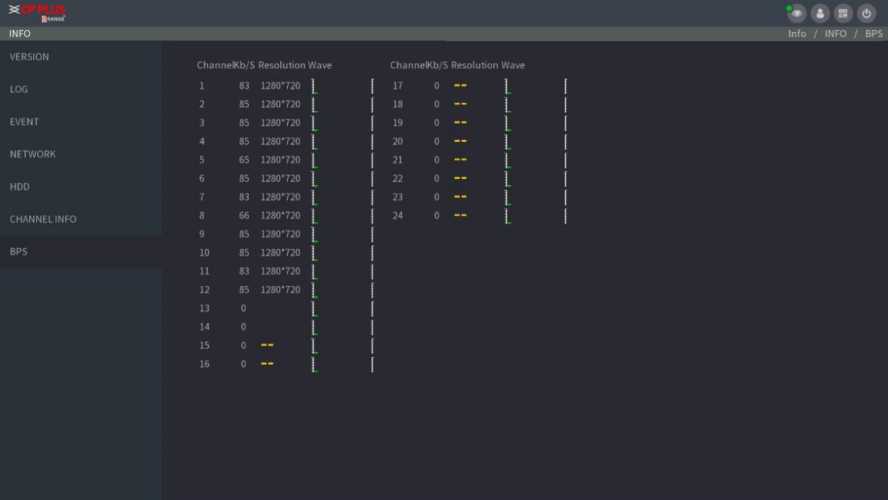
![]()
On the top right of the Main Menu interface or on any interface after you have entered the Main
Menu, click
- Select Logout, you will log out the device.
- Select Reboot, the Device will be rebooted.
- Select Shutdown, the Device will be turned off.
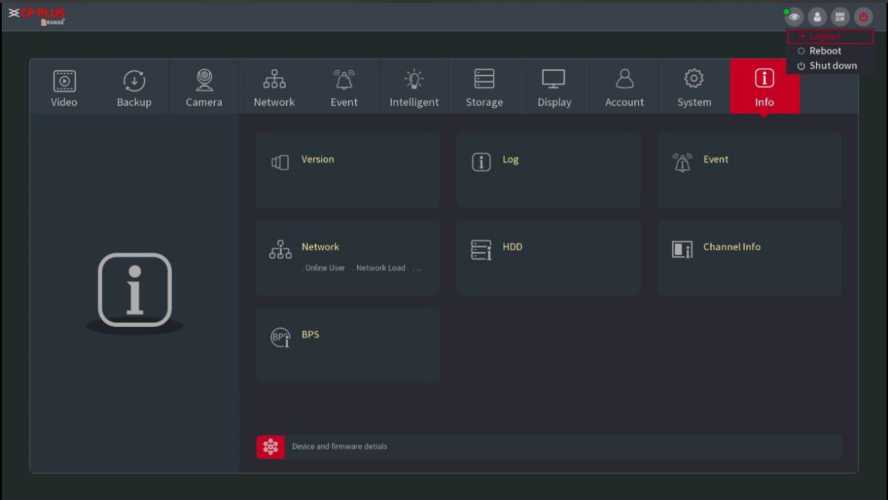
- The interfaces in the Manual are used for introducing the operations and only for reference. The actual interface might be different dependent on the model you purchased. If there is inconsistency between the Manual and the actual product, the actual product shall govern.
- The Manual is a general document for introducing the product, so there might be some functions described for the Device in the Manual not apply to the model you purchased.
- Besides Web, you can use our Smart PSS to login the device. For detailed information, please refer to Smart PSS user’s manual.
CD NOTE
- The factory default IP of the Device is 192.168.1.108.
- The Device supports monitoring on different browsers such as Safari, fire fox, Google on Apple PC to perform the functions such as multi-channel monitoring, PTZ control, and device parameters configurations.
Step 1 Check to make sure the Device has connected to the network.
Step 2 Configure the IP address, subnet mask and gateway for the PC and the Device. For details about network configuration of the Device, see “5.1.4.4 Configuring Network Settings.”
Step 3 On your PC, check the network connection of the Device by using “ping ************” Usually the return value of TTL is 255.
Step 1 Open the IE browser, enter the IP address of the Device, and then press Enter.
The Login in dialog box is displayed. See Figure 6-1.
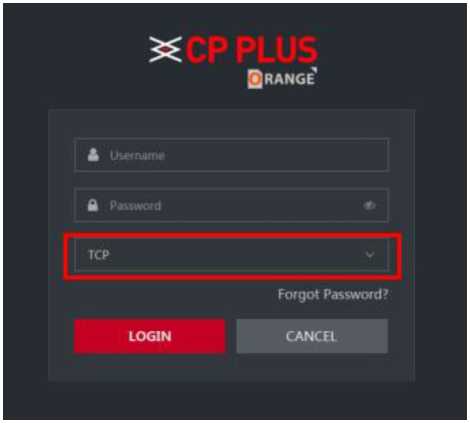
Figure 6-1
Step 2 Enter the user name and password.
![]()
- The default administrator account is admin. The password is the one that was configured during initial settings. To security your account, it is recommended to keep the password properly and change it regularly.
- Click to display the password.
- If you forgot the password, click Forgot Password? to reset the password. For details about resetting the password, see “6.3 Resetting Password.“
Step 3 Click Login.
You can reset the password through the reserved email address when you forget the password of admin account.
Step 1 Login the Web of the Device.
TheLogin in dialog box is displayed. See Figure 6-2.
![]()
3 RANGÉ’
i psci Natru
Login
Cancel
Û
Figure 6-2
The Reset the password interface is displayed. See Figure 6-3.
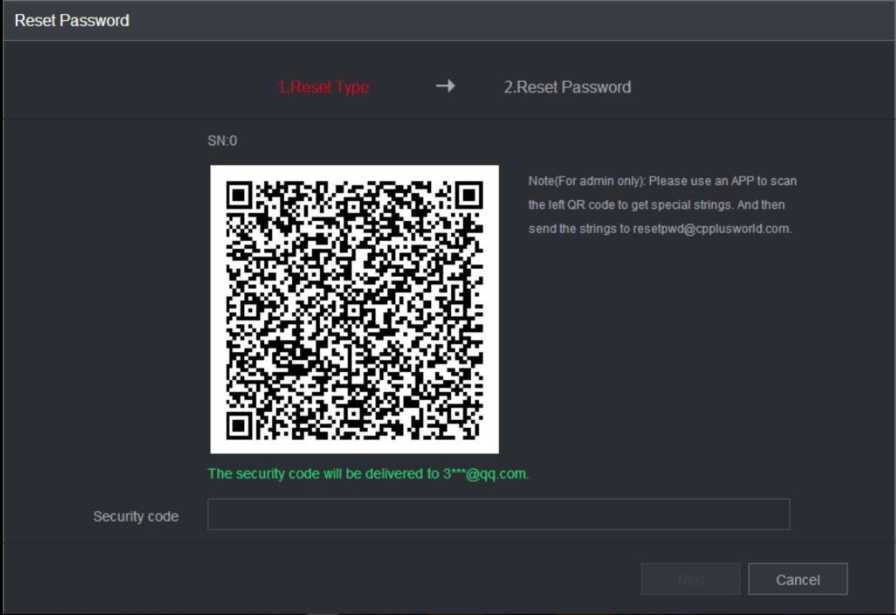
Figure 6-3
Step 3 Follow the onscreen instructions to scan the QR code and get the security code.

CAUTION
- You can get the security code twice by scanning the same QR code. If you need to get the security code once again, please refresh the interface.
- Please use the security code received in your email box to reset the password within 24 hours; otherwise the security code becomes invalid.
•
Wrong security code entrance up to five times will cause the security code locked for five minutes. After five minutes, you can continue to use this security code.
Step 4 In the Security code box, enter the security code received in your reserved email box.
Step 5 Click Next.
The new password resetting interface is displayed. See Figure 6-4
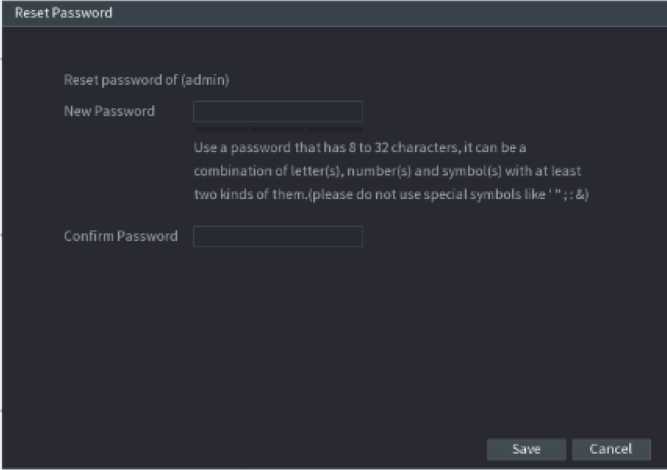
Figure 6-4
Step 6 In the Password box, enter the new password and enter it again in the Confirm Password box.
EQ NOTE
The new password can be set from 8 characters through 32 characters and contain at least two types from number, letter and special characters (excluding , , “;”,”:” and
“&”).
Step 7 Click Save. The password resetting is started.
After resetting is completed, a pop-up message is displayed to indicate the result and you will see the login interface is displayed. Then you can use the new password to login the Web.
After you have logged in the Web, the main menu is displayed. See Figure 6-5.
For detailed operations, you can refer to “5 Local Configurations.”
